Japanese sword 14th century Stock Photos and Images
(92)See japanese sword 14th century stock video clipsQuick filters:
Japanese sword 14th century Stock Photos and Images
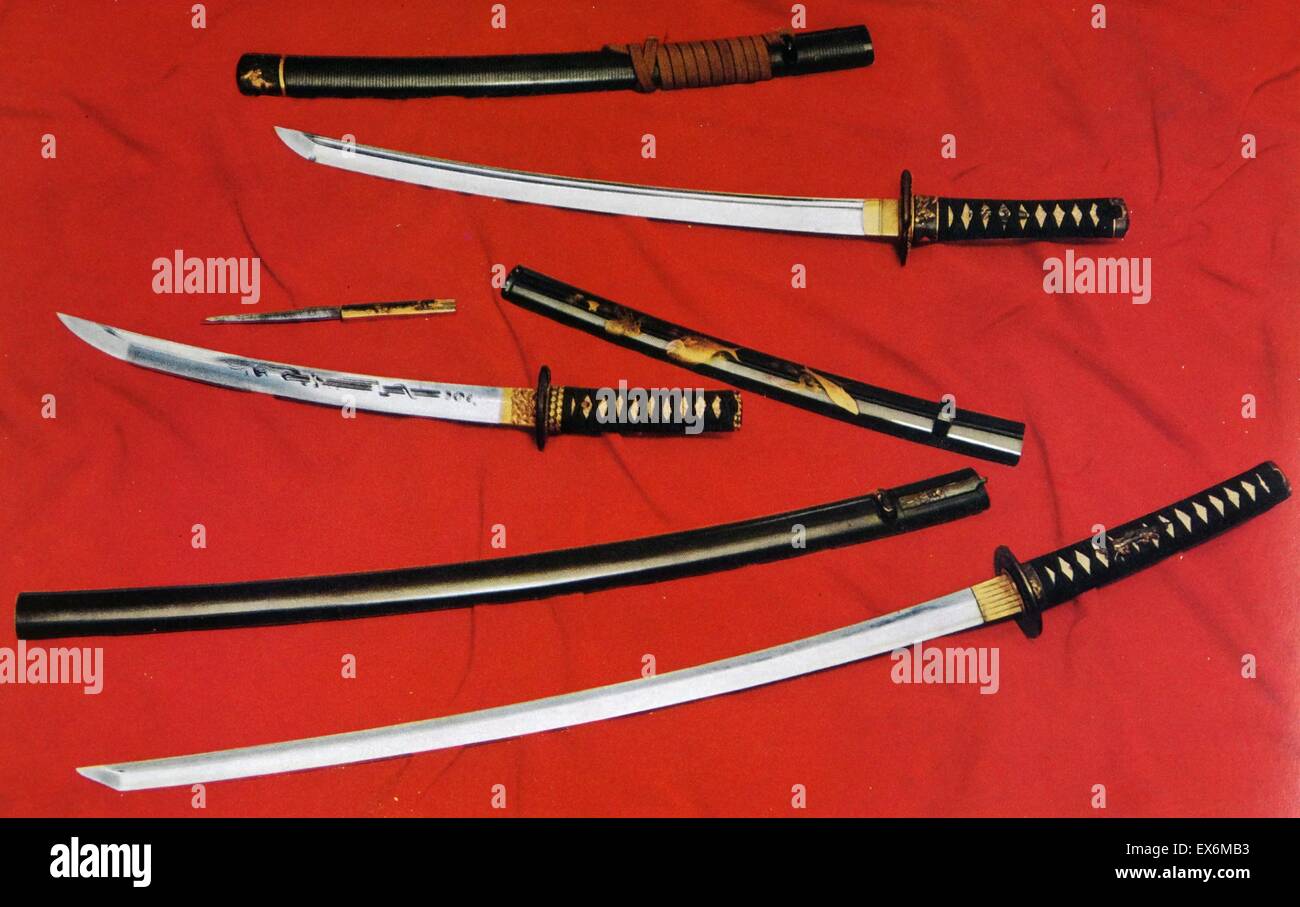 Collection of 14th Century Japanese Katana, Wakizashi, Tanto, and Samurai swords Stock Photohttps://www.alamy.com/image-license-details/?v=1https://www.alamy.com/stock-photo-collection-of-14th-century-japanese-katana-wakizashi-tanto-and-samurai-84970231.html
Collection of 14th Century Japanese Katana, Wakizashi, Tanto, and Samurai swords Stock Photohttps://www.alamy.com/image-license-details/?v=1https://www.alamy.com/stock-photo-collection-of-14th-century-japanese-katana-wakizashi-tanto-and-samurai-84970231.htmlRMEX6MB3–Collection of 14th Century Japanese Katana, Wakizashi, Tanto, and Samurai swords
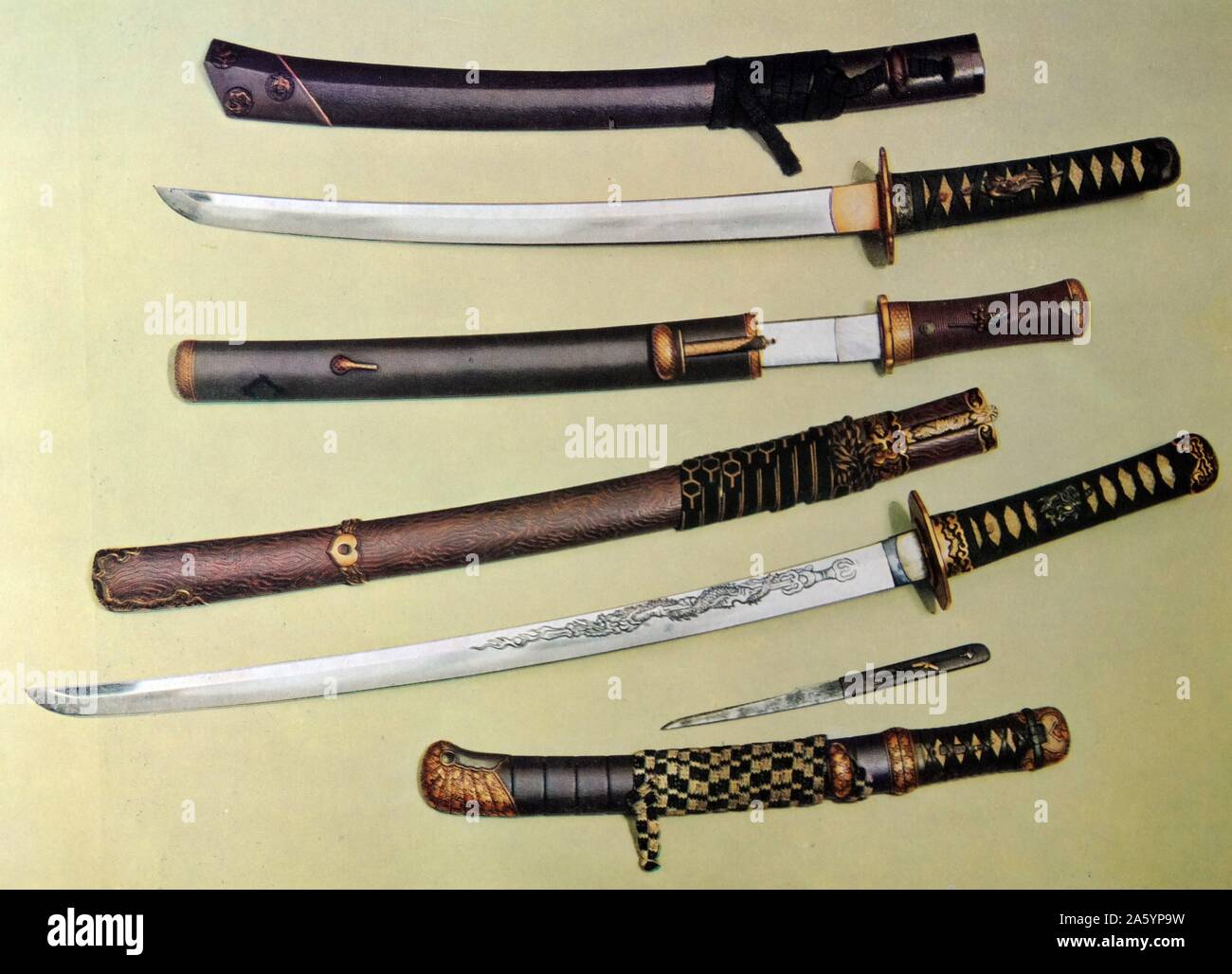 Collection of 14th Century Japanese Katana, Wakizashi, Tanto, and Samurai swords Stock Photohttps://www.alamy.com/image-license-details/?v=1https://www.alamy.com/collection-of-14th-century-japanese-katana-wakizashi-tanto-and-samurai-swords-image330680501.html
Collection of 14th Century Japanese Katana, Wakizashi, Tanto, and Samurai swords Stock Photohttps://www.alamy.com/image-license-details/?v=1https://www.alamy.com/collection-of-14th-century-japanese-katana-wakizashi-tanto-and-samurai-swords-image330680501.htmlRM2A5YP9W–Collection of 14th Century Japanese Katana, Wakizashi, Tanto, and Samurai swords
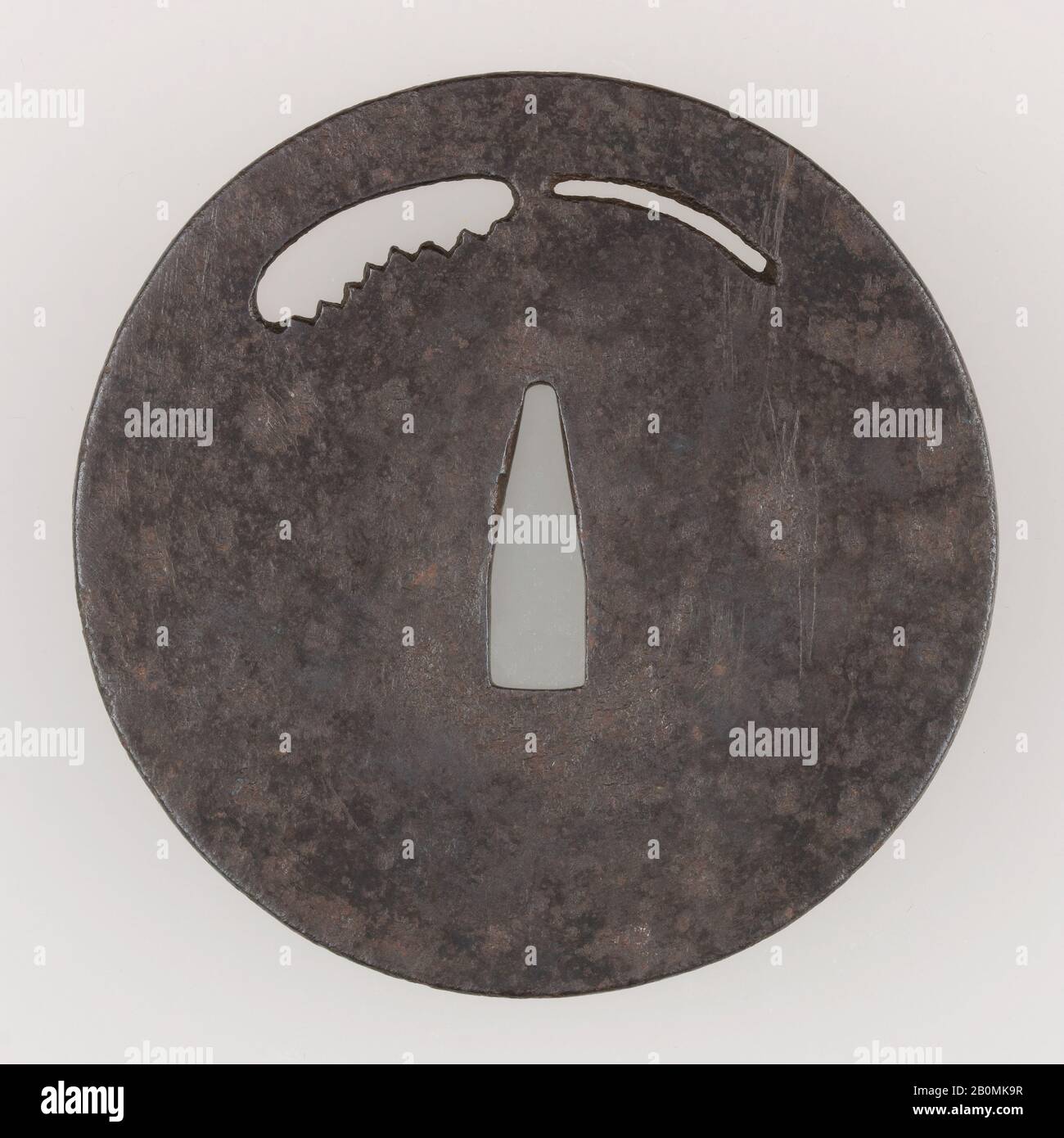 Sword Guard (Tsuba), Japanese, late 14th century, Japanese, Iron, copper, Diam. 3 3/4 in. (9.5 cm); thickness 1/8 in. (0.3 cm); Wt. 5.5 oz. (155.9 g), Sword Furniture-Tsuba Stock Photohttps://www.alamy.com/image-license-details/?v=1https://www.alamy.com/sword-guard-tsuba-japanese-late-14th-century-japanese-iron-copper-diam-3-34-in-95-cm-thickness-18-in-03-cm-wt-55-oz-1559-g-sword-furniture-tsuba-image344661571.html
Sword Guard (Tsuba), Japanese, late 14th century, Japanese, Iron, copper, Diam. 3 3/4 in. (9.5 cm); thickness 1/8 in. (0.3 cm); Wt. 5.5 oz. (155.9 g), Sword Furniture-Tsuba Stock Photohttps://www.alamy.com/image-license-details/?v=1https://www.alamy.com/sword-guard-tsuba-japanese-late-14th-century-japanese-iron-copper-diam-3-34-in-95-cm-thickness-18-in-03-cm-wt-55-oz-1559-g-sword-furniture-tsuba-image344661571.htmlRM2B0MK9R–Sword Guard (Tsuba), Japanese, late 14th century, Japanese, Iron, copper, Diam. 3 3/4 in. (9.5 cm); thickness 1/8 in. (0.3 cm); Wt. 5.5 oz. (155.9 g), Sword Furniture-Tsuba
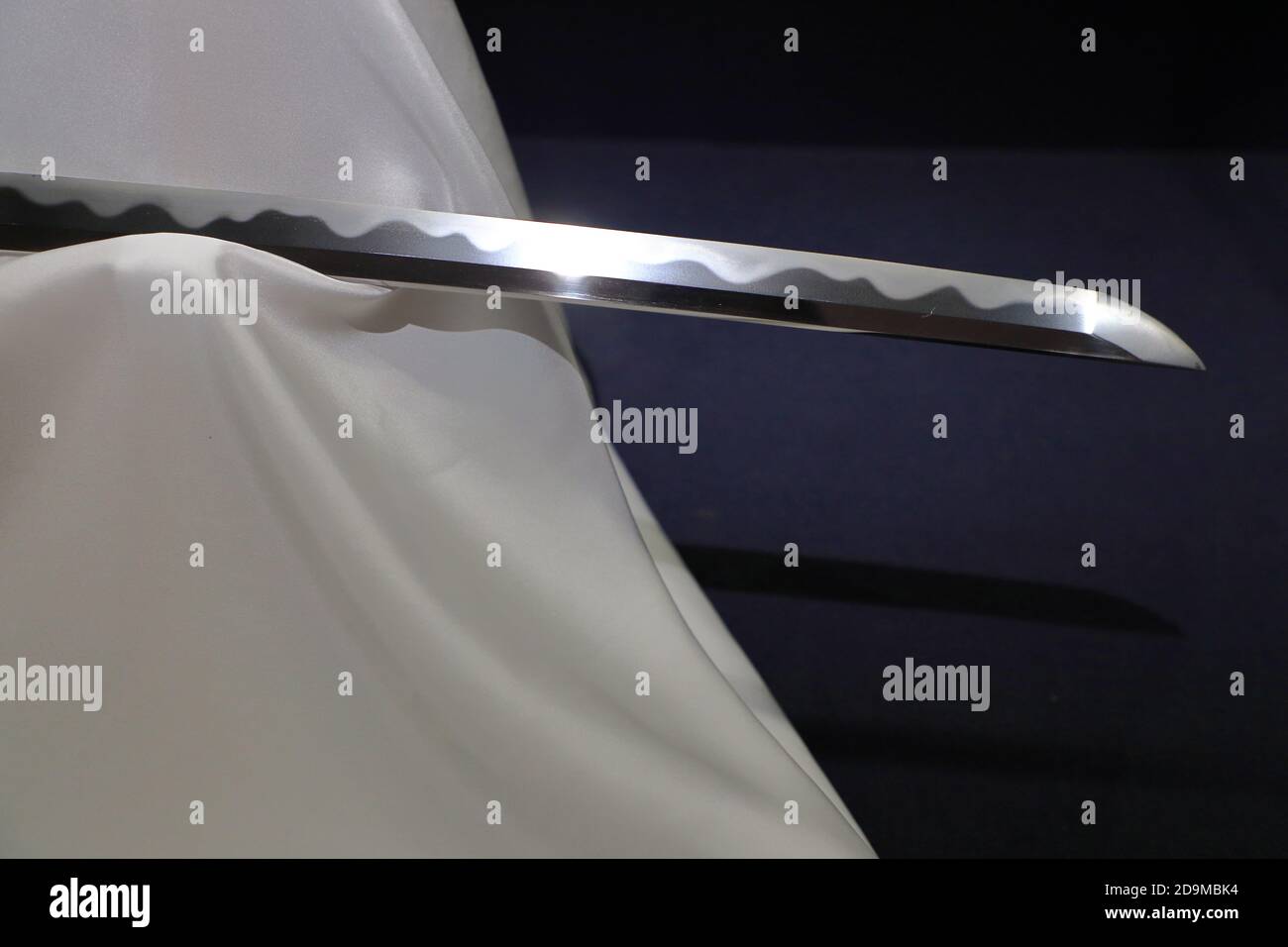 A National Treasure class Tachi sword from late Kamakura period of 14th century display in Japanese Sword Museum. Sumida-ku.Tokyo.Japan Stock Photohttps://www.alamy.com/image-license-details/?v=1https://www.alamy.com/a-national-treasure-class-tachi-sword-from-late-kamakura-period-of-14th-century-display-in-japanese-sword-museum-sumida-kutokyojapan-image384608200.html
A National Treasure class Tachi sword from late Kamakura period of 14th century display in Japanese Sword Museum. Sumida-ku.Tokyo.Japan Stock Photohttps://www.alamy.com/image-license-details/?v=1https://www.alamy.com/a-national-treasure-class-tachi-sword-from-late-kamakura-period-of-14th-century-display-in-japanese-sword-museum-sumida-kutokyojapan-image384608200.htmlRM2D9MBK4–A National Treasure class Tachi sword from late Kamakura period of 14th century display in Japanese Sword Museum. Sumida-ku.Tokyo.Japan
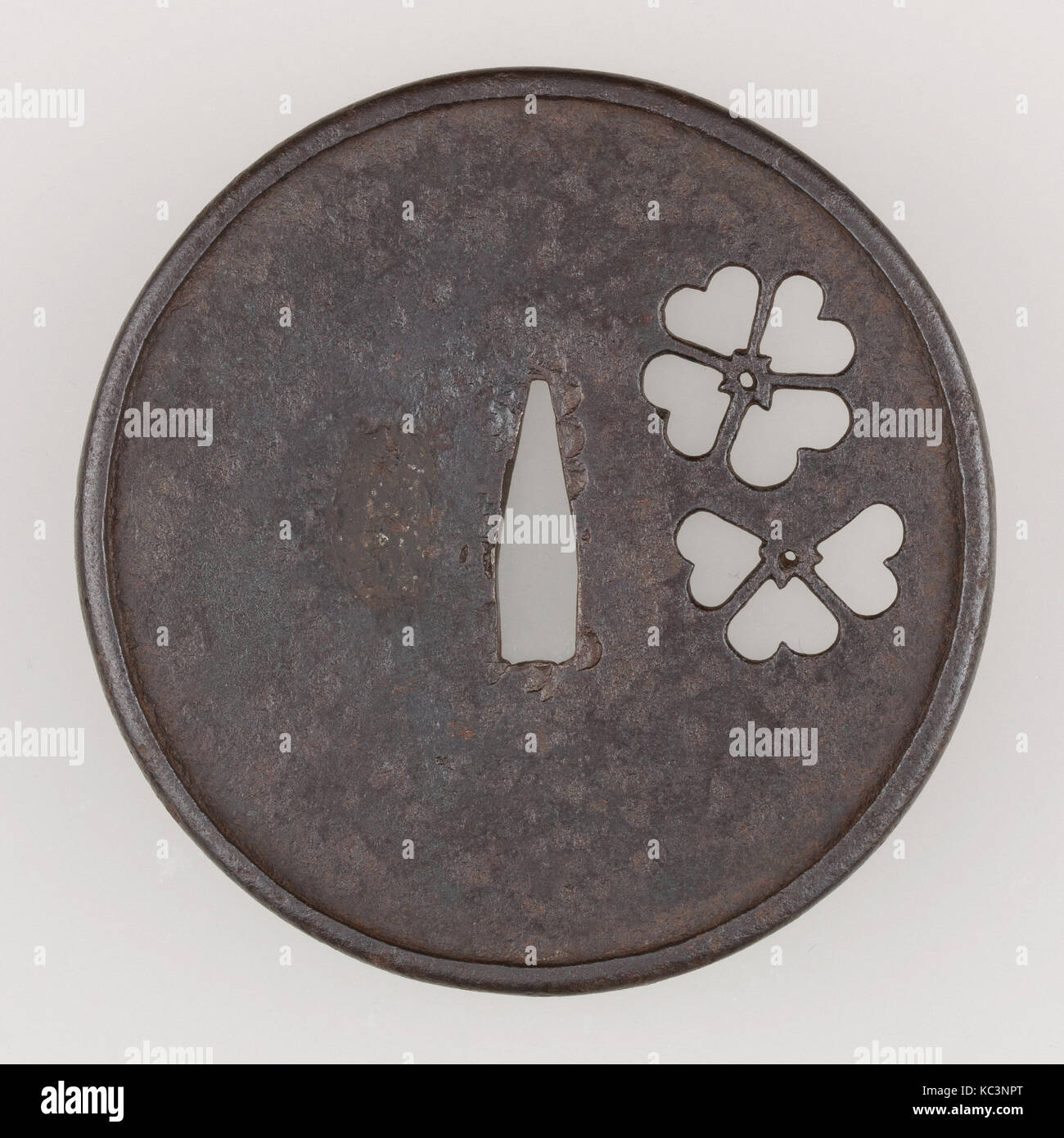 Sword Guard (Tsuba), late 14th–early 15th century, Japanese, Iron, copper, H. 3 3/4 in. (9.5 cm); W. 3 11/16 in. (9.4 cm Stock Photohttps://www.alamy.com/image-license-details/?v=1https://www.alamy.com/stock-image-sword-guard-tsuba-late-14thearly-15th-century-japanese-iron-copper-162352144.html
Sword Guard (Tsuba), late 14th–early 15th century, Japanese, Iron, copper, H. 3 3/4 in. (9.5 cm); W. 3 11/16 in. (9.4 cm Stock Photohttps://www.alamy.com/image-license-details/?v=1https://www.alamy.com/stock-image-sword-guard-tsuba-late-14thearly-15th-century-japanese-iron-copper-162352144.htmlRMKC3NPT–Sword Guard (Tsuba), late 14th–early 15th century, Japanese, Iron, copper, H. 3 3/4 in. (9.5 cm); W. 3 11/16 in. (9.4 cm
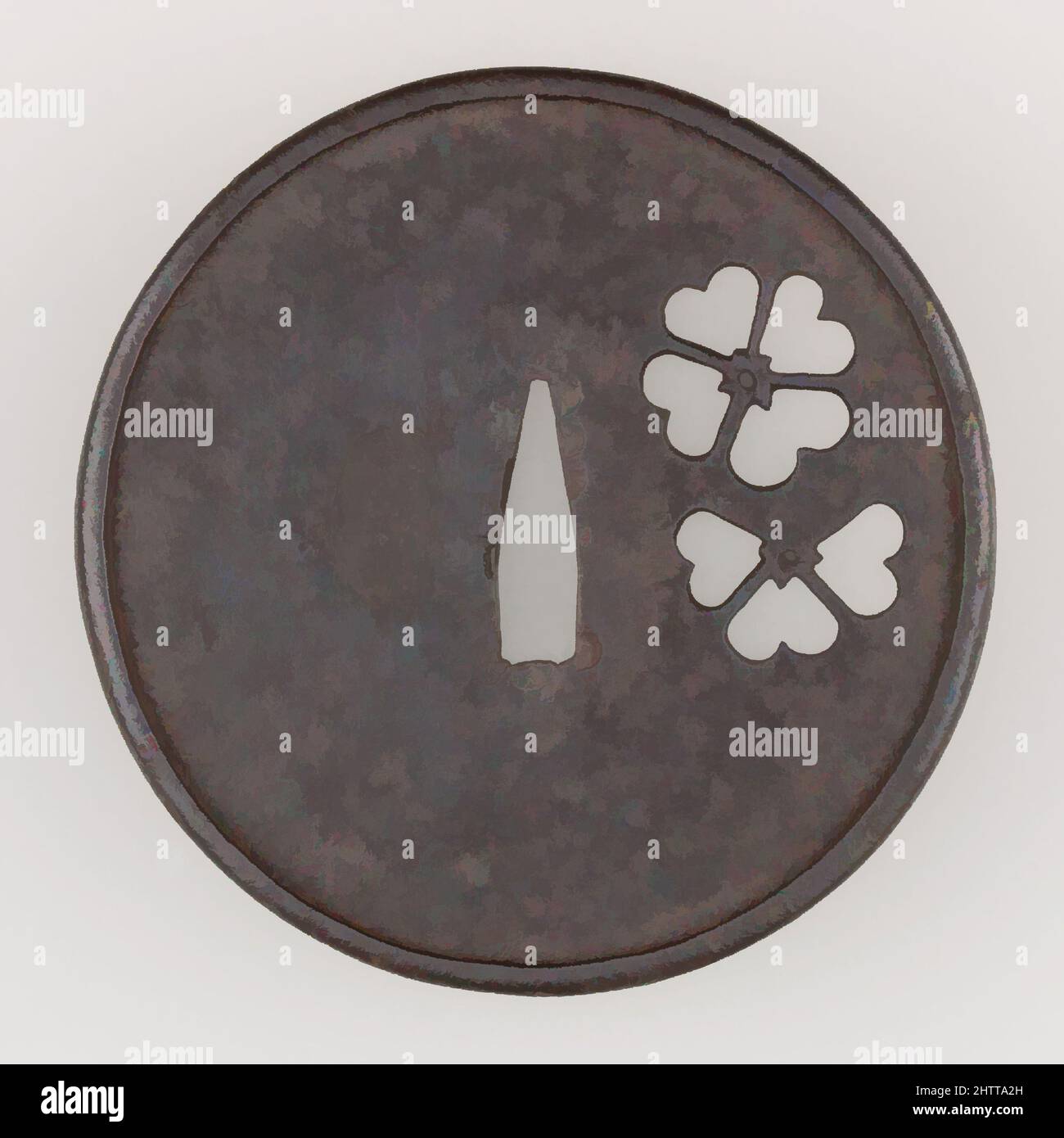 Art inspired by Sword Guard (Tsuba), late 14th–early 15th century, Japanese, Iron, copper, H. 3 3/4 in. (9.5 cm); W. 3 11/16 in. (9.4 cm); thickness 1/4 in. (0.6 cm); Wt. 4.6 oz. (130.4 g), Sword Furniture-Tsuba, This tsuba features an openwork design of two overlapping flowers. It is, Classic works modernized by Artotop with a splash of modernity. Shapes, color and value, eye-catching visual impact on art. Emotions through freedom of artworks in a contemporary way. A timeless message pursuing a wildly creative new direction. Artists turning to the digital medium and creating the Artotop NFT Stock Photohttps://www.alamy.com/image-license-details/?v=1https://www.alamy.com/art-inspired-by-sword-guard-tsuba-late-14thearly-15th-century-japanese-iron-copper-h-3-34-in-95-cm-w-3-1116-in-94-cm-thickness-14-in-06-cm-wt-46-oz-1304-g-sword-furniture-tsuba-this-tsuba-features-an-openwork-design-of-two-overlapping-flowers-it-is-classic-works-modernized-by-artotop-with-a-splash-of-modernity-shapes-color-and-value-eye-catching-visual-impact-on-art-emotions-through-freedom-of-artworks-in-a-contemporary-way-a-timeless-message-pursuing-a-wildly-creative-new-direction-artists-turning-to-the-digital-medium-and-creating-the-artotop-nft-image462756073.html
Art inspired by Sword Guard (Tsuba), late 14th–early 15th century, Japanese, Iron, copper, H. 3 3/4 in. (9.5 cm); W. 3 11/16 in. (9.4 cm); thickness 1/4 in. (0.6 cm); Wt. 4.6 oz. (130.4 g), Sword Furniture-Tsuba, This tsuba features an openwork design of two overlapping flowers. It is, Classic works modernized by Artotop with a splash of modernity. Shapes, color and value, eye-catching visual impact on art. Emotions through freedom of artworks in a contemporary way. A timeless message pursuing a wildly creative new direction. Artists turning to the digital medium and creating the Artotop NFT Stock Photohttps://www.alamy.com/image-license-details/?v=1https://www.alamy.com/art-inspired-by-sword-guard-tsuba-late-14thearly-15th-century-japanese-iron-copper-h-3-34-in-95-cm-w-3-1116-in-94-cm-thickness-14-in-06-cm-wt-46-oz-1304-g-sword-furniture-tsuba-this-tsuba-features-an-openwork-design-of-two-overlapping-flowers-it-is-classic-works-modernized-by-artotop-with-a-splash-of-modernity-shapes-color-and-value-eye-catching-visual-impact-on-art-emotions-through-freedom-of-artworks-in-a-contemporary-way-a-timeless-message-pursuing-a-wildly-creative-new-direction-artists-turning-to-the-digital-medium-and-creating-the-artotop-nft-image462756073.htmlRF2HTTA2H–Art inspired by Sword Guard (Tsuba), late 14th–early 15th century, Japanese, Iron, copper, H. 3 3/4 in. (9.5 cm); W. 3 11/16 in. (9.4 cm); thickness 1/4 in. (0.6 cm); Wt. 4.6 oz. (130.4 g), Sword Furniture-Tsuba, This tsuba features an openwork design of two overlapping flowers. It is, Classic works modernized by Artotop with a splash of modernity. Shapes, color and value, eye-catching visual impact on art. Emotions through freedom of artworks in a contemporary way. A timeless message pursuing a wildly creative new direction. Artists turning to the digital medium and creating the Artotop NFT
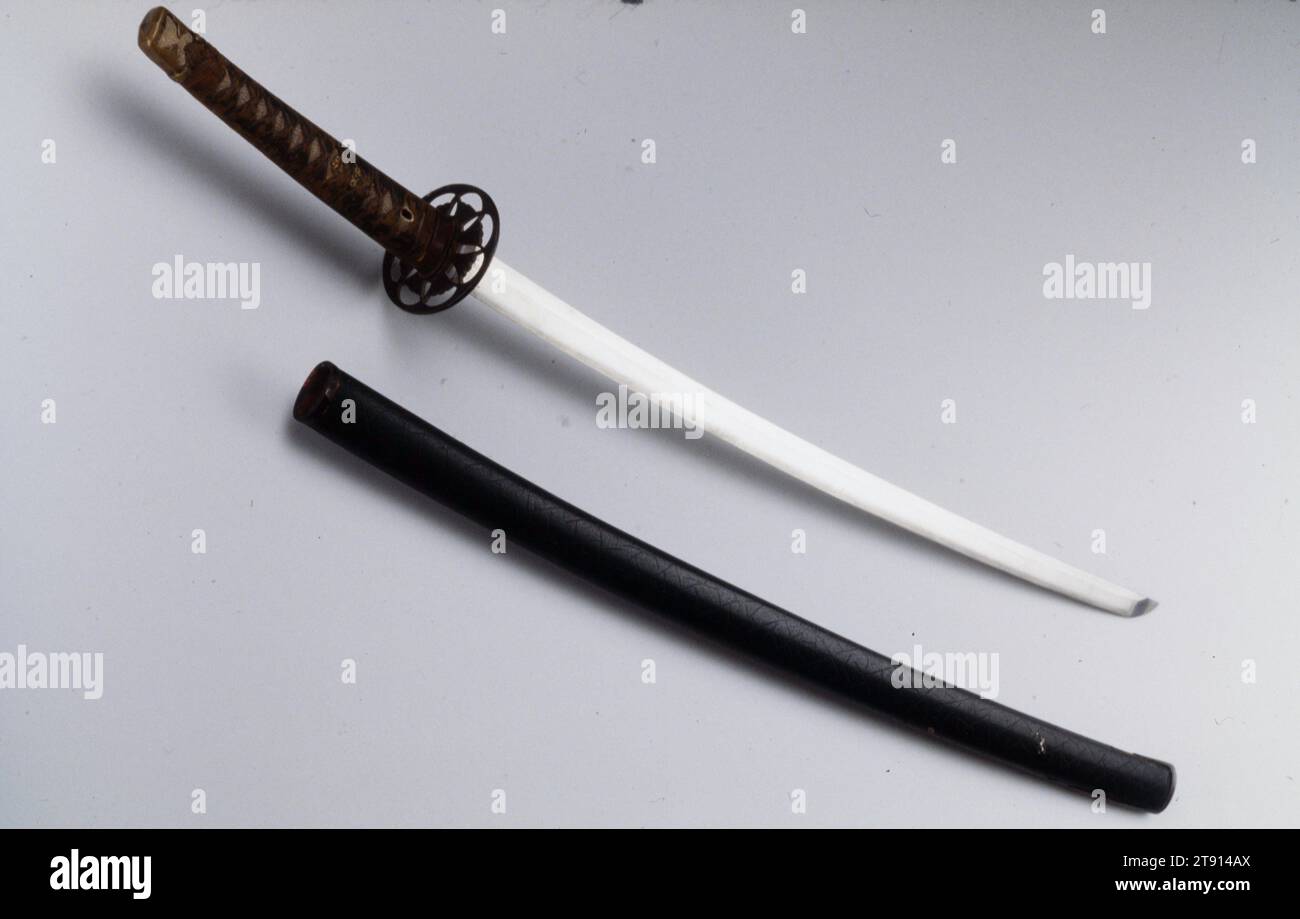 Katana blade of a shortened tachi in 20th-century mount with World War II officer sword handle, 14th century, Unknown Japanese, 10 x 1 1/2 in. (25.4 x 3.81 cm) (b), Wood, lacquer, sharkskin, silk, metal, Japan, 14th century Stock Photohttps://www.alamy.com/image-license-details/?v=1https://www.alamy.com/katana-blade-of-a-shortened-tachi-in-20th-century-mount-with-world-war-ii-officer-sword-handle-14th-century-unknown-japanese-10-x-1-12-in-254-x-381-cm-b-wood-lacquer-sharkskin-silk-metal-japan-14th-century-image573499442.html
Katana blade of a shortened tachi in 20th-century mount with World War II officer sword handle, 14th century, Unknown Japanese, 10 x 1 1/2 in. (25.4 x 3.81 cm) (b), Wood, lacquer, sharkskin, silk, metal, Japan, 14th century Stock Photohttps://www.alamy.com/image-license-details/?v=1https://www.alamy.com/katana-blade-of-a-shortened-tachi-in-20th-century-mount-with-world-war-ii-officer-sword-handle-14th-century-unknown-japanese-10-x-1-12-in-254-x-381-cm-b-wood-lacquer-sharkskin-silk-metal-japan-14th-century-image573499442.htmlRM2T914AX–Katana blade of a shortened tachi in 20th-century mount with World War II officer sword handle, 14th century, Unknown Japanese, 10 x 1 1/2 in. (25.4 x 3.81 cm) (b), Wood, lacquer, sharkskin, silk, metal, Japan, 14th century
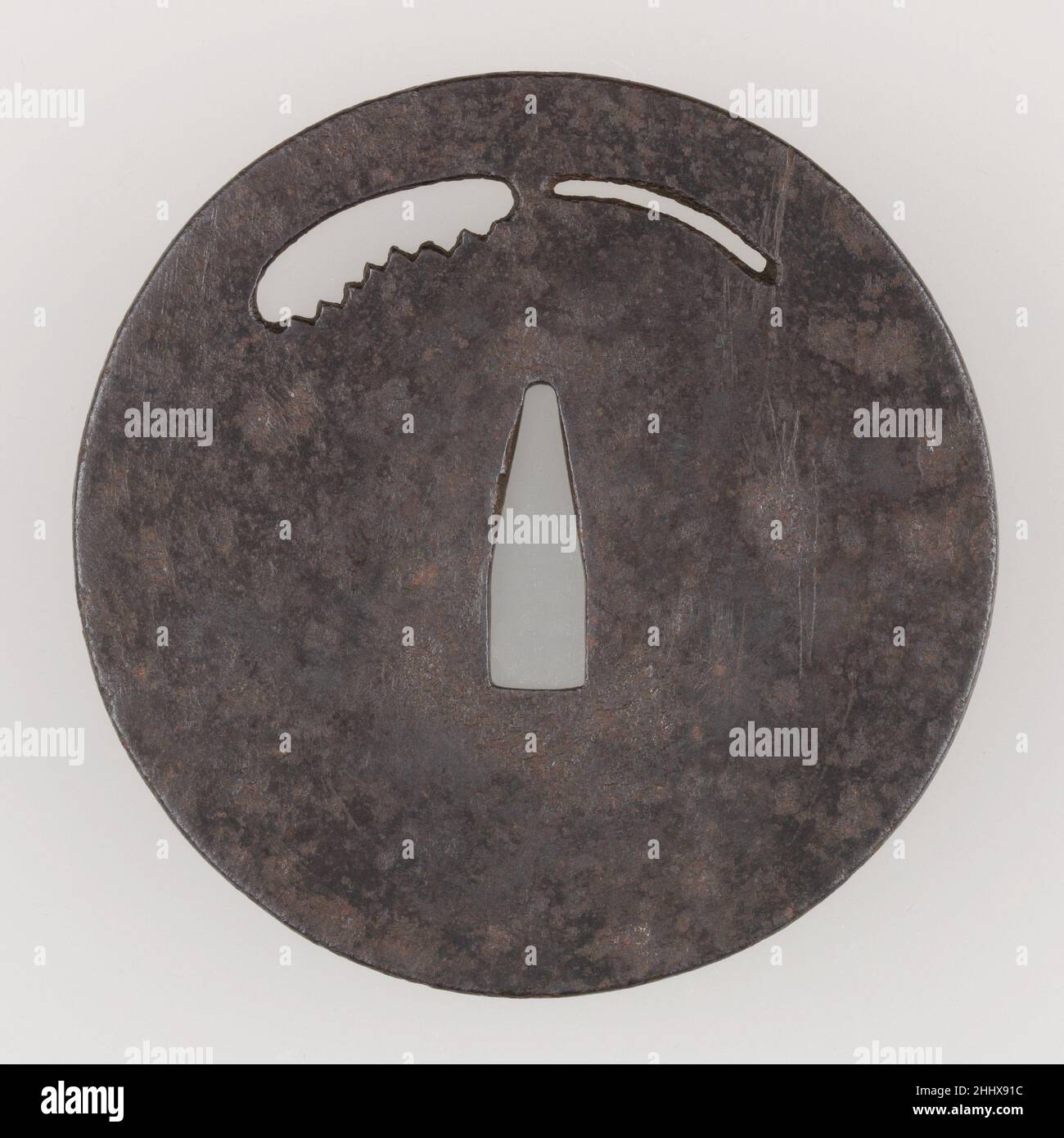 Sword Guard (Tsuba) late 14th century Japanese This tsuba features an openwork design of a saw. It is made in the so-called kō-toshō (swordsmith's) style.. Sword Guard (Tsuba) 31704 Stock Photohttps://www.alamy.com/image-license-details/?v=1https://www.alamy.com/sword-guard-tsuba-late-14th-century-japanese-this-tsuba-features-an-openwork-design-of-a-saw-it-is-made-in-the-so-called-k-tosh-swordsmiths-style-sword-guard-tsuba-31704-image458496568.html
Sword Guard (Tsuba) late 14th century Japanese This tsuba features an openwork design of a saw. It is made in the so-called kō-toshō (swordsmith's) style.. Sword Guard (Tsuba) 31704 Stock Photohttps://www.alamy.com/image-license-details/?v=1https://www.alamy.com/sword-guard-tsuba-late-14th-century-japanese-this-tsuba-features-an-openwork-design-of-a-saw-it-is-made-in-the-so-called-k-tosh-swordsmiths-style-sword-guard-tsuba-31704-image458496568.htmlRM2HHX91C–Sword Guard (Tsuba) late 14th century Japanese This tsuba features an openwork design of a saw. It is made in the so-called kō-toshō (swordsmith's) style.. Sword Guard (Tsuba) 31704
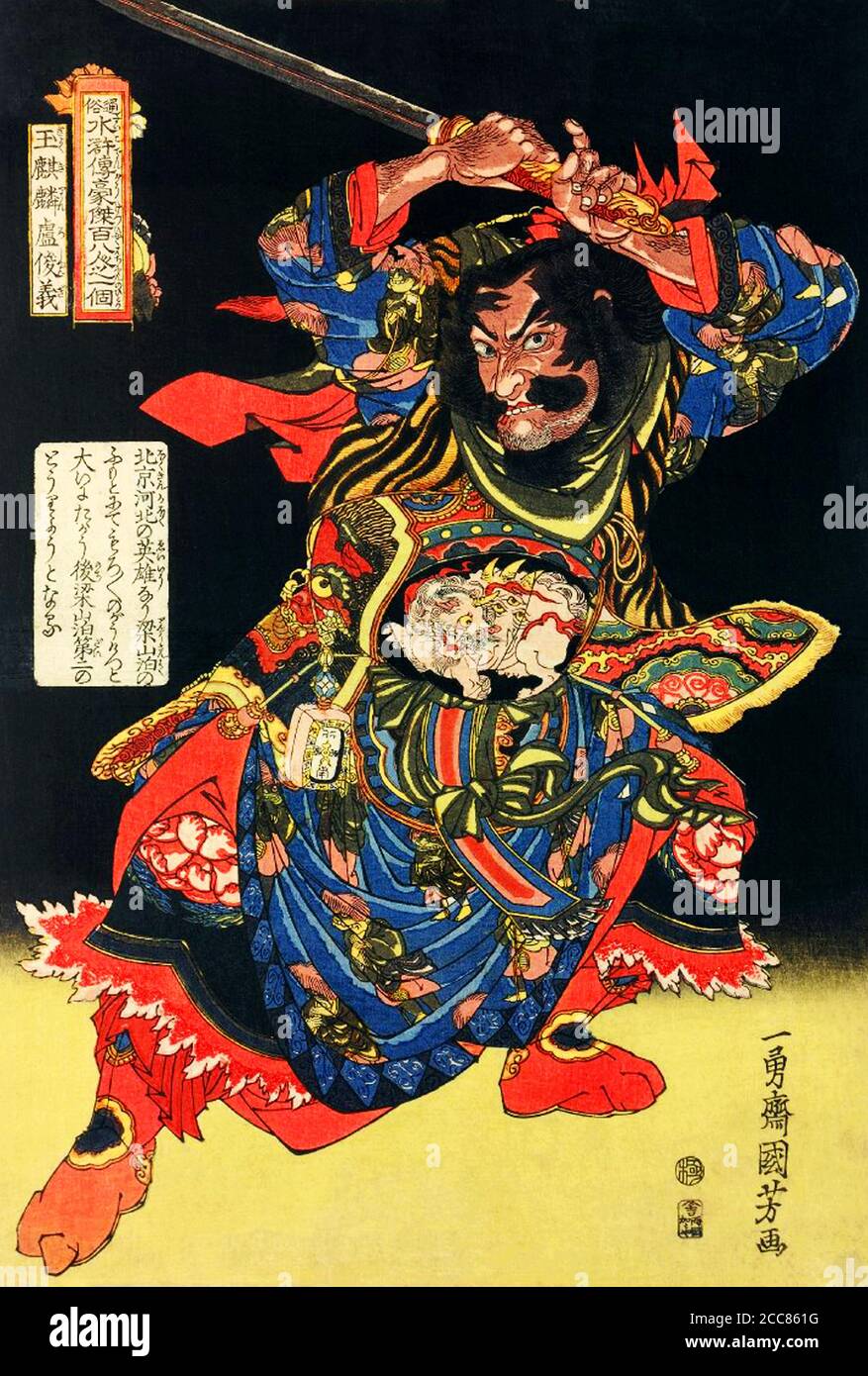 Japan: Lu Junyi or Gyokkirin Roshungi, one of the '108 Heroes of the Water Margin', in full armour, raising his sword with both hands. Woodblock print by Utagawa Kuniyoshi (1797-1863), c, 1827-1830. The Water Margin (known in Chinese as Shuihu Zhuan, sometimes abbreviated to Shuihu, known as Suikoden in Japanese, as well as Outlaws of the Marsh, Tale of the Marshes, All Men Are Brothers, Men of the Marshes, or The Marshes of Mount Liang in English, is a 14th century novel and one of the Four Great Classical Novels of Chinese literature. Attributed to Shi Nai'an and written in vernacular Chines Stock Photohttps://www.alamy.com/image-license-details/?v=1https://www.alamy.com/japan-lu-junyi-or-gyokkirin-roshungi-one-of-the-108-heroes-of-the-water-margin-in-full-armour-raising-his-sword-with-both-hands-woodblock-print-by-utagawa-kuniyoshi-1797-1863-c-1827-1830-the-water-margin-known-in-chinese-as-shuihu-zhuan-sometimes-abbreviated-to-shuihu-known-as-suikoden-in-japanese-as-well-as-outlaws-of-the-marsh-tale-of-the-marshes-all-men-are-brothers-men-of-the-marshes-or-the-marshes-of-mount-liang-in-english-is-a-14th-century-novel-and-one-of-the-four-great-classical-novels-of-chinese-literature-attributed-to-shi-naian-and-written-in-vernacular-chines-image368973964.html
Japan: Lu Junyi or Gyokkirin Roshungi, one of the '108 Heroes of the Water Margin', in full armour, raising his sword with both hands. Woodblock print by Utagawa Kuniyoshi (1797-1863), c, 1827-1830. The Water Margin (known in Chinese as Shuihu Zhuan, sometimes abbreviated to Shuihu, known as Suikoden in Japanese, as well as Outlaws of the Marsh, Tale of the Marshes, All Men Are Brothers, Men of the Marshes, or The Marshes of Mount Liang in English, is a 14th century novel and one of the Four Great Classical Novels of Chinese literature. Attributed to Shi Nai'an and written in vernacular Chines Stock Photohttps://www.alamy.com/image-license-details/?v=1https://www.alamy.com/japan-lu-junyi-or-gyokkirin-roshungi-one-of-the-108-heroes-of-the-water-margin-in-full-armour-raising-his-sword-with-both-hands-woodblock-print-by-utagawa-kuniyoshi-1797-1863-c-1827-1830-the-water-margin-known-in-chinese-as-shuihu-zhuan-sometimes-abbreviated-to-shuihu-known-as-suikoden-in-japanese-as-well-as-outlaws-of-the-marsh-tale-of-the-marshes-all-men-are-brothers-men-of-the-marshes-or-the-marshes-of-mount-liang-in-english-is-a-14th-century-novel-and-one-of-the-four-great-classical-novels-of-chinese-literature-attributed-to-shi-naian-and-written-in-vernacular-chines-image368973964.htmlRM2CC861G–Japan: Lu Junyi or Gyokkirin Roshungi, one of the '108 Heroes of the Water Margin', in full armour, raising his sword with both hands. Woodblock print by Utagawa Kuniyoshi (1797-1863), c, 1827-1830. The Water Margin (known in Chinese as Shuihu Zhuan, sometimes abbreviated to Shuihu, known as Suikoden in Japanese, as well as Outlaws of the Marsh, Tale of the Marshes, All Men Are Brothers, Men of the Marshes, or The Marshes of Mount Liang in English, is a 14th century novel and one of the Four Great Classical Novels of Chinese literature. Attributed to Shi Nai'an and written in vernacular Chines
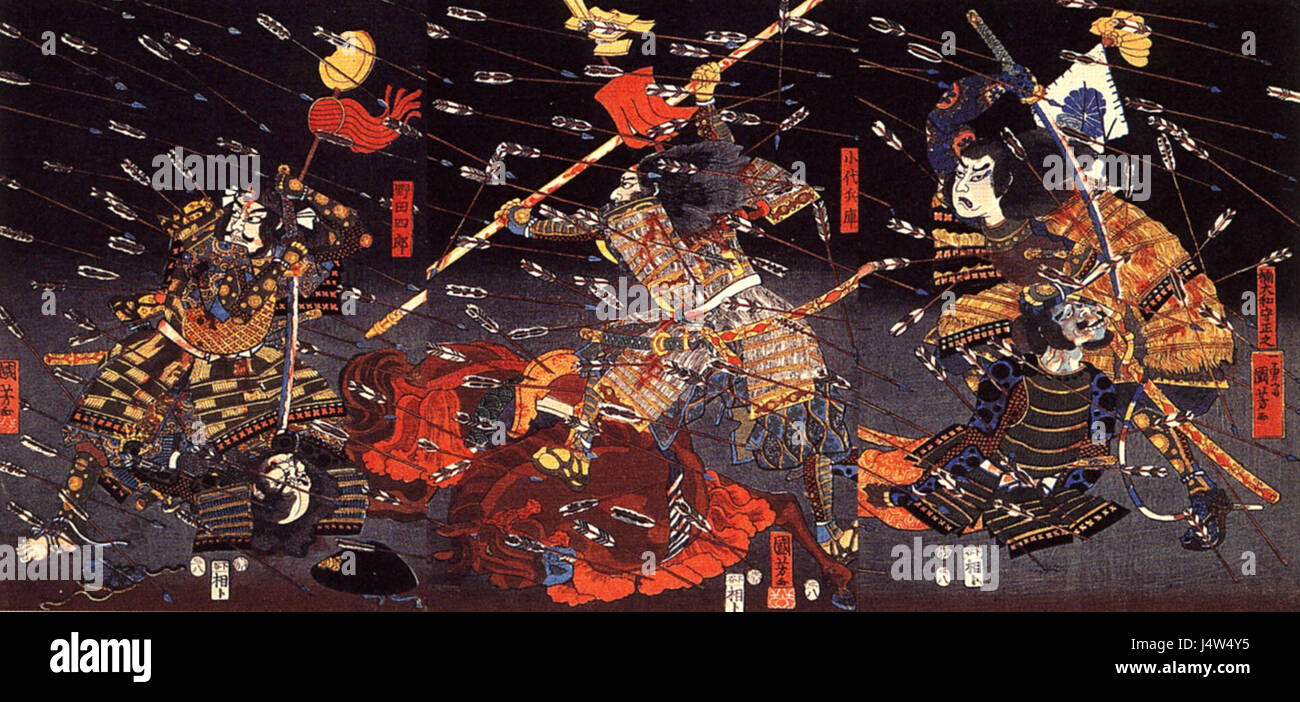 The last stand of the Kusunoki at Shijonawate Stock Photohttps://www.alamy.com/image-license-details/?v=1https://www.alamy.com/stock-photo-the-last-stand-of-the-kusunoki-at-shijonawate-140694265.html
The last stand of the Kusunoki at Shijonawate Stock Photohttps://www.alamy.com/image-license-details/?v=1https://www.alamy.com/stock-photo-the-last-stand-of-the-kusunoki-at-shijonawate-140694265.htmlRMJ4W4Y5–The last stand of the Kusunoki at Shijonawate
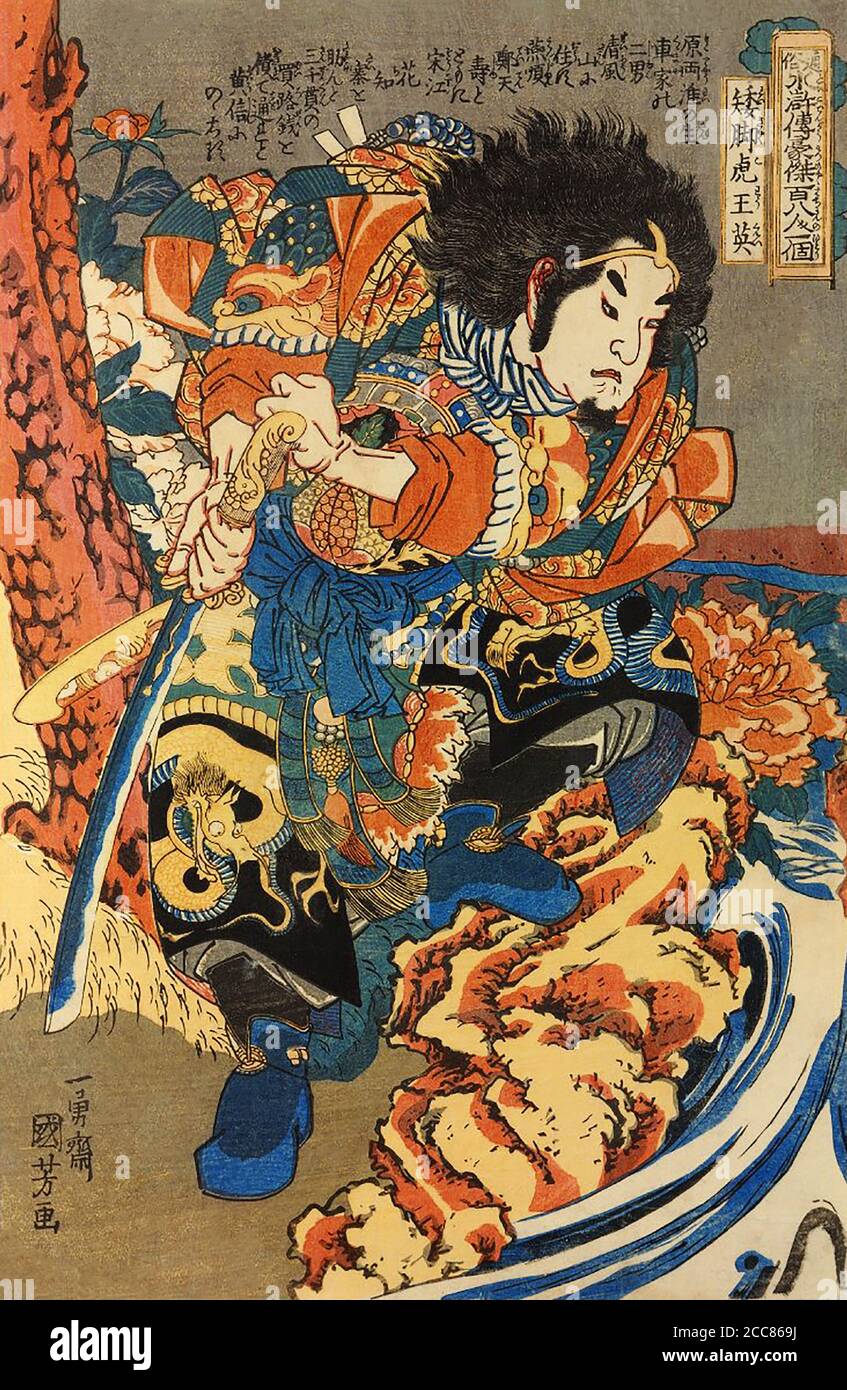 Japan: Wang Ying or Waikyakuko Oei, one of the 'One Hundred and Eight Heroes of the Water Margin', drawing his sword beside a river. Woodblock print by Utagawa Kuniyoshi (1797-1863), 1827-1830. The Water Margin (known in Chinese as Shuihu Zhuan, sometimes abbreviated to Shuihu, known as Suikoden in Japanese, as well as Outlaws of the Marsh, Tale of the Marshes, All Men Are Brothers, Men of the Marshes, or The Marshes of Mount Liang in English, is a 14th century novel and one of the Four Great Classical Novels of Chinese literature. Attributed to Shi Nai'an and written in vernacular Chinese. Stock Photohttps://www.alamy.com/image-license-details/?v=1https://www.alamy.com/japan-wang-ying-or-waikyakuko-oei-one-of-the-one-hundred-and-eight-heroes-of-the-water-margin-drawing-his-sword-beside-a-river-woodblock-print-by-utagawa-kuniyoshi-1797-1863-1827-1830-the-water-margin-known-in-chinese-as-shuihu-zhuan-sometimes-abbreviated-to-shuihu-known-as-suikoden-in-japanese-as-well-as-outlaws-of-the-marsh-tale-of-the-marshes-all-men-are-brothers-men-of-the-marshes-or-the-marshes-of-mount-liang-in-english-is-a-14th-century-novel-and-one-of-the-four-great-classical-novels-of-chinese-literature-attributed-to-shi-naian-and-written-in-vernacular-chinese-image368974190.html
Japan: Wang Ying or Waikyakuko Oei, one of the 'One Hundred and Eight Heroes of the Water Margin', drawing his sword beside a river. Woodblock print by Utagawa Kuniyoshi (1797-1863), 1827-1830. The Water Margin (known in Chinese as Shuihu Zhuan, sometimes abbreviated to Shuihu, known as Suikoden in Japanese, as well as Outlaws of the Marsh, Tale of the Marshes, All Men Are Brothers, Men of the Marshes, or The Marshes of Mount Liang in English, is a 14th century novel and one of the Four Great Classical Novels of Chinese literature. Attributed to Shi Nai'an and written in vernacular Chinese. Stock Photohttps://www.alamy.com/image-license-details/?v=1https://www.alamy.com/japan-wang-ying-or-waikyakuko-oei-one-of-the-one-hundred-and-eight-heroes-of-the-water-margin-drawing-his-sword-beside-a-river-woodblock-print-by-utagawa-kuniyoshi-1797-1863-1827-1830-the-water-margin-known-in-chinese-as-shuihu-zhuan-sometimes-abbreviated-to-shuihu-known-as-suikoden-in-japanese-as-well-as-outlaws-of-the-marsh-tale-of-the-marshes-all-men-are-brothers-men-of-the-marshes-or-the-marshes-of-mount-liang-in-english-is-a-14th-century-novel-and-one-of-the-four-great-classical-novels-of-chinese-literature-attributed-to-shi-naian-and-written-in-vernacular-chinese-image368974190.htmlRM2CC869J–Japan: Wang Ying or Waikyakuko Oei, one of the 'One Hundred and Eight Heroes of the Water Margin', drawing his sword beside a river. Woodblock print by Utagawa Kuniyoshi (1797-1863), 1827-1830. The Water Margin (known in Chinese as Shuihu Zhuan, sometimes abbreviated to Shuihu, known as Suikoden in Japanese, as well as Outlaws of the Marsh, Tale of the Marshes, All Men Are Brothers, Men of the Marshes, or The Marshes of Mount Liang in English, is a 14th century novel and one of the Four Great Classical Novels of Chinese literature. Attributed to Shi Nai'an and written in vernacular Chinese.
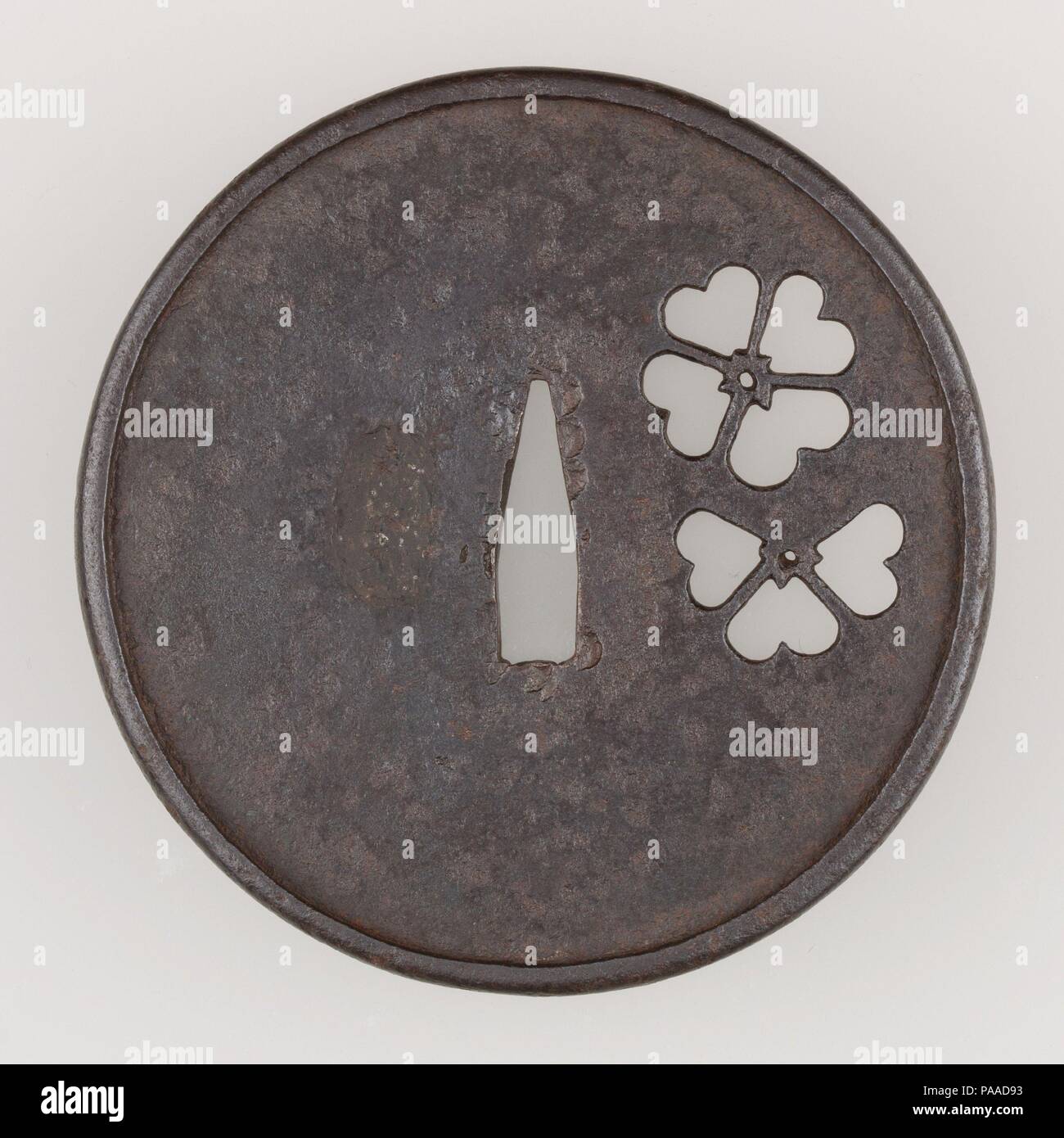 Sword Guard (Tsuba). Culture: Japanese. Dimensions: H. 3 3/4 in. (9.5 cm); W. 3 11/16 in. (9.4 cm); thickness 1/4 in. (0.6 cm); Wt. 4.6 oz. (130.4 g). Date: late 14th-early 15th century. This tsuba features an openwork design of two overlapping flowers. It is made in the so-called ko-kachushi (armor-maker's) style. Museum: Metropolitan Museum of Art, New York, USA. Stock Photohttps://www.alamy.com/image-license-details/?v=1https://www.alamy.com/sword-guard-tsuba-culture-japanese-dimensions-h-3-34-in-95-cm-w-3-1116-in-94-cm-thickness-14-in-06-cm-wt-46-oz-1304-g-date-late-14th-early-15th-century-this-tsuba-features-an-openwork-design-of-two-overlapping-flowers-it-is-made-in-the-so-called-ko-kachushi-armor-makers-style-museum-metropolitan-museum-of-art-new-york-usa-image212900943.html
Sword Guard (Tsuba). Culture: Japanese. Dimensions: H. 3 3/4 in. (9.5 cm); W. 3 11/16 in. (9.4 cm); thickness 1/4 in. (0.6 cm); Wt. 4.6 oz. (130.4 g). Date: late 14th-early 15th century. This tsuba features an openwork design of two overlapping flowers. It is made in the so-called ko-kachushi (armor-maker's) style. Museum: Metropolitan Museum of Art, New York, USA. Stock Photohttps://www.alamy.com/image-license-details/?v=1https://www.alamy.com/sword-guard-tsuba-culture-japanese-dimensions-h-3-34-in-95-cm-w-3-1116-in-94-cm-thickness-14-in-06-cm-wt-46-oz-1304-g-date-late-14th-early-15th-century-this-tsuba-features-an-openwork-design-of-two-overlapping-flowers-it-is-made-in-the-so-called-ko-kachushi-armor-makers-style-museum-metropolitan-museum-of-art-new-york-usa-image212900943.htmlRMPAAD93–Sword Guard (Tsuba). Culture: Japanese. Dimensions: H. 3 3/4 in. (9.5 cm); W. 3 11/16 in. (9.4 cm); thickness 1/4 in. (0.6 cm); Wt. 4.6 oz. (130.4 g). Date: late 14th-early 15th century. This tsuba features an openwork design of two overlapping flowers. It is made in the so-called ko-kachushi (armor-maker's) style. Museum: Metropolitan Museum of Art, New York, USA.
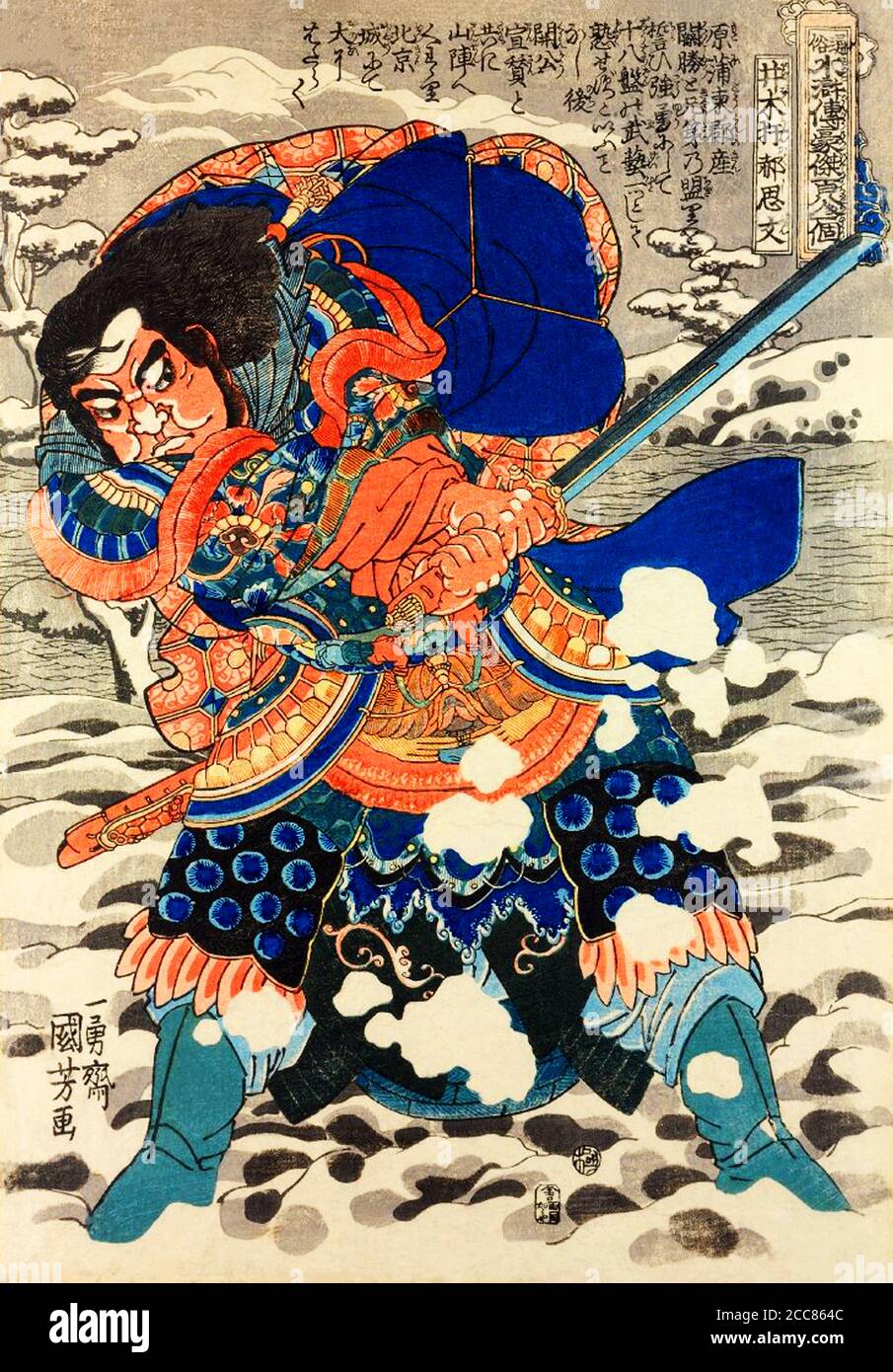 Japan: Hao Siwen or Seibokukan Kakushibun, one of the 'One Hundred and Eight Heroes of the Water Margin', in the snow, wielding a sword with both hands in defence. Woodblock print by Utagawa Kuniyoshi (1797-1863), 1827-1830. The Water Margin (known in Chinese as Shuihu Zhuan, sometimes abbreviated to Shuihu, known as Suikoden in Japanese, as well as Outlaws of the Marsh, Tale of the Marshes, All Men Are Brothers, Men of the Marshes, or The Marshes of Mount Liang in English, is a 14th century novel and one of the Four Great Classical Novels of Chinese literature. Attributed to Shi Nai'an and wr Stock Photohttps://www.alamy.com/image-license-details/?v=1https://www.alamy.com/japan-hao-siwen-or-seibokukan-kakushibun-one-of-the-one-hundred-and-eight-heroes-of-the-water-margin-in-the-snow-wielding-a-sword-with-both-hands-in-defence-woodblock-print-by-utagawa-kuniyoshi-1797-1863-1827-1830-the-water-margin-known-in-chinese-as-shuihu-zhuan-sometimes-abbreviated-to-shuihu-known-as-suikoden-in-japanese-as-well-as-outlaws-of-the-marsh-tale-of-the-marshes-all-men-are-brothers-men-of-the-marshes-or-the-marshes-of-mount-liang-in-english-is-a-14th-century-novel-and-one-of-the-four-great-classical-novels-of-chinese-literature-attributed-to-shi-naian-and-wr-image368974044.html
Japan: Hao Siwen or Seibokukan Kakushibun, one of the 'One Hundred and Eight Heroes of the Water Margin', in the snow, wielding a sword with both hands in defence. Woodblock print by Utagawa Kuniyoshi (1797-1863), 1827-1830. The Water Margin (known in Chinese as Shuihu Zhuan, sometimes abbreviated to Shuihu, known as Suikoden in Japanese, as well as Outlaws of the Marsh, Tale of the Marshes, All Men Are Brothers, Men of the Marshes, or The Marshes of Mount Liang in English, is a 14th century novel and one of the Four Great Classical Novels of Chinese literature. Attributed to Shi Nai'an and wr Stock Photohttps://www.alamy.com/image-license-details/?v=1https://www.alamy.com/japan-hao-siwen-or-seibokukan-kakushibun-one-of-the-one-hundred-and-eight-heroes-of-the-water-margin-in-the-snow-wielding-a-sword-with-both-hands-in-defence-woodblock-print-by-utagawa-kuniyoshi-1797-1863-1827-1830-the-water-margin-known-in-chinese-as-shuihu-zhuan-sometimes-abbreviated-to-shuihu-known-as-suikoden-in-japanese-as-well-as-outlaws-of-the-marsh-tale-of-the-marshes-all-men-are-brothers-men-of-the-marshes-or-the-marshes-of-mount-liang-in-english-is-a-14th-century-novel-and-one-of-the-four-great-classical-novels-of-chinese-literature-attributed-to-shi-naian-and-wr-image368974044.htmlRM2CC864C–Japan: Hao Siwen or Seibokukan Kakushibun, one of the 'One Hundred and Eight Heroes of the Water Margin', in the snow, wielding a sword with both hands in defence. Woodblock print by Utagawa Kuniyoshi (1797-1863), 1827-1830. The Water Margin (known in Chinese as Shuihu Zhuan, sometimes abbreviated to Shuihu, known as Suikoden in Japanese, as well as Outlaws of the Marsh, Tale of the Marshes, All Men Are Brothers, Men of the Marshes, or The Marshes of Mount Liang in English, is a 14th century novel and one of the Four Great Classical Novels of Chinese literature. Attributed to Shi Nai'an and wr
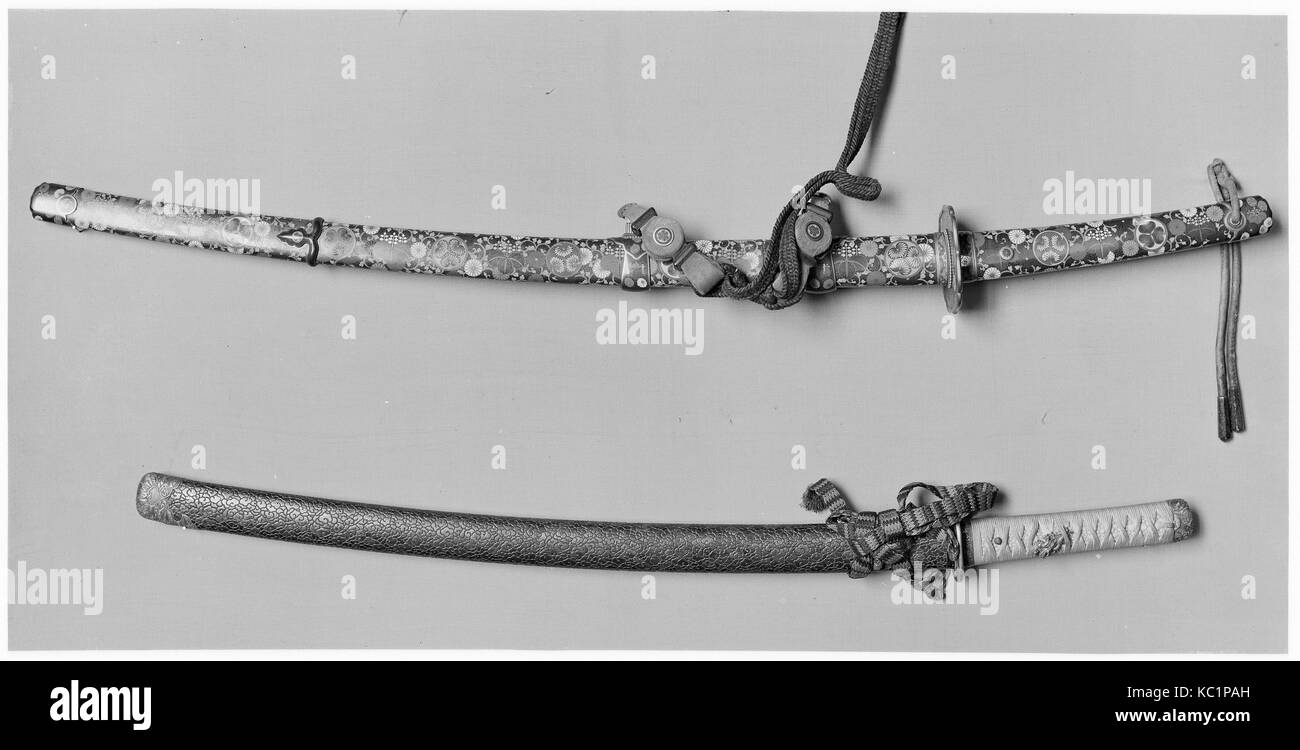 Blade and Mounting for a Slung Sword (Tachi), blade, late 13th–early 14th century; mounting, 18th–early 19th century Stock Photohttps://www.alamy.com/image-license-details/?v=1https://www.alamy.com/stock-image-blade-and-mounting-for-a-slung-sword-tachi-blade-late-13thearly-14th-162308681.html
Blade and Mounting for a Slung Sword (Tachi), blade, late 13th–early 14th century; mounting, 18th–early 19th century Stock Photohttps://www.alamy.com/image-license-details/?v=1https://www.alamy.com/stock-image-blade-and-mounting-for-a-slung-sword-tachi-blade-late-13thearly-14th-162308681.htmlRMKC1PAH–Blade and Mounting for a Slung Sword (Tachi), blade, late 13th–early 14th century; mounting, 18th–early 19th century
 Elsie and Doris Waters the famous comedy team of the music halls and stage shows, returned to England today after a visit to Burma and the Far East where they have been entertaining the troops. Picture shows: Elsie and Doris holding a Japanese sword presented to them by warrant officers of the 14th Army. 22 March 1946 Stock Photohttps://www.alamy.com/image-license-details/?v=1https://www.alamy.com/elsie-and-doris-waters-the-famous-comedy-team-of-the-music-halls-and-stage-shows-returned-to-england-today-after-a-visit-to-burma-and-the-far-east-where-they-have-been-entertaining-the-troops-picture-shows-elsie-and-doris-holding-a-japanese-sword-presented-to-them-by-warrant-officers-of-the-14th-army-22-march-1946-image623945683.html
Elsie and Doris Waters the famous comedy team of the music halls and stage shows, returned to England today after a visit to Burma and the Far East where they have been entertaining the troops. Picture shows: Elsie and Doris holding a Japanese sword presented to them by warrant officers of the 14th Army. 22 March 1946 Stock Photohttps://www.alamy.com/image-license-details/?v=1https://www.alamy.com/elsie-and-doris-waters-the-famous-comedy-team-of-the-music-halls-and-stage-shows-returned-to-england-today-after-a-visit-to-burma-and-the-far-east-where-they-have-been-entertaining-the-troops-picture-shows-elsie-and-doris-holding-a-japanese-sword-presented-to-them-by-warrant-officers-of-the-14th-army-22-march-1946-image623945683.htmlRM2Y7352B–Elsie and Doris Waters the famous comedy team of the music halls and stage shows, returned to England today after a visit to Burma and the Far East where they have been entertaining the troops. Picture shows: Elsie and Doris holding a Japanese sword presented to them by warrant officers of the 14th Army. 22 March 1946
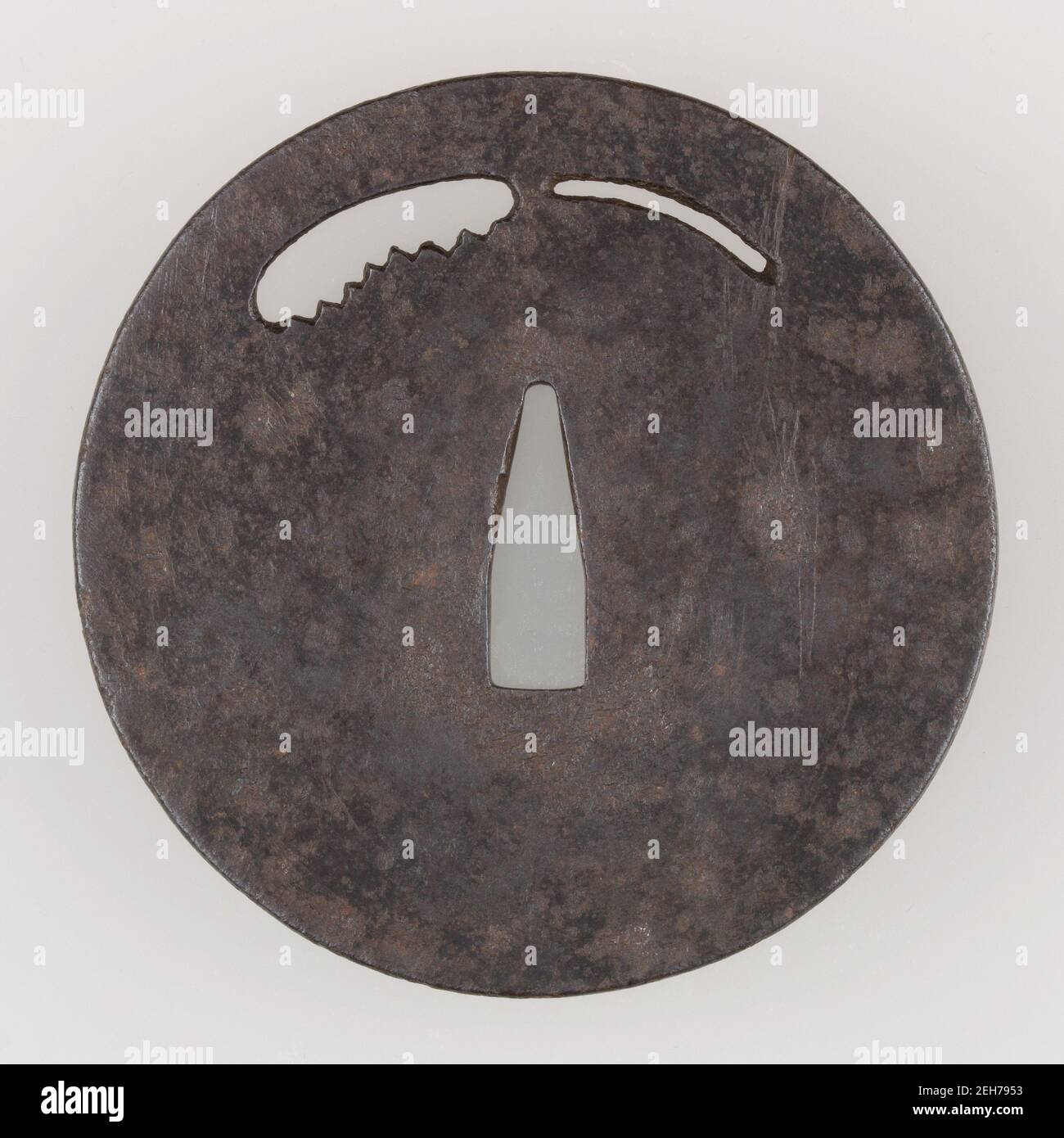 Sword Guard (Tsuba), Japanese, late 14th century. Stock Photohttps://www.alamy.com/image-license-details/?v=1https://www.alamy.com/sword-guard-tsuba-japanese-late-14th-century-image406448479.html
Sword Guard (Tsuba), Japanese, late 14th century. Stock Photohttps://www.alamy.com/image-license-details/?v=1https://www.alamy.com/sword-guard-tsuba-japanese-late-14th-century-image406448479.htmlRM2EH7953–Sword Guard (Tsuba), Japanese, late 14th century.
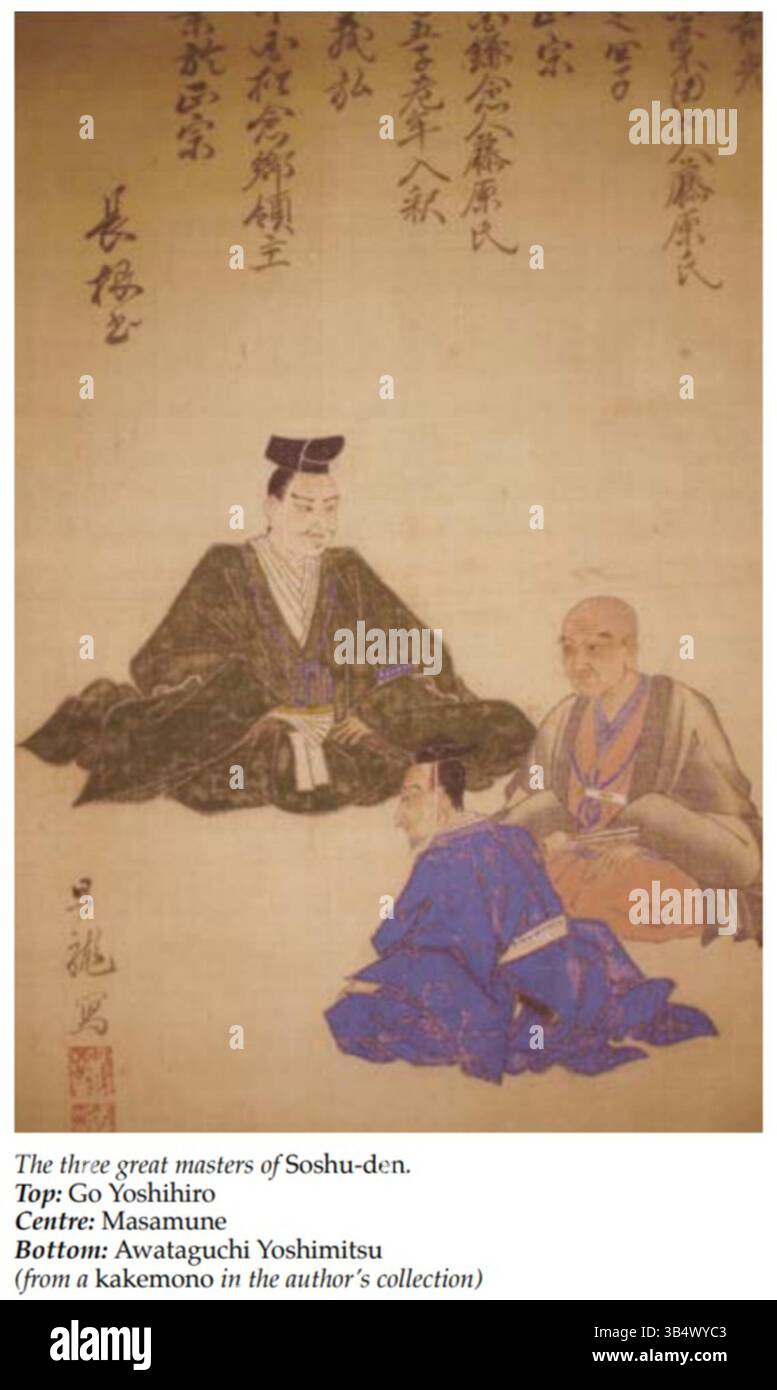 A depiction of the three legendary swordsmiths from the Soshu-den school: Go Yoshihiro, Masamune, and Awataguchi Yoshimitsu, dating back to the 14th century. These masters are renowned for their craftsmanship in sword-making. Stock Photohttps://www.alamy.com/image-license-details/?v=1https://www.alamy.com/a-depiction-of-the-three-legendary-swordsmiths-from-the-soshu-den-school-go-yoshihiro-masamune-and-awataguchi-yoshimitsu-dating-back-to-the-14th-century-these-masters-are-renowned-for-their-craftsmanship-in-sword-making-image674233283.html
A depiction of the three legendary swordsmiths from the Soshu-den school: Go Yoshihiro, Masamune, and Awataguchi Yoshimitsu, dating back to the 14th century. These masters are renowned for their craftsmanship in sword-making. Stock Photohttps://www.alamy.com/image-license-details/?v=1https://www.alamy.com/a-depiction-of-the-three-legendary-swordsmiths-from-the-soshu-den-school-go-yoshihiro-masamune-and-awataguchi-yoshimitsu-dating-back-to-the-14th-century-these-masters-are-renowned-for-their-craftsmanship-in-sword-making-image674233283.htmlRM3B4WYC3–A depiction of the three legendary swordsmiths from the Soshu-den school: Go Yoshihiro, Masamune, and Awataguchi Yoshimitsu, dating back to the 14th century. These masters are renowned for their craftsmanship in sword-making.
 A bo (a monk's staff), Japan, Muromachi period Typical walking staff with finely worked bronze finial and inserted mounting for a sword. Slightly damaged two-piece wooden shaft coated in black colour, with three dimensional lacquer finish. Brass rattle finial with one (of two) preserved bronze rings, cast in one piece. In the shaft a wooden replacement blade (tsunagi), length 179 cm. Corresponding sword blade enclosed in a shirasaya, shinogi-zukuri, chu-kissaki, no zori. Suguha hamon ending in the upper third, therefore no boshi recognisable. Ita, Additional-Rights-Clearance-Info-Not-Available Stock Photohttps://www.alamy.com/image-license-details/?v=1https://www.alamy.com/a-bo-a-monks-staff-japan-muromachi-period-typical-walking-staff-with-finely-worked-bronze-finial-and-inserted-mounting-for-a-sword-slightly-damaged-two-piece-wooden-shaft-coated-in-black-colour-with-three-dimensional-lacquer-finish-brass-rattle-finial-with-one-of-two-preserved-bronze-rings-cast-in-one-piece-in-the-shaft-a-wooden-replacement-blade-tsunagi-length-179-cm-corresponding-sword-blade-enclosed-in-a-shirasaya-shinogi-zukuri-chu-kissaki-no-zori-suguha-hamon-ending-in-the-upper-third-therefore-no-boshi-recognisable-ita-additional-rights-clearance-info-not-available-image243192300.html
A bo (a monk's staff), Japan, Muromachi period Typical walking staff with finely worked bronze finial and inserted mounting for a sword. Slightly damaged two-piece wooden shaft coated in black colour, with three dimensional lacquer finish. Brass rattle finial with one (of two) preserved bronze rings, cast in one piece. In the shaft a wooden replacement blade (tsunagi), length 179 cm. Corresponding sword blade enclosed in a shirasaya, shinogi-zukuri, chu-kissaki, no zori. Suguha hamon ending in the upper third, therefore no boshi recognisable. Ita, Additional-Rights-Clearance-Info-Not-Available Stock Photohttps://www.alamy.com/image-license-details/?v=1https://www.alamy.com/a-bo-a-monks-staff-japan-muromachi-period-typical-walking-staff-with-finely-worked-bronze-finial-and-inserted-mounting-for-a-sword-slightly-damaged-two-piece-wooden-shaft-coated-in-black-colour-with-three-dimensional-lacquer-finish-brass-rattle-finial-with-one-of-two-preserved-bronze-rings-cast-in-one-piece-in-the-shaft-a-wooden-replacement-blade-tsunagi-length-179-cm-corresponding-sword-blade-enclosed-in-a-shirasaya-shinogi-zukuri-chu-kissaki-no-zori-suguha-hamon-ending-in-the-upper-third-therefore-no-boshi-recognisable-ita-additional-rights-clearance-info-not-available-image243192300.htmlRMT3JA78–A bo (a monk's staff), Japan, Muromachi period Typical walking staff with finely worked bronze finial and inserted mounting for a sword. Slightly damaged two-piece wooden shaft coated in black colour, with three dimensional lacquer finish. Brass rattle finial with one (of two) preserved bronze rings, cast in one piece. In the shaft a wooden replacement blade (tsunagi), length 179 cm. Corresponding sword blade enclosed in a shirasaya, shinogi-zukuri, chu-kissaki, no zori. Suguha hamon ending in the upper third, therefore no boshi recognisable. Ita, Additional-Rights-Clearance-Info-Not-Available
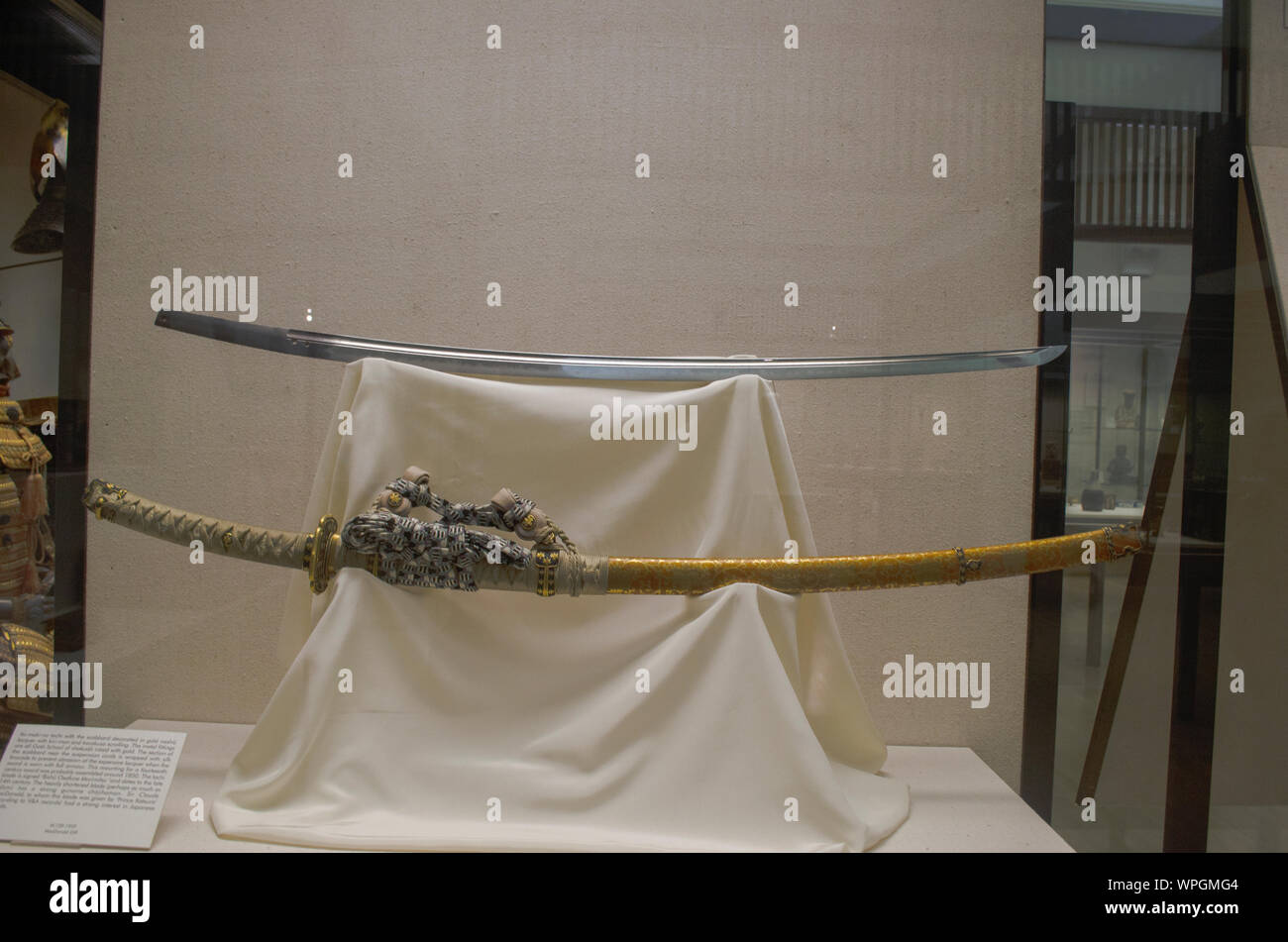 Long sword (Ito-maki-no tachi), signed by Morimitsu of Osafune, 14th century, Japan. Museum no. M.139-1929. Victoria and Albert Museum, London Stock Photohttps://www.alamy.com/image-license-details/?v=1https://www.alamy.com/long-sword-ito-maki-no-tachi-signed-by-morimitsu-of-osafune-14th-century-japan-museum-no-m139-1929-victoria-and-albert-museum-london-image272045316.html
Long sword (Ito-maki-no tachi), signed by Morimitsu of Osafune, 14th century, Japan. Museum no. M.139-1929. Victoria and Albert Museum, London Stock Photohttps://www.alamy.com/image-license-details/?v=1https://www.alamy.com/long-sword-ito-maki-no-tachi-signed-by-morimitsu-of-osafune-14th-century-japan-museum-no-m139-1929-victoria-and-albert-museum-london-image272045316.htmlRMWPGMG4–Long sword (Ito-maki-no tachi), signed by Morimitsu of Osafune, 14th century, Japan. Museum no. M.139-1929. Victoria and Albert Museum, London
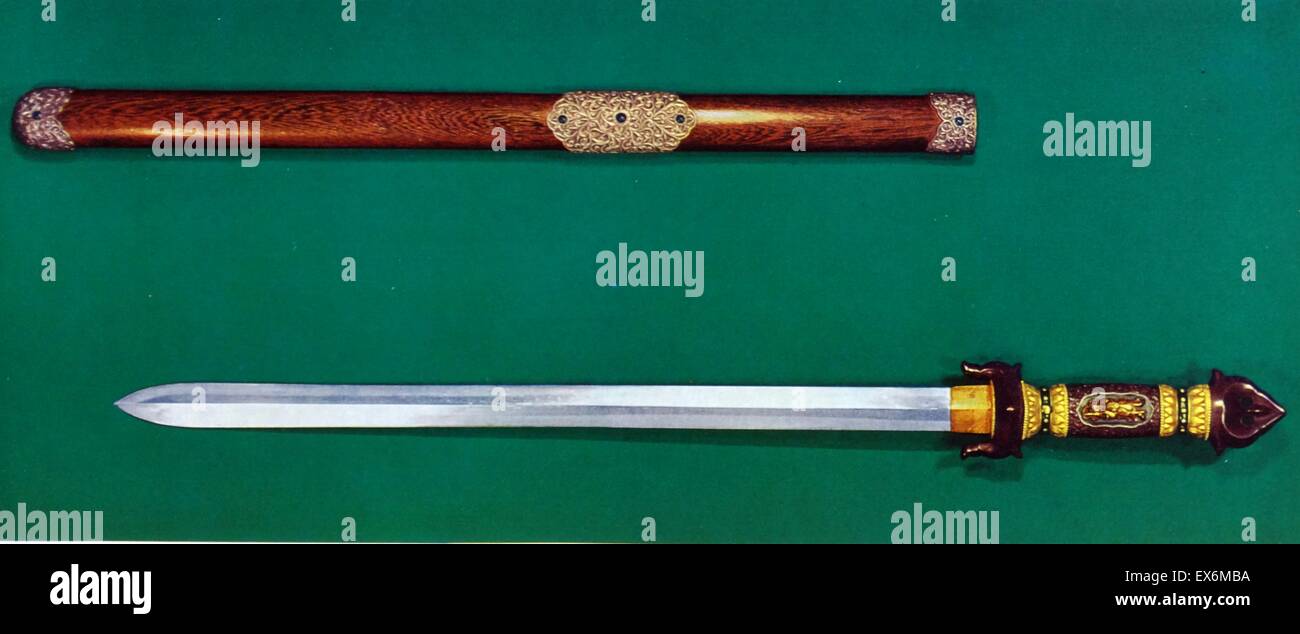 14th Century Japanese Sword and wooden sheath from the Muromachi Period. Stock Photohttps://www.alamy.com/image-license-details/?v=1https://www.alamy.com/stock-photo-14th-century-japanese-sword-and-wooden-sheath-from-the-muromachi-period-84970238.html
14th Century Japanese Sword and wooden sheath from the Muromachi Period. Stock Photohttps://www.alamy.com/image-license-details/?v=1https://www.alamy.com/stock-photo-14th-century-japanese-sword-and-wooden-sheath-from-the-muromachi-period-84970238.htmlRMEX6MBA–14th Century Japanese Sword and wooden sheath from the Muromachi Period.
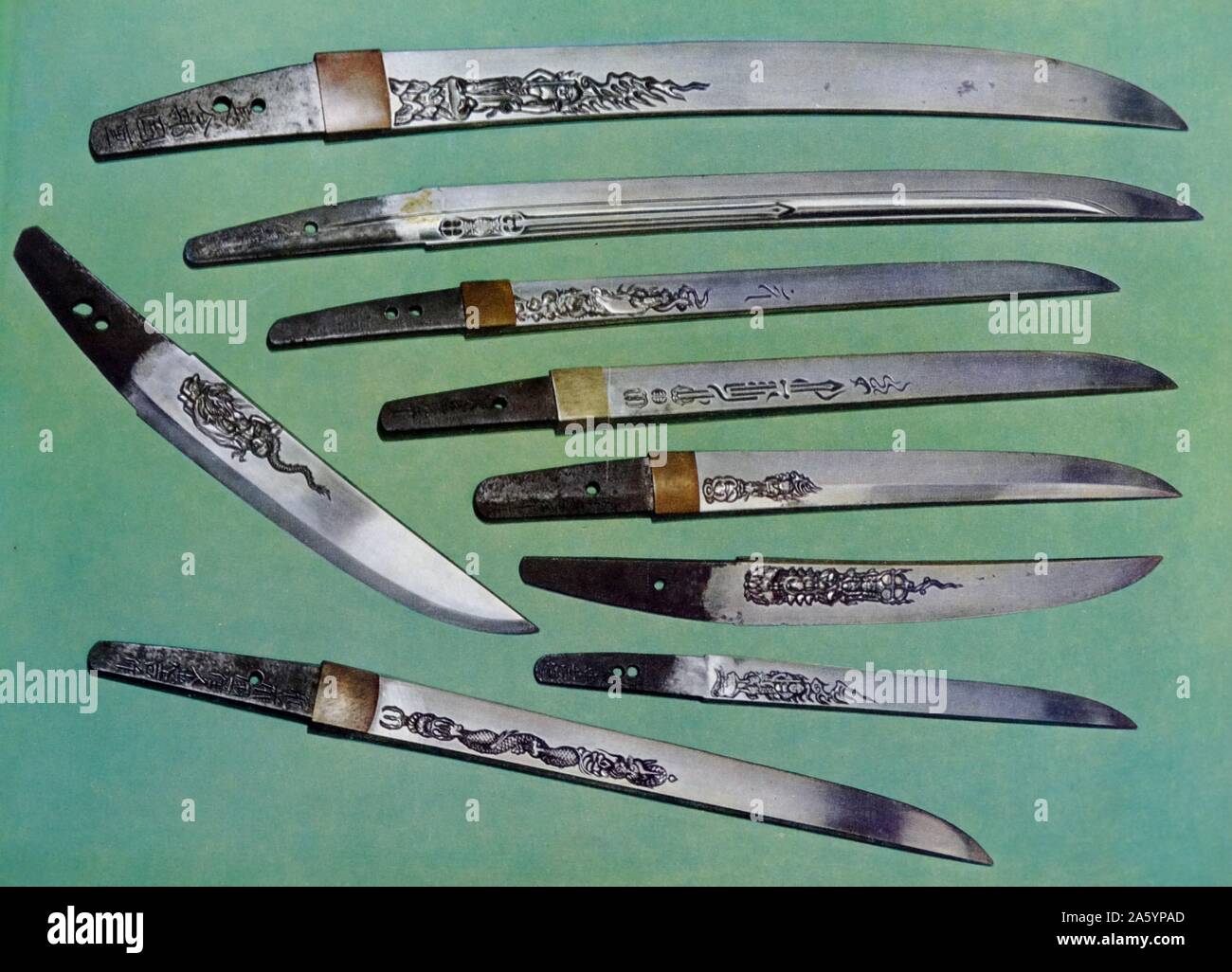 Collection of 14th Century engraved Japanese Tanto swords. Dated 14th Century Stock Photohttps://www.alamy.com/image-license-details/?v=1https://www.alamy.com/collection-of-14th-century-engraved-japanese-tanto-swords-dated-14th-century-image330680517.html
Collection of 14th Century engraved Japanese Tanto swords. Dated 14th Century Stock Photohttps://www.alamy.com/image-license-details/?v=1https://www.alamy.com/collection-of-14th-century-engraved-japanese-tanto-swords-dated-14th-century-image330680517.htmlRM2A5YPAD–Collection of 14th Century engraved Japanese Tanto swords. Dated 14th Century
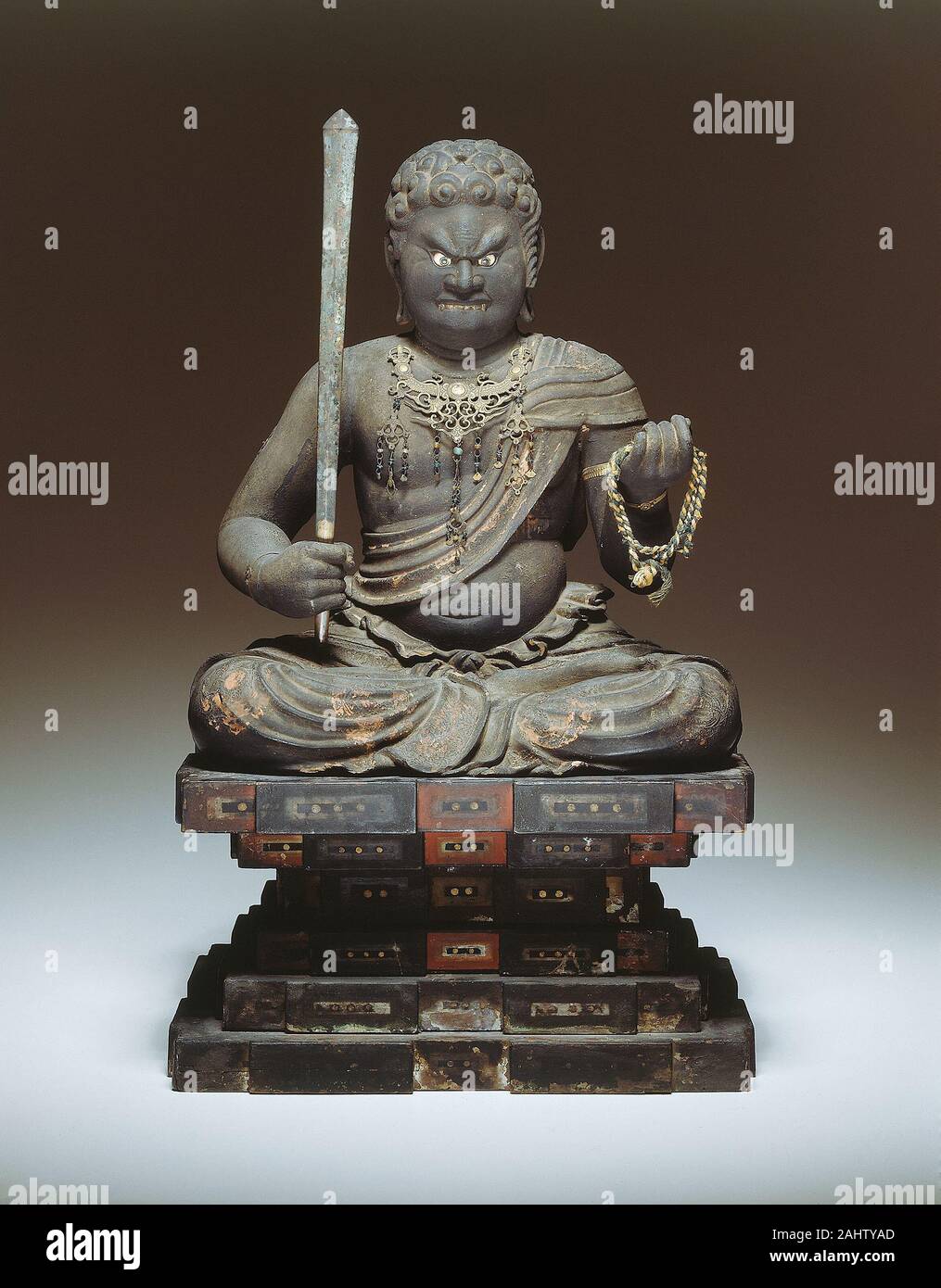 Fudo Myo-o. 1199–1399. Japan. Wood with polychromy and gilt-bronze accessories The name Fudo Myo-o means “the immovable or unshakable one.” He is one of five myo-o, or lords of light, whose threatening appearance guards the Law of Buddhism. He is equipped to guide the spiritual traveler past temptation on the path to enlightenment. Fudo’s bulging eyes, piercing stare, and protruding fangs express the intensity of his wrath against evil. Seated on a stylized rock formation that symbolizes his steadfastness, he once held his attributes, a rope and sword (these have been removed for conservation) Stock Photohttps://www.alamy.com/image-license-details/?v=1https://www.alamy.com/fudo-myo-o-11991399-japan-wood-with-polychromy-and-gilt-bronze-accessories-the-name-fudo-myo-o-means-the-immovable-or-unshakable-one-he-is-one-of-five-myo-o-or-lords-of-light-whose-threatening-appearance-guards-the-law-of-buddhism-he-is-equipped-to-guide-the-spiritual-traveler-past-temptation-on-the-path-to-enlightenment-fudos-bulging-eyes-piercing-stare-and-protruding-fangs-express-the-intensity-of-his-wrath-against-evil-seated-on-a-stylized-rock-formation-that-symbolizes-his-steadfastness-he-once-held-his-attributes-a-rope-and-sword-these-have-been-removed-for-conservation-image337994453.html
Fudo Myo-o. 1199–1399. Japan. Wood with polychromy and gilt-bronze accessories The name Fudo Myo-o means “the immovable or unshakable one.” He is one of five myo-o, or lords of light, whose threatening appearance guards the Law of Buddhism. He is equipped to guide the spiritual traveler past temptation on the path to enlightenment. Fudo’s bulging eyes, piercing stare, and protruding fangs express the intensity of his wrath against evil. Seated on a stylized rock formation that symbolizes his steadfastness, he once held his attributes, a rope and sword (these have been removed for conservation) Stock Photohttps://www.alamy.com/image-license-details/?v=1https://www.alamy.com/fudo-myo-o-11991399-japan-wood-with-polychromy-and-gilt-bronze-accessories-the-name-fudo-myo-o-means-the-immovable-or-unshakable-one-he-is-one-of-five-myo-o-or-lords-of-light-whose-threatening-appearance-guards-the-law-of-buddhism-he-is-equipped-to-guide-the-spiritual-traveler-past-temptation-on-the-path-to-enlightenment-fudos-bulging-eyes-piercing-stare-and-protruding-fangs-express-the-intensity-of-his-wrath-against-evil-seated-on-a-stylized-rock-formation-that-symbolizes-his-steadfastness-he-once-held-his-attributes-a-rope-and-sword-these-have-been-removed-for-conservation-image337994453.htmlRM2AHTYAD–Fudo Myo-o. 1199–1399. Japan. Wood with polychromy and gilt-bronze accessories The name Fudo Myo-o means “the immovable or unshakable one.” He is one of five myo-o, or lords of light, whose threatening appearance guards the Law of Buddhism. He is equipped to guide the spiritual traveler past temptation on the path to enlightenment. Fudo’s bulging eyes, piercing stare, and protruding fangs express the intensity of his wrath against evil. Seated on a stylized rock formation that symbolizes his steadfastness, he once held his attributes, a rope and sword (these have been removed for conservation)
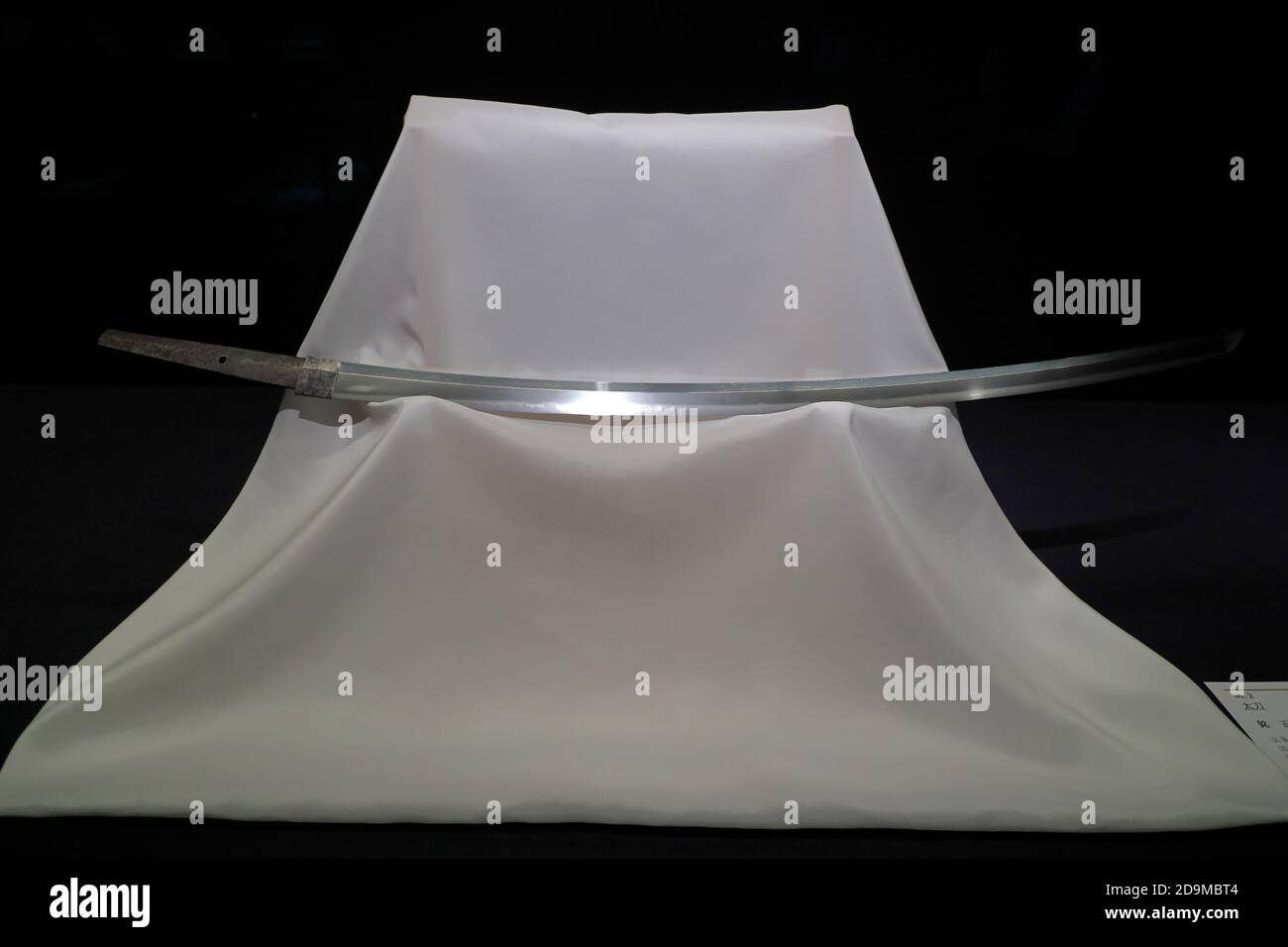 A National Treasure class Tachi sword from late Kamakura period of 14th century display in Japanese Sword Museum. Sumida-ku.Tokyo.Japan Stock Photohttps://www.alamy.com/image-license-details/?v=1https://www.alamy.com/a-national-treasure-class-tachi-sword-from-late-kamakura-period-of-14th-century-display-in-japanese-sword-museum-sumida-kutokyojapan-image384608340.html
A National Treasure class Tachi sword from late Kamakura period of 14th century display in Japanese Sword Museum. Sumida-ku.Tokyo.Japan Stock Photohttps://www.alamy.com/image-license-details/?v=1https://www.alamy.com/a-national-treasure-class-tachi-sword-from-late-kamakura-period-of-14th-century-display-in-japanese-sword-museum-sumida-kutokyojapan-image384608340.htmlRM2D9MBT4–A National Treasure class Tachi sword from late Kamakura period of 14th century display in Japanese Sword Museum. Sumida-ku.Tokyo.Japan
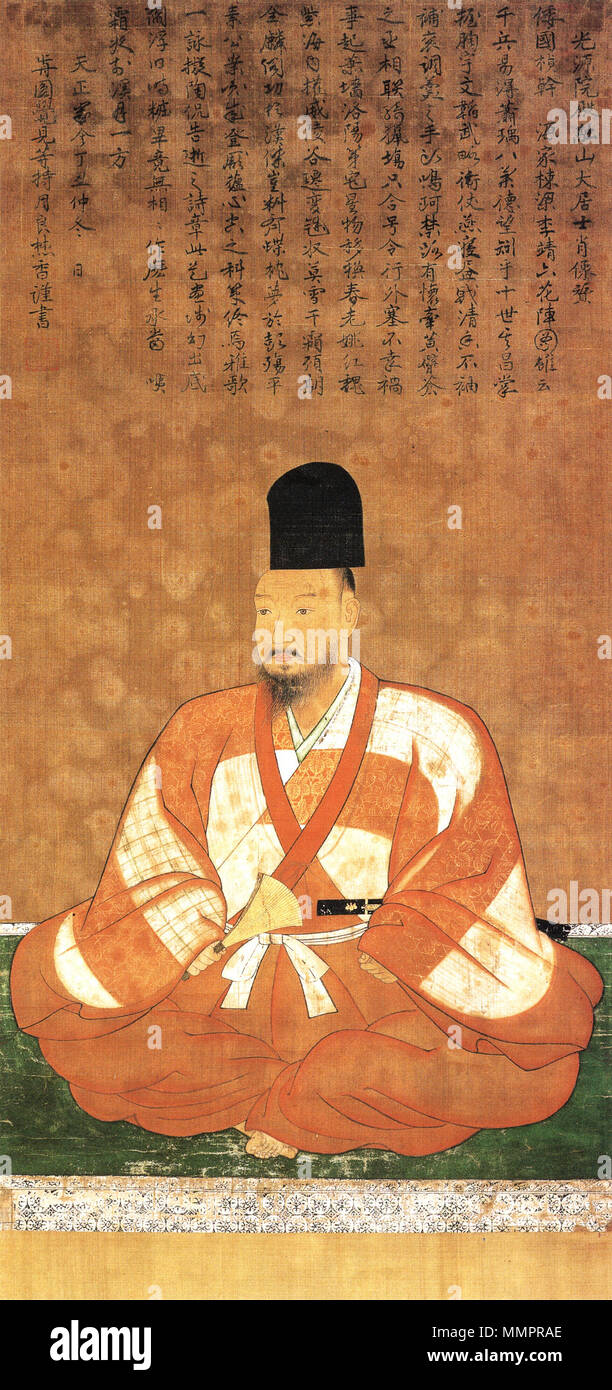 ???: ????? English: Portrait of Ashikaga Yoshiteru . 1577. Ashikaga Yoshiteru Stock Photohttps://www.alamy.com/image-license-details/?v=1https://www.alamy.com/english-portrait-of-ashikaga-yoshiteru-1577-ashikaga-yoshiteru-image184898070.html
???: ????? English: Portrait of Ashikaga Yoshiteru . 1577. Ashikaga Yoshiteru Stock Photohttps://www.alamy.com/image-license-details/?v=1https://www.alamy.com/english-portrait-of-ashikaga-yoshiteru-1577-ashikaga-yoshiteru-image184898070.htmlRMMMPRAE–???: ????? English: Portrait of Ashikaga Yoshiteru . 1577. Ashikaga Yoshiteru
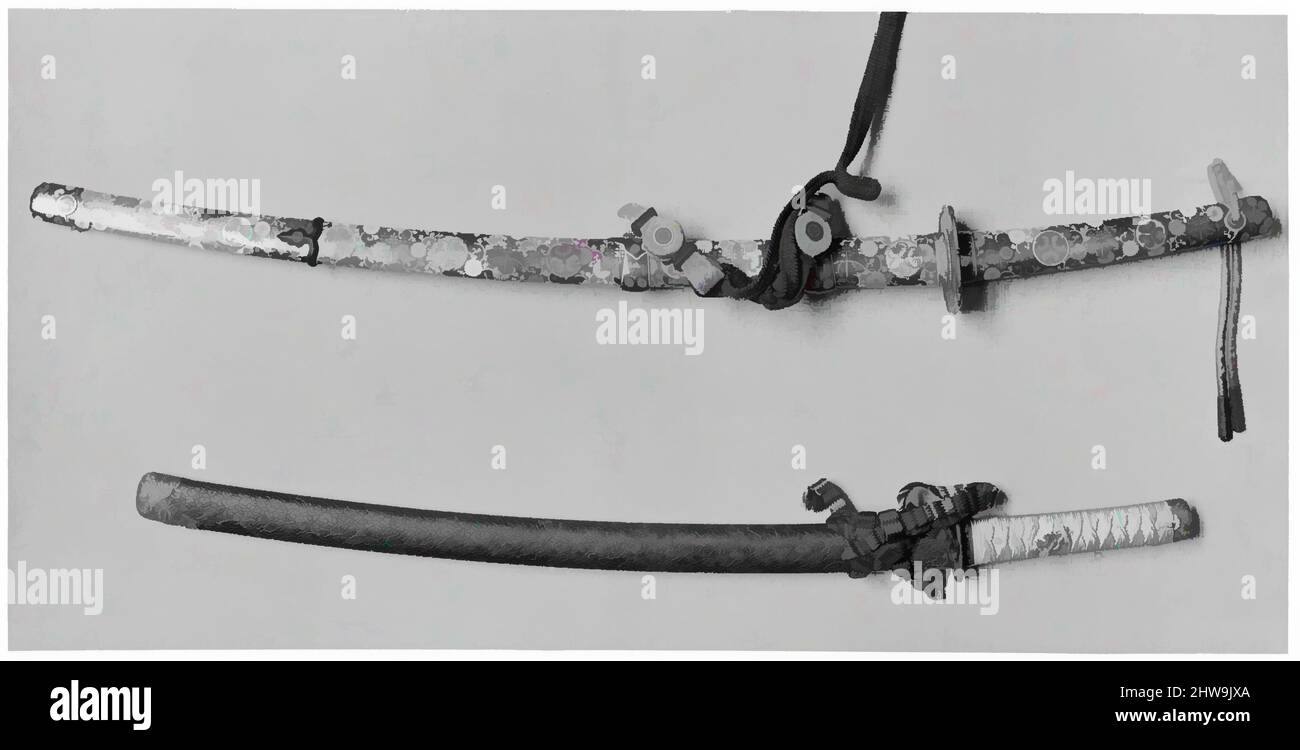 Art inspired by Blade and Mounting for a Slung Sword (Tachi), blade, late 13th–early 14th century; mounting, 18th–early 19th century, Japanese, Steel, wood, lacquer, rayskin (samé), thread, gold, silver, L. 32 7/8 in. (83. 5 cm); L. of blade 25 15/16 in. (65.8 cm); L. of cutting edge, Classic works modernized by Artotop with a splash of modernity. Shapes, color and value, eye-catching visual impact on art. Emotions through freedom of artworks in a contemporary way. A timeless message pursuing a wildly creative new direction. Artists turning to the digital medium and creating the Artotop NFT Stock Photohttps://www.alamy.com/image-license-details/?v=1https://www.alamy.com/art-inspired-by-blade-and-mounting-for-a-slung-sword-tachi-blade-late-13thearly-14th-century-mounting-18thearly-19th-century-japanese-steel-wood-lacquer-rayskin-sam-thread-gold-silver-l-32-78-in-83-5-cm-l-of-blade-25-1516-in-658-cm-l-of-cutting-edge-classic-works-modernized-by-artotop-with-a-splash-of-modernity-shapes-color-and-value-eye-catching-visual-impact-on-art-emotions-through-freedom-of-artworks-in-a-contemporary-way-a-timeless-message-pursuing-a-wildly-creative-new-direction-artists-turning-to-the-digital-medium-and-creating-the-artotop-nft-image463048386.html
Art inspired by Blade and Mounting for a Slung Sword (Tachi), blade, late 13th–early 14th century; mounting, 18th–early 19th century, Japanese, Steel, wood, lacquer, rayskin (samé), thread, gold, silver, L. 32 7/8 in. (83. 5 cm); L. of blade 25 15/16 in. (65.8 cm); L. of cutting edge, Classic works modernized by Artotop with a splash of modernity. Shapes, color and value, eye-catching visual impact on art. Emotions through freedom of artworks in a contemporary way. A timeless message pursuing a wildly creative new direction. Artists turning to the digital medium and creating the Artotop NFT Stock Photohttps://www.alamy.com/image-license-details/?v=1https://www.alamy.com/art-inspired-by-blade-and-mounting-for-a-slung-sword-tachi-blade-late-13thearly-14th-century-mounting-18thearly-19th-century-japanese-steel-wood-lacquer-rayskin-sam-thread-gold-silver-l-32-78-in-83-5-cm-l-of-blade-25-1516-in-658-cm-l-of-cutting-edge-classic-works-modernized-by-artotop-with-a-splash-of-modernity-shapes-color-and-value-eye-catching-visual-impact-on-art-emotions-through-freedom-of-artworks-in-a-contemporary-way-a-timeless-message-pursuing-a-wildly-creative-new-direction-artists-turning-to-the-digital-medium-and-creating-the-artotop-nft-image463048386.htmlRF2HW9JXA–Art inspired by Blade and Mounting for a Slung Sword (Tachi), blade, late 13th–early 14th century; mounting, 18th–early 19th century, Japanese, Steel, wood, lacquer, rayskin (samé), thread, gold, silver, L. 32 7/8 in. (83. 5 cm); L. of blade 25 15/16 in. (65.8 cm); L. of cutting edge, Classic works modernized by Artotop with a splash of modernity. Shapes, color and value, eye-catching visual impact on art. Emotions through freedom of artworks in a contemporary way. A timeless message pursuing a wildly creative new direction. Artists turning to the digital medium and creating the Artotop NFT
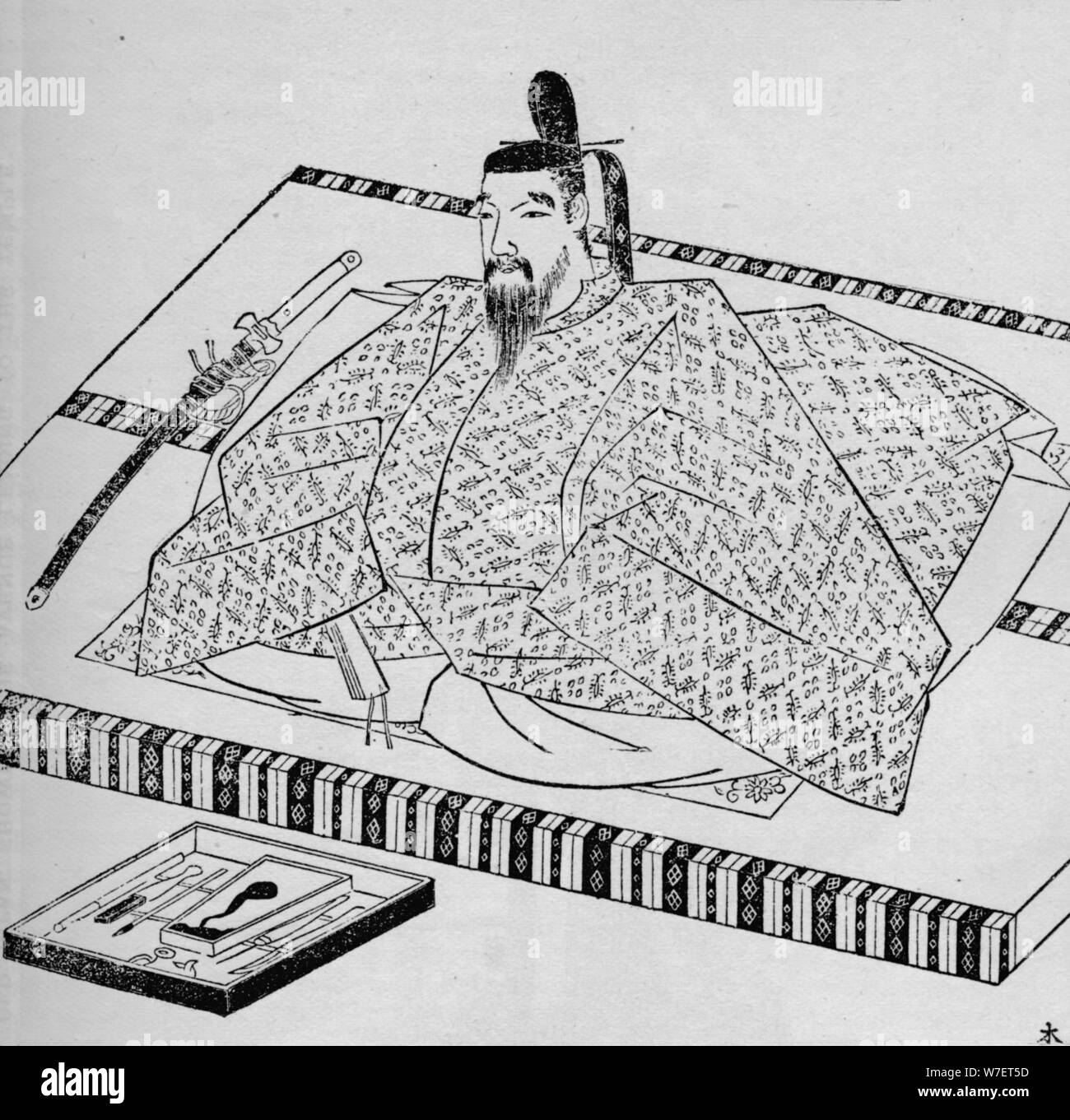 Go-Daigo, Emperor of Japan, 1907. Artist: Unknown. Stock Photohttps://www.alamy.com/image-license-details/?v=1https://www.alamy.com/go-daigo-emperor-of-japan-1907-artist-unknown-image262784409.html
Go-Daigo, Emperor of Japan, 1907. Artist: Unknown. Stock Photohttps://www.alamy.com/image-license-details/?v=1https://www.alamy.com/go-daigo-emperor-of-japan-1907-artist-unknown-image262784409.htmlRMW7ET5D–Go-Daigo, Emperor of Japan, 1907. Artist: Unknown.
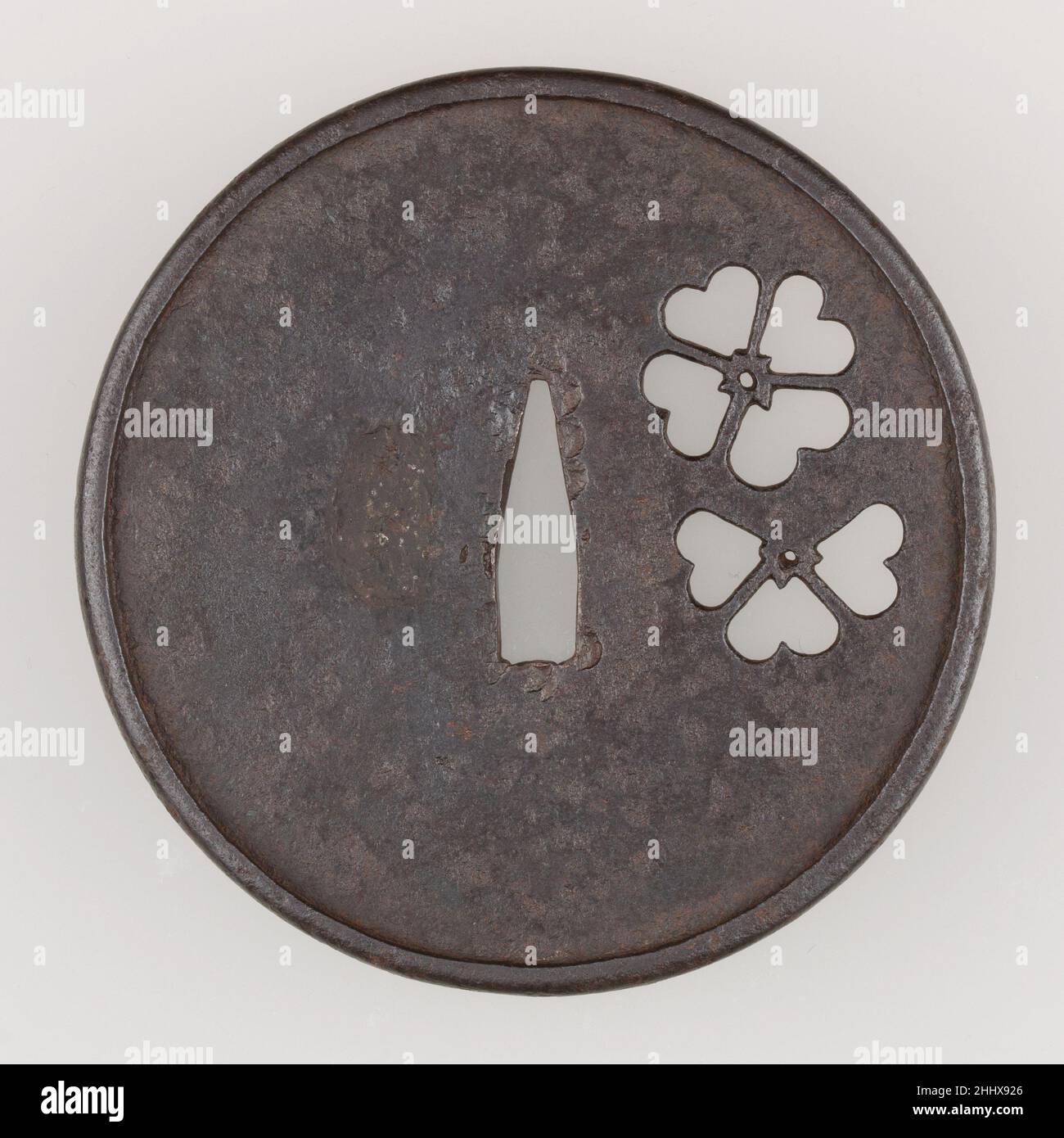 Sword Guard (Tsuba) late 14th–early 15th century Japanese This tsuba features an openwork design of two overlapping flowers. It is made in the so-called ko-kachushi (armor-maker's) style.. Sword Guard (Tsuba) 34798 Stock Photohttps://www.alamy.com/image-license-details/?v=1https://www.alamy.com/sword-guard-tsuba-late-14thearly-15th-century-japanese-this-tsuba-features-an-openwork-design-of-two-overlapping-flowers-it-is-made-in-the-so-called-ko-kachushi-armor-makers-style-sword-guard-tsuba-34798-image458496590.html
Sword Guard (Tsuba) late 14th–early 15th century Japanese This tsuba features an openwork design of two overlapping flowers. It is made in the so-called ko-kachushi (armor-maker's) style.. Sword Guard (Tsuba) 34798 Stock Photohttps://www.alamy.com/image-license-details/?v=1https://www.alamy.com/sword-guard-tsuba-late-14thearly-15th-century-japanese-this-tsuba-features-an-openwork-design-of-two-overlapping-flowers-it-is-made-in-the-so-called-ko-kachushi-armor-makers-style-sword-guard-tsuba-34798-image458496590.htmlRM2HHX926–Sword Guard (Tsuba) late 14th–early 15th century Japanese This tsuba features an openwork design of two overlapping flowers. It is made in the so-called ko-kachushi (armor-maker's) style.. Sword Guard (Tsuba) 34798
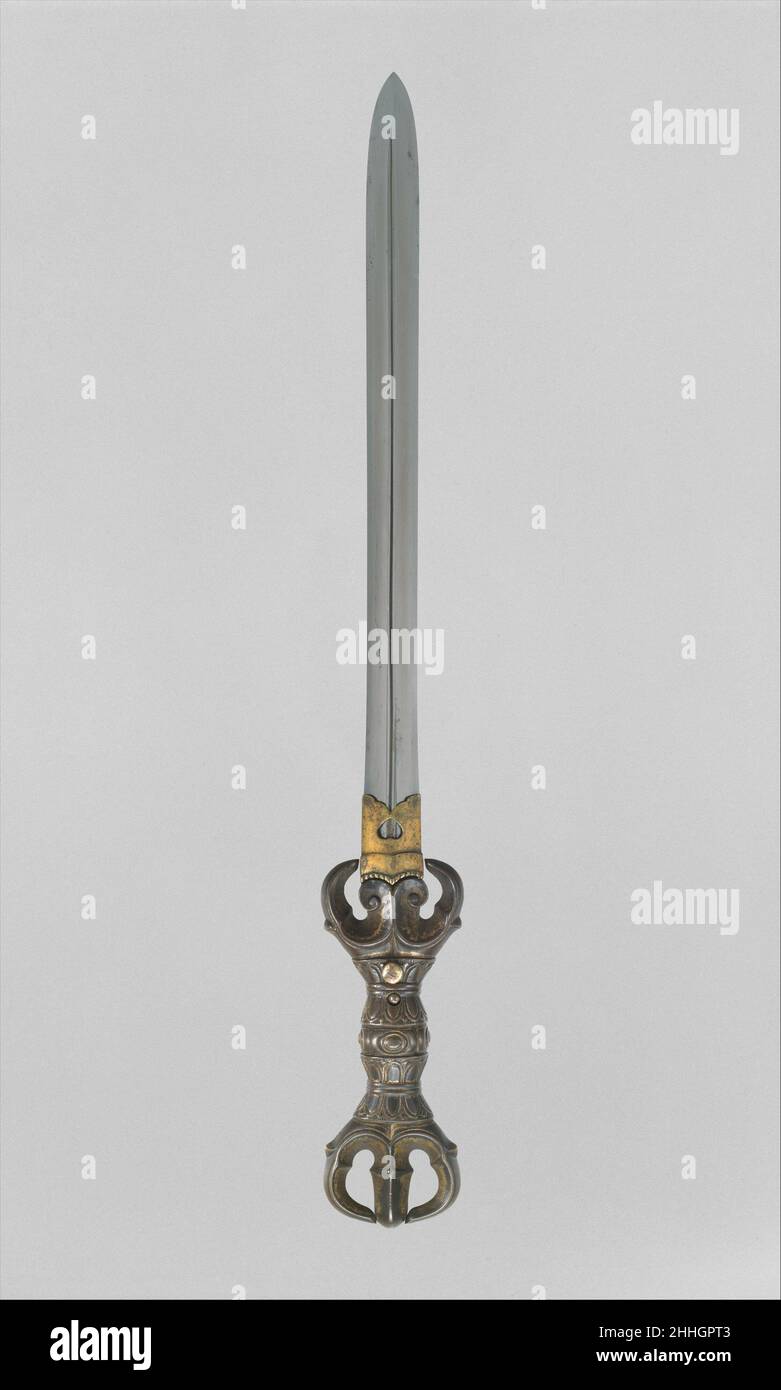 Blade and Mounting for a Double-Edged Dagger (Ken) blade, late 12th–early 13th century; mounting, 14th century Japanese The symbolic significance of the triple-pronged vajra, as well as its shape, made it an appropriate choice for use as the hilt of a sacred sword (ken), as demonstrated by this extremely rare example of an Esoteric Buddhist ritual object in the form of a ken. The blade dates from the late Heian or early Kamakura period (late twelfth to early thirteenth century), and the gilt-copper vajra hilt was probably made in the early Nambokuch? period (mid-fourteenth century). In Buddhis Stock Photohttps://www.alamy.com/image-license-details/?v=1https://www.alamy.com/blade-and-mounting-for-a-double-edged-dagger-ken-blade-late-12thearly-13th-century-mounting-14th-century-japanese-the-symbolic-significance-of-the-triple-pronged-vajra-as-well-as-its-shape-made-it-an-appropriate-choice-for-use-as-the-hilt-of-a-sacred-sword-ken-as-demonstrated-by-this-extremely-rare-example-of-an-esoteric-buddhist-ritual-object-in-the-form-of-a-ken-the-blade-dates-from-the-late-heian-or-early-kamakura-period-late-twelfth-to-early-thirteenth-century-and-the-gilt-copper-vajra-hilt-was-probably-made-in-the-early-nambokuch-period-mid-fourteenth-century-in-buddhis-image458287875.html
Blade and Mounting for a Double-Edged Dagger (Ken) blade, late 12th–early 13th century; mounting, 14th century Japanese The symbolic significance of the triple-pronged vajra, as well as its shape, made it an appropriate choice for use as the hilt of a sacred sword (ken), as demonstrated by this extremely rare example of an Esoteric Buddhist ritual object in the form of a ken. The blade dates from the late Heian or early Kamakura period (late twelfth to early thirteenth century), and the gilt-copper vajra hilt was probably made in the early Nambokuch? period (mid-fourteenth century). In Buddhis Stock Photohttps://www.alamy.com/image-license-details/?v=1https://www.alamy.com/blade-and-mounting-for-a-double-edged-dagger-ken-blade-late-12thearly-13th-century-mounting-14th-century-japanese-the-symbolic-significance-of-the-triple-pronged-vajra-as-well-as-its-shape-made-it-an-appropriate-choice-for-use-as-the-hilt-of-a-sacred-sword-ken-as-demonstrated-by-this-extremely-rare-example-of-an-esoteric-buddhist-ritual-object-in-the-form-of-a-ken-the-blade-dates-from-the-late-heian-or-early-kamakura-period-late-twelfth-to-early-thirteenth-century-and-the-gilt-copper-vajra-hilt-was-probably-made-in-the-early-nambokuch-period-mid-fourteenth-century-in-buddhis-image458287875.htmlRM2HHGPT3–Blade and Mounting for a Double-Edged Dagger (Ken) blade, late 12th–early 13th century; mounting, 14th century Japanese The symbolic significance of the triple-pronged vajra, as well as its shape, made it an appropriate choice for use as the hilt of a sacred sword (ken), as demonstrated by this extremely rare example of an Esoteric Buddhist ritual object in the form of a ken. The blade dates from the late Heian or early Kamakura period (late twelfth to early thirteenth century), and the gilt-copper vajra hilt was probably made in the early Nambokuch? period (mid-fourteenth century). In Buddhis
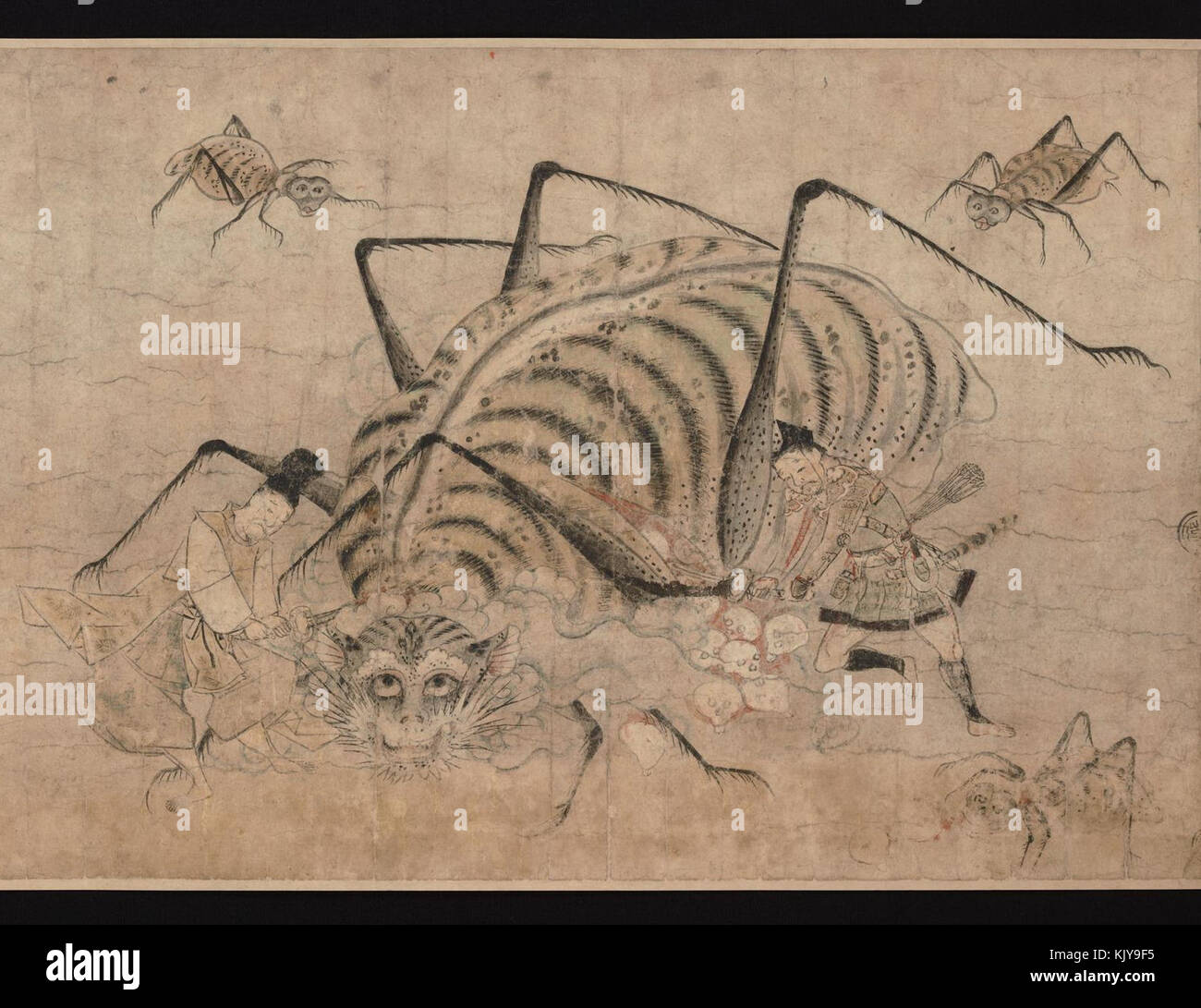 This artwork from the Tsuchigumo no Soshi emaki depicts the legendary moment of the samurai Yorimitsu slaying the Tsuchigumo spider demon, a key scene in Japanese folklore. Stock Photohttps://www.alamy.com/image-license-details/?v=1https://www.alamy.com/stock-image-this-artwork-from-the-tsuchigumo-no-soshi-emaki-depicts-the-legendary-166557305.html
This artwork from the Tsuchigumo no Soshi emaki depicts the legendary moment of the samurai Yorimitsu slaying the Tsuchigumo spider demon, a key scene in Japanese folklore. Stock Photohttps://www.alamy.com/image-license-details/?v=1https://www.alamy.com/stock-image-this-artwork-from-the-tsuchigumo-no-soshi-emaki-depicts-the-legendary-166557305.htmlRMKJY9F5–This artwork from the Tsuchigumo no Soshi emaki depicts the legendary moment of the samurai Yorimitsu slaying the Tsuchigumo spider demon, a key scene in Japanese folklore.
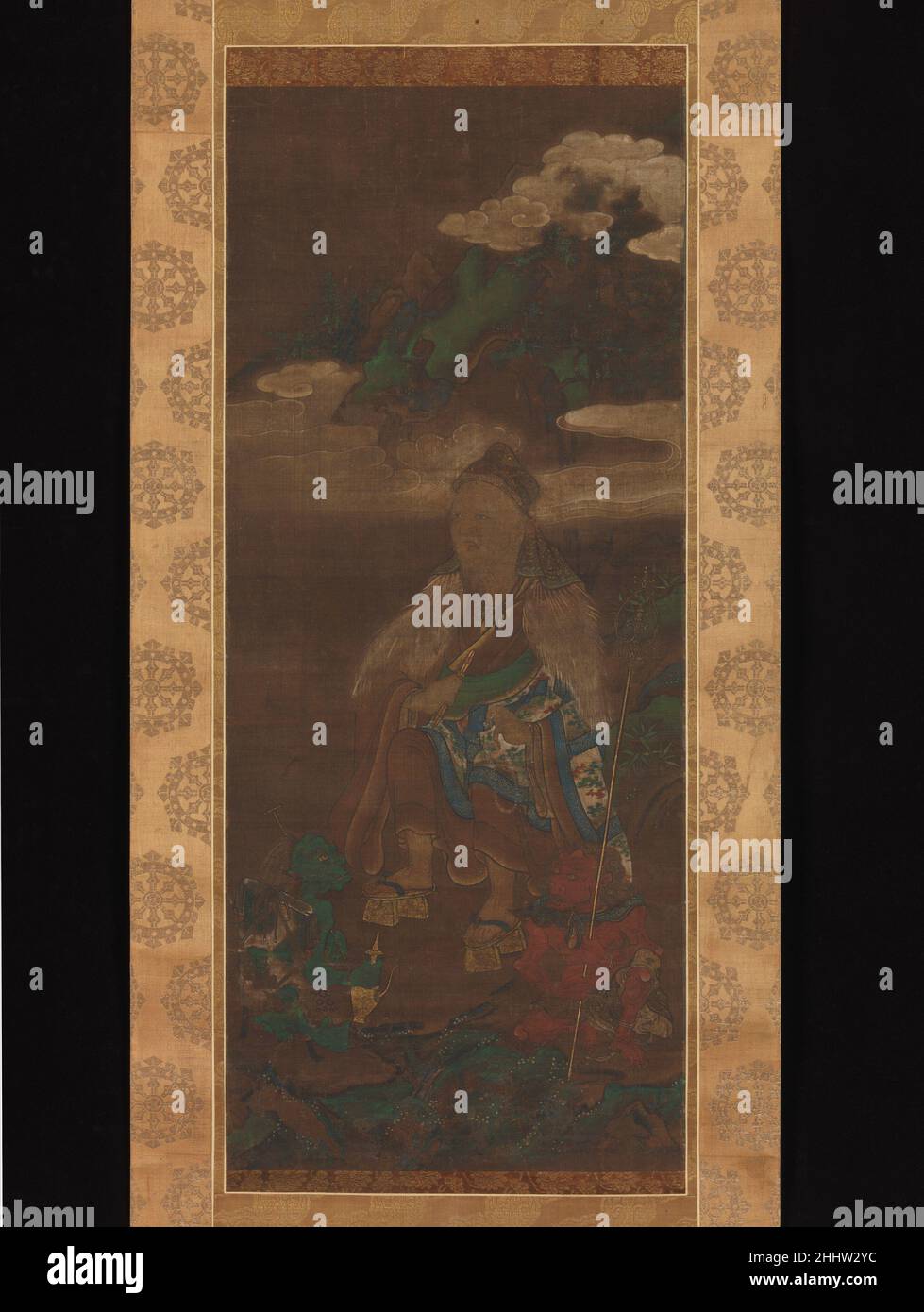 Portrait of En no Gyōja late 14th–15th century Attributed to Jakusai 寂済 Japanese The legendary founder of a sect of mountain-dwelling religious practitioners called Shugendō, En no Gyōja is said to have lived during the seventh century on Mount Katsuragi, near the ancient capital of Nara. He is believed to have conjured Zaō Gongen of Mount Kinpusen, the guardian deity of Shugendō.In this portrait, En no Gyōja appears in his conventional hood, monk’s robe, straw mantle, and wood sandals. He is usually shown holding a vajra (thunderbolt sword) and a shakujō (jeweled staff with six rings); here, Stock Photohttps://www.alamy.com/image-license-details/?v=1https://www.alamy.com/portrait-of-en-no-gyja-late-14th15th-century-attributed-to-jakusai-japanese-the-legendary-founder-of-a-sect-of-mountain-dwelling-religious-practitioners-called-shugend-en-no-gyoja-is-said-to-have-lived-during-the-seventh-century-on-mount-katsuragi-near-the-ancient-capital-of-nara-he-is-believed-to-have-conjured-za-gongen-of-mount-kinpusen-the-guardian-deity-of-shugendin-this-portrait-en-no-gyja-appears-in-his-conventional-hood-monks-robe-straw-mantle-and-wood-sandals-he-is-usually-shown-holding-a-vajra-thunderbolt-sword-and-a-shakuj-jeweled-staff-with-six-rings-here-image458469856.html
Portrait of En no Gyōja late 14th–15th century Attributed to Jakusai 寂済 Japanese The legendary founder of a sect of mountain-dwelling religious practitioners called Shugendō, En no Gyōja is said to have lived during the seventh century on Mount Katsuragi, near the ancient capital of Nara. He is believed to have conjured Zaō Gongen of Mount Kinpusen, the guardian deity of Shugendō.In this portrait, En no Gyōja appears in his conventional hood, monk’s robe, straw mantle, and wood sandals. He is usually shown holding a vajra (thunderbolt sword) and a shakujō (jeweled staff with six rings); here, Stock Photohttps://www.alamy.com/image-license-details/?v=1https://www.alamy.com/portrait-of-en-no-gyja-late-14th15th-century-attributed-to-jakusai-japanese-the-legendary-founder-of-a-sect-of-mountain-dwelling-religious-practitioners-called-shugend-en-no-gyoja-is-said-to-have-lived-during-the-seventh-century-on-mount-katsuragi-near-the-ancient-capital-of-nara-he-is-believed-to-have-conjured-za-gongen-of-mount-kinpusen-the-guardian-deity-of-shugendin-this-portrait-en-no-gyja-appears-in-his-conventional-hood-monks-robe-straw-mantle-and-wood-sandals-he-is-usually-shown-holding-a-vajra-thunderbolt-sword-and-a-shakuj-jeweled-staff-with-six-rings-here-image458469856.htmlRM2HHW2YC–Portrait of En no Gyōja late 14th–15th century Attributed to Jakusai 寂済 Japanese The legendary founder of a sect of mountain-dwelling religious practitioners called Shugendō, En no Gyōja is said to have lived during the seventh century on Mount Katsuragi, near the ancient capital of Nara. He is believed to have conjured Zaō Gongen of Mount Kinpusen, the guardian deity of Shugendō.In this portrait, En no Gyōja appears in his conventional hood, monk’s robe, straw mantle, and wood sandals. He is usually shown holding a vajra (thunderbolt sword) and a shakujō (jeweled staff with six rings); here,
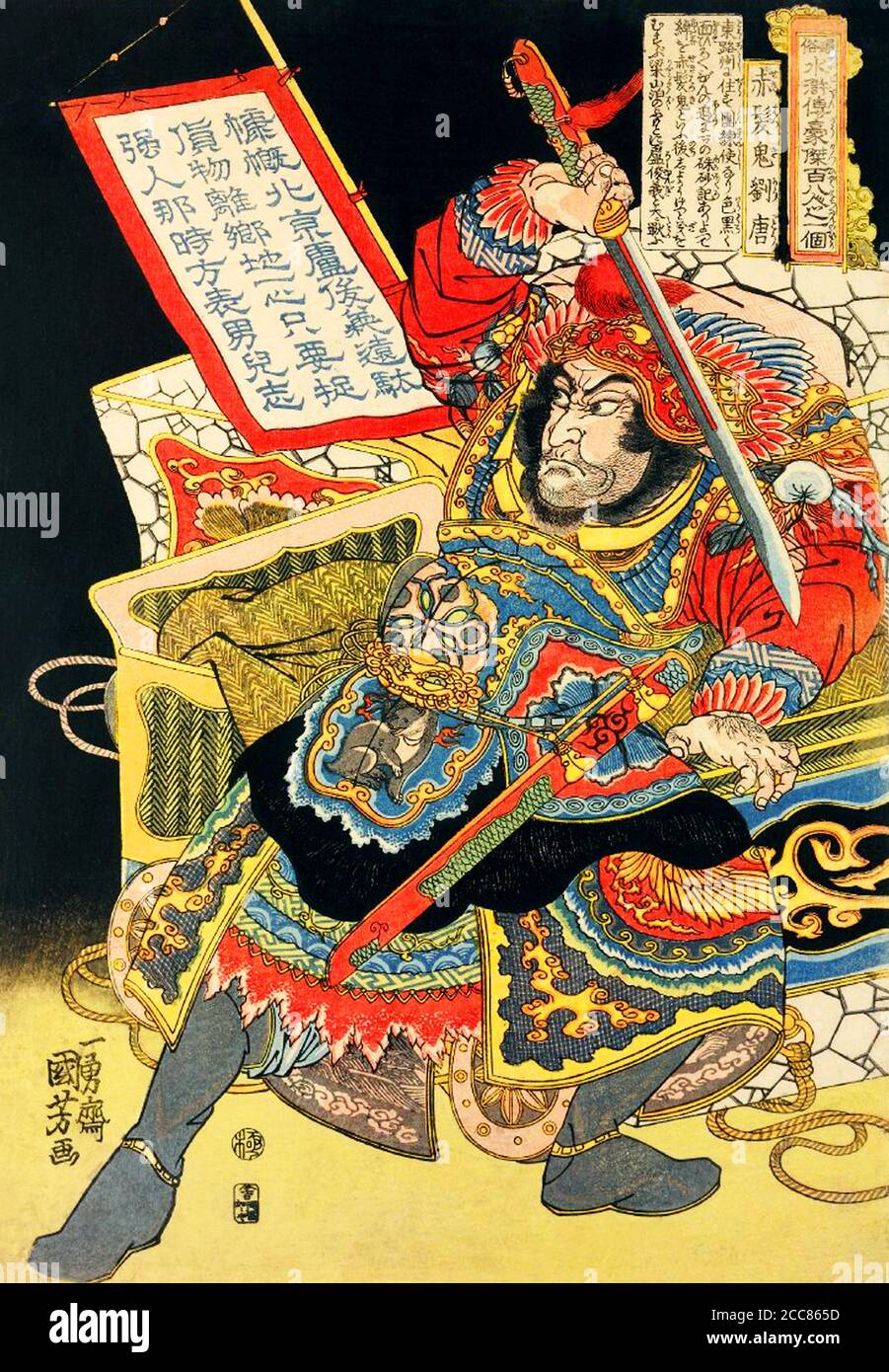 Japan: Liu Tang or Sekihatsuki Ryu To, one of the 'One Hundred and Eight Heroes of the Water Margin', with banner and sword. Woodblock print by Utagawa Kuniyoshi (1797-1863), 1827-1830. The Water Margin (known in Chinese as Shuihu Zhuan, sometimes abbreviated to Shuihu, known as Suikoden in Japanese, as well as Outlaws of the Marsh, Tale of the Marshes, All Men Are Brothers, Men of the Marshes, or The Marshes of Mount Liang in English, is a 14th century novel and one of the Four Great Classical Novels of Chinese literature. Attributed to Shi Nai'an and written in vernacular Chinese. Stock Photohttps://www.alamy.com/image-license-details/?v=1https://www.alamy.com/japan-liu-tang-or-sekihatsuki-ryu-to-one-of-the-one-hundred-and-eight-heroes-of-the-water-margin-with-banner-and-sword-woodblock-print-by-utagawa-kuniyoshi-1797-1863-1827-1830-the-water-margin-known-in-chinese-as-shuihu-zhuan-sometimes-abbreviated-to-shuihu-known-as-suikoden-in-japanese-as-well-as-outlaws-of-the-marsh-tale-of-the-marshes-all-men-are-brothers-men-of-the-marshes-or-the-marshes-of-mount-liang-in-english-is-a-14th-century-novel-and-one-of-the-four-great-classical-novels-of-chinese-literature-attributed-to-shi-naian-and-written-in-vernacular-chinese-image368974073.html
Japan: Liu Tang or Sekihatsuki Ryu To, one of the 'One Hundred and Eight Heroes of the Water Margin', with banner and sword. Woodblock print by Utagawa Kuniyoshi (1797-1863), 1827-1830. The Water Margin (known in Chinese as Shuihu Zhuan, sometimes abbreviated to Shuihu, known as Suikoden in Japanese, as well as Outlaws of the Marsh, Tale of the Marshes, All Men Are Brothers, Men of the Marshes, or The Marshes of Mount Liang in English, is a 14th century novel and one of the Four Great Classical Novels of Chinese literature. Attributed to Shi Nai'an and written in vernacular Chinese. Stock Photohttps://www.alamy.com/image-license-details/?v=1https://www.alamy.com/japan-liu-tang-or-sekihatsuki-ryu-to-one-of-the-one-hundred-and-eight-heroes-of-the-water-margin-with-banner-and-sword-woodblock-print-by-utagawa-kuniyoshi-1797-1863-1827-1830-the-water-margin-known-in-chinese-as-shuihu-zhuan-sometimes-abbreviated-to-shuihu-known-as-suikoden-in-japanese-as-well-as-outlaws-of-the-marsh-tale-of-the-marshes-all-men-are-brothers-men-of-the-marshes-or-the-marshes-of-mount-liang-in-english-is-a-14th-century-novel-and-one-of-the-four-great-classical-novels-of-chinese-literature-attributed-to-shi-naian-and-written-in-vernacular-chinese-image368974073.htmlRM2CC865D–Japan: Liu Tang or Sekihatsuki Ryu To, one of the 'One Hundred and Eight Heroes of the Water Margin', with banner and sword. Woodblock print by Utagawa Kuniyoshi (1797-1863), 1827-1830. The Water Margin (known in Chinese as Shuihu Zhuan, sometimes abbreviated to Shuihu, known as Suikoden in Japanese, as well as Outlaws of the Marsh, Tale of the Marshes, All Men Are Brothers, Men of the Marshes, or The Marshes of Mount Liang in English, is a 14th century novel and one of the Four Great Classical Novels of Chinese literature. Attributed to Shi Nai'an and written in vernacular Chinese.
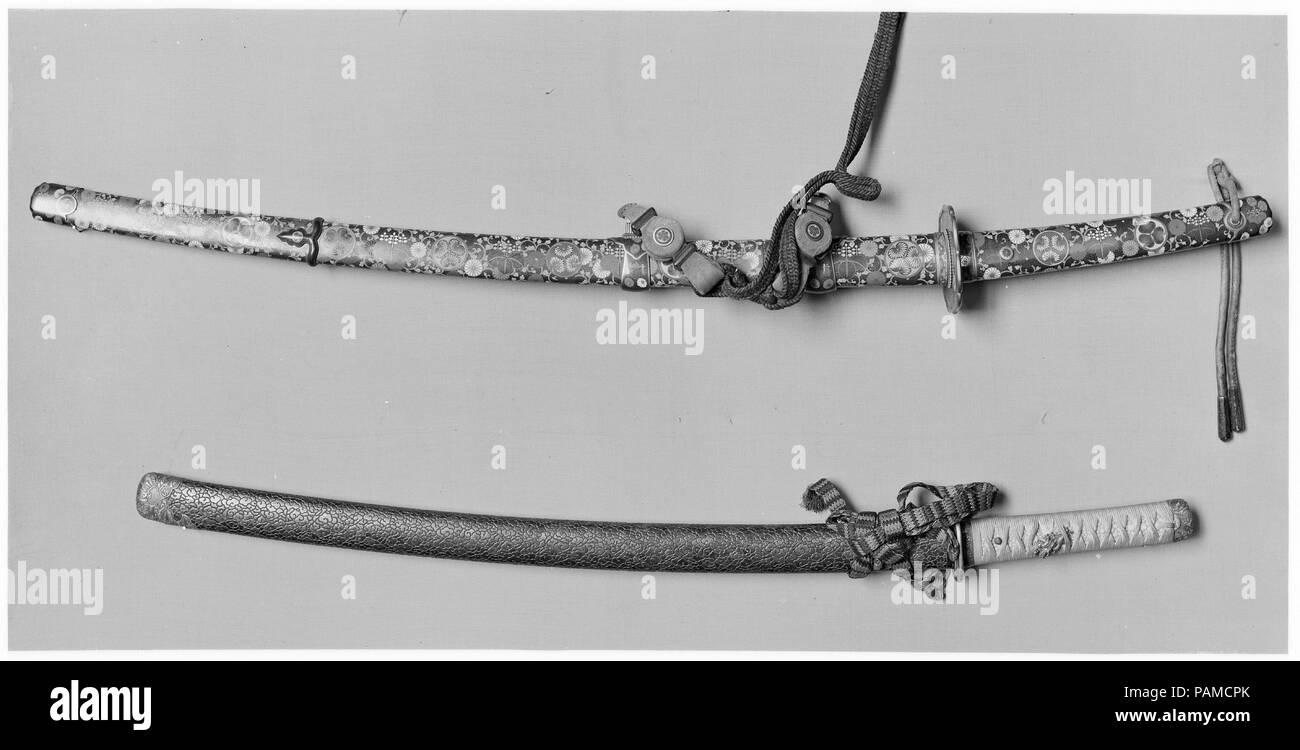 Blade and Mounting for a Slung Sword (Tachi). Culture: Japanese. Dimensions: L. 32 7/8 in. (83. 5 cm); L. of blade 25 15/16 in. (65.8 cm); L. of cutting edge 19 5/8 in. (49.8 cm); D. of curvature 5/16 in. (0.75 cm). Sword maker: Naganori (Japanese, active 13th century). Date: blade, late 13th-early 14th century; mounting, 18th-early 19th century. Museum: Metropolitan Museum of Art, New York, USA. Stock Photohttps://www.alamy.com/image-license-details/?v=1https://www.alamy.com/blade-and-mounting-for-a-slung-sword-tachi-culture-japanese-dimensions-l-32-78-in-83-5-cm-l-of-blade-25-1516-in-658-cm-l-of-cutting-edge-19-58-in-498-cm-d-of-curvature-516-in-075-cm-sword-maker-naganori-japanese-active-13th-century-date-blade-late-13th-early-14th-century-mounting-18th-early-19th-century-museum-metropolitan-museum-of-art-new-york-usa-image213120059.html
Blade and Mounting for a Slung Sword (Tachi). Culture: Japanese. Dimensions: L. 32 7/8 in. (83. 5 cm); L. of blade 25 15/16 in. (65.8 cm); L. of cutting edge 19 5/8 in. (49.8 cm); D. of curvature 5/16 in. (0.75 cm). Sword maker: Naganori (Japanese, active 13th century). Date: blade, late 13th-early 14th century; mounting, 18th-early 19th century. Museum: Metropolitan Museum of Art, New York, USA. Stock Photohttps://www.alamy.com/image-license-details/?v=1https://www.alamy.com/blade-and-mounting-for-a-slung-sword-tachi-culture-japanese-dimensions-l-32-78-in-83-5-cm-l-of-blade-25-1516-in-658-cm-l-of-cutting-edge-19-58-in-498-cm-d-of-curvature-516-in-075-cm-sword-maker-naganori-japanese-active-13th-century-date-blade-late-13th-early-14th-century-mounting-18th-early-19th-century-museum-metropolitan-museum-of-art-new-york-usa-image213120059.htmlRMPAMCPK–Blade and Mounting for a Slung Sword (Tachi). Culture: Japanese. Dimensions: L. 32 7/8 in. (83. 5 cm); L. of blade 25 15/16 in. (65.8 cm); L. of cutting edge 19 5/8 in. (49.8 cm); D. of curvature 5/16 in. (0.75 cm). Sword maker: Naganori (Japanese, active 13th century). Date: blade, late 13th-early 14th century; mounting, 18th-early 19th century. Museum: Metropolitan Museum of Art, New York, USA.
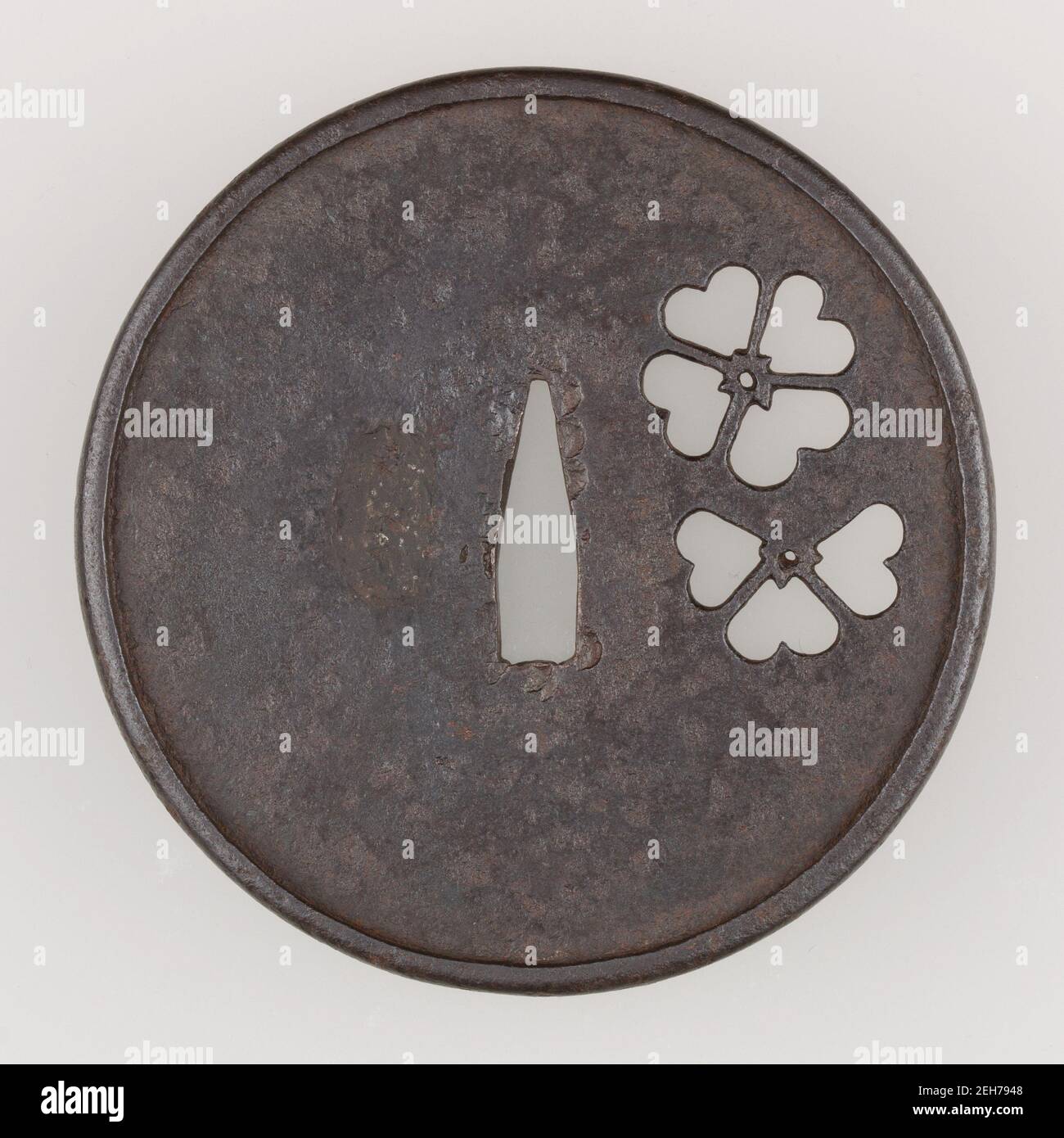 Sword Guard (Tsuba), Japanese, late 14th-early 15th century. Stock Photohttps://www.alamy.com/image-license-details/?v=1https://www.alamy.com/sword-guard-tsuba-japanese-late-14th-early-15th-century-image406448456.html
Sword Guard (Tsuba), Japanese, late 14th-early 15th century. Stock Photohttps://www.alamy.com/image-license-details/?v=1https://www.alamy.com/sword-guard-tsuba-japanese-late-14th-early-15th-century-image406448456.htmlRM2EH7948–Sword Guard (Tsuba), Japanese, late 14th-early 15th century.
RM3ANR4GG–A 14th-century painting by Suzuki Kiitsu, titled Arya Acara, illustrating the mythical god Arya Acara in Buddhist iconography. The painting features vivid details of the deity's power, with flame-like shapes and symbolic weapons.
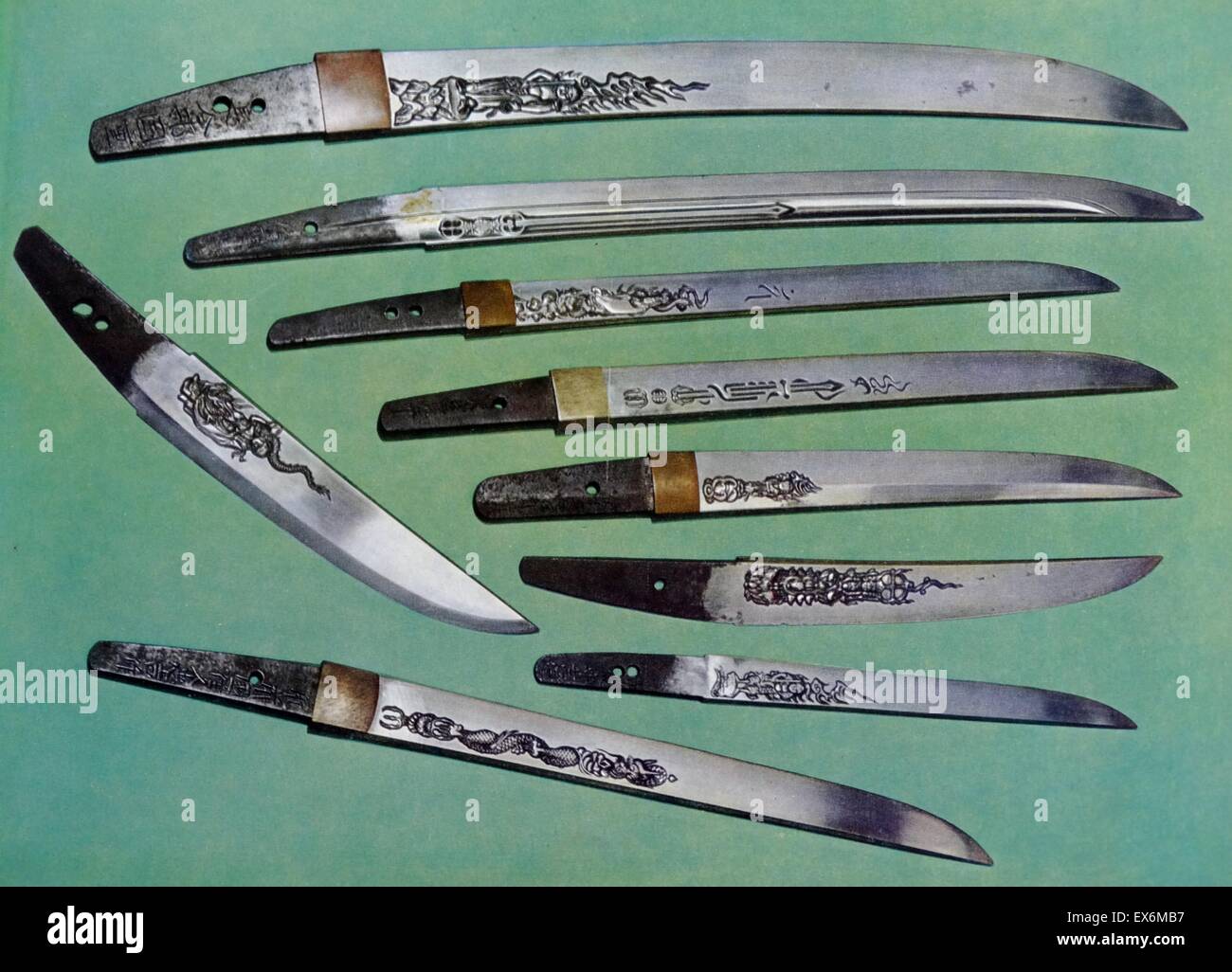 Collection of 14th Century engraved Japanese Tanto swords. Dated 14th Century Stock Photohttps://www.alamy.com/image-license-details/?v=1https://www.alamy.com/stock-photo-collection-of-14th-century-engraved-japanese-tanto-swords-dated-14th-84970235.html
Collection of 14th Century engraved Japanese Tanto swords. Dated 14th Century Stock Photohttps://www.alamy.com/image-license-details/?v=1https://www.alamy.com/stock-photo-collection-of-14th-century-engraved-japanese-tanto-swords-dated-14th-84970235.htmlRMEX6MB7–Collection of 14th Century engraved Japanese Tanto swords. Dated 14th Century
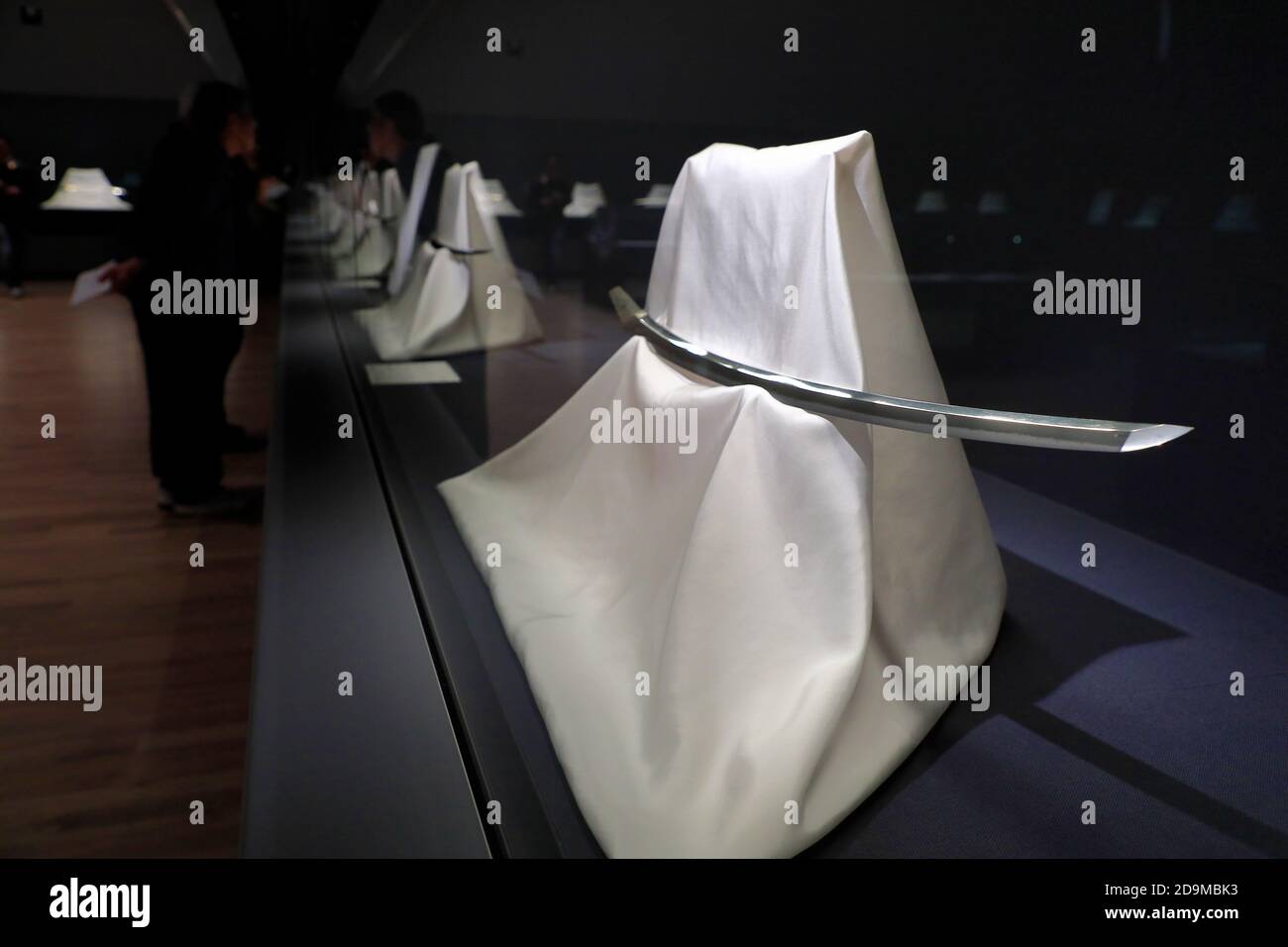 A national treasure class Tachi sword from late Kamakura period of 14th century display in Japanese Sword Museum. Sumida-ku.Tokyo.Japan Stock Photohttps://www.alamy.com/image-license-details/?v=1https://www.alamy.com/a-national-treasure-class-tachi-sword-from-late-kamakura-period-of-14th-century-display-in-japanese-sword-museum-sumida-kutokyojapan-image384608199.html
A national treasure class Tachi sword from late Kamakura period of 14th century display in Japanese Sword Museum. Sumida-ku.Tokyo.Japan Stock Photohttps://www.alamy.com/image-license-details/?v=1https://www.alamy.com/a-national-treasure-class-tachi-sword-from-late-kamakura-period-of-14th-century-display-in-japanese-sword-museum-sumida-kutokyojapan-image384608199.htmlRM2D9MBK3–A national treasure class Tachi sword from late Kamakura period of 14th century display in Japanese Sword Museum. Sumida-ku.Tokyo.Japan
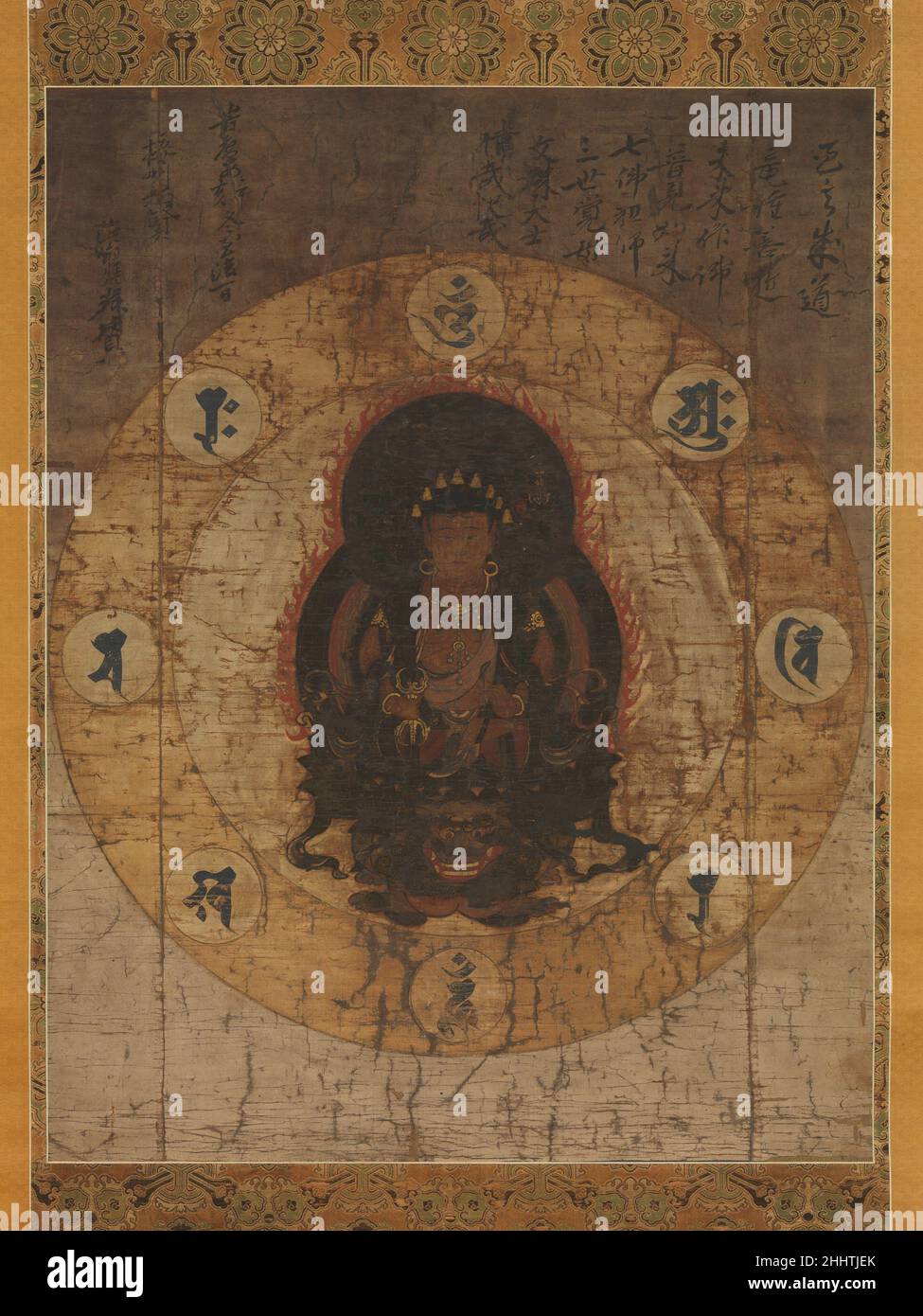 Monju Bosatsu with Eight Sacred Sanskrit Syllables mid- to late 14th century Japan Monju (Sanskrit: Manjushri), the Bodhisattva of Wisdom, is seated on a lion against an ovoid nimbus edged with flames. He wears a crown decorated with eight miniature Buddhas and holds a sword and a long stemmed lotus flower supporting a vajra—a pronged implement with origins in Indian weaponry. In other manifestations of the bodhisattva, Monju’s lotus typically supports a Buddhist scripture, but here the vajra is an emblem of wisdom. Monju is surrounded by eight Sanskrit seed syllables, or sacred utterances sym Stock Photohttps://www.alamy.com/image-license-details/?v=1https://www.alamy.com/monju-bosatsu-with-eight-sacred-sanskrit-syllables-mid-to-late-14th-century-japan-monju-sanskrit-manjushri-the-bodhisattva-of-wisdom-is-seated-on-a-lion-against-an-ovoid-nimbus-edged-with-flames-he-wears-a-crown-decorated-with-eight-miniature-buddhas-and-holds-a-sword-and-a-long-stemmed-lotus-flower-supporting-a-vajraa-pronged-implement-with-origins-in-indian-weaponry-in-other-manifestations-of-the-bodhisattva-monjus-lotus-typically-supports-a-buddhist-scripture-but-here-the-vajra-is-an-emblem-of-wisdom-monju-is-surrounded-by-eight-sanskrit-seed-syllables-or-sacred-utterances-sym-image458460091.html
Monju Bosatsu with Eight Sacred Sanskrit Syllables mid- to late 14th century Japan Monju (Sanskrit: Manjushri), the Bodhisattva of Wisdom, is seated on a lion against an ovoid nimbus edged with flames. He wears a crown decorated with eight miniature Buddhas and holds a sword and a long stemmed lotus flower supporting a vajra—a pronged implement with origins in Indian weaponry. In other manifestations of the bodhisattva, Monju’s lotus typically supports a Buddhist scripture, but here the vajra is an emblem of wisdom. Monju is surrounded by eight Sanskrit seed syllables, or sacred utterances sym Stock Photohttps://www.alamy.com/image-license-details/?v=1https://www.alamy.com/monju-bosatsu-with-eight-sacred-sanskrit-syllables-mid-to-late-14th-century-japan-monju-sanskrit-manjushri-the-bodhisattva-of-wisdom-is-seated-on-a-lion-against-an-ovoid-nimbus-edged-with-flames-he-wears-a-crown-decorated-with-eight-miniature-buddhas-and-holds-a-sword-and-a-long-stemmed-lotus-flower-supporting-a-vajraa-pronged-implement-with-origins-in-indian-weaponry-in-other-manifestations-of-the-bodhisattva-monjus-lotus-typically-supports-a-buddhist-scripture-but-here-the-vajra-is-an-emblem-of-wisdom-monju-is-surrounded-by-eight-sanskrit-seed-syllables-or-sacred-utterances-sym-image458460091.htmlRM2HHTJEK–Monju Bosatsu with Eight Sacred Sanskrit Syllables mid- to late 14th century Japan Monju (Sanskrit: Manjushri), the Bodhisattva of Wisdom, is seated on a lion against an ovoid nimbus edged with flames. He wears a crown decorated with eight miniature Buddhas and holds a sword and a long stemmed lotus flower supporting a vajra—a pronged implement with origins in Indian weaponry. In other manifestations of the bodhisattva, Monju’s lotus typically supports a Buddhist scripture, but here the vajra is an emblem of wisdom. Monju is surrounded by eight Sanskrit seed syllables, or sacred utterances sym
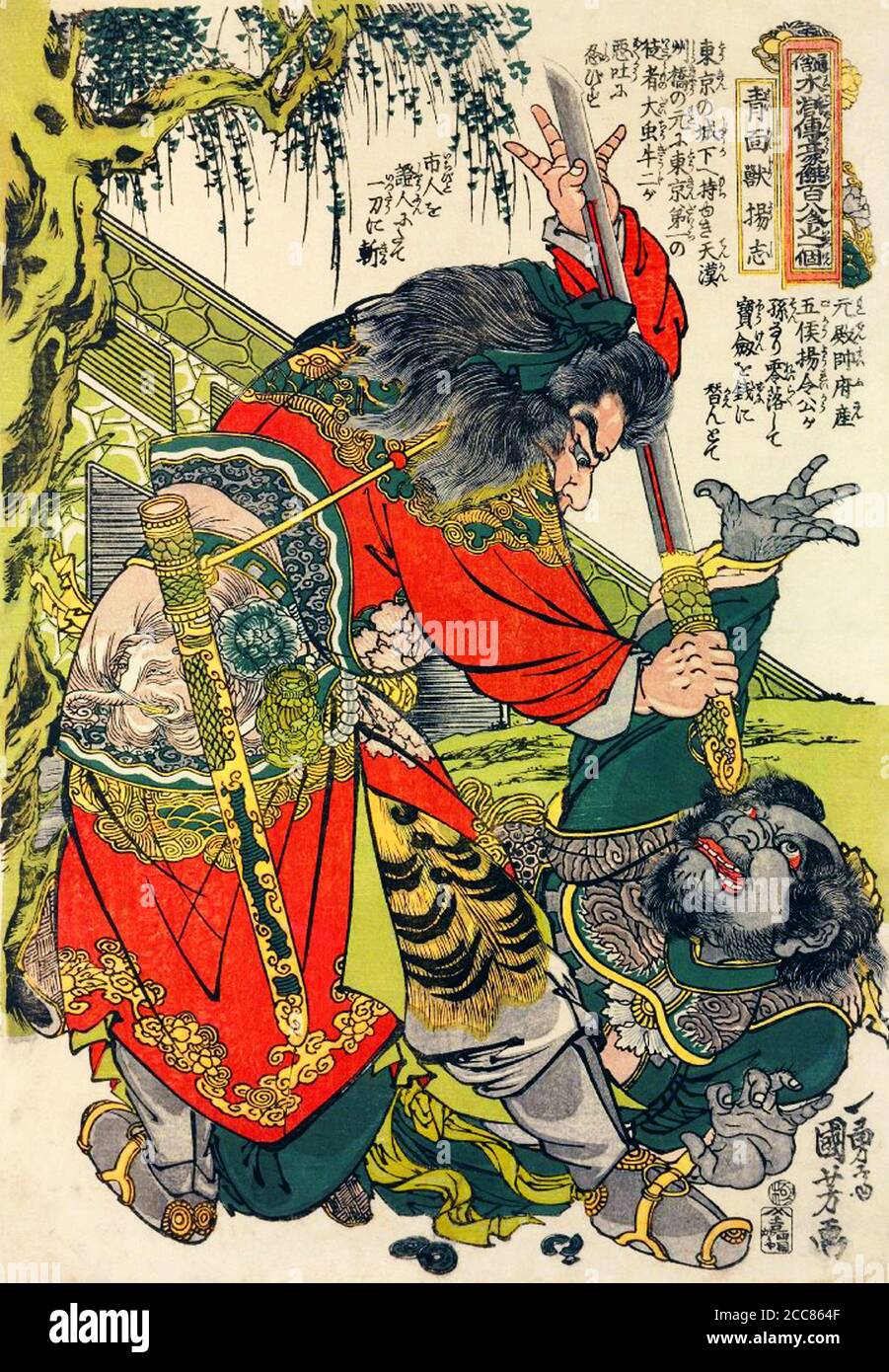 Japan: Yang Zhi or Seimenju Yoshi, one of the 'One Hundred and Eight Heroes of the Water Margin', by the Tenkanshu Bridge with the hilt of his sword pressed into Gyuji's neck. Woodblock print by Utagawa Kuniyoshi (1797-1863), 1827-1830. The Water Margin (known in Chinese as Shuihu Zhuan, sometimes abbreviated to Shuihu, known as Suikoden in Japanese, as well as Outlaws of the Marsh, Tale of the Marshes, All Men Are Brothers, Men of the Marshes, or The Marshes of Mount Liang in English, is a 14th century novel and one of the Four Great Classical Novels of Chinese literature. Attributed to Shi N Stock Photohttps://www.alamy.com/image-license-details/?v=1https://www.alamy.com/japan-yang-zhi-or-seimenju-yoshi-one-of-the-one-hundred-and-eight-heroes-of-the-water-margin-by-the-tenkanshu-bridge-with-the-hilt-of-his-sword-pressed-into-gyujis-neck-woodblock-print-by-utagawa-kuniyoshi-1797-1863-1827-1830-the-water-margin-known-in-chinese-as-shuihu-zhuan-sometimes-abbreviated-to-shuihu-known-as-suikoden-in-japanese-as-well-as-outlaws-of-the-marsh-tale-of-the-marshes-all-men-are-brothers-men-of-the-marshes-or-the-marshes-of-mount-liang-in-english-is-a-14th-century-novel-and-one-of-the-four-great-classical-novels-of-chinese-literature-attributed-to-shi-n-image368974047.html
Japan: Yang Zhi or Seimenju Yoshi, one of the 'One Hundred and Eight Heroes of the Water Margin', by the Tenkanshu Bridge with the hilt of his sword pressed into Gyuji's neck. Woodblock print by Utagawa Kuniyoshi (1797-1863), 1827-1830. The Water Margin (known in Chinese as Shuihu Zhuan, sometimes abbreviated to Shuihu, known as Suikoden in Japanese, as well as Outlaws of the Marsh, Tale of the Marshes, All Men Are Brothers, Men of the Marshes, or The Marshes of Mount Liang in English, is a 14th century novel and one of the Four Great Classical Novels of Chinese literature. Attributed to Shi N Stock Photohttps://www.alamy.com/image-license-details/?v=1https://www.alamy.com/japan-yang-zhi-or-seimenju-yoshi-one-of-the-one-hundred-and-eight-heroes-of-the-water-margin-by-the-tenkanshu-bridge-with-the-hilt-of-his-sword-pressed-into-gyujis-neck-woodblock-print-by-utagawa-kuniyoshi-1797-1863-1827-1830-the-water-margin-known-in-chinese-as-shuihu-zhuan-sometimes-abbreviated-to-shuihu-known-as-suikoden-in-japanese-as-well-as-outlaws-of-the-marsh-tale-of-the-marshes-all-men-are-brothers-men-of-the-marshes-or-the-marshes-of-mount-liang-in-english-is-a-14th-century-novel-and-one-of-the-four-great-classical-novels-of-chinese-literature-attributed-to-shi-n-image368974047.htmlRM2CC864F–Japan: Yang Zhi or Seimenju Yoshi, one of the 'One Hundred and Eight Heroes of the Water Margin', by the Tenkanshu Bridge with the hilt of his sword pressed into Gyuji's neck. Woodblock print by Utagawa Kuniyoshi (1797-1863), 1827-1830. The Water Margin (known in Chinese as Shuihu Zhuan, sometimes abbreviated to Shuihu, known as Suikoden in Japanese, as well as Outlaws of the Marsh, Tale of the Marshes, All Men Are Brothers, Men of the Marshes, or The Marshes of Mount Liang in English, is a 14th century novel and one of the Four Great Classical Novels of Chinese literature. Attributed to Shi N
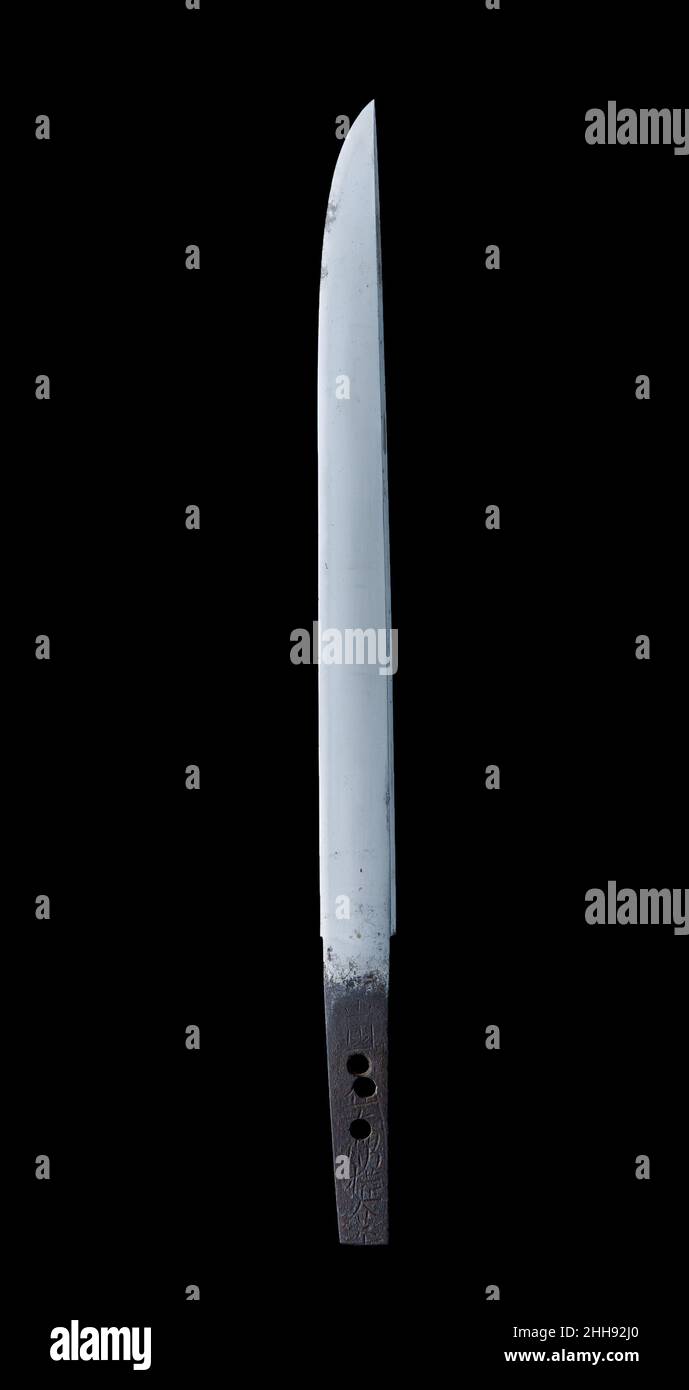 Blade and Mounting for a Dagger (Tant?) blade, possibly 14th century; mounting, 19th century Japanese A tant? is a dagger or blade shorter than 30 cm.. Blade and Mounting for a Dagger (Tant?). Japanese. blade, possibly 14th century; mounting, 19th century. Steel, wood, lacquer, gold, silver, copper-gold alloy (shakud?), abalone shell. Daggers Stock Photohttps://www.alamy.com/image-license-details/?v=1https://www.alamy.com/blade-and-mounting-for-a-dagger-tant-blade-possibly-14th-century-mounting-19th-century-japanese-a-tant-is-a-dagger-or-blade-shorter-than-30-cm-blade-and-mounting-for-a-dagger-tant-japanese-blade-possibly-14th-century-mounting-19th-century-steel-wood-lacquer-gold-silver-copper-gold-alloy-shakud-abalone-shell-daggers-image458118360.html
Blade and Mounting for a Dagger (Tant?) blade, possibly 14th century; mounting, 19th century Japanese A tant? is a dagger or blade shorter than 30 cm.. Blade and Mounting for a Dagger (Tant?). Japanese. blade, possibly 14th century; mounting, 19th century. Steel, wood, lacquer, gold, silver, copper-gold alloy (shakud?), abalone shell. Daggers Stock Photohttps://www.alamy.com/image-license-details/?v=1https://www.alamy.com/blade-and-mounting-for-a-dagger-tant-blade-possibly-14th-century-mounting-19th-century-japanese-a-tant-is-a-dagger-or-blade-shorter-than-30-cm-blade-and-mounting-for-a-dagger-tant-japanese-blade-possibly-14th-century-mounting-19th-century-steel-wood-lacquer-gold-silver-copper-gold-alloy-shakud-abalone-shell-daggers-image458118360.htmlRM2HH92J0–Blade and Mounting for a Dagger (Tant?) blade, possibly 14th century; mounting, 19th century Japanese A tant? is a dagger or blade shorter than 30 cm.. Blade and Mounting for a Dagger (Tant?). Japanese. blade, possibly 14th century; mounting, 19th century. Steel, wood, lacquer, gold, silver, copper-gold alloy (shakud?), abalone shell. Daggers
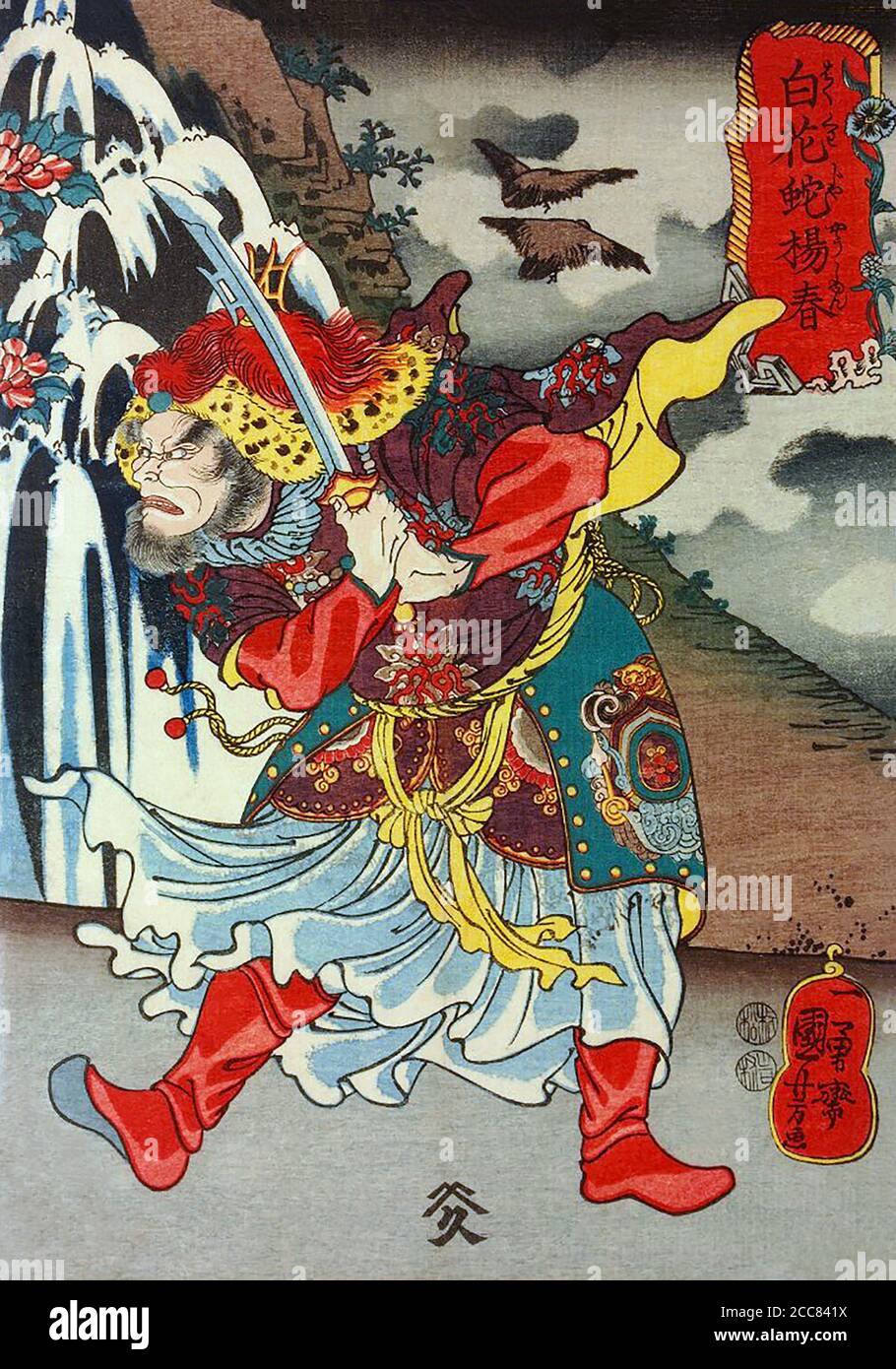 Japan: White Spotted Serpent Yang Chun or Hakkaja Yoshun, one of the 'One Hundred and Eight Heroes of the Water Margin', grasping his sword with both hands, a waterfall behind him. Woodblock print by Utagawa Kuniyoshi (1797-1863), 1827-1830. The Water Margin (known in Chinese as Shuihu Zhuan, sometimes abbreviated to Shuihu, known as Suikoden in Japanese, as well as Outlaws of the Marsh, Tale of the Marshes, All Men Are Brothers, Men of the Marshes, or The Marshes of Mount Liang in English, is a 14th century novel and one of the Four Great Classical Novels of Chinese literature. Attributed to Stock Photohttps://www.alamy.com/image-license-details/?v=1https://www.alamy.com/japan-white-spotted-serpent-yang-chun-or-hakkaja-yoshun-one-of-the-one-hundred-and-eight-heroes-of-the-water-margin-grasping-his-sword-with-both-hands-a-waterfall-behind-him-woodblock-print-by-utagawa-kuniyoshi-1797-1863-1827-1830-the-water-margin-known-in-chinese-as-shuihu-zhuan-sometimes-abbreviated-to-shuihu-known-as-suikoden-in-japanese-as-well-as-outlaws-of-the-marsh-tale-of-the-marshes-all-men-are-brothers-men-of-the-marshes-or-the-marshes-of-mount-liang-in-english-is-a-14th-century-novel-and-one-of-the-four-great-classical-novels-of-chinese-literature-attributed-to-image368972406.html
Japan: White Spotted Serpent Yang Chun or Hakkaja Yoshun, one of the 'One Hundred and Eight Heroes of the Water Margin', grasping his sword with both hands, a waterfall behind him. Woodblock print by Utagawa Kuniyoshi (1797-1863), 1827-1830. The Water Margin (known in Chinese as Shuihu Zhuan, sometimes abbreviated to Shuihu, known as Suikoden in Japanese, as well as Outlaws of the Marsh, Tale of the Marshes, All Men Are Brothers, Men of the Marshes, or The Marshes of Mount Liang in English, is a 14th century novel and one of the Four Great Classical Novels of Chinese literature. Attributed to Stock Photohttps://www.alamy.com/image-license-details/?v=1https://www.alamy.com/japan-white-spotted-serpent-yang-chun-or-hakkaja-yoshun-one-of-the-one-hundred-and-eight-heroes-of-the-water-margin-grasping-his-sword-with-both-hands-a-waterfall-behind-him-woodblock-print-by-utagawa-kuniyoshi-1797-1863-1827-1830-the-water-margin-known-in-chinese-as-shuihu-zhuan-sometimes-abbreviated-to-shuihu-known-as-suikoden-in-japanese-as-well-as-outlaws-of-the-marsh-tale-of-the-marshes-all-men-are-brothers-men-of-the-marshes-or-the-marshes-of-mount-liang-in-english-is-a-14th-century-novel-and-one-of-the-four-great-classical-novels-of-chinese-literature-attributed-to-image368972406.htmlRM2CC841X–Japan: White Spotted Serpent Yang Chun or Hakkaja Yoshun, one of the 'One Hundred and Eight Heroes of the Water Margin', grasping his sword with both hands, a waterfall behind him. Woodblock print by Utagawa Kuniyoshi (1797-1863), 1827-1830. The Water Margin (known in Chinese as Shuihu Zhuan, sometimes abbreviated to Shuihu, known as Suikoden in Japanese, as well as Outlaws of the Marsh, Tale of the Marshes, All Men Are Brothers, Men of the Marshes, or The Marshes of Mount Liang in English, is a 14th century novel and one of the Four Great Classical Novels of Chinese literature. Attributed to
 Blade and Mounting for a Dagger (Tant?) blade, late 14th–early 15th century; mounting, 19th century Japanese A tant? is a dagger or blade shorter than 30 cm.. Blade and Mounting for a Dagger (Tant?). Japanese. blade, late 14th–early 15th century; mounting, 19th century. Steel, wood (rosewood), silver. Daggers Stock Photohttps://www.alamy.com/image-license-details/?v=1https://www.alamy.com/blade-and-mounting-for-a-dagger-tant-blade-late-14thearly-15th-century-mounting-19th-century-japanese-a-tant-is-a-dagger-or-blade-shorter-than-30-cm-blade-and-mounting-for-a-dagger-tant-japanese-blade-late-14thearly-15th-century-mounting-19th-century-steel-wood-rosewood-silver-daggers-image457910505.html
Blade and Mounting for a Dagger (Tant?) blade, late 14th–early 15th century; mounting, 19th century Japanese A tant? is a dagger or blade shorter than 30 cm.. Blade and Mounting for a Dagger (Tant?). Japanese. blade, late 14th–early 15th century; mounting, 19th century. Steel, wood (rosewood), silver. Daggers Stock Photohttps://www.alamy.com/image-license-details/?v=1https://www.alamy.com/blade-and-mounting-for-a-dagger-tant-blade-late-14thearly-15th-century-mounting-19th-century-japanese-a-tant-is-a-dagger-or-blade-shorter-than-30-cm-blade-and-mounting-for-a-dagger-tant-japanese-blade-late-14thearly-15th-century-mounting-19th-century-steel-wood-rosewood-silver-daggers-image457910505.htmlRM2HGYHEH–Blade and Mounting for a Dagger (Tant?) blade, late 14th–early 15th century; mounting, 19th century Japanese A tant? is a dagger or blade shorter than 30 cm.. Blade and Mounting for a Dagger (Tant?). Japanese. blade, late 14th–early 15th century; mounting, 19th century. Steel, wood (rosewood), silver. Daggers
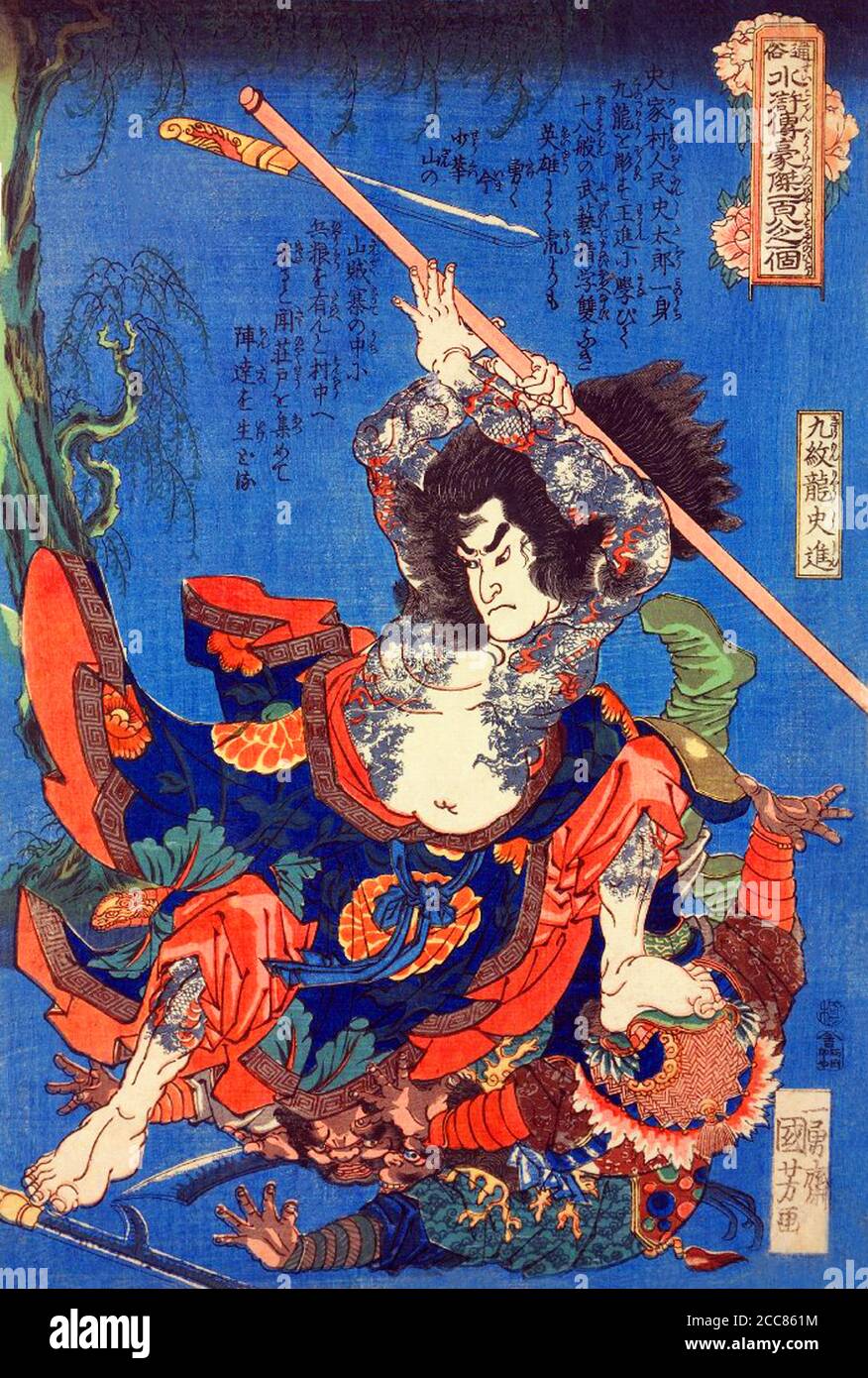 Japan: Shi Jin or Kyumonryo Shishin, one of the '108 Heroes of the Water Margin', seated on a vanquished adversary, parrying a flying sword with his pole. Wooblock print by Utagawa Kuniyoshi (1797-1863), 1827-1830. The Water Margin (known in Chinese as Shuihu Zhuan, sometimes abbreviated to Shuihu, known as Suikoden in Japanese, as well as Outlaws of the Marsh, Tale of the Marshes, All Men Are Brothers, Men of the Marshes, or The Marshes of Mount Liang in English, is a 14th century novel and one of the Four Great Classical Novels of Chinese literature. Attributed to Shi Nai'an and written in v Stock Photohttps://www.alamy.com/image-license-details/?v=1https://www.alamy.com/japan-shi-jin-or-kyumonryo-shishin-one-of-the-108-heroes-of-the-water-margin-seated-on-a-vanquished-adversary-parrying-a-flying-sword-with-his-pole-wooblock-print-by-utagawa-kuniyoshi-1797-1863-1827-1830-the-water-margin-known-in-chinese-as-shuihu-zhuan-sometimes-abbreviated-to-shuihu-known-as-suikoden-in-japanese-as-well-as-outlaws-of-the-marsh-tale-of-the-marshes-all-men-are-brothers-men-of-the-marshes-or-the-marshes-of-mount-liang-in-english-is-a-14th-century-novel-and-one-of-the-four-great-classical-novels-of-chinese-literature-attributed-to-shi-naian-and-written-in-v-image368973968.html
Japan: Shi Jin or Kyumonryo Shishin, one of the '108 Heroes of the Water Margin', seated on a vanquished adversary, parrying a flying sword with his pole. Wooblock print by Utagawa Kuniyoshi (1797-1863), 1827-1830. The Water Margin (known in Chinese as Shuihu Zhuan, sometimes abbreviated to Shuihu, known as Suikoden in Japanese, as well as Outlaws of the Marsh, Tale of the Marshes, All Men Are Brothers, Men of the Marshes, or The Marshes of Mount Liang in English, is a 14th century novel and one of the Four Great Classical Novels of Chinese literature. Attributed to Shi Nai'an and written in v Stock Photohttps://www.alamy.com/image-license-details/?v=1https://www.alamy.com/japan-shi-jin-or-kyumonryo-shishin-one-of-the-108-heroes-of-the-water-margin-seated-on-a-vanquished-adversary-parrying-a-flying-sword-with-his-pole-wooblock-print-by-utagawa-kuniyoshi-1797-1863-1827-1830-the-water-margin-known-in-chinese-as-shuihu-zhuan-sometimes-abbreviated-to-shuihu-known-as-suikoden-in-japanese-as-well-as-outlaws-of-the-marsh-tale-of-the-marshes-all-men-are-brothers-men-of-the-marshes-or-the-marshes-of-mount-liang-in-english-is-a-14th-century-novel-and-one-of-the-four-great-classical-novels-of-chinese-literature-attributed-to-shi-naian-and-written-in-v-image368973968.htmlRM2CC861M–Japan: Shi Jin or Kyumonryo Shishin, one of the '108 Heroes of the Water Margin', seated on a vanquished adversary, parrying a flying sword with his pole. Wooblock print by Utagawa Kuniyoshi (1797-1863), 1827-1830. The Water Margin (known in Chinese as Shuihu Zhuan, sometimes abbreviated to Shuihu, known as Suikoden in Japanese, as well as Outlaws of the Marsh, Tale of the Marshes, All Men Are Brothers, Men of the Marshes, or The Marshes of Mount Liang in English, is a 14th century novel and one of the Four Great Classical Novels of Chinese literature. Attributed to Shi Nai'an and written in v
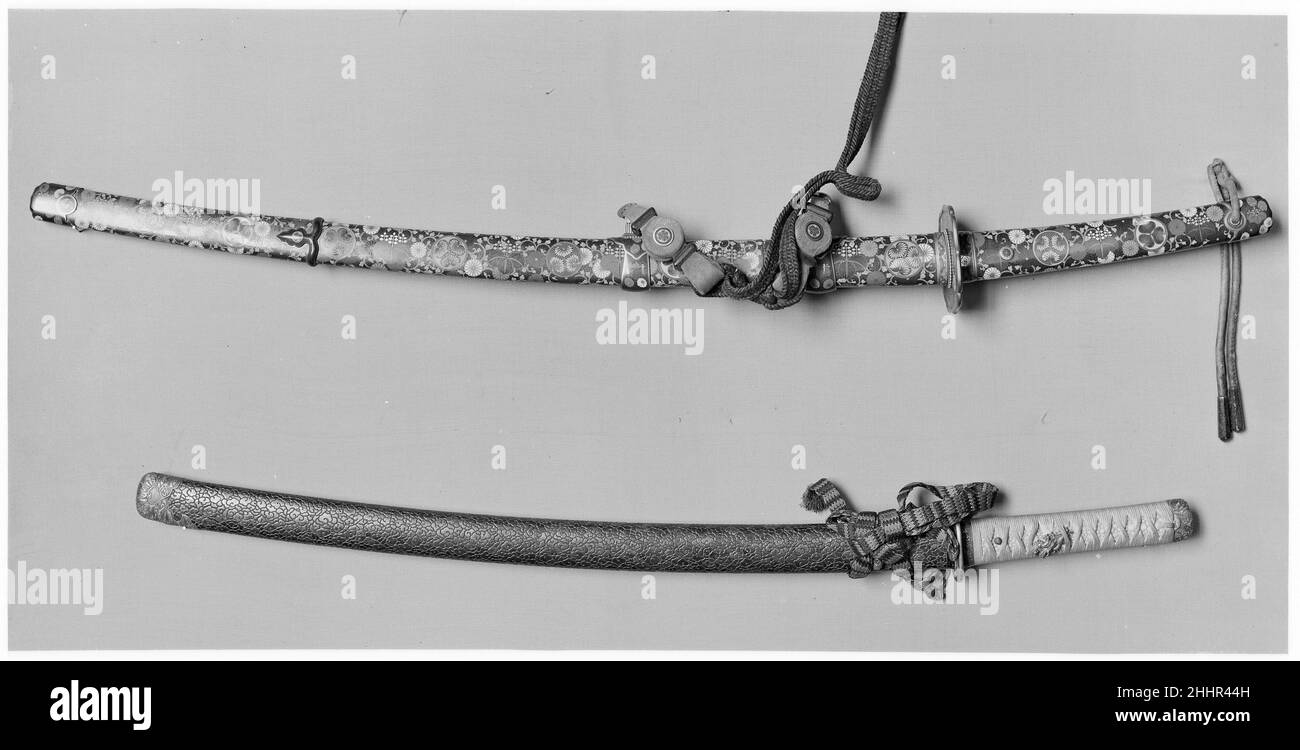 Blade and Mounting for a Short Sword (Wakizashi) blade, late 13th–early 14th century; mounting, 18th–early 19th century Naganori Japanese. Blade and Mounting for a Short Sword (Wakizashi). Japanese. blade, late 13th–early 14th century; mounting, 18th–early 19th century. Steel, wood, lacquer, rayskin (samé), thread, gold, silver. Swords Stock Photohttps://www.alamy.com/image-license-details/?v=1https://www.alamy.com/blade-and-mounting-for-a-short-sword-wakizashi-blade-late-13thearly-14th-century-mounting-18thearly-19th-century-naganori-japanese-blade-and-mounting-for-a-short-sword-wakizashi-japanese-blade-late-13thearly-14th-century-mounting-18thearly-19th-century-steel-wood-lacquer-rayskin-sam-thread-gold-silver-swords-image458426881.html
Blade and Mounting for a Short Sword (Wakizashi) blade, late 13th–early 14th century; mounting, 18th–early 19th century Naganori Japanese. Blade and Mounting for a Short Sword (Wakizashi). Japanese. blade, late 13th–early 14th century; mounting, 18th–early 19th century. Steel, wood, lacquer, rayskin (samé), thread, gold, silver. Swords Stock Photohttps://www.alamy.com/image-license-details/?v=1https://www.alamy.com/blade-and-mounting-for-a-short-sword-wakizashi-blade-late-13thearly-14th-century-mounting-18thearly-19th-century-naganori-japanese-blade-and-mounting-for-a-short-sword-wakizashi-japanese-blade-late-13thearly-14th-century-mounting-18thearly-19th-century-steel-wood-lacquer-rayskin-sam-thread-gold-silver-swords-image458426881.htmlRM2HHR44H–Blade and Mounting for a Short Sword (Wakizashi) blade, late 13th–early 14th century; mounting, 18th–early 19th century Naganori Japanese. Blade and Mounting for a Short Sword (Wakizashi). Japanese. blade, late 13th–early 14th century; mounting, 18th–early 19th century. Steel, wood, lacquer, rayskin (samé), thread, gold, silver. Swords
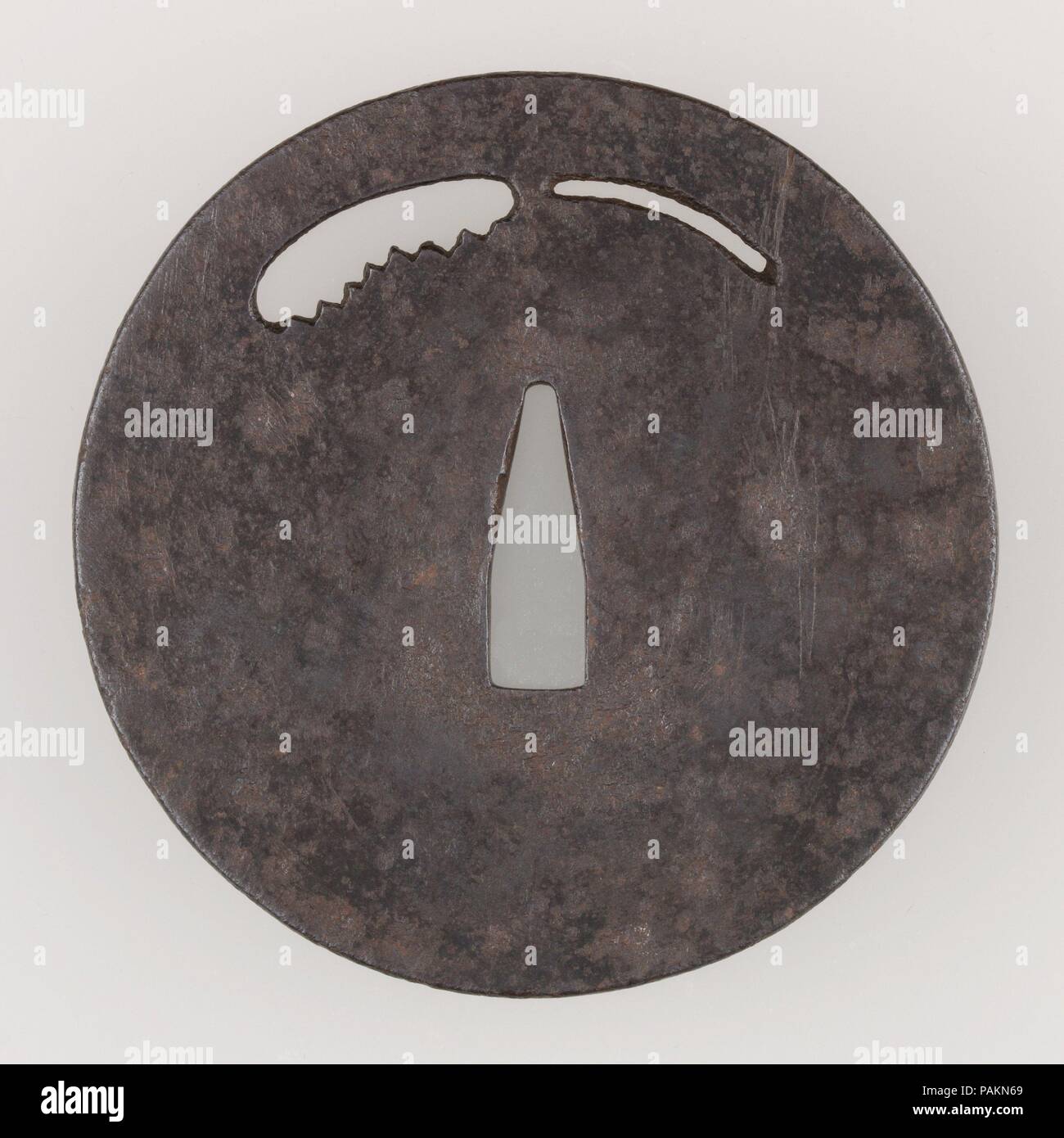 Sword Guard (Tsuba). Culture: Japanese. Dimensions: Diam. 3 3/4 in. (9.5 cm); thickness 1/8 in. (0.3 cm); Wt. 5.5 oz. (155.9 g). Date: late 14th century. This tsuba features an openwork design of a saw. It is made in the so-called ko-tosho (swordsmith's) style. Museum: Metropolitan Museum of Art, New York, USA. Stock Photohttps://www.alamy.com/image-license-details/?v=1https://www.alamy.com/sword-guard-tsuba-culture-japanese-dimensions-diam-3-34-in-95-cm-thickness-18-in-03-cm-wt-55-oz-1559-g-date-late-14th-century-this-tsuba-features-an-openwork-design-of-a-saw-it-is-made-in-the-so-called-ko-tosho-swordsmiths-style-museum-metropolitan-museum-of-art-new-york-usa-image213104705.html
Sword Guard (Tsuba). Culture: Japanese. Dimensions: Diam. 3 3/4 in. (9.5 cm); thickness 1/8 in. (0.3 cm); Wt. 5.5 oz. (155.9 g). Date: late 14th century. This tsuba features an openwork design of a saw. It is made in the so-called ko-tosho (swordsmith's) style. Museum: Metropolitan Museum of Art, New York, USA. Stock Photohttps://www.alamy.com/image-license-details/?v=1https://www.alamy.com/sword-guard-tsuba-culture-japanese-dimensions-diam-3-34-in-95-cm-thickness-18-in-03-cm-wt-55-oz-1559-g-date-late-14th-century-this-tsuba-features-an-openwork-design-of-a-saw-it-is-made-in-the-so-called-ko-tosho-swordsmiths-style-museum-metropolitan-museum-of-art-new-york-usa-image213104705.htmlRMPAKN69–Sword Guard (Tsuba). Culture: Japanese. Dimensions: Diam. 3 3/4 in. (9.5 cm); thickness 1/8 in. (0.3 cm); Wt. 5.5 oz. (155.9 g). Date: late 14th century. This tsuba features an openwork design of a saw. It is made in the so-called ko-tosho (swordsmith's) style. Museum: Metropolitan Museum of Art, New York, USA.
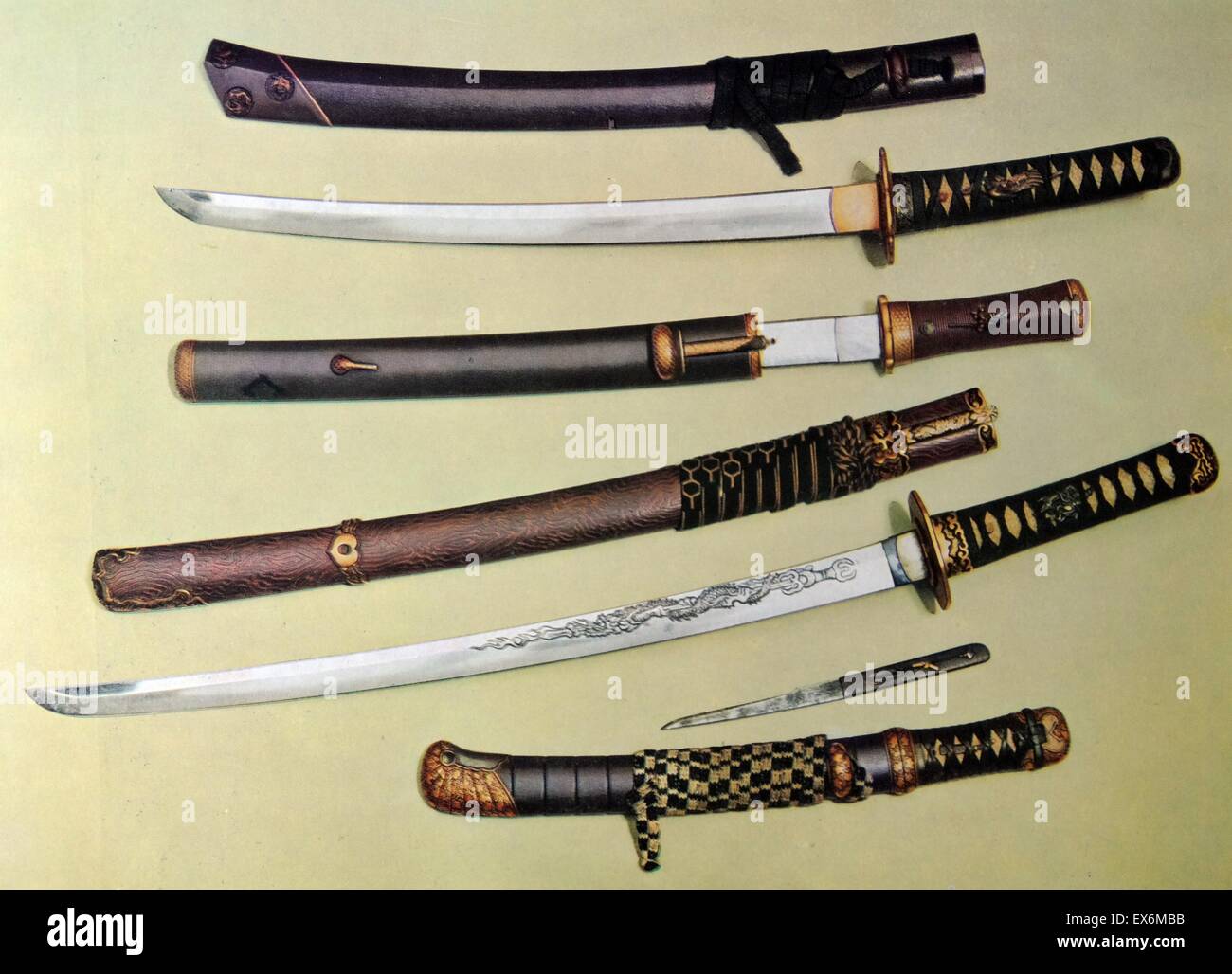 Collection of 14th Century Japanese Katana, Wakizashi, Tanto, and Samurai swords Stock Photohttps://www.alamy.com/image-license-details/?v=1https://www.alamy.com/stock-photo-collection-of-14th-century-japanese-katana-wakizashi-tanto-and-samurai-84970239.html
Collection of 14th Century Japanese Katana, Wakizashi, Tanto, and Samurai swords Stock Photohttps://www.alamy.com/image-license-details/?v=1https://www.alamy.com/stock-photo-collection-of-14th-century-japanese-katana-wakizashi-tanto-and-samurai-84970239.htmlRMEX6MBB–Collection of 14th Century Japanese Katana, Wakizashi, Tanto, and Samurai swords
 Box with Pommel Scroll late 13th–14th century China Ubiquitous in the decoration of carved lacquer and also found in clay and metal, the design on this box was designated the “pommel scroll” as early as the Song period (960–1279), and this term is widely used in the cataloguing of lacquer. It refers to the pommel of a sword, which is an unexpected prototype for a design in another material. The Japanese term guri, or bent wheel, is also sometimes used to categorize lacquers with this design.. Box with Pommel Scroll 39646 Stock Photohttps://www.alamy.com/image-license-details/?v=1https://www.alamy.com/box-with-pommel-scroll-late-13th14th-century-china-ubiquitous-in-the-decoration-of-carved-lacquer-and-also-found-in-clay-and-metal-the-design-on-this-box-was-designated-the-pommel-scroll-as-early-as-the-song-period-9601279-and-this-term-is-widely-used-in-the-cataloguing-of-lacquer-it-refers-to-the-pommel-of-a-sword-which-is-an-unexpected-prototype-for-a-design-in-another-material-the-japanese-term-guri-or-bent-wheel-is-also-sometimes-used-to-categorize-lacquers-with-this-design-box-with-pommel-scroll-39646-image458581389.html
Box with Pommel Scroll late 13th–14th century China Ubiquitous in the decoration of carved lacquer and also found in clay and metal, the design on this box was designated the “pommel scroll” as early as the Song period (960–1279), and this term is widely used in the cataloguing of lacquer. It refers to the pommel of a sword, which is an unexpected prototype for a design in another material. The Japanese term guri, or bent wheel, is also sometimes used to categorize lacquers with this design.. Box with Pommel Scroll 39646 Stock Photohttps://www.alamy.com/image-license-details/?v=1https://www.alamy.com/box-with-pommel-scroll-late-13th14th-century-china-ubiquitous-in-the-decoration-of-carved-lacquer-and-also-found-in-clay-and-metal-the-design-on-this-box-was-designated-the-pommel-scroll-as-early-as-the-song-period-9601279-and-this-term-is-widely-used-in-the-cataloguing-of-lacquer-it-refers-to-the-pommel-of-a-sword-which-is-an-unexpected-prototype-for-a-design-in-another-material-the-japanese-term-guri-or-bent-wheel-is-also-sometimes-used-to-categorize-lacquers-with-this-design-box-with-pommel-scroll-39646-image458581389.htmlRM2HJ256N–Box with Pommel Scroll late 13th–14th century China Ubiquitous in the decoration of carved lacquer and also found in clay and metal, the design on this box was designated the “pommel scroll” as early as the Song period (960–1279), and this term is widely used in the cataloguing of lacquer. It refers to the pommel of a sword, which is an unexpected prototype for a design in another material. The Japanese term guri, or bent wheel, is also sometimes used to categorize lacquers with this design.. Box with Pommel Scroll 39646
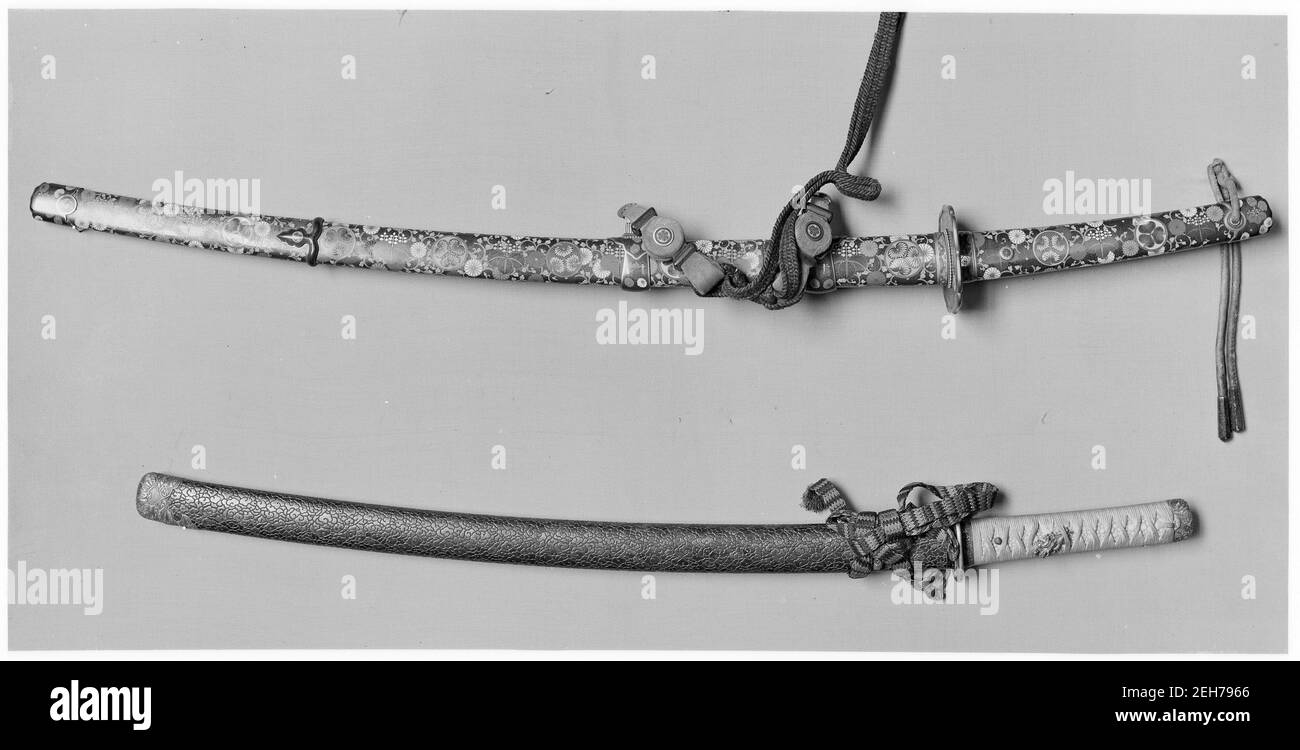 Blade and Mounting for a Short Sword (Wakizashi), Japanese, blade, late 13th-early 14th century; mounting, 18th-early 19th century. Stock Photohttps://www.alamy.com/image-license-details/?v=1https://www.alamy.com/blade-and-mounting-for-a-short-sword-wakizashi-japanese-blade-late-13th-early-14th-century-mounting-18th-early-19th-century-image406448510.html
Blade and Mounting for a Short Sword (Wakizashi), Japanese, blade, late 13th-early 14th century; mounting, 18th-early 19th century. Stock Photohttps://www.alamy.com/image-license-details/?v=1https://www.alamy.com/blade-and-mounting-for-a-short-sword-wakizashi-japanese-blade-late-13th-early-14th-century-mounting-18th-early-19th-century-image406448510.htmlRM2EH7966–Blade and Mounting for a Short Sword (Wakizashi), Japanese, blade, late 13th-early 14th century; mounting, 18th-early 19th century.
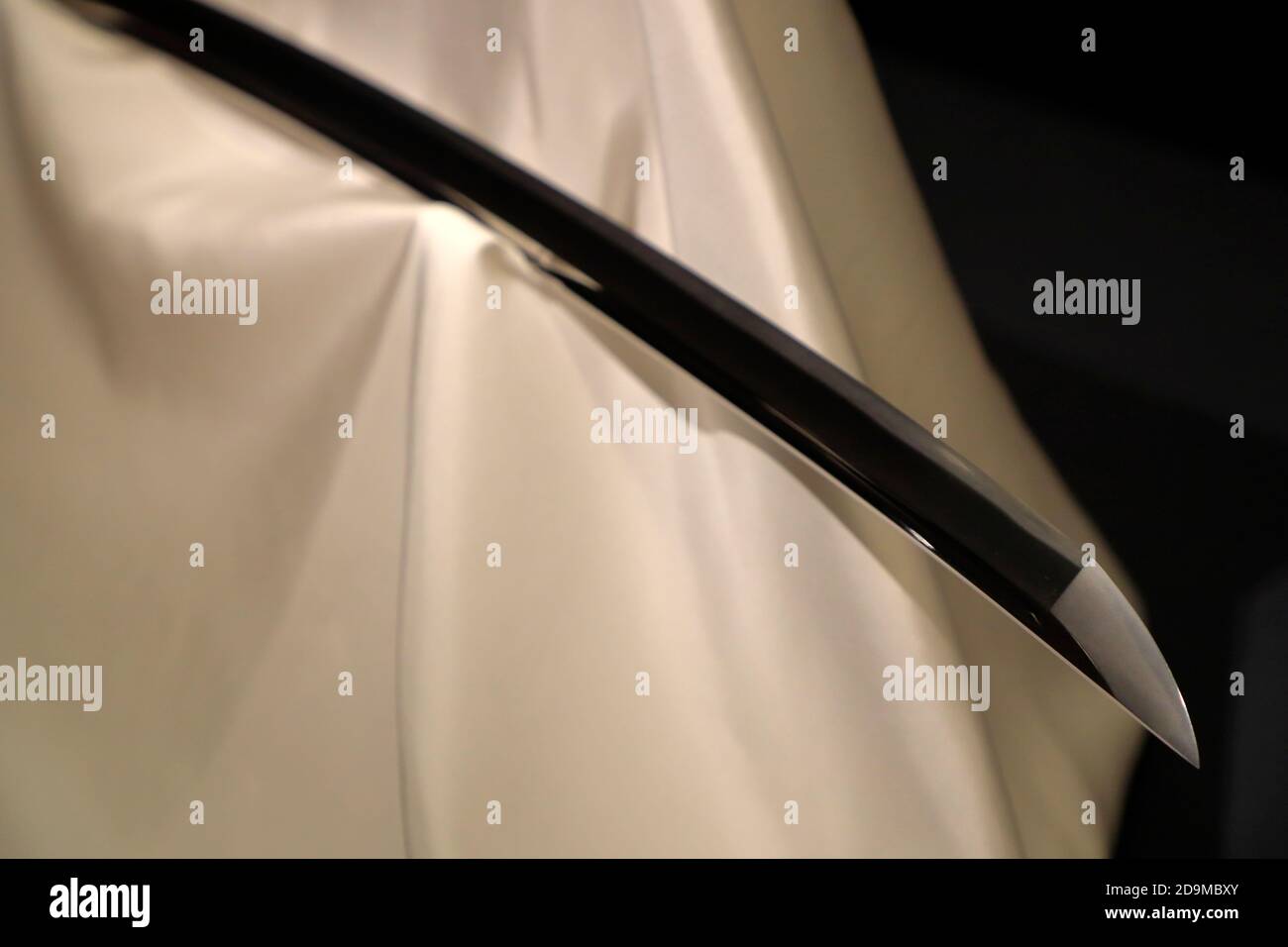 A ancient Japanese Katana sword from 14th century of Nanbokucho period display in Japanese Sword Museum.Tokyo.Japan Stock Photohttps://www.alamy.com/image-license-details/?v=1https://www.alamy.com/a-ancient-japanese-katana-sword-from-14th-century-of-nanbokucho-period-display-in-japanese-sword-museumtokyojapan-image384608419.html
A ancient Japanese Katana sword from 14th century of Nanbokucho period display in Japanese Sword Museum.Tokyo.Japan Stock Photohttps://www.alamy.com/image-license-details/?v=1https://www.alamy.com/a-ancient-japanese-katana-sword-from-14th-century-of-nanbokucho-period-display-in-japanese-sword-museumtokyojapan-image384608419.htmlRM2D9MBXY–A ancient Japanese Katana sword from 14th century of Nanbokucho period display in Japanese Sword Museum.Tokyo.Japan
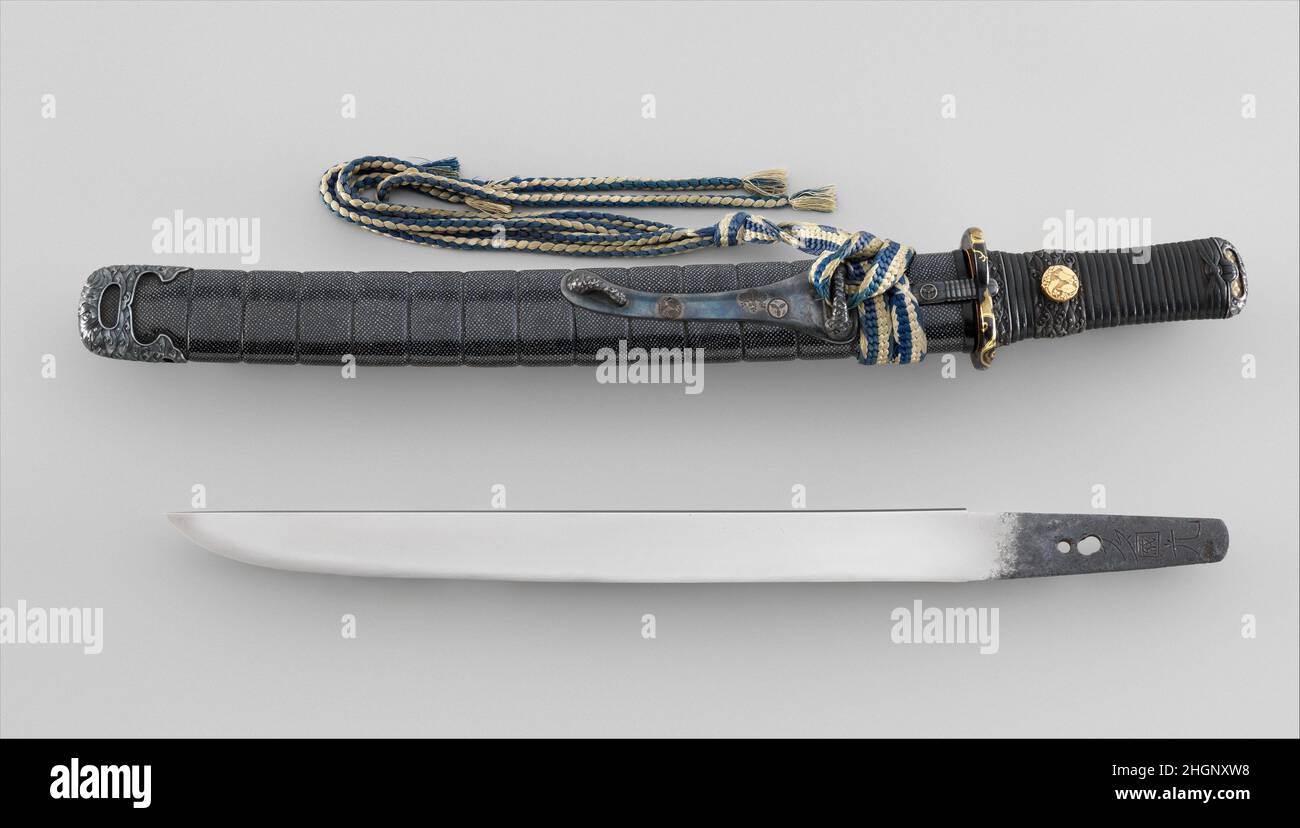 Blade and Mounting for a Dagger (Tantō) blade, dated November, 1333; mounting, 19th century Blade inscribed by Uda Kunimitsu Japanese Uda Kunimitsu lived in Uda in Yamato (present-day Nara Prefecture) and later moved to Ecchū (present-day Toyama Prefecture). He is recorded as working in the early to mid-fourteenth century. There were three generations of Kunimitsu swordsmiths who were active from the early fourteenth to the mid-fifteenth century, spanning the late Kamakura period to the mid-Muromachi period. Uda Kunimitsu was the first-generation swordsmith of the family and founder of the Uda Stock Photohttps://www.alamy.com/image-license-details/?v=1https://www.alamy.com/blade-and-mounting-for-a-dagger-tant-blade-dated-november-1333-mounting-19th-century-blade-inscribed-by-uda-kunimitsu-japanese-uda-kunimitsu-lived-in-uda-in-yamato-present-day-nara-prefecture-and-later-moved-to-ecch-present-day-toyama-prefecture-he-is-recorded-as-working-in-the-early-to-mid-fourteenth-century-there-were-three-generations-of-kunimitsu-swordsmiths-who-were-active-from-the-early-fourteenth-to-the-mid-fifteenth-century-spanning-the-late-kamakura-period-to-the-mid-muromachi-period-uda-kunimitsu-was-the-first-generation-swordsmith-of-the-family-and-founder-of-the-uda-image457786148.html
Blade and Mounting for a Dagger (Tantō) blade, dated November, 1333; mounting, 19th century Blade inscribed by Uda Kunimitsu Japanese Uda Kunimitsu lived in Uda in Yamato (present-day Nara Prefecture) and later moved to Ecchū (present-day Toyama Prefecture). He is recorded as working in the early to mid-fourteenth century. There were three generations of Kunimitsu swordsmiths who were active from the early fourteenth to the mid-fifteenth century, spanning the late Kamakura period to the mid-Muromachi period. Uda Kunimitsu was the first-generation swordsmith of the family and founder of the Uda Stock Photohttps://www.alamy.com/image-license-details/?v=1https://www.alamy.com/blade-and-mounting-for-a-dagger-tant-blade-dated-november-1333-mounting-19th-century-blade-inscribed-by-uda-kunimitsu-japanese-uda-kunimitsu-lived-in-uda-in-yamato-present-day-nara-prefecture-and-later-moved-to-ecch-present-day-toyama-prefecture-he-is-recorded-as-working-in-the-early-to-mid-fourteenth-century-there-were-three-generations-of-kunimitsu-swordsmiths-who-were-active-from-the-early-fourteenth-to-the-mid-fifteenth-century-spanning-the-late-kamakura-period-to-the-mid-muromachi-period-uda-kunimitsu-was-the-first-generation-swordsmith-of-the-family-and-founder-of-the-uda-image457786148.htmlRM2HGNXW8–Blade and Mounting for a Dagger (Tantō) blade, dated November, 1333; mounting, 19th century Blade inscribed by Uda Kunimitsu Japanese Uda Kunimitsu lived in Uda in Yamato (present-day Nara Prefecture) and later moved to Ecchū (present-day Toyama Prefecture). He is recorded as working in the early to mid-fourteenth century. There were three generations of Kunimitsu swordsmiths who were active from the early fourteenth to the mid-fifteenth century, spanning the late Kamakura period to the mid-Muromachi period. Uda Kunimitsu was the first-generation swordsmith of the family and founder of the Uda
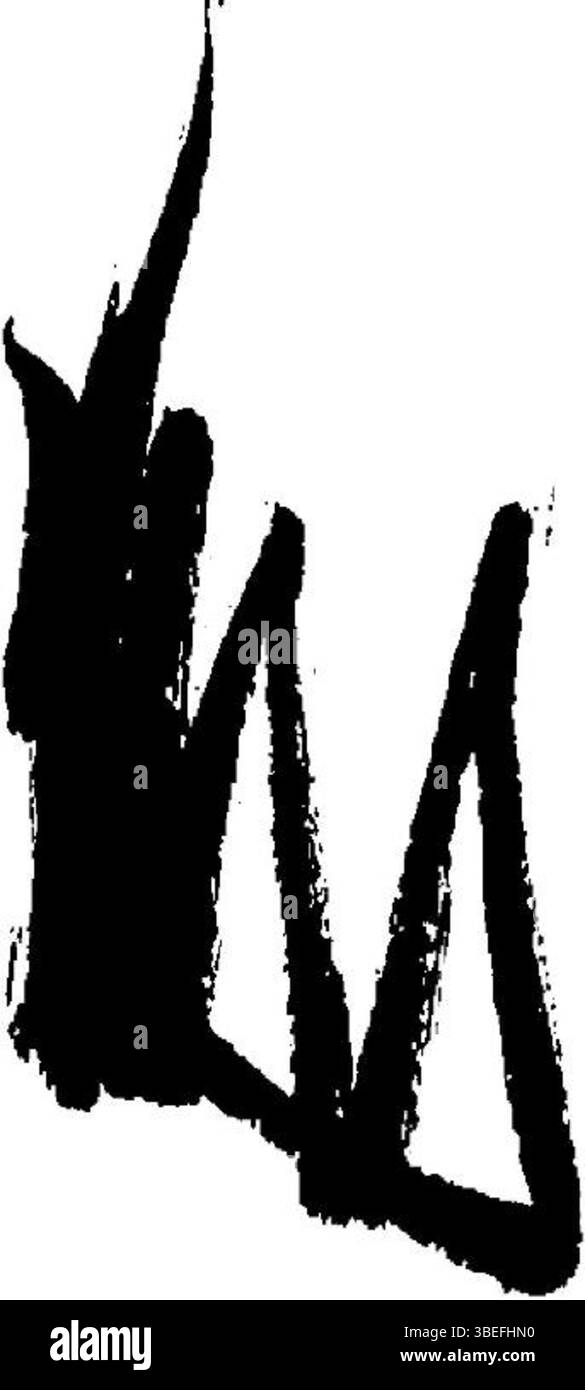 Aburanokji Takakage (1297–1364) was a notable figure during Japan's Kamakura period, serving as a samurai. His contributions to Japanese history and military culture reflect the complexities of the time. Stock Photohttps://www.alamy.com/image-license-details/?v=1https://www.alamy.com/aburanokji-takakage-12971364-was-a-notable-figure-during-japans-kamakura-period-serving-as-a-samurai-his-contributions-to-japanese-history-and-military-culture-reflect-the-complexities-of-the-time-image680152732.html
Aburanokji Takakage (1297–1364) was a notable figure during Japan's Kamakura period, serving as a samurai. His contributions to Japanese history and military culture reflect the complexities of the time. Stock Photohttps://www.alamy.com/image-license-details/?v=1https://www.alamy.com/aburanokji-takakage-12971364-was-a-notable-figure-during-japans-kamakura-period-serving-as-a-samurai-his-contributions-to-japanese-history-and-military-culture-reflect-the-complexities-of-the-time-image680152732.htmlRM3BEFHN0–Aburanokji Takakage (1297–1364) was a notable figure during Japan's Kamakura period, serving as a samurai. His contributions to Japanese history and military culture reflect the complexities of the time.
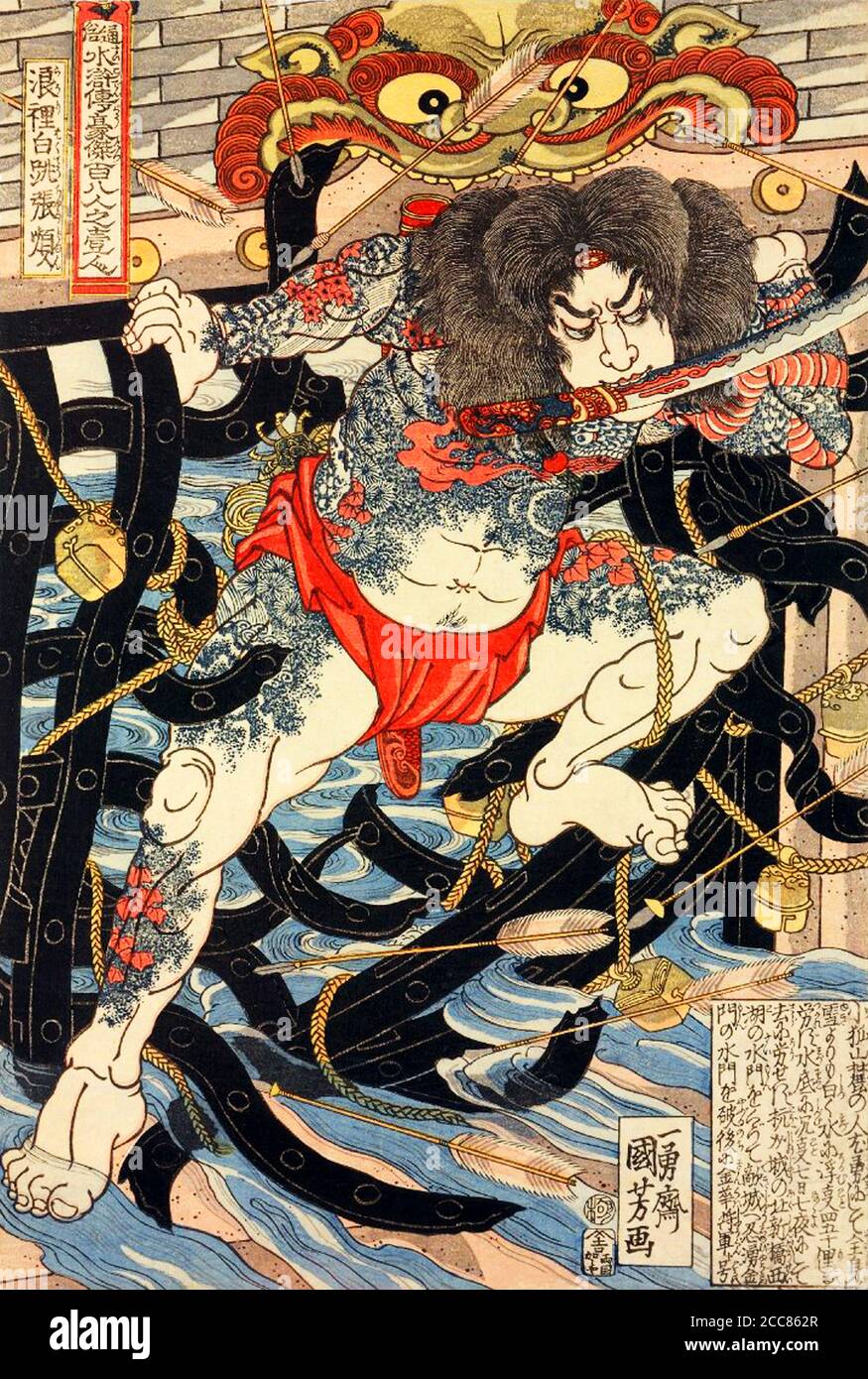 Japan: The tattooed Zhang Shun or Rorihakucho Cho Jun, one of the 'One Hundred and Eight Heroes of the Water Margin', smashes a water-gate with a sword between his teeth. Woodblock print by Utagawa Kuniyoshi (1797-1863), 1827-1830. The Water Margin (known in Chinese as Shuihu Zhuan, sometimes abbreviated to Shuihu, known as Suikoden in Japanese, as well as Outlaws of the Marsh, Tale of the Marshes, All Men Are Brothers, Men of the Marshes, or The Marshes of Mount Liang in English, is a 14th century novel and one of the Four Great Classical Novels of Chinese literature. Attributed to Shi Nai'an Stock Photohttps://www.alamy.com/image-license-details/?v=1https://www.alamy.com/japan-the-tattooed-zhang-shun-or-rorihakucho-cho-jun-one-of-the-one-hundred-and-eight-heroes-of-the-water-margin-smashes-a-water-gate-with-a-sword-between-his-teeth-woodblock-print-by-utagawa-kuniyoshi-1797-1863-1827-1830-the-water-margin-known-in-chinese-as-shuihu-zhuan-sometimes-abbreviated-to-shuihu-known-as-suikoden-in-japanese-as-well-as-outlaws-of-the-marsh-tale-of-the-marshes-all-men-are-brothers-men-of-the-marshes-or-the-marshes-of-mount-liang-in-english-is-a-14th-century-novel-and-one-of-the-four-great-classical-novels-of-chinese-literature-attributed-to-shi-naian-image368973999.html
Japan: The tattooed Zhang Shun or Rorihakucho Cho Jun, one of the 'One Hundred and Eight Heroes of the Water Margin', smashes a water-gate with a sword between his teeth. Woodblock print by Utagawa Kuniyoshi (1797-1863), 1827-1830. The Water Margin (known in Chinese as Shuihu Zhuan, sometimes abbreviated to Shuihu, known as Suikoden in Japanese, as well as Outlaws of the Marsh, Tale of the Marshes, All Men Are Brothers, Men of the Marshes, or The Marshes of Mount Liang in English, is a 14th century novel and one of the Four Great Classical Novels of Chinese literature. Attributed to Shi Nai'an Stock Photohttps://www.alamy.com/image-license-details/?v=1https://www.alamy.com/japan-the-tattooed-zhang-shun-or-rorihakucho-cho-jun-one-of-the-one-hundred-and-eight-heroes-of-the-water-margin-smashes-a-water-gate-with-a-sword-between-his-teeth-woodblock-print-by-utagawa-kuniyoshi-1797-1863-1827-1830-the-water-margin-known-in-chinese-as-shuihu-zhuan-sometimes-abbreviated-to-shuihu-known-as-suikoden-in-japanese-as-well-as-outlaws-of-the-marsh-tale-of-the-marshes-all-men-are-brothers-men-of-the-marshes-or-the-marshes-of-mount-liang-in-english-is-a-14th-century-novel-and-one-of-the-four-great-classical-novels-of-chinese-literature-attributed-to-shi-naian-image368973999.htmlRM2CC862R–Japan: The tattooed Zhang Shun or Rorihakucho Cho Jun, one of the 'One Hundred and Eight Heroes of the Water Margin', smashes a water-gate with a sword between his teeth. Woodblock print by Utagawa Kuniyoshi (1797-1863), 1827-1830. The Water Margin (known in Chinese as Shuihu Zhuan, sometimes abbreviated to Shuihu, known as Suikoden in Japanese, as well as Outlaws of the Marsh, Tale of the Marshes, All Men Are Brothers, Men of the Marshes, or The Marshes of Mount Liang in English, is a 14th century novel and one of the Four Great Classical Novels of Chinese literature. Attributed to Shi Nai'an
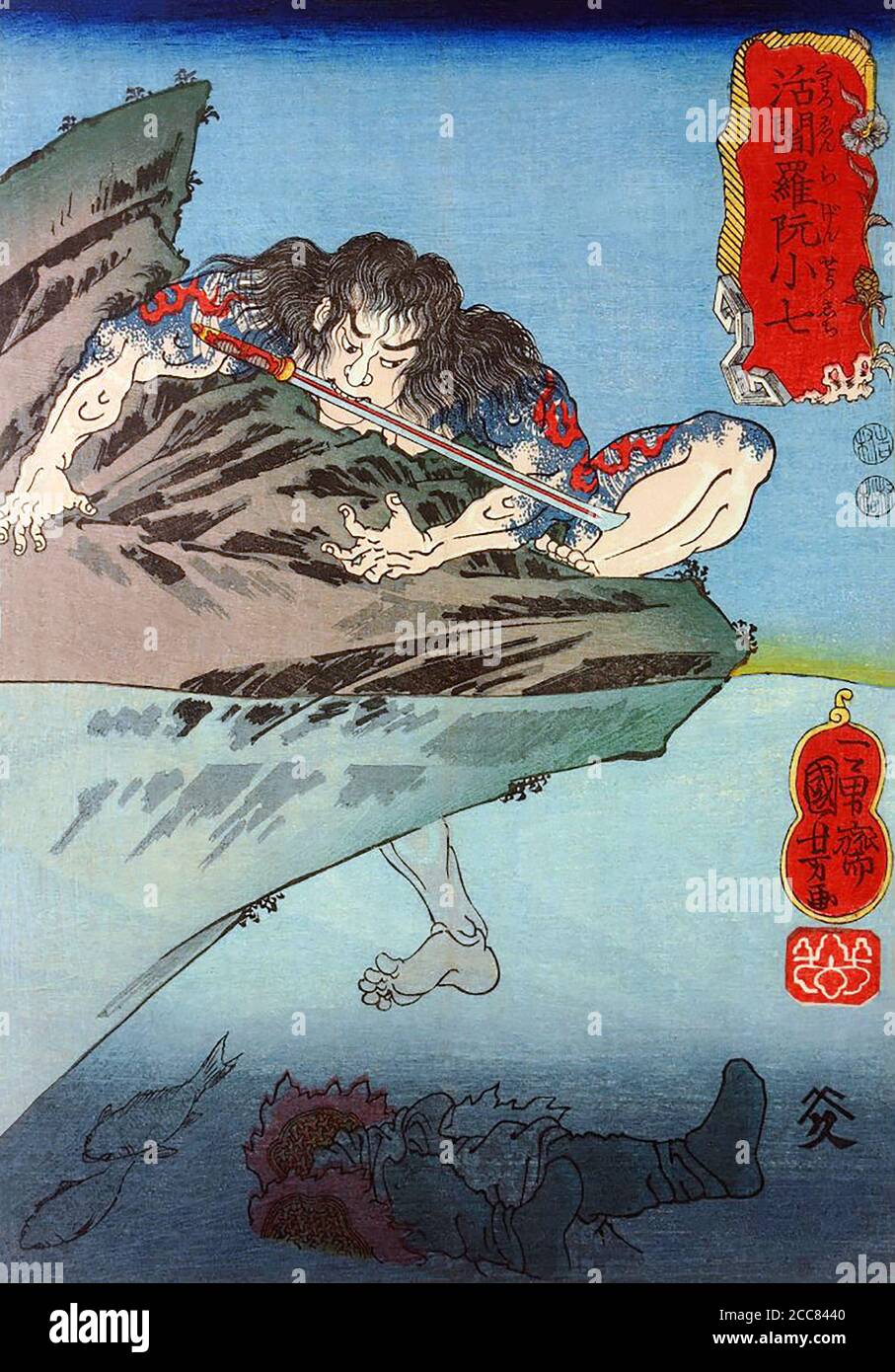 Japan: Living King Yama Ruan Xiaoqi or Katsuenra Genshoshichi, one of the 'One Hundred and Eight Heroes of the Water Margin', climbing out of the water onto a rock, his sword between his teeth, leaving his enemy underwater. Woodblock print by Utagawa Kuniyoshi (1797-1863), 1827-1830. The Water Margin (known in Chinese as Shuihu Zhuan, sometimes abbreviated to Shuihu, known as Suikoden in Japanese, as well as Outlaws of the Marsh, Tale of the Marshes, All Men Are Brothers, Men of the Marshes, or The Marshes of Mount Liang in English, is a 14th century novel and one of the Four Great Classical N Stock Photohttps://www.alamy.com/image-license-details/?v=1https://www.alamy.com/japan-living-king-yama-ruan-xiaoqi-or-katsuenra-genshoshichi-one-of-the-one-hundred-and-eight-heroes-of-the-water-margin-climbing-out-of-the-water-onto-a-rock-his-sword-between-his-teeth-leaving-his-enemy-underwater-woodblock-print-by-utagawa-kuniyoshi-1797-1863-1827-1830-the-water-margin-known-in-chinese-as-shuihu-zhuan-sometimes-abbreviated-to-shuihu-known-as-suikoden-in-japanese-as-well-as-outlaws-of-the-marsh-tale-of-the-marshes-all-men-are-brothers-men-of-the-marshes-or-the-marshes-of-mount-liang-in-english-is-a-14th-century-novel-and-one-of-the-four-great-classical-n-image368972464.html
Japan: Living King Yama Ruan Xiaoqi or Katsuenra Genshoshichi, one of the 'One Hundred and Eight Heroes of the Water Margin', climbing out of the water onto a rock, his sword between his teeth, leaving his enemy underwater. Woodblock print by Utagawa Kuniyoshi (1797-1863), 1827-1830. The Water Margin (known in Chinese as Shuihu Zhuan, sometimes abbreviated to Shuihu, known as Suikoden in Japanese, as well as Outlaws of the Marsh, Tale of the Marshes, All Men Are Brothers, Men of the Marshes, or The Marshes of Mount Liang in English, is a 14th century novel and one of the Four Great Classical N Stock Photohttps://www.alamy.com/image-license-details/?v=1https://www.alamy.com/japan-living-king-yama-ruan-xiaoqi-or-katsuenra-genshoshichi-one-of-the-one-hundred-and-eight-heroes-of-the-water-margin-climbing-out-of-the-water-onto-a-rock-his-sword-between-his-teeth-leaving-his-enemy-underwater-woodblock-print-by-utagawa-kuniyoshi-1797-1863-1827-1830-the-water-margin-known-in-chinese-as-shuihu-zhuan-sometimes-abbreviated-to-shuihu-known-as-suikoden-in-japanese-as-well-as-outlaws-of-the-marsh-tale-of-the-marshes-all-men-are-brothers-men-of-the-marshes-or-the-marshes-of-mount-liang-in-english-is-a-14th-century-novel-and-one-of-the-four-great-classical-n-image368972464.htmlRM2CC8440–Japan: Living King Yama Ruan Xiaoqi or Katsuenra Genshoshichi, one of the 'One Hundred and Eight Heroes of the Water Margin', climbing out of the water onto a rock, his sword between his teeth, leaving his enemy underwater. Woodblock print by Utagawa Kuniyoshi (1797-1863), 1827-1830. The Water Margin (known in Chinese as Shuihu Zhuan, sometimes abbreviated to Shuihu, known as Suikoden in Japanese, as well as Outlaws of the Marsh, Tale of the Marshes, All Men Are Brothers, Men of the Marshes, or The Marshes of Mount Liang in English, is a 14th century novel and one of the Four Great Classical N
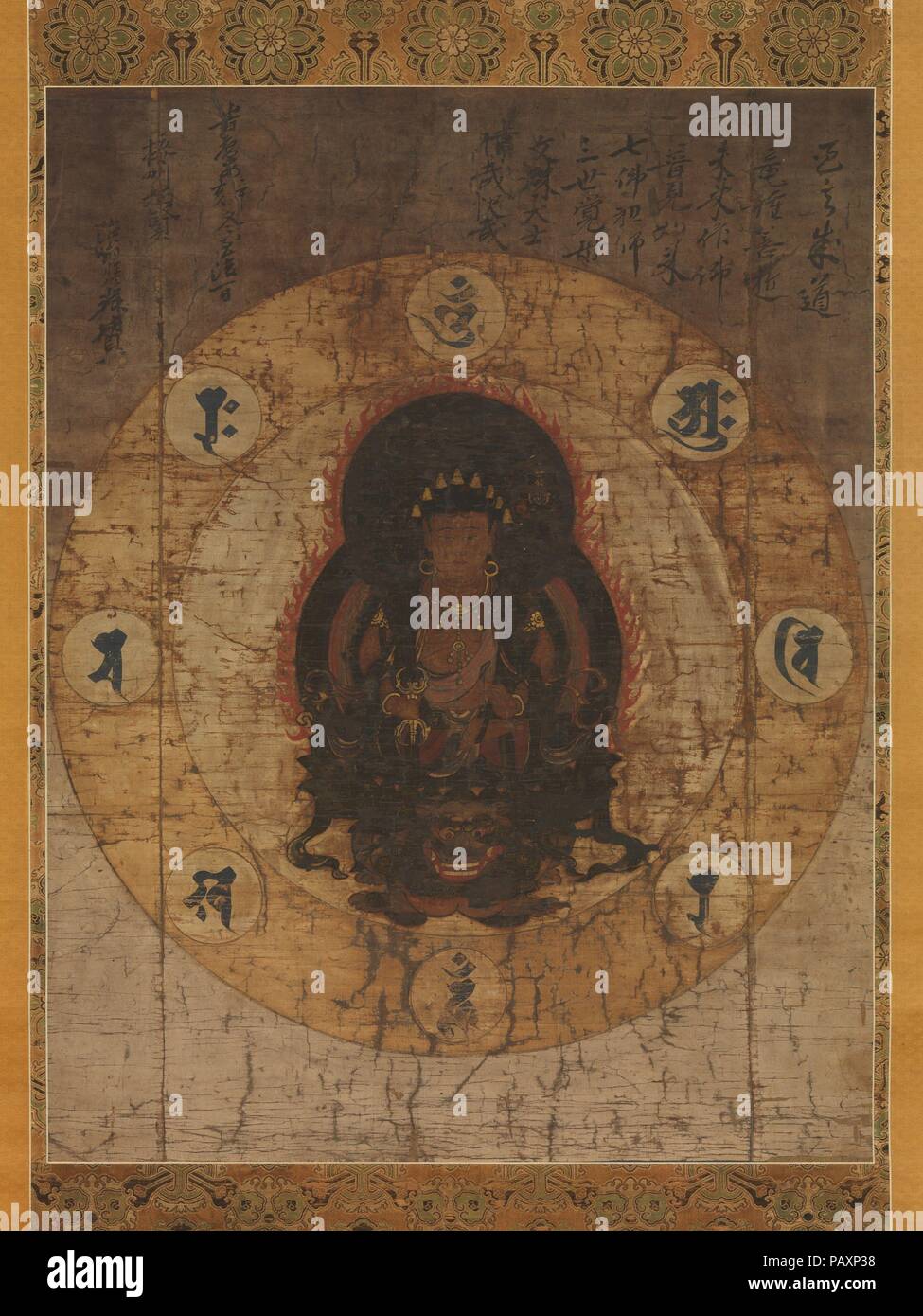 Monju Bosatsu with Eight Sacred Sanskrit Syllables. Culture: Japan. Dimensions: Overall: 40 7/8 x 25 1/8 in. (103.8 x 63.8 cm). Date: mid- to late 14th century. Monju (Sanskrit: Manjushri), the Bodhisattva of Wisdom, is seated on a lion against an ovoid nimbus edged with flames. He wears a crown decorated with eight miniature Buddhas and holds a sword and a long stemmed lotus flower supporting a vajra--a pronged implement with origins in Indian weaponry. In other manifestations of the bodhisattva, Monju's lotus typically supports a Buddhist scripture, but here the vajra is an emblem of wisdom Stock Photohttps://www.alamy.com/image-license-details/?v=1https://www.alamy.com/monju-bosatsu-with-eight-sacred-sanskrit-syllables-culture-japan-dimensions-overall-40-78-x-25-18-in-1038-x-638-cm-date-mid-to-late-14th-century-monju-sanskrit-manjushri-the-bodhisattva-of-wisdom-is-seated-on-a-lion-against-an-ovoid-nimbus-edged-with-flames-he-wears-a-crown-decorated-with-eight-miniature-buddhas-and-holds-a-sword-and-a-long-stemmed-lotus-flower-supporting-a-vajra-a-pronged-implement-with-origins-in-indian-weaponry-in-other-manifestations-of-the-bodhisattva-monjus-lotus-typically-supports-a-buddhist-scripture-but-here-the-vajra-is-an-emblem-of-wisdom-image213259068.html
Monju Bosatsu with Eight Sacred Sanskrit Syllables. Culture: Japan. Dimensions: Overall: 40 7/8 x 25 1/8 in. (103.8 x 63.8 cm). Date: mid- to late 14th century. Monju (Sanskrit: Manjushri), the Bodhisattva of Wisdom, is seated on a lion against an ovoid nimbus edged with flames. He wears a crown decorated with eight miniature Buddhas and holds a sword and a long stemmed lotus flower supporting a vajra--a pronged implement with origins in Indian weaponry. In other manifestations of the bodhisattva, Monju's lotus typically supports a Buddhist scripture, but here the vajra is an emblem of wisdom Stock Photohttps://www.alamy.com/image-license-details/?v=1https://www.alamy.com/monju-bosatsu-with-eight-sacred-sanskrit-syllables-culture-japan-dimensions-overall-40-78-x-25-18-in-1038-x-638-cm-date-mid-to-late-14th-century-monju-sanskrit-manjushri-the-bodhisattva-of-wisdom-is-seated-on-a-lion-against-an-ovoid-nimbus-edged-with-flames-he-wears-a-crown-decorated-with-eight-miniature-buddhas-and-holds-a-sword-and-a-long-stemmed-lotus-flower-supporting-a-vajra-a-pronged-implement-with-origins-in-indian-weaponry-in-other-manifestations-of-the-bodhisattva-monjus-lotus-typically-supports-a-buddhist-scripture-but-here-the-vajra-is-an-emblem-of-wisdom-image213259068.htmlRMPAXP38–Monju Bosatsu with Eight Sacred Sanskrit Syllables. Culture: Japan. Dimensions: Overall: 40 7/8 x 25 1/8 in. (103.8 x 63.8 cm). Date: mid- to late 14th century. Monju (Sanskrit: Manjushri), the Bodhisattva of Wisdom, is seated on a lion against an ovoid nimbus edged with flames. He wears a crown decorated with eight miniature Buddhas and holds a sword and a long stemmed lotus flower supporting a vajra--a pronged implement with origins in Indian weaponry. In other manifestations of the bodhisattva, Monju's lotus typically supports a Buddhist scripture, but here the vajra is an emblem of wisdom
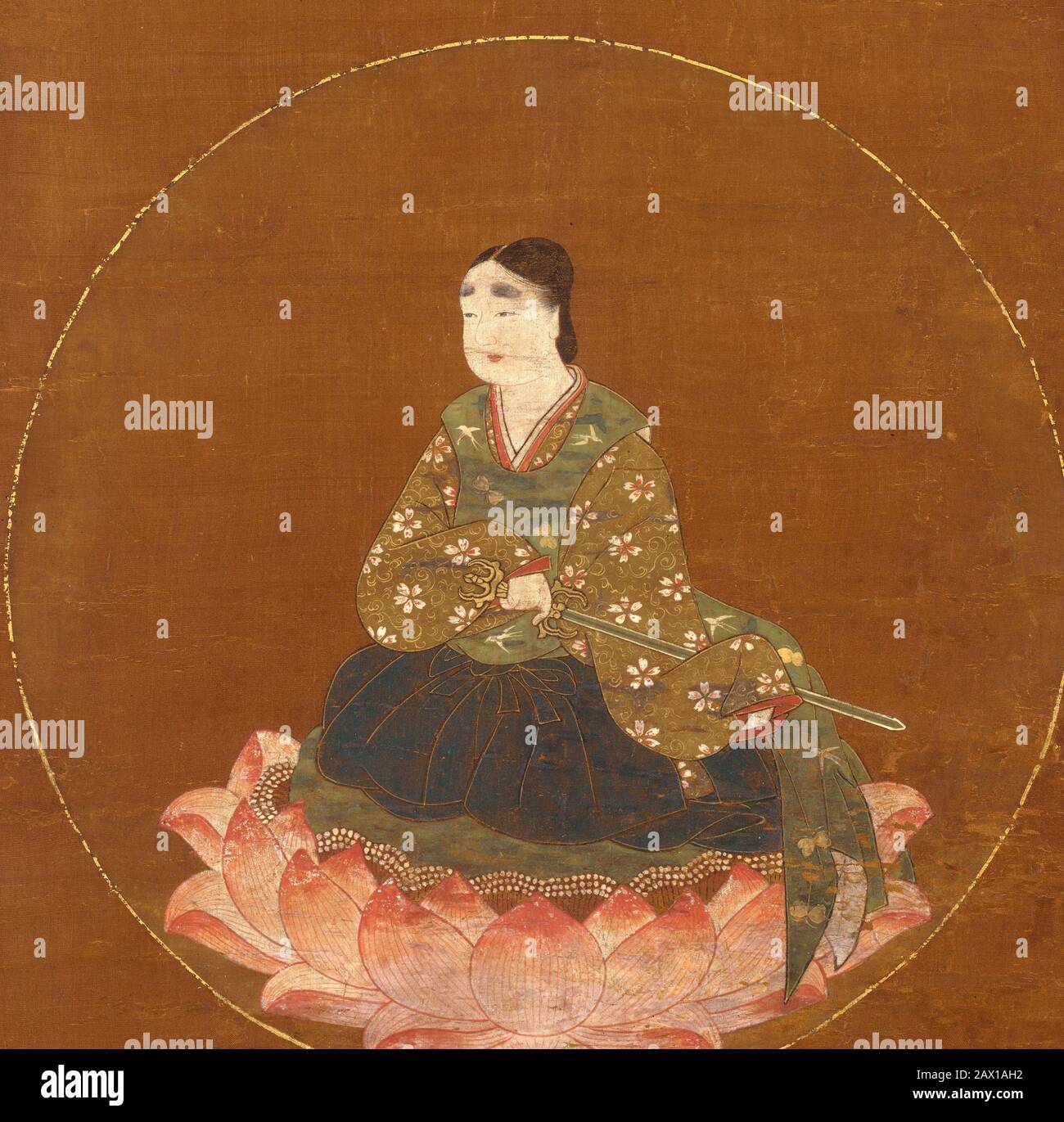 Mandala of Wakamiya of Kasuga Shrine (Kasuga wakamiya mandara), early 14th century. Ame-no-Koyane holds a sword with which to cut through the illusions of the unenlightened mind. Nanbokucho period (1336-92) Stock Photohttps://www.alamy.com/image-license-details/?v=1https://www.alamy.com/mandala-of-wakamiya-of-kasuga-shrine-kasuga-wakamiya-mandara-early-14th-century-ame-no-koyane-holds-a-sword-with-which-to-cut-through-the-illusions-of-the-unenlightened-mind-nanbokucho-period-1336-92-image343008318.html
Mandala of Wakamiya of Kasuga Shrine (Kasuga wakamiya mandara), early 14th century. Ame-no-Koyane holds a sword with which to cut through the illusions of the unenlightened mind. Nanbokucho period (1336-92) Stock Photohttps://www.alamy.com/image-license-details/?v=1https://www.alamy.com/mandala-of-wakamiya-of-kasuga-shrine-kasuga-wakamiya-mandara-early-14th-century-ame-no-koyane-holds-a-sword-with-which-to-cut-through-the-illusions-of-the-unenlightened-mind-nanbokucho-period-1336-92-image343008318.htmlRM2AX1AH2–Mandala of Wakamiya of Kasuga Shrine (Kasuga wakamiya mandara), early 14th century. Ame-no-Koyane holds a sword with which to cut through the illusions of the unenlightened mind. Nanbokucho period (1336-92)
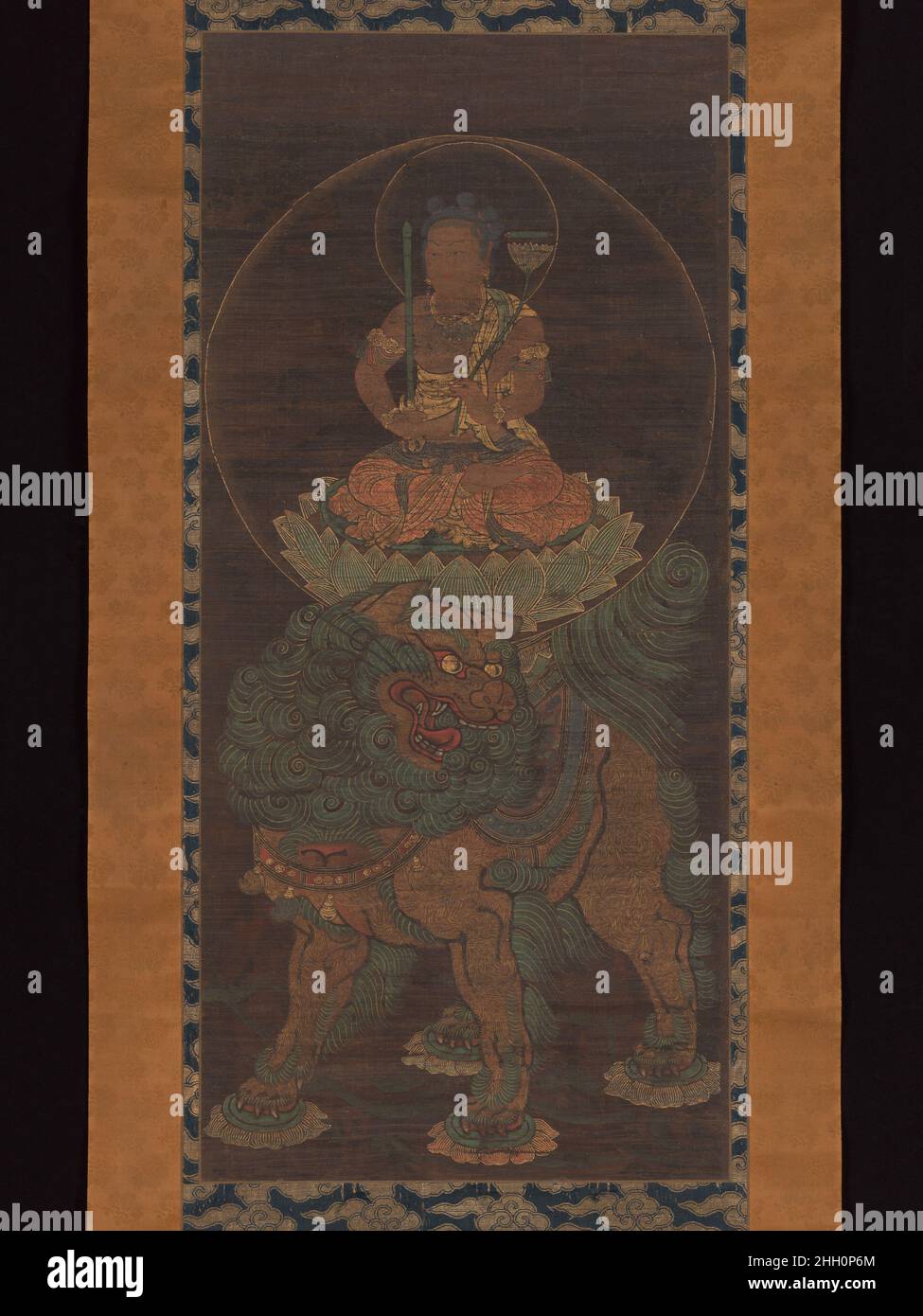 The Bodhisattva Monju (Manjushri) with Five Topknots 14th century Unidentified This painting portrays a variant form of the bodhisattva Monju known as Monju with Five Topknots (Gokei Monju). He is imagined as a boy sitting cross-legged on a lotus pedestal atop a lion. He carries a sword, used to cut through ignorance, and a lotus, above which hovers a scroll representing the Perfection of Wisdom Sutra. The five topknots symbolize five buddhas who are said to embody five types of cognition.. The Bodhisattva Monju (Manjushri) with Five Topknots. Unidentified Artist, Japanese. Japan. 14th century Stock Photohttps://www.alamy.com/image-license-details/?v=1https://www.alamy.com/the-bodhisattva-monju-manjushri-with-five-topknots-14th-century-unidentified-this-painting-portrays-a-variant-form-of-the-bodhisattva-monju-known-as-monju-with-five-topknots-gokei-monju-he-is-imagined-as-a-boy-sitting-cross-legged-on-a-lotus-pedestal-atop-a-lion-he-carries-a-sword-used-to-cut-through-ignorance-and-a-lotus-above-which-hovers-a-scroll-representing-the-perfection-of-wisdom-sutra-the-five-topknots-symbolize-five-buddhas-who-are-said-to-embody-five-types-of-cognition-the-bodhisattva-monju-manjushri-with-five-topknots-unidentified-artist-japanese-japan-14th-century-image457936156.html
The Bodhisattva Monju (Manjushri) with Five Topknots 14th century Unidentified This painting portrays a variant form of the bodhisattva Monju known as Monju with Five Topknots (Gokei Monju). He is imagined as a boy sitting cross-legged on a lotus pedestal atop a lion. He carries a sword, used to cut through ignorance, and a lotus, above which hovers a scroll representing the Perfection of Wisdom Sutra. The five topknots symbolize five buddhas who are said to embody five types of cognition.. The Bodhisattva Monju (Manjushri) with Five Topknots. Unidentified Artist, Japanese. Japan. 14th century Stock Photohttps://www.alamy.com/image-license-details/?v=1https://www.alamy.com/the-bodhisattva-monju-manjushri-with-five-topknots-14th-century-unidentified-this-painting-portrays-a-variant-form-of-the-bodhisattva-monju-known-as-monju-with-five-topknots-gokei-monju-he-is-imagined-as-a-boy-sitting-cross-legged-on-a-lotus-pedestal-atop-a-lion-he-carries-a-sword-used-to-cut-through-ignorance-and-a-lotus-above-which-hovers-a-scroll-representing-the-perfection-of-wisdom-sutra-the-five-topknots-symbolize-five-buddhas-who-are-said-to-embody-five-types-of-cognition-the-bodhisattva-monju-manjushri-with-five-topknots-unidentified-artist-japanese-japan-14th-century-image457936156.htmlRM2HH0P6M–The Bodhisattva Monju (Manjushri) with Five Topknots 14th century Unidentified This painting portrays a variant form of the bodhisattva Monju known as Monju with Five Topknots (Gokei Monju). He is imagined as a boy sitting cross-legged on a lotus pedestal atop a lion. He carries a sword, used to cut through ignorance, and a lotus, above which hovers a scroll representing the Perfection of Wisdom Sutra. The five topknots symbolize five buddhas who are said to embody five types of cognition.. The Bodhisattva Monju (Manjushri) with Five Topknots. Unidentified Artist, Japanese. Japan. 14th century
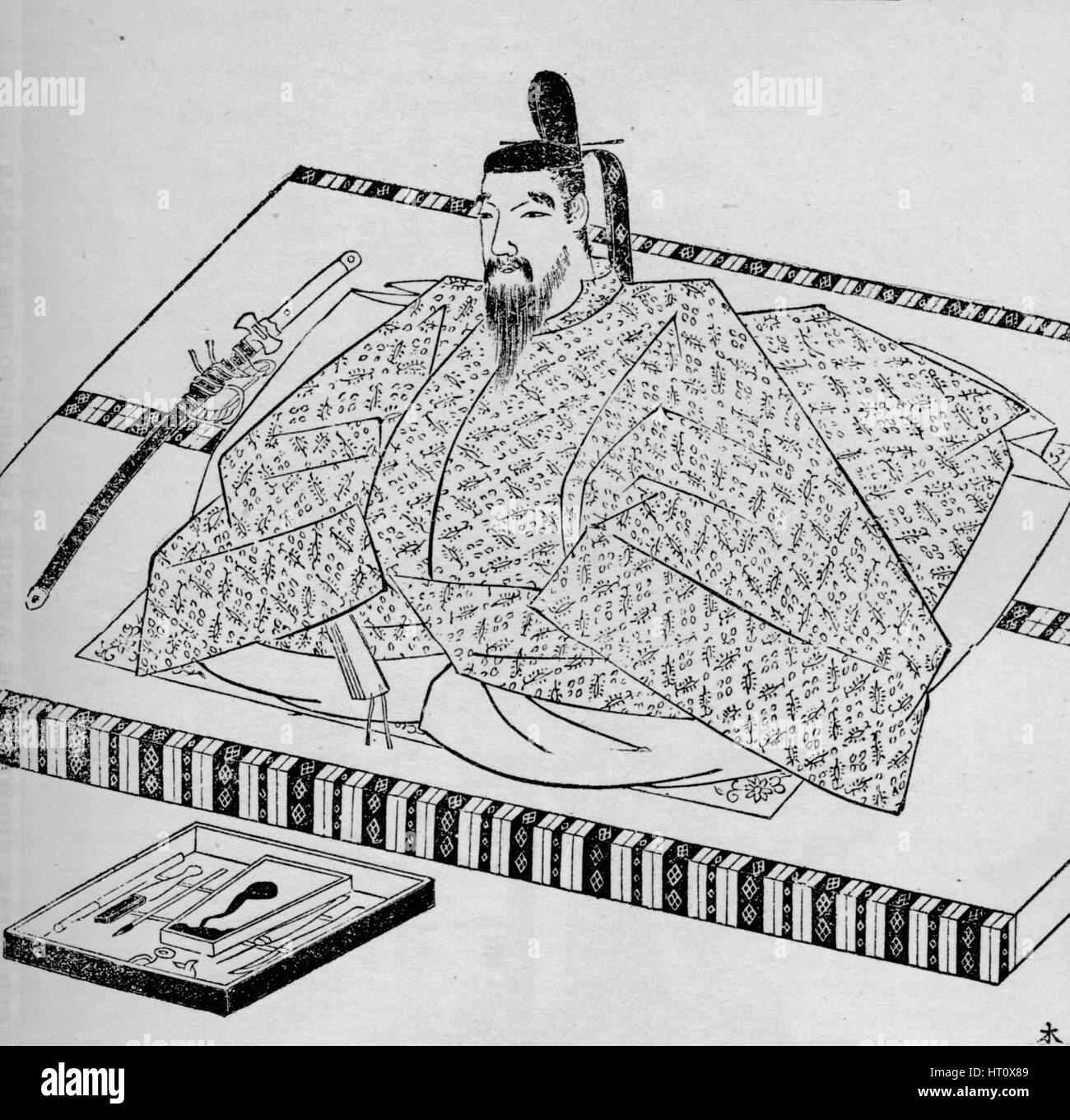 Go-Daigo, Emperor of Japan, 1907. Artist: Unknown. Stock Photohttps://www.alamy.com/image-license-details/?v=1https://www.alamy.com/stock-photo-go-daigo-emperor-of-japan-1907-artist-unknown-135244937.html
Go-Daigo, Emperor of Japan, 1907. Artist: Unknown. Stock Photohttps://www.alamy.com/image-license-details/?v=1https://www.alamy.com/stock-photo-go-daigo-emperor-of-japan-1907-artist-unknown-135244937.htmlRMHT0X89–Go-Daigo, Emperor of Japan, 1907. Artist: Unknown.
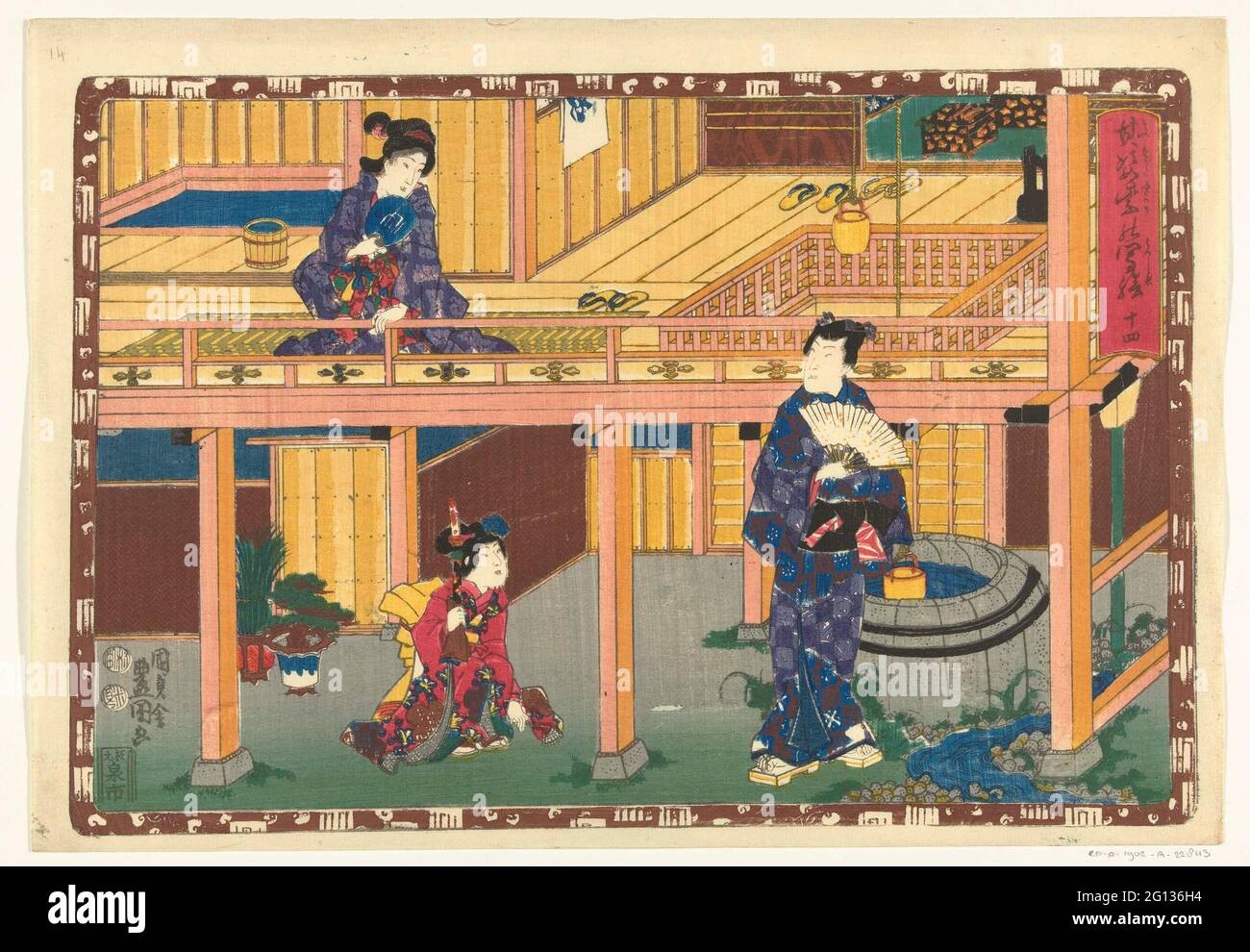 Chapter 14; Faithful images of the beautiful prince; Sono Sugata Hikaru No Utsushi-e. Prince Genji with range standing at well, looking at woman sitting on first floor porch; A maid with sword in the right hand looks. Presentation enclosed by brown edge in which Genji emblems. Stock Photohttps://www.alamy.com/image-license-details/?v=1https://www.alamy.com/chapter-14-faithful-images-of-the-beautiful-prince-sono-sugata-hikaru-no-utsushi-e-prince-genji-with-range-standing-at-well-looking-at-woman-sitting-on-first-floor-porch-a-maid-with-sword-in-the-right-hand-looks-presentation-enclosed-by-brown-edge-in-which-genji-emblems-image430944896.html
Chapter 14; Faithful images of the beautiful prince; Sono Sugata Hikaru No Utsushi-e. Prince Genji with range standing at well, looking at woman sitting on first floor porch; A maid with sword in the right hand looks. Presentation enclosed by brown edge in which Genji emblems. Stock Photohttps://www.alamy.com/image-license-details/?v=1https://www.alamy.com/chapter-14-faithful-images-of-the-beautiful-prince-sono-sugata-hikaru-no-utsushi-e-prince-genji-with-range-standing-at-well-looking-at-woman-sitting-on-first-floor-porch-a-maid-with-sword-in-the-right-hand-looks-presentation-enclosed-by-brown-edge-in-which-genji-emblems-image430944896.htmlRM2G136H4–Chapter 14; Faithful images of the beautiful prince; Sono Sugata Hikaru No Utsushi-e. Prince Genji with range standing at well, looking at woman sitting on first floor porch; A maid with sword in the right hand looks. Presentation enclosed by brown edge in which Genji emblems.
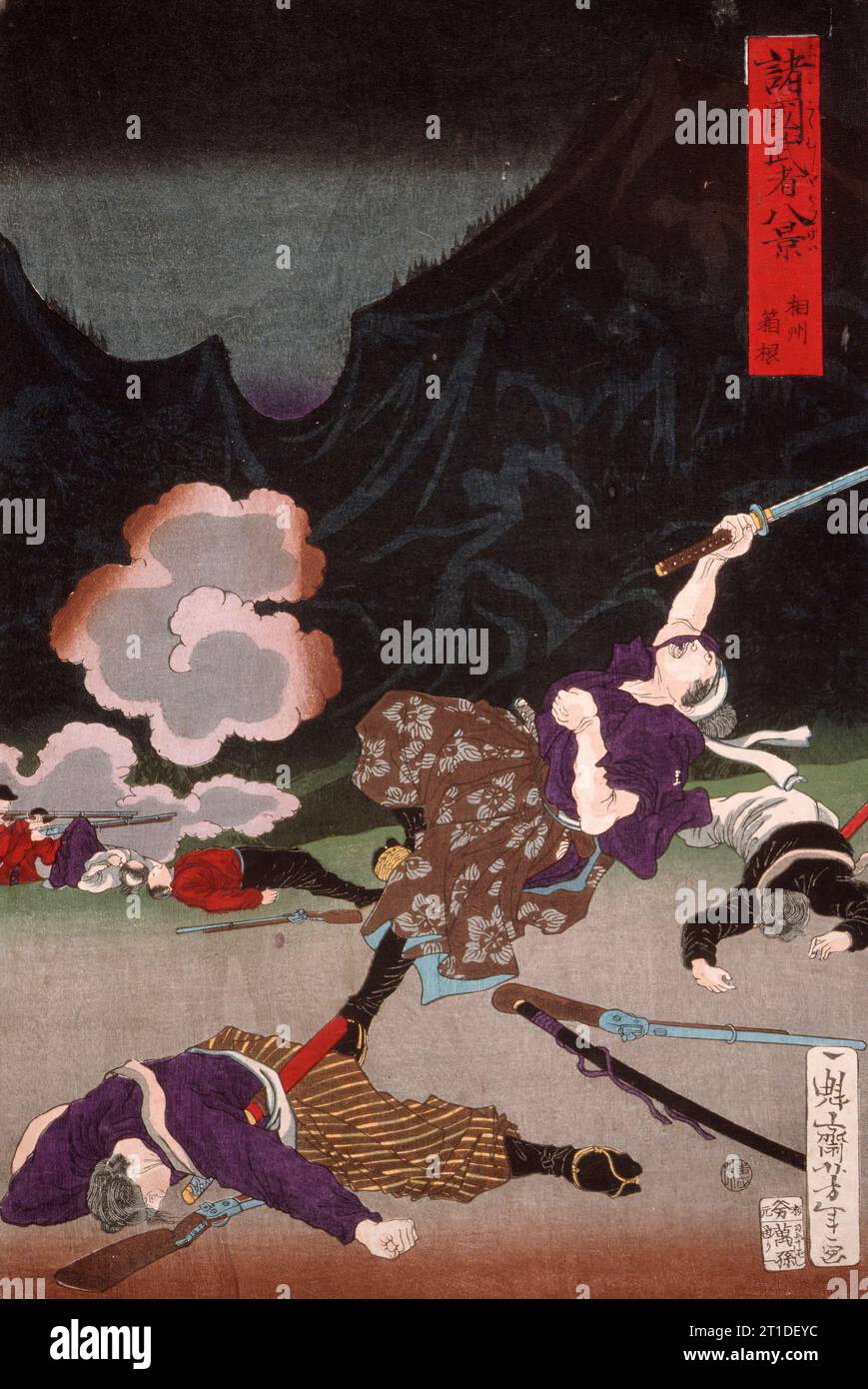 Battle of Hakone, Sagami, 1871. From Eight Views of Warriors in the Provinces. Stock Photohttps://www.alamy.com/image-license-details/?v=1https://www.alamy.com/battle-of-hakone-sagami-1871-from-eight-views-of-warriors-in-the-provinces-image568853920.html
Battle of Hakone, Sagami, 1871. From Eight Views of Warriors in the Provinces. Stock Photohttps://www.alamy.com/image-license-details/?v=1https://www.alamy.com/battle-of-hakone-sagami-1871-from-eight-views-of-warriors-in-the-provinces-image568853920.htmlRM2T1DEYC–Battle of Hakone, Sagami, 1871. From Eight Views of Warriors in the Provinces.
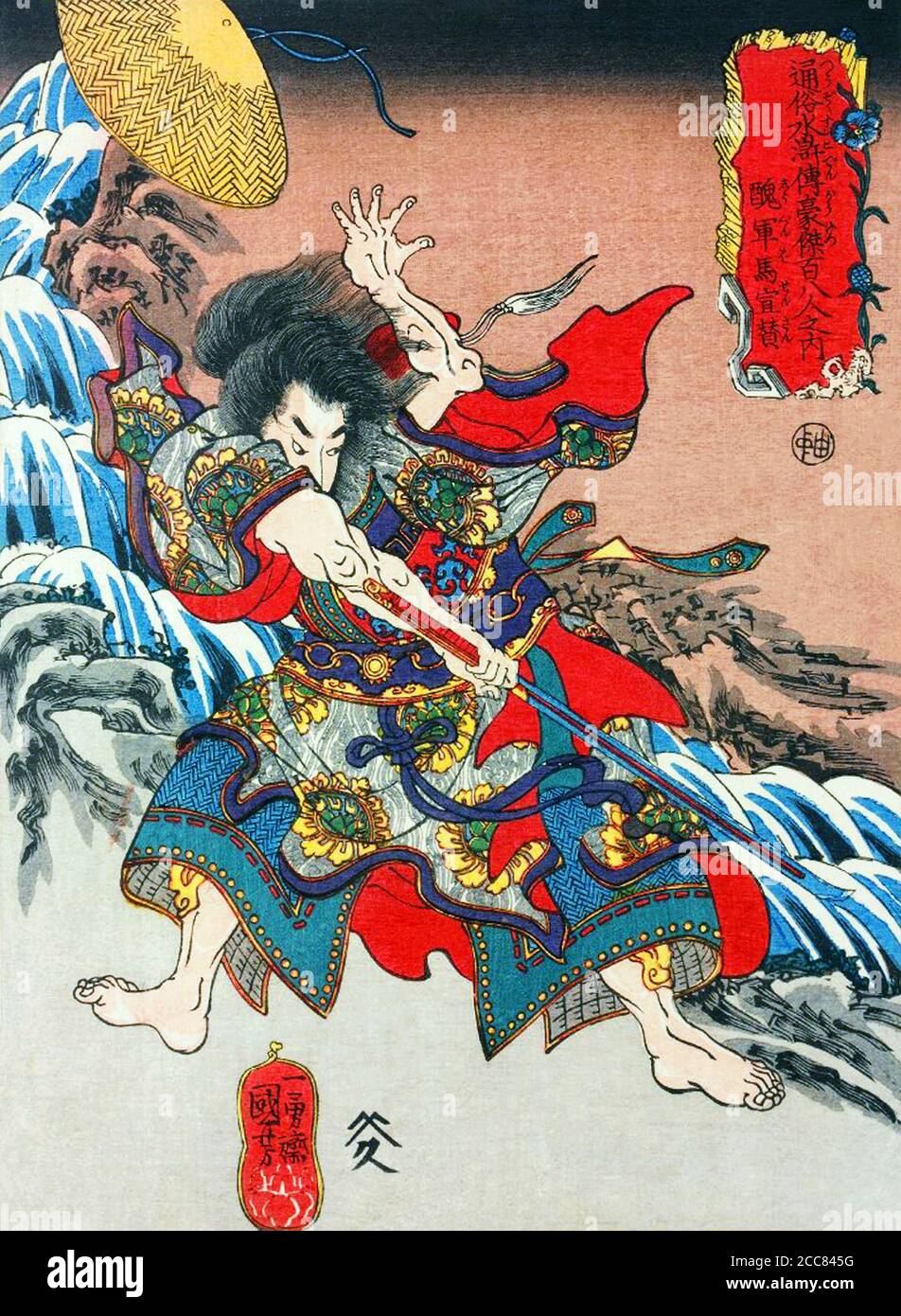 Japan: The Ugly Royal Son in Law Xuan Zan or Shugunba Sensan, one of the 'One Hundred and Eight Heroes of the Water Margin', makes a stroke with his sword by a waterfall, while his hat blows away in the strong wind. Woodblock print by Utagawa Kuniyoshi (1797-1863), 1827-1830. The Water Margin (known in Chinese as Shuihu Zhuan, sometimes abbreviated to Shuihu, known as Suikoden in Japanese, as well as Outlaws of the Marsh, Tale of the Marshes, All Men Are Brothers, Men of the Marshes, or The Marshes of Mount Liang in English, is a 14th century novel and one of the Four Great Classical Novels of Stock Photohttps://www.alamy.com/image-license-details/?v=1https://www.alamy.com/japan-the-ugly-royal-son-in-law-xuan-zan-or-shugunba-sensan-one-of-the-one-hundred-and-eight-heroes-of-the-water-margin-makes-a-stroke-with-his-sword-by-a-waterfall-while-his-hat-blows-away-in-the-strong-wind-woodblock-print-by-utagawa-kuniyoshi-1797-1863-1827-1830-the-water-margin-known-in-chinese-as-shuihu-zhuan-sometimes-abbreviated-to-shuihu-known-as-suikoden-in-japanese-as-well-as-outlaws-of-the-marsh-tale-of-the-marshes-all-men-are-brothers-men-of-the-marshes-or-the-marshes-of-mount-liang-in-english-is-a-14th-century-novel-and-one-of-the-four-great-classical-novels-of-image368972508.html
Japan: The Ugly Royal Son in Law Xuan Zan or Shugunba Sensan, one of the 'One Hundred and Eight Heroes of the Water Margin', makes a stroke with his sword by a waterfall, while his hat blows away in the strong wind. Woodblock print by Utagawa Kuniyoshi (1797-1863), 1827-1830. The Water Margin (known in Chinese as Shuihu Zhuan, sometimes abbreviated to Shuihu, known as Suikoden in Japanese, as well as Outlaws of the Marsh, Tale of the Marshes, All Men Are Brothers, Men of the Marshes, or The Marshes of Mount Liang in English, is a 14th century novel and one of the Four Great Classical Novels of Stock Photohttps://www.alamy.com/image-license-details/?v=1https://www.alamy.com/japan-the-ugly-royal-son-in-law-xuan-zan-or-shugunba-sensan-one-of-the-one-hundred-and-eight-heroes-of-the-water-margin-makes-a-stroke-with-his-sword-by-a-waterfall-while-his-hat-blows-away-in-the-strong-wind-woodblock-print-by-utagawa-kuniyoshi-1797-1863-1827-1830-the-water-margin-known-in-chinese-as-shuihu-zhuan-sometimes-abbreviated-to-shuihu-known-as-suikoden-in-japanese-as-well-as-outlaws-of-the-marsh-tale-of-the-marshes-all-men-are-brothers-men-of-the-marshes-or-the-marshes-of-mount-liang-in-english-is-a-14th-century-novel-and-one-of-the-four-great-classical-novels-of-image368972508.htmlRM2CC845G–Japan: The Ugly Royal Son in Law Xuan Zan or Shugunba Sensan, one of the 'One Hundred and Eight Heroes of the Water Margin', makes a stroke with his sword by a waterfall, while his hat blows away in the strong wind. Woodblock print by Utagawa Kuniyoshi (1797-1863), 1827-1830. The Water Margin (known in Chinese as Shuihu Zhuan, sometimes abbreviated to Shuihu, known as Suikoden in Japanese, as well as Outlaws of the Marsh, Tale of the Marshes, All Men Are Brothers, Men of the Marshes, or The Marshes of Mount Liang in English, is a 14th century novel and one of the Four Great Classical Novels of
RMPAXTFJ–Fudo Myoo. Artist: Kaikei (Japanese, active 1183-1223). Culture: Japan. Dimensions: H. 21 in. (53.3 cm); H. to top of sword 21 1/2 in. (54.6 cm); W. 16 3/4 in. (42.5 cm); D. 15 in. (38.1 cm). Date: early 13th century. Fudo Myoo (Sanskrit: Acala-vidyaraja), the chief of the Five Wisdom Kings (Godai myoo), is the wrathful avatar of Dainichi Buddha and the tenacious protector of Buddhist law. His iconography, drawn from the Dainichi Sutra, describes his body as black or blue, with bulging eyes, protruding fangs that bite his lower lip, and hair that hangs down his left shoulder. He carries in hi
 Japan: Xiao Rang or Seishushosei Shojo, one of the 'One Hundred and Eight Heroes of the Water Margin', a sword suspended by a cord clenched between his teeth, descending the wall of Peking castle by a rope in the moonlight. Woodblock print by Utagawa Kuniyoshi (1797-1863), 1827-1830. The Water Margin (known in Chinese as Shuihu Zhuan, sometimes abbreviated to Shuihu, known as Suikoden in Japanese, as well as Outlaws of the Marsh, Tale of the Marshes, All Men Are Brothers, Men of the Marshes, or The Marshes of Mount Liang in English, is a 14th century novel and one of the Four Great Classical N Stock Photohttps://www.alamy.com/image-license-details/?v=1https://www.alamy.com/japan-xiao-rang-or-seishushosei-shojo-one-of-the-one-hundred-and-eight-heroes-of-the-water-margin-a-sword-suspended-by-a-cord-clenched-between-his-teeth-descending-the-wall-of-peking-castle-by-a-rope-in-the-moonlight-woodblock-print-by-utagawa-kuniyoshi-1797-1863-1827-1830-the-water-margin-known-in-chinese-as-shuihu-zhuan-sometimes-abbreviated-to-shuihu-known-as-suikoden-in-japanese-as-well-as-outlaws-of-the-marsh-tale-of-the-marshes-all-men-are-brothers-men-of-the-marshes-or-the-marshes-of-mount-liang-in-english-is-a-14th-century-novel-and-one-of-the-four-great-classical-n-image368974054.html
Japan: Xiao Rang or Seishushosei Shojo, one of the 'One Hundred and Eight Heroes of the Water Margin', a sword suspended by a cord clenched between his teeth, descending the wall of Peking castle by a rope in the moonlight. Woodblock print by Utagawa Kuniyoshi (1797-1863), 1827-1830. The Water Margin (known in Chinese as Shuihu Zhuan, sometimes abbreviated to Shuihu, known as Suikoden in Japanese, as well as Outlaws of the Marsh, Tale of the Marshes, All Men Are Brothers, Men of the Marshes, or The Marshes of Mount Liang in English, is a 14th century novel and one of the Four Great Classical N Stock Photohttps://www.alamy.com/image-license-details/?v=1https://www.alamy.com/japan-xiao-rang-or-seishushosei-shojo-one-of-the-one-hundred-and-eight-heroes-of-the-water-margin-a-sword-suspended-by-a-cord-clenched-between-his-teeth-descending-the-wall-of-peking-castle-by-a-rope-in-the-moonlight-woodblock-print-by-utagawa-kuniyoshi-1797-1863-1827-1830-the-water-margin-known-in-chinese-as-shuihu-zhuan-sometimes-abbreviated-to-shuihu-known-as-suikoden-in-japanese-as-well-as-outlaws-of-the-marsh-tale-of-the-marshes-all-men-are-brothers-men-of-the-marshes-or-the-marshes-of-mount-liang-in-english-is-a-14th-century-novel-and-one-of-the-four-great-classical-n-image368974054.htmlRM2CC864P–Japan: Xiao Rang or Seishushosei Shojo, one of the 'One Hundred and Eight Heroes of the Water Margin', a sword suspended by a cord clenched between his teeth, descending the wall of Peking castle by a rope in the moonlight. Woodblock print by Utagawa Kuniyoshi (1797-1863), 1827-1830. The Water Margin (known in Chinese as Shuihu Zhuan, sometimes abbreviated to Shuihu, known as Suikoden in Japanese, as well as Outlaws of the Marsh, Tale of the Marshes, All Men Are Brothers, Men of the Marshes, or The Marshes of Mount Liang in English, is a 14th century novel and one of the Four Great Classical N
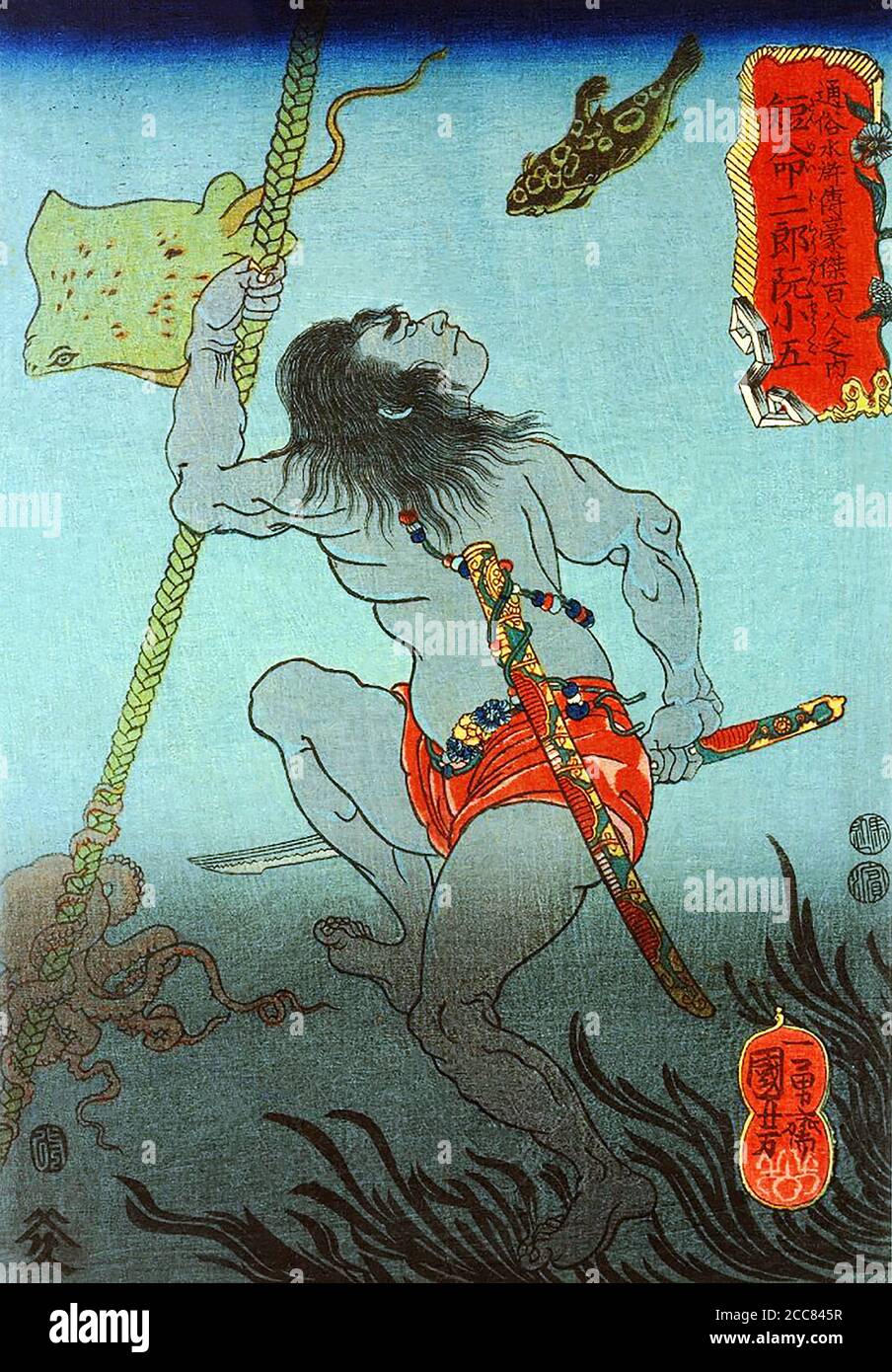 Japan: Short-lived Second Brother Ruan Xiaowu or Tanmeijiro Gen Shogo, one of the 'One Hundred and Eight Heroes of the Water Margin', underwater holding a rope, with a sword in his other hand. Woodblock print by Utagawa Kuniyoshi (1797-1863), 1827-1830. The Water Margin (known in Chinese as Shuihu Zhuan, sometimes abbreviated to Shuihu, known as Suikoden in Japanese, as well as Outlaws of the Marsh, Tale of the Marshes, All Men Are Brothers, Men of the Marshes, or The Marshes of Mount Liang in English, is a 14th century novel and one of the Four Great Classical Novels of Chinese literature. At Stock Photohttps://www.alamy.com/image-license-details/?v=1https://www.alamy.com/japan-short-lived-second-brother-ruan-xiaowu-or-tanmeijiro-gen-shogo-one-of-the-one-hundred-and-eight-heroes-of-the-water-margin-underwater-holding-a-rope-with-a-sword-in-his-other-hand-woodblock-print-by-utagawa-kuniyoshi-1797-1863-1827-1830-the-water-margin-known-in-chinese-as-shuihu-zhuan-sometimes-abbreviated-to-shuihu-known-as-suikoden-in-japanese-as-well-as-outlaws-of-the-marsh-tale-of-the-marshes-all-men-are-brothers-men-of-the-marshes-or-the-marshes-of-mount-liang-in-english-is-a-14th-century-novel-and-one-of-the-four-great-classical-novels-of-chinese-literature-at-image368972515.html
Japan: Short-lived Second Brother Ruan Xiaowu or Tanmeijiro Gen Shogo, one of the 'One Hundred and Eight Heroes of the Water Margin', underwater holding a rope, with a sword in his other hand. Woodblock print by Utagawa Kuniyoshi (1797-1863), 1827-1830. The Water Margin (known in Chinese as Shuihu Zhuan, sometimes abbreviated to Shuihu, known as Suikoden in Japanese, as well as Outlaws of the Marsh, Tale of the Marshes, All Men Are Brothers, Men of the Marshes, or The Marshes of Mount Liang in English, is a 14th century novel and one of the Four Great Classical Novels of Chinese literature. At Stock Photohttps://www.alamy.com/image-license-details/?v=1https://www.alamy.com/japan-short-lived-second-brother-ruan-xiaowu-or-tanmeijiro-gen-shogo-one-of-the-one-hundred-and-eight-heroes-of-the-water-margin-underwater-holding-a-rope-with-a-sword-in-his-other-hand-woodblock-print-by-utagawa-kuniyoshi-1797-1863-1827-1830-the-water-margin-known-in-chinese-as-shuihu-zhuan-sometimes-abbreviated-to-shuihu-known-as-suikoden-in-japanese-as-well-as-outlaws-of-the-marsh-tale-of-the-marshes-all-men-are-brothers-men-of-the-marshes-or-the-marshes-of-mount-liang-in-english-is-a-14th-century-novel-and-one-of-the-four-great-classical-novels-of-chinese-literature-at-image368972515.htmlRM2CC845R–Japan: Short-lived Second Brother Ruan Xiaowu or Tanmeijiro Gen Shogo, one of the 'One Hundred and Eight Heroes of the Water Margin', underwater holding a rope, with a sword in his other hand. Woodblock print by Utagawa Kuniyoshi (1797-1863), 1827-1830. The Water Margin (known in Chinese as Shuihu Zhuan, sometimes abbreviated to Shuihu, known as Suikoden in Japanese, as well as Outlaws of the Marsh, Tale of the Marshes, All Men Are Brothers, Men of the Marshes, or The Marshes of Mount Liang in English, is a 14th century novel and one of the Four Great Classical Novels of Chinese literature. At
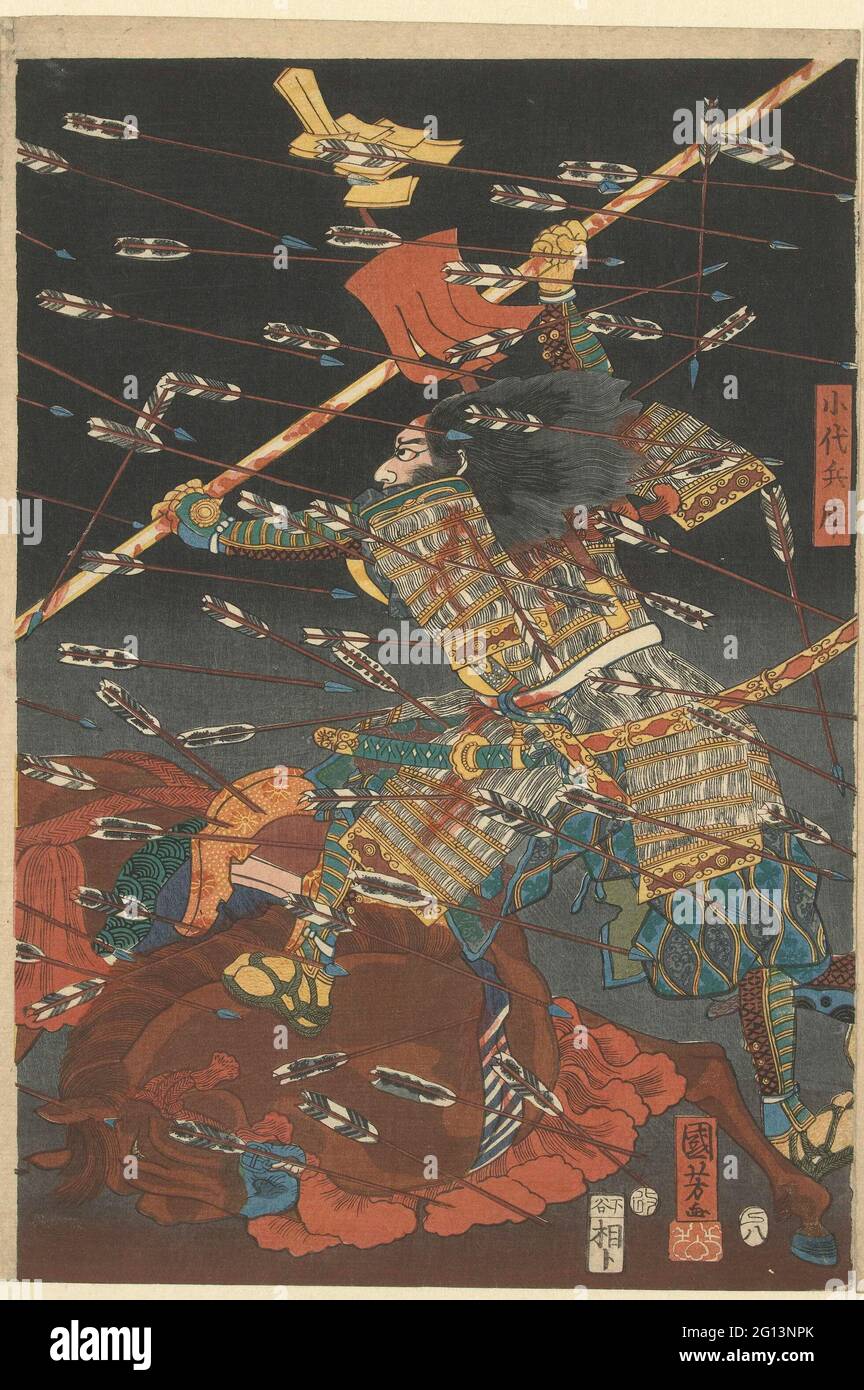 The last attack of the Kusunoki in Shijonawate; SHIJONAWATE NITE NANK NO EIYU TAITEKI O. KUSRESS OF THE KUSONOKI CLAN, with spear standing on Death Horse, during a arrow attack from the Ashikaga troops in Shijonawate. Fifth sheet of six hatch. Stock Photohttps://www.alamy.com/image-license-details/?v=1https://www.alamy.com/the-last-attack-of-the-kusunoki-in-shijonawate-shijonawate-nite-nank-no-eiyu-taiteki-o-kusress-of-the-kusonoki-clan-with-spear-standing-on-death-horse-during-a-arrow-attack-from-the-ashikaga-troops-in-shijonawate-fifth-sheet-of-six-hatch-image430956811.html
The last attack of the Kusunoki in Shijonawate; SHIJONAWATE NITE NANK NO EIYU TAITEKI O. KUSRESS OF THE KUSONOKI CLAN, with spear standing on Death Horse, during a arrow attack from the Ashikaga troops in Shijonawate. Fifth sheet of six hatch. Stock Photohttps://www.alamy.com/image-license-details/?v=1https://www.alamy.com/the-last-attack-of-the-kusunoki-in-shijonawate-shijonawate-nite-nank-no-eiyu-taiteki-o-kusress-of-the-kusonoki-clan-with-spear-standing-on-death-horse-during-a-arrow-attack-from-the-ashikaga-troops-in-shijonawate-fifth-sheet-of-six-hatch-image430956811.htmlRM2G13NPK–The last attack of the Kusunoki in Shijonawate; SHIJONAWATE NITE NANK NO EIYU TAITEKI O. KUSRESS OF THE KUSONOKI CLAN, with spear standing on Death Horse, during a arrow attack from the Ashikaga troops in Shijonawate. Fifth sheet of six hatch.
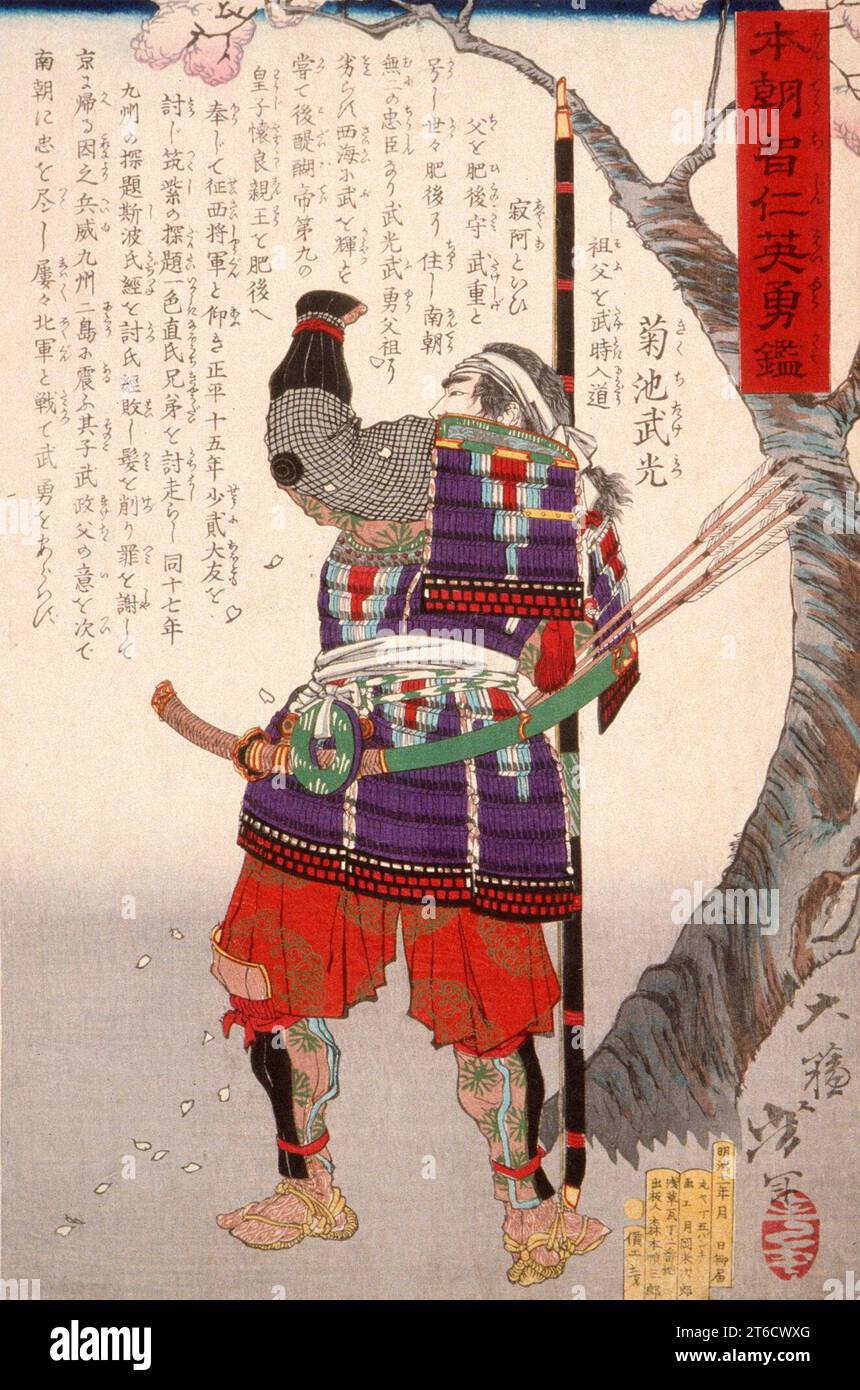 Kikuchi Takemitsu Standing by Cherry Tree, 1878. Series: A Mirror of Wisdom, Benevolence, and Valor in Japan. Stock Photohttps://www.alamy.com/image-license-details/?v=1https://www.alamy.com/kikuchi-takemitsu-standing-by-cherry-tree-1878-series-a-mirror-of-wisdom-benevolence-and-valor-in-japan-image571913848.html
Kikuchi Takemitsu Standing by Cherry Tree, 1878. Series: A Mirror of Wisdom, Benevolence, and Valor in Japan. Stock Photohttps://www.alamy.com/image-license-details/?v=1https://www.alamy.com/kikuchi-takemitsu-standing-by-cherry-tree-1878-series-a-mirror-of-wisdom-benevolence-and-valor-in-japan-image571913848.htmlRM2T6CWXG–Kikuchi Takemitsu Standing by Cherry Tree, 1878. Series: A Mirror of Wisdom, Benevolence, and Valor in Japan.
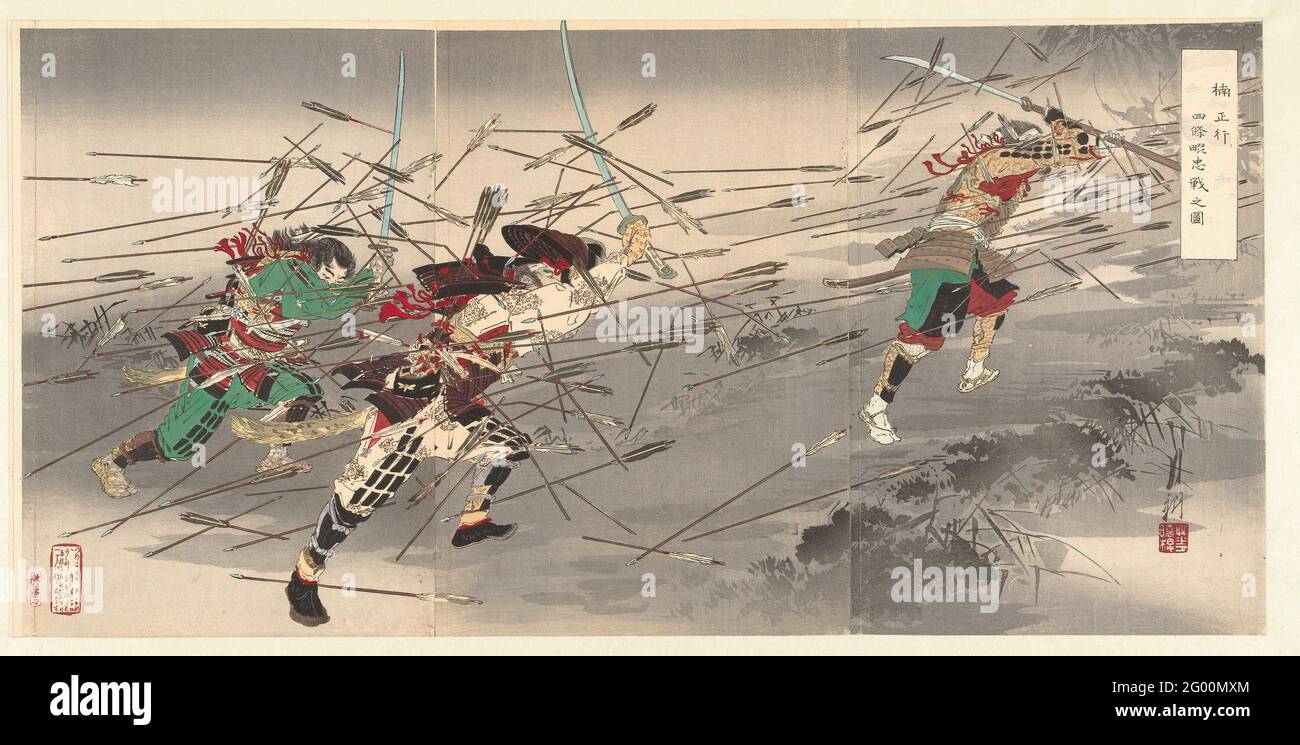 The loyalty of Kusunoki Masatsura in Shijonawata; Kusunoki Masatsura Shikonawata Chusen No zu. Kusunoki Masatsura with two followers in a arrow rain; Scene from the battle in Shijonawata, where the small loyal army of Kusunoki Masatsura was defeated by 60,000 opponents. Stock Photohttps://www.alamy.com/image-license-details/?v=1https://www.alamy.com/the-loyalty-of-kusunoki-masatsura-in-shijonawata-kusunoki-masatsura-shikonawata-chusen-no-zu-kusunoki-masatsura-with-two-followers-in-a-arrow-rain-scene-from-the-battle-in-shijonawata-where-the-small-loyal-army-of-kusunoki-masatsura-was-defeated-by-60000-opponents-image430275628.html
The loyalty of Kusunoki Masatsura in Shijonawata; Kusunoki Masatsura Shikonawata Chusen No zu. Kusunoki Masatsura with two followers in a arrow rain; Scene from the battle in Shijonawata, where the small loyal army of Kusunoki Masatsura was defeated by 60,000 opponents. Stock Photohttps://www.alamy.com/image-license-details/?v=1https://www.alamy.com/the-loyalty-of-kusunoki-masatsura-in-shijonawata-kusunoki-masatsura-shikonawata-chusen-no-zu-kusunoki-masatsura-with-two-followers-in-a-arrow-rain-scene-from-the-battle-in-shijonawata-where-the-small-loyal-army-of-kusunoki-masatsura-was-defeated-by-60000-opponents-image430275628.htmlRM2G00MXM–The loyalty of Kusunoki Masatsura in Shijonawata; Kusunoki Masatsura Shikonawata Chusen No zu. Kusunoki Masatsura with two followers in a arrow rain; Scene from the battle in Shijonawata, where the small loyal army of Kusunoki Masatsura was defeated by 60,000 opponents.
 Yang Lin (Kinhyoshi Yorin), from the series 'One Hundred and Eight Heroes of the Popular Water Margin (Tsuzoku Suikoden goketsu hyakuhachinin no hitori)'. Utagawa Kuniyoshi; Japanese, 1797-1861. Date: 1822-1835. Dimensions: 37.4 x 25.1 cm (14 3/4 x 9 7/8 in.). Color woodblock print; oban. Origin: Japan. Museum: The Chicago Art Institute. Stock Photohttps://www.alamy.com/image-license-details/?v=1https://www.alamy.com/yang-lin-kinhyoshi-yorin-from-the-series-one-hundred-and-eight-heroes-of-the-popular-water-margin-tsuzoku-suikoden-goketsu-hyakuhachinin-no-hitori-utagawa-kuniyoshi-japanese-1797-1861-date-1822-1835-dimensions-374-x-251-cm-14-34-x-9-78-in-color-woodblock-print-oban-origin-japan-museum-the-chicago-art-institute-image240172008.html
Yang Lin (Kinhyoshi Yorin), from the series 'One Hundred and Eight Heroes of the Popular Water Margin (Tsuzoku Suikoden goketsu hyakuhachinin no hitori)'. Utagawa Kuniyoshi; Japanese, 1797-1861. Date: 1822-1835. Dimensions: 37.4 x 25.1 cm (14 3/4 x 9 7/8 in.). Color woodblock print; oban. Origin: Japan. Museum: The Chicago Art Institute. Stock Photohttps://www.alamy.com/image-license-details/?v=1https://www.alamy.com/yang-lin-kinhyoshi-yorin-from-the-series-one-hundred-and-eight-heroes-of-the-popular-water-margin-tsuzoku-suikoden-goketsu-hyakuhachinin-no-hitori-utagawa-kuniyoshi-japanese-1797-1861-date-1822-1835-dimensions-374-x-251-cm-14-34-x-9-78-in-color-woodblock-print-oban-origin-japan-museum-the-chicago-art-institute-image240172008.htmlRMRXMNRM–Yang Lin (Kinhyoshi Yorin), from the series 'One Hundred and Eight Heroes of the Popular Water Margin (Tsuzoku Suikoden goketsu hyakuhachinin no hitori)'. Utagawa Kuniyoshi; Japanese, 1797-1861. Date: 1822-1835. Dimensions: 37.4 x 25.1 cm (14 3/4 x 9 7/8 in.). Color woodblock print; oban. Origin: Japan. Museum: The Chicago Art Institute.
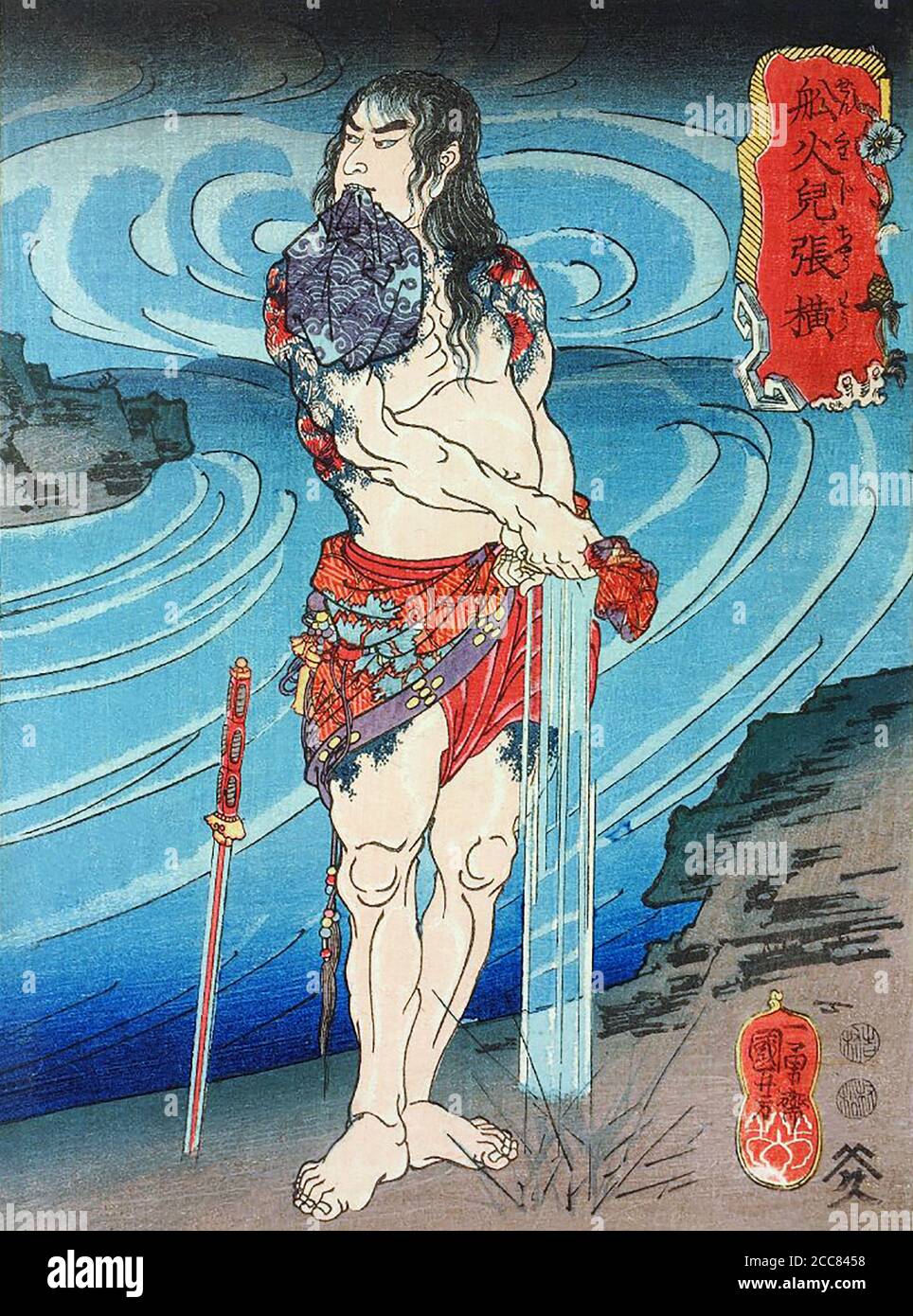 Japan: The Boatman Zhang Heng or Senkaji Cho O, one of the 'One Hundred and Eight Heroes of the Water Margin', wringing out his loincloth on a riverbank, a cloth bag held in his mouth and a sword stuck in the ground beside him. Woodblock print by Utagawa Kuniyoshi (1797-1863), 1827-1830. The Water Margin (known in Chinese as Shuihu Zhuan, sometimes abbreviated to Shuihu, known as Suikoden in Japanese, as well as Outlaws of the Marsh, Tale of the Marshes, All Men Are Brothers, Men of the Marshes, or The Marshes of Mount Liang in English, is a 14th century novel and one of the Four Great Classic Stock Photohttps://www.alamy.com/image-license-details/?v=1https://www.alamy.com/japan-the-boatman-zhang-heng-or-senkaji-cho-o-one-of-the-one-hundred-and-eight-heroes-of-the-water-margin-wringing-out-his-loincloth-on-a-riverbank-a-cloth-bag-held-in-his-mouth-and-a-sword-stuck-in-the-ground-beside-him-woodblock-print-by-utagawa-kuniyoshi-1797-1863-1827-1830-the-water-margin-known-in-chinese-as-shuihu-zhuan-sometimes-abbreviated-to-shuihu-known-as-suikoden-in-japanese-as-well-as-outlaws-of-the-marsh-tale-of-the-marshes-all-men-are-brothers-men-of-the-marshes-or-the-marshes-of-mount-liang-in-english-is-a-14th-century-novel-and-one-of-the-four-great-classic-image368972500.html
Japan: The Boatman Zhang Heng or Senkaji Cho O, one of the 'One Hundred and Eight Heroes of the Water Margin', wringing out his loincloth on a riverbank, a cloth bag held in his mouth and a sword stuck in the ground beside him. Woodblock print by Utagawa Kuniyoshi (1797-1863), 1827-1830. The Water Margin (known in Chinese as Shuihu Zhuan, sometimes abbreviated to Shuihu, known as Suikoden in Japanese, as well as Outlaws of the Marsh, Tale of the Marshes, All Men Are Brothers, Men of the Marshes, or The Marshes of Mount Liang in English, is a 14th century novel and one of the Four Great Classic Stock Photohttps://www.alamy.com/image-license-details/?v=1https://www.alamy.com/japan-the-boatman-zhang-heng-or-senkaji-cho-o-one-of-the-one-hundred-and-eight-heroes-of-the-water-margin-wringing-out-his-loincloth-on-a-riverbank-a-cloth-bag-held-in-his-mouth-and-a-sword-stuck-in-the-ground-beside-him-woodblock-print-by-utagawa-kuniyoshi-1797-1863-1827-1830-the-water-margin-known-in-chinese-as-shuihu-zhuan-sometimes-abbreviated-to-shuihu-known-as-suikoden-in-japanese-as-well-as-outlaws-of-the-marsh-tale-of-the-marshes-all-men-are-brothers-men-of-the-marshes-or-the-marshes-of-mount-liang-in-english-is-a-14th-century-novel-and-one-of-the-four-great-classic-image368972500.htmlRM2CC8458–Japan: The Boatman Zhang Heng or Senkaji Cho O, one of the 'One Hundred and Eight Heroes of the Water Margin', wringing out his loincloth on a riverbank, a cloth bag held in his mouth and a sword stuck in the ground beside him. Woodblock print by Utagawa Kuniyoshi (1797-1863), 1827-1830. The Water Margin (known in Chinese as Shuihu Zhuan, sometimes abbreviated to Shuihu, known as Suikoden in Japanese, as well as Outlaws of the Marsh, Tale of the Marshes, All Men Are Brothers, Men of the Marshes, or The Marshes of Mount Liang in English, is a 14th century novel and one of the Four Great Classic
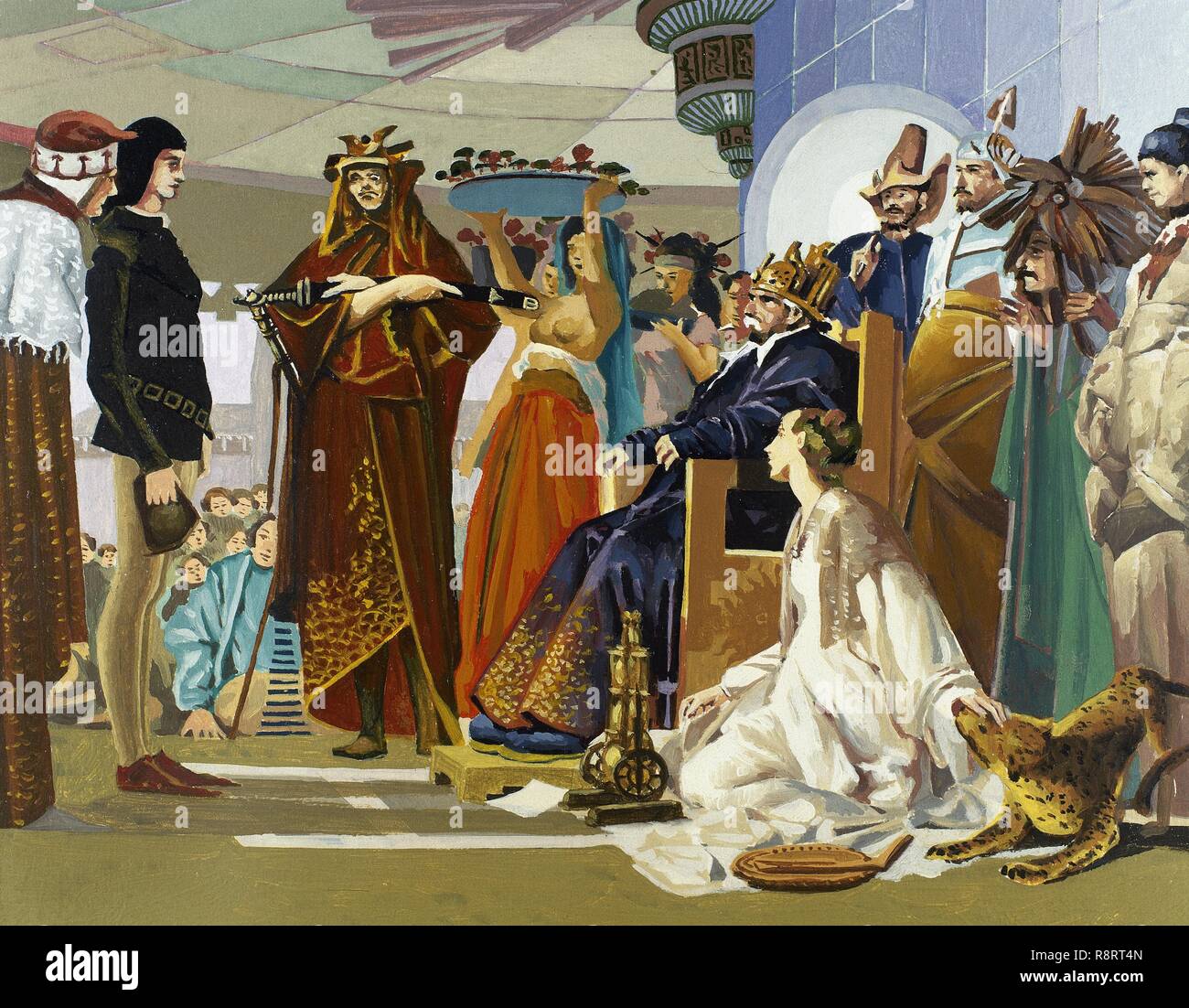 Marco Polo (1254-1324). Venetian merchant traveler. Marco Polo in the presence of Kublai Khan (Great Khan of the Mongol Empire and the first Chinese emperor of the Yuan Dynasty). Stock Photohttps://www.alamy.com/image-license-details/?v=1https://www.alamy.com/marco-polo-1254-1324-venetian-merchant-traveler-marco-polo-in-the-presence-of-kublai-khan-great-khan-of-the-mongol-empire-and-the-first-chinese-emperor-of-the-yuan-dynasty-image229175877.html
Marco Polo (1254-1324). Venetian merchant traveler. Marco Polo in the presence of Kublai Khan (Great Khan of the Mongol Empire and the first Chinese emperor of the Yuan Dynasty). Stock Photohttps://www.alamy.com/image-license-details/?v=1https://www.alamy.com/marco-polo-1254-1324-venetian-merchant-traveler-marco-polo-in-the-presence-of-kublai-khan-great-khan-of-the-mongol-empire-and-the-first-chinese-emperor-of-the-yuan-dynasty-image229175877.htmlRMR8RT4N–Marco Polo (1254-1324). Venetian merchant traveler. Marco Polo in the presence of Kublai Khan (Great Khan of the Mongol Empire and the first Chinese emperor of the Yuan Dynasty).
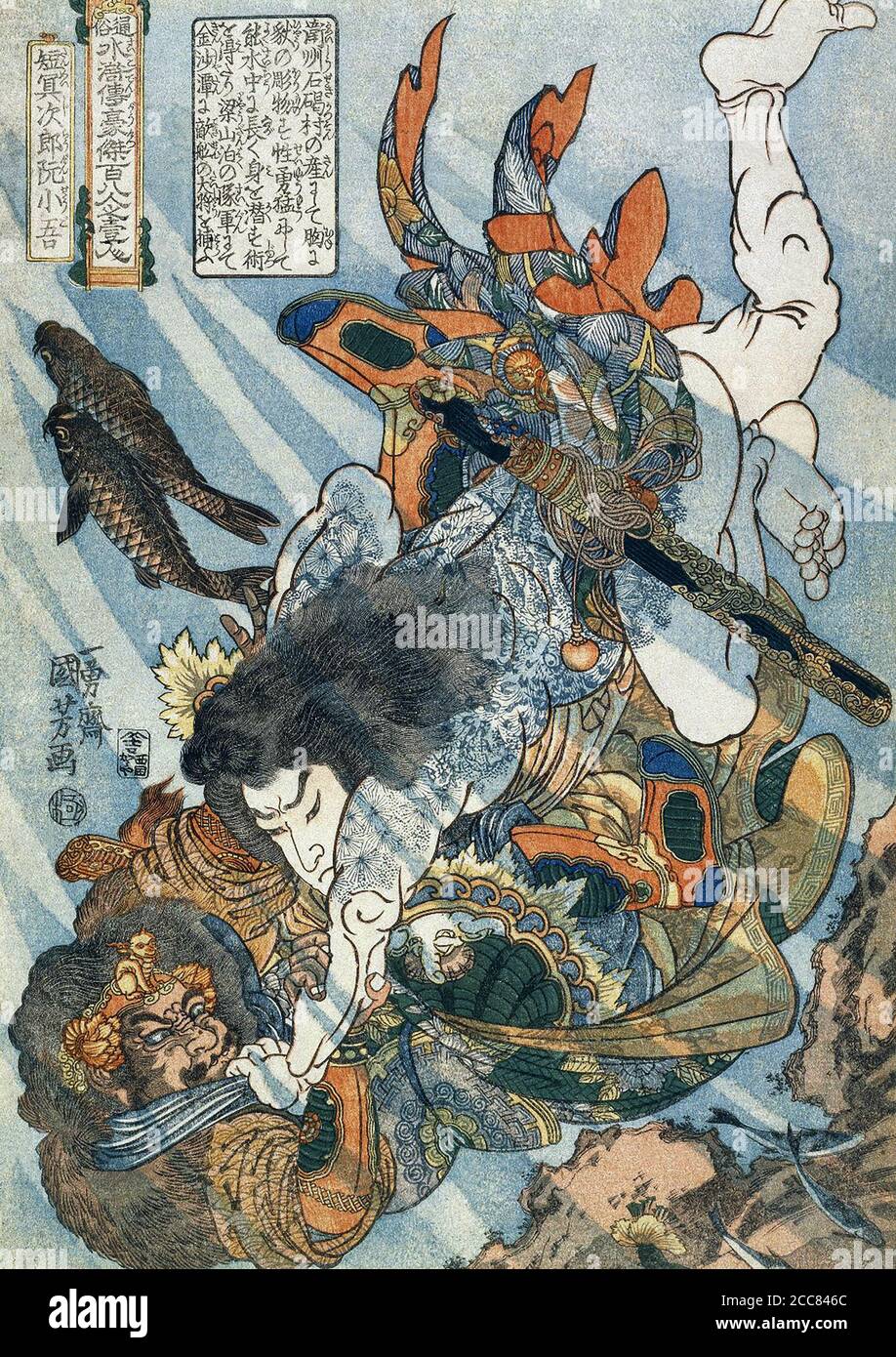 Japan: Ruan Xiaowu or Tanmeijiro Gen Shogo, one of the 'One Hundred and Eight Heroes of the Water Margin', fights an unarmed adversary underwater. Woodblock print by Utagawa Kuniyoshi (1797-1863), 1827-1830. The Water Margin (known in Chinese as Shuihu Zhuan, sometimes abbreviated to Shuihu, known as Suikoden in Japanese, as well as Outlaws of the Marsh, Tale of the Marshes, All Men Are Brothers, Men of the Marshes, or The Marshes of Mount Liang in English, is a 14th century novel and one of the Four Great Classical Novels of Chinese literature. Attributed to Shi Nai'an and written in vernacul Stock Photohttps://www.alamy.com/image-license-details/?v=1https://www.alamy.com/japan-ruan-xiaowu-or-tanmeijiro-gen-shogo-one-of-the-one-hundred-and-eight-heroes-of-the-water-margin-fights-an-unarmed-adversary-underwater-woodblock-print-by-utagawa-kuniyoshi-1797-1863-1827-1830-the-water-margin-known-in-chinese-as-shuihu-zhuan-sometimes-abbreviated-to-shuihu-known-as-suikoden-in-japanese-as-well-as-outlaws-of-the-marsh-tale-of-the-marshes-all-men-are-brothers-men-of-the-marshes-or-the-marshes-of-mount-liang-in-english-is-a-14th-century-novel-and-one-of-the-four-great-classical-novels-of-chinese-literature-attributed-to-shi-naian-and-written-in-vernacul-image368972532.html
Japan: Ruan Xiaowu or Tanmeijiro Gen Shogo, one of the 'One Hundred and Eight Heroes of the Water Margin', fights an unarmed adversary underwater. Woodblock print by Utagawa Kuniyoshi (1797-1863), 1827-1830. The Water Margin (known in Chinese as Shuihu Zhuan, sometimes abbreviated to Shuihu, known as Suikoden in Japanese, as well as Outlaws of the Marsh, Tale of the Marshes, All Men Are Brothers, Men of the Marshes, or The Marshes of Mount Liang in English, is a 14th century novel and one of the Four Great Classical Novels of Chinese literature. Attributed to Shi Nai'an and written in vernacul Stock Photohttps://www.alamy.com/image-license-details/?v=1https://www.alamy.com/japan-ruan-xiaowu-or-tanmeijiro-gen-shogo-one-of-the-one-hundred-and-eight-heroes-of-the-water-margin-fights-an-unarmed-adversary-underwater-woodblock-print-by-utagawa-kuniyoshi-1797-1863-1827-1830-the-water-margin-known-in-chinese-as-shuihu-zhuan-sometimes-abbreviated-to-shuihu-known-as-suikoden-in-japanese-as-well-as-outlaws-of-the-marsh-tale-of-the-marshes-all-men-are-brothers-men-of-the-marshes-or-the-marshes-of-mount-liang-in-english-is-a-14th-century-novel-and-one-of-the-four-great-classical-novels-of-chinese-literature-attributed-to-shi-naian-and-written-in-vernacul-image368972532.htmlRM2CC846C–Japan: Ruan Xiaowu or Tanmeijiro Gen Shogo, one of the 'One Hundred and Eight Heroes of the Water Margin', fights an unarmed adversary underwater. Woodblock print by Utagawa Kuniyoshi (1797-1863), 1827-1830. The Water Margin (known in Chinese as Shuihu Zhuan, sometimes abbreviated to Shuihu, known as Suikoden in Japanese, as well as Outlaws of the Marsh, Tale of the Marshes, All Men Are Brothers, Men of the Marshes, or The Marshes of Mount Liang in English, is a 14th century novel and one of the Four Great Classical Novels of Chinese literature. Attributed to Shi Nai'an and written in vernacul
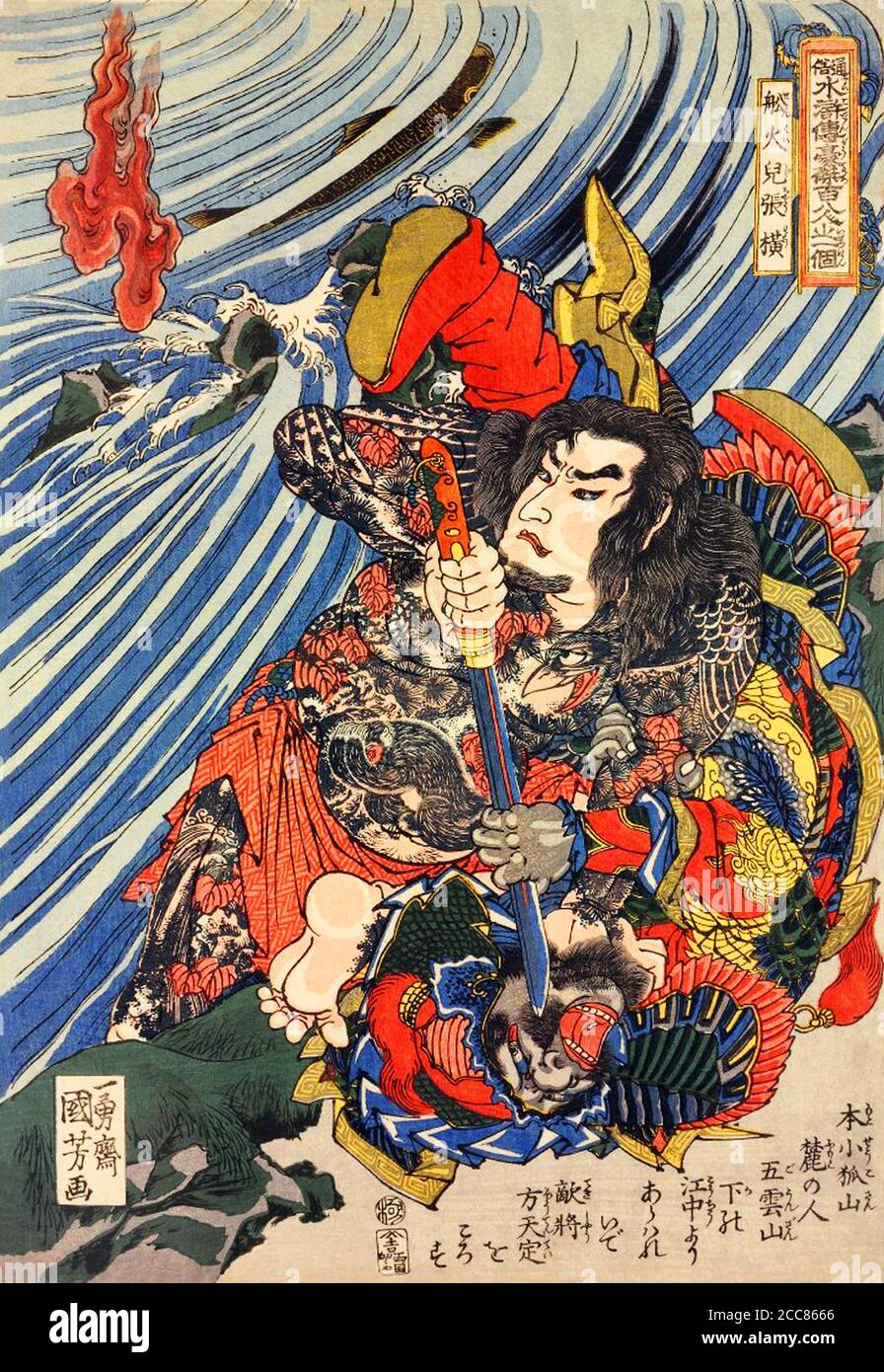 Japan: Zhang Heng or Senkaji Choo, one of the 'One Hundred and Eight Heroes of the Water Margin', stripped to reveal his full-body tattoos, about to kill the enemy general Hotentei with his sword, looks back at a supernatural flame appearing over the river behind him. Woodblock print by Utagawa Kuniyoshi (1797-1863), 1827-1830. The Water Margin (known in Chinese as Shuihu Zhuan, sometimes abbreviated to Shuihu, known as Suikoden in Japanese, as well as Outlaws of the Marsh, Tale of the Marshes, All Men Are Brothers, Men of the Marshes, or The Marshes of Mount Liang in English, is a 14th centur Stock Photohttps://www.alamy.com/image-license-details/?v=1https://www.alamy.com/japan-zhang-heng-or-senkaji-choo-one-of-the-one-hundred-and-eight-heroes-of-the-water-margin-stripped-to-reveal-his-full-body-tattoos-about-to-kill-the-enemy-general-hotentei-with-his-sword-looks-back-at-a-supernatural-flame-appearing-over-the-river-behind-him-woodblock-print-by-utagawa-kuniyoshi-1797-1863-1827-1830-the-water-margin-known-in-chinese-as-shuihu-zhuan-sometimes-abbreviated-to-shuihu-known-as-suikoden-in-japanese-as-well-as-outlaws-of-the-marsh-tale-of-the-marshes-all-men-are-brothers-men-of-the-marshes-or-the-marshes-of-mount-liang-in-english-is-a-14th-centur-image368974094.html
Japan: Zhang Heng or Senkaji Choo, one of the 'One Hundred and Eight Heroes of the Water Margin', stripped to reveal his full-body tattoos, about to kill the enemy general Hotentei with his sword, looks back at a supernatural flame appearing over the river behind him. Woodblock print by Utagawa Kuniyoshi (1797-1863), 1827-1830. The Water Margin (known in Chinese as Shuihu Zhuan, sometimes abbreviated to Shuihu, known as Suikoden in Japanese, as well as Outlaws of the Marsh, Tale of the Marshes, All Men Are Brothers, Men of the Marshes, or The Marshes of Mount Liang in English, is a 14th centur Stock Photohttps://www.alamy.com/image-license-details/?v=1https://www.alamy.com/japan-zhang-heng-or-senkaji-choo-one-of-the-one-hundred-and-eight-heroes-of-the-water-margin-stripped-to-reveal-his-full-body-tattoos-about-to-kill-the-enemy-general-hotentei-with-his-sword-looks-back-at-a-supernatural-flame-appearing-over-the-river-behind-him-woodblock-print-by-utagawa-kuniyoshi-1797-1863-1827-1830-the-water-margin-known-in-chinese-as-shuihu-zhuan-sometimes-abbreviated-to-shuihu-known-as-suikoden-in-japanese-as-well-as-outlaws-of-the-marsh-tale-of-the-marshes-all-men-are-brothers-men-of-the-marshes-or-the-marshes-of-mount-liang-in-english-is-a-14th-centur-image368974094.htmlRM2CC8666–Japan: Zhang Heng or Senkaji Choo, one of the 'One Hundred and Eight Heroes of the Water Margin', stripped to reveal his full-body tattoos, about to kill the enemy general Hotentei with his sword, looks back at a supernatural flame appearing over the river behind him. Woodblock print by Utagawa Kuniyoshi (1797-1863), 1827-1830. The Water Margin (known in Chinese as Shuihu Zhuan, sometimes abbreviated to Shuihu, known as Suikoden in Japanese, as well as Outlaws of the Marsh, Tale of the Marshes, All Men Are Brothers, Men of the Marshes, or The Marshes of Mount Liang in English, is a 14th centur
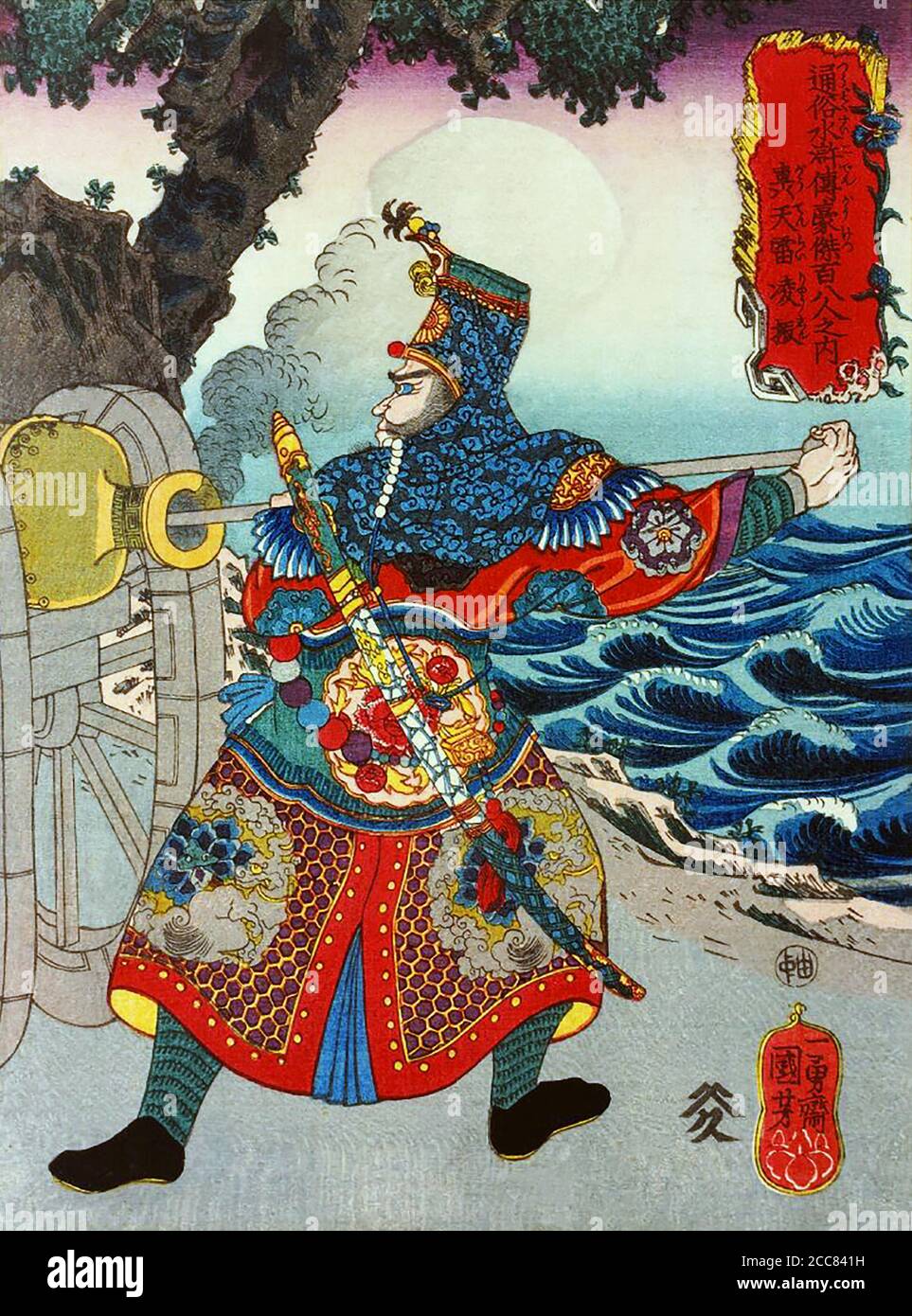 Japan: Heaven-shaking Thunder Ling Zhen or Kotenrai Ryoshin, one of the 'One Hundred and Eight Heroes of the Water Margin', on the shore loading a cannon, wearing a headdress. Woodblock print by Utagawa Kuniyoshi (1797-1863), 1827-1830. The Water Margin (known in Chinese as Shuihu Zhuan, sometimes abbreviated to Shuihu, known as Suikoden in Japanese, as well as Outlaws of the Marsh, Tale of the Marshes, All Men Are Brothers, Men of the Marshes, or The Marshes of Mount Liang in English, is a 14th century novel and one of the Four Great Classical Novels of Chinese literature. Attributed to Shi N Stock Photohttps://www.alamy.com/image-license-details/?v=1https://www.alamy.com/japan-heaven-shaking-thunder-ling-zhen-or-kotenrai-ryoshin-one-of-the-one-hundred-and-eight-heroes-of-the-water-margin-on-the-shore-loading-a-cannon-wearing-a-headdress-woodblock-print-by-utagawa-kuniyoshi-1797-1863-1827-1830-the-water-margin-known-in-chinese-as-shuihu-zhuan-sometimes-abbreviated-to-shuihu-known-as-suikoden-in-japanese-as-well-as-outlaws-of-the-marsh-tale-of-the-marshes-all-men-are-brothers-men-of-the-marshes-or-the-marshes-of-mount-liang-in-english-is-a-14th-century-novel-and-one-of-the-four-great-classical-novels-of-chinese-literature-attributed-to-shi-n-image368972397.html
Japan: Heaven-shaking Thunder Ling Zhen or Kotenrai Ryoshin, one of the 'One Hundred and Eight Heroes of the Water Margin', on the shore loading a cannon, wearing a headdress. Woodblock print by Utagawa Kuniyoshi (1797-1863), 1827-1830. The Water Margin (known in Chinese as Shuihu Zhuan, sometimes abbreviated to Shuihu, known as Suikoden in Japanese, as well as Outlaws of the Marsh, Tale of the Marshes, All Men Are Brothers, Men of the Marshes, or The Marshes of Mount Liang in English, is a 14th century novel and one of the Four Great Classical Novels of Chinese literature. Attributed to Shi N Stock Photohttps://www.alamy.com/image-license-details/?v=1https://www.alamy.com/japan-heaven-shaking-thunder-ling-zhen-or-kotenrai-ryoshin-one-of-the-one-hundred-and-eight-heroes-of-the-water-margin-on-the-shore-loading-a-cannon-wearing-a-headdress-woodblock-print-by-utagawa-kuniyoshi-1797-1863-1827-1830-the-water-margin-known-in-chinese-as-shuihu-zhuan-sometimes-abbreviated-to-shuihu-known-as-suikoden-in-japanese-as-well-as-outlaws-of-the-marsh-tale-of-the-marshes-all-men-are-brothers-men-of-the-marshes-or-the-marshes-of-mount-liang-in-english-is-a-14th-century-novel-and-one-of-the-four-great-classical-novels-of-chinese-literature-attributed-to-shi-n-image368972397.htmlRM2CC841H–Japan: Heaven-shaking Thunder Ling Zhen or Kotenrai Ryoshin, one of the 'One Hundred and Eight Heroes of the Water Margin', on the shore loading a cannon, wearing a headdress. Woodblock print by Utagawa Kuniyoshi (1797-1863), 1827-1830. The Water Margin (known in Chinese as Shuihu Zhuan, sometimes abbreviated to Shuihu, known as Suikoden in Japanese, as well as Outlaws of the Marsh, Tale of the Marshes, All Men Are Brothers, Men of the Marshes, or The Marshes of Mount Liang in English, is a 14th century novel and one of the Four Great Classical Novels of Chinese literature. Attributed to Shi N
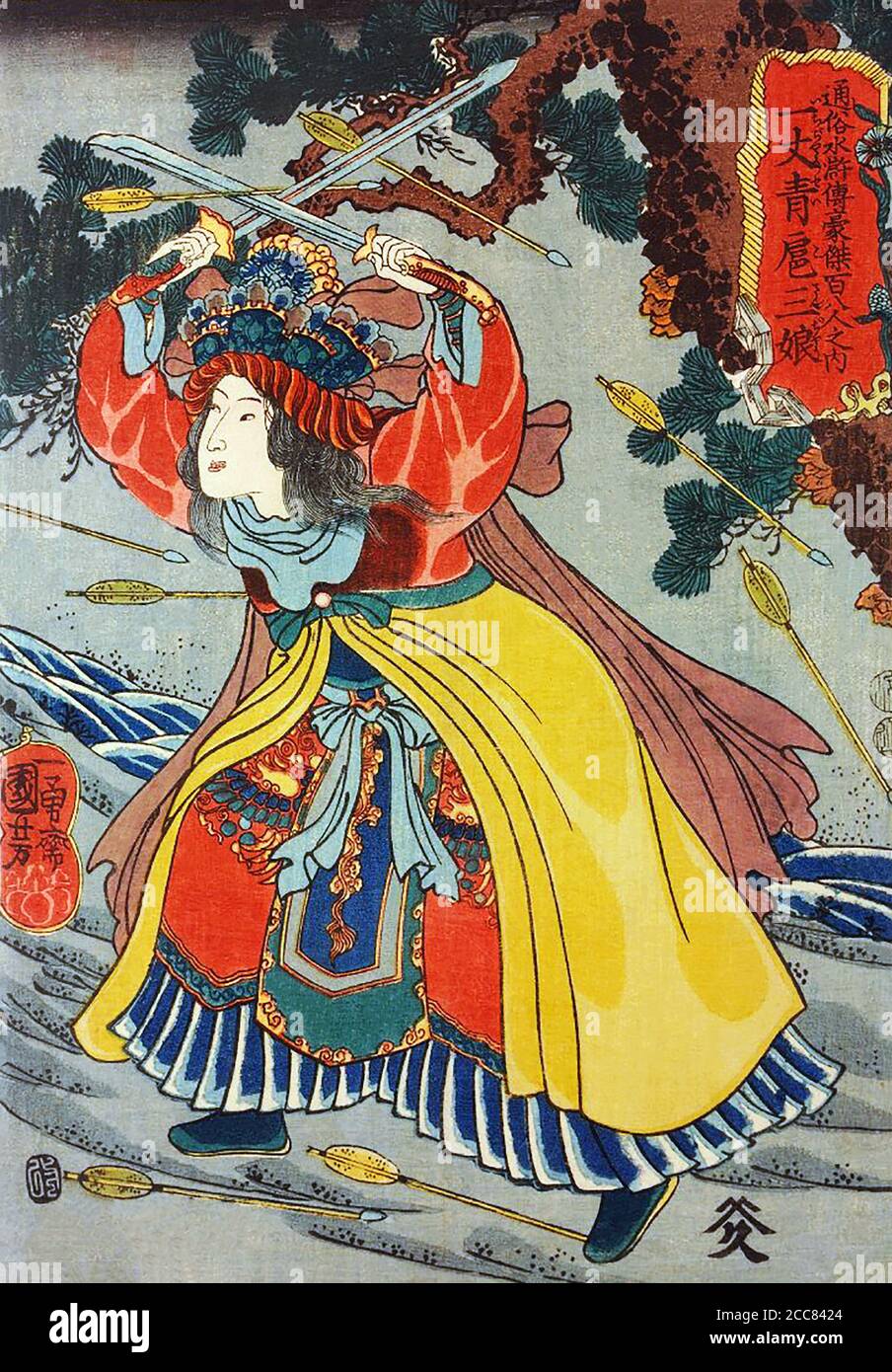 Japan: Ten Feet of Green Hu Sanniang or Ichijosei Kosanjo, one of the 'One Hundred and Eight Heroes of the Water Margin', using her two swords to block a hail of arrows coming towards her. Woodblock print by Utagawa Kuniyoshi (1797-1863), 1827-1830. The Water Margin (known in Chinese as Shuihu Zhuan, sometimes abbreviated to Shuihu, known as Suikoden in Japanese, as well as Outlaws of the Marsh, Tale of the Marshes, All Men Are Brothers, Men of the Marshes, or The Marshes of Mount Liang in English, is a 14th century novel and one of the Four Great Classical Novels of Chinese literature. Attrib Stock Photohttps://www.alamy.com/image-license-details/?v=1https://www.alamy.com/japan-ten-feet-of-green-hu-sanniang-or-ichijosei-kosanjo-one-of-the-one-hundred-and-eight-heroes-of-the-water-margin-using-her-two-swords-to-block-a-hail-of-arrows-coming-towards-her-woodblock-print-by-utagawa-kuniyoshi-1797-1863-1827-1830-the-water-margin-known-in-chinese-as-shuihu-zhuan-sometimes-abbreviated-to-shuihu-known-as-suikoden-in-japanese-as-well-as-outlaws-of-the-marsh-tale-of-the-marshes-all-men-are-brothers-men-of-the-marshes-or-the-marshes-of-mount-liang-in-english-is-a-14th-century-novel-and-one-of-the-four-great-classical-novels-of-chinese-literature-attrib-image368972412.html
Japan: Ten Feet of Green Hu Sanniang or Ichijosei Kosanjo, one of the 'One Hundred and Eight Heroes of the Water Margin', using her two swords to block a hail of arrows coming towards her. Woodblock print by Utagawa Kuniyoshi (1797-1863), 1827-1830. The Water Margin (known in Chinese as Shuihu Zhuan, sometimes abbreviated to Shuihu, known as Suikoden in Japanese, as well as Outlaws of the Marsh, Tale of the Marshes, All Men Are Brothers, Men of the Marshes, or The Marshes of Mount Liang in English, is a 14th century novel and one of the Four Great Classical Novels of Chinese literature. Attrib Stock Photohttps://www.alamy.com/image-license-details/?v=1https://www.alamy.com/japan-ten-feet-of-green-hu-sanniang-or-ichijosei-kosanjo-one-of-the-one-hundred-and-eight-heroes-of-the-water-margin-using-her-two-swords-to-block-a-hail-of-arrows-coming-towards-her-woodblock-print-by-utagawa-kuniyoshi-1797-1863-1827-1830-the-water-margin-known-in-chinese-as-shuihu-zhuan-sometimes-abbreviated-to-shuihu-known-as-suikoden-in-japanese-as-well-as-outlaws-of-the-marsh-tale-of-the-marshes-all-men-are-brothers-men-of-the-marshes-or-the-marshes-of-mount-liang-in-english-is-a-14th-century-novel-and-one-of-the-four-great-classical-novels-of-chinese-literature-attrib-image368972412.htmlRM2CC8424–Japan: Ten Feet of Green Hu Sanniang or Ichijosei Kosanjo, one of the 'One Hundred and Eight Heroes of the Water Margin', using her two swords to block a hail of arrows coming towards her. Woodblock print by Utagawa Kuniyoshi (1797-1863), 1827-1830. The Water Margin (known in Chinese as Shuihu Zhuan, sometimes abbreviated to Shuihu, known as Suikoden in Japanese, as well as Outlaws of the Marsh, Tale of the Marshes, All Men Are Brothers, Men of the Marshes, or The Marshes of Mount Liang in English, is a 14th century novel and one of the Four Great Classical Novels of Chinese literature. Attrib
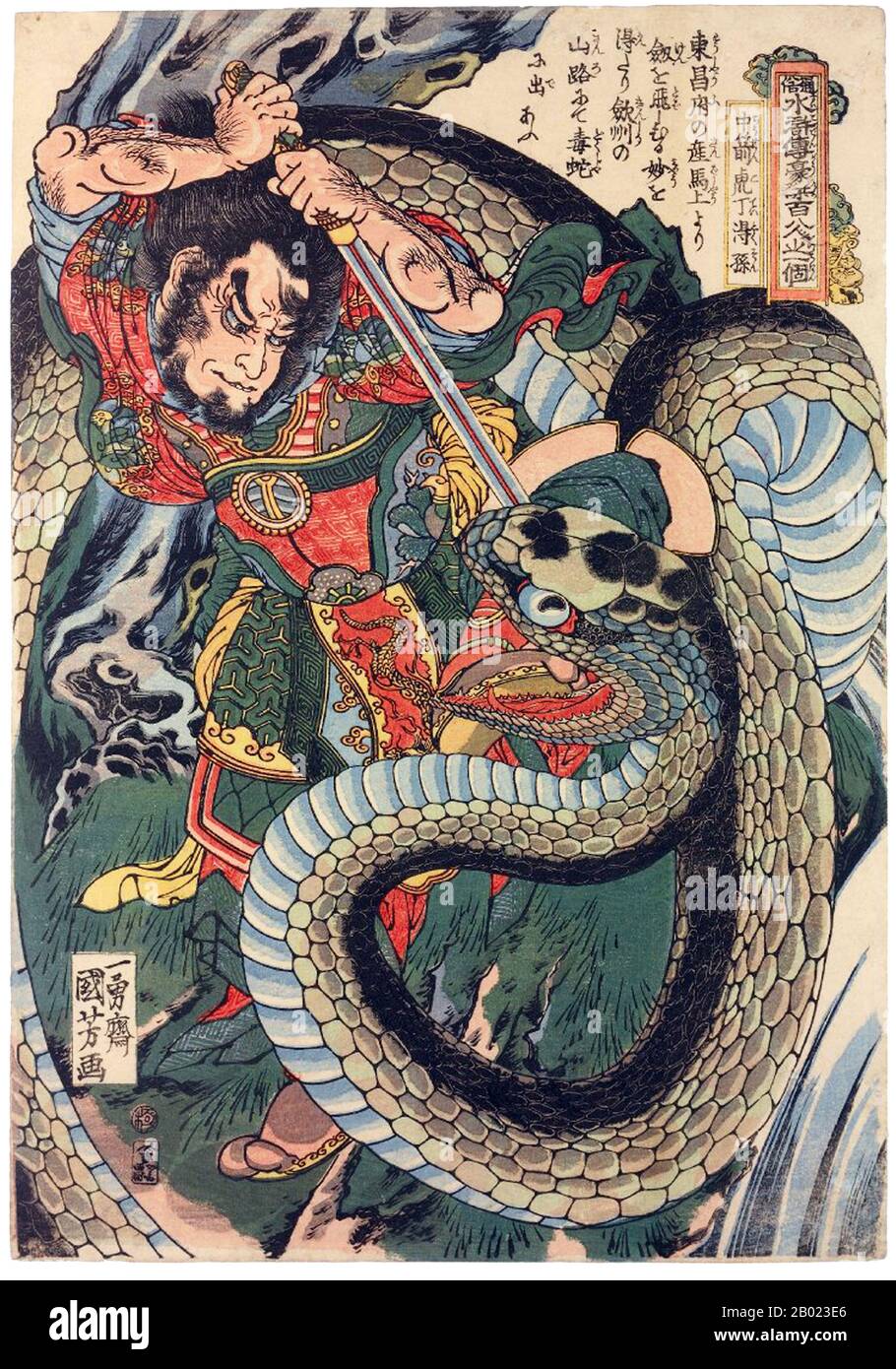 China/Japan: Ding Desun (Chusenko Tei Tokuson) using both hands to drive his sword into an enormous snake, one of the 'One Hundred and Eight Heroes of the Water Margin'. Ukiyo-e woodblock print by Utagawa Kuniyoshi (1797-1863), 1827-1830. Water Margin (known in Chinese as Shuihu Zhuan, sometimes abbreviated to Shuihu), also known as Suikoden in Japanese, as well as Outlaws of the Marsh, Tale of the Marshes, All Men Are Brothers, Men of the Marshes, or The Marshes of Mount Liang, is a 14th century novel and one of the Four Great Classical Novels of Chinese literature. Stock Photohttps://www.alamy.com/image-license-details/?v=1https://www.alamy.com/chinajapan-ding-desun-chusenko-tei-tokuson-using-both-hands-to-drive-his-sword-into-an-enormous-snake-one-of-the-one-hundred-and-eight-heroes-of-the-water-margin-ukiyo-e-woodblock-print-by-utagawa-kuniyoshi-1797-1863-1827-1830-water-margin-known-in-chinese-as-shuihu-zhuan-sometimes-abbreviated-to-shuihu-also-known-as-suikoden-in-japanese-as-well-as-outlaws-of-the-marsh-tale-of-the-marshes-all-men-are-brothers-men-of-the-marshes-or-the-marshes-of-mount-liang-is-a-14th-century-novel-and-one-of-the-four-great-classical-novels-of-chinese-literature-image344254014.html
China/Japan: Ding Desun (Chusenko Tei Tokuson) using both hands to drive his sword into an enormous snake, one of the 'One Hundred and Eight Heroes of the Water Margin'. Ukiyo-e woodblock print by Utagawa Kuniyoshi (1797-1863), 1827-1830. Water Margin (known in Chinese as Shuihu Zhuan, sometimes abbreviated to Shuihu), also known as Suikoden in Japanese, as well as Outlaws of the Marsh, Tale of the Marshes, All Men Are Brothers, Men of the Marshes, or The Marshes of Mount Liang, is a 14th century novel and one of the Four Great Classical Novels of Chinese literature. Stock Photohttps://www.alamy.com/image-license-details/?v=1https://www.alamy.com/chinajapan-ding-desun-chusenko-tei-tokuson-using-both-hands-to-drive-his-sword-into-an-enormous-snake-one-of-the-one-hundred-and-eight-heroes-of-the-water-margin-ukiyo-e-woodblock-print-by-utagawa-kuniyoshi-1797-1863-1827-1830-water-margin-known-in-chinese-as-shuihu-zhuan-sometimes-abbreviated-to-shuihu-also-known-as-suikoden-in-japanese-as-well-as-outlaws-of-the-marsh-tale-of-the-marshes-all-men-are-brothers-men-of-the-marshes-or-the-marshes-of-mount-liang-is-a-14th-century-novel-and-one-of-the-four-great-classical-novels-of-chinese-literature-image344254014.htmlRM2B023E6–China/Japan: Ding Desun (Chusenko Tei Tokuson) using both hands to drive his sword into an enormous snake, one of the 'One Hundred and Eight Heroes of the Water Margin'. Ukiyo-e woodblock print by Utagawa Kuniyoshi (1797-1863), 1827-1830. Water Margin (known in Chinese as Shuihu Zhuan, sometimes abbreviated to Shuihu), also known as Suikoden in Japanese, as well as Outlaws of the Marsh, Tale of the Marshes, All Men Are Brothers, Men of the Marshes, or The Marshes of Mount Liang, is a 14th century novel and one of the Four Great Classical Novels of Chinese literature.
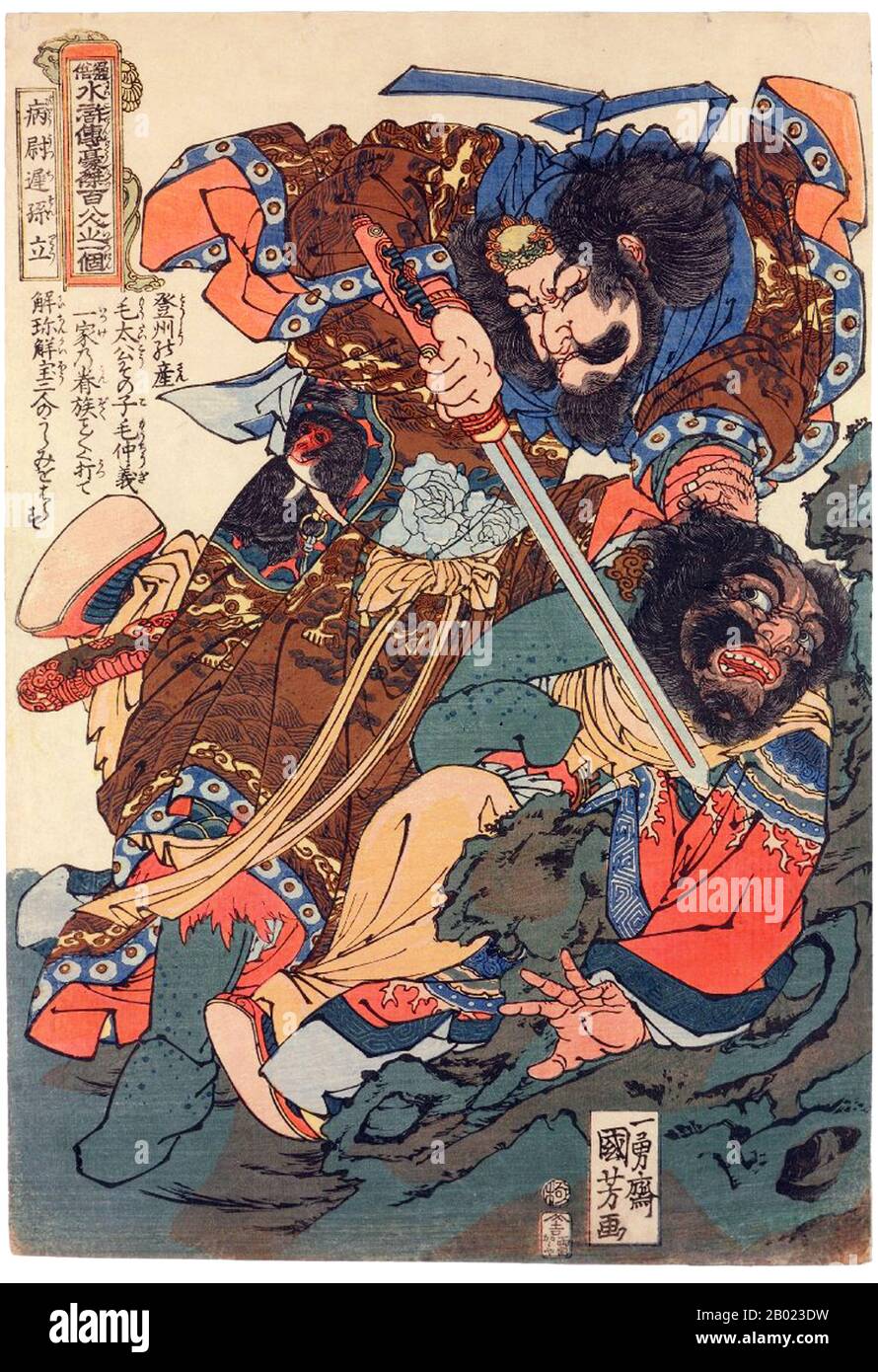 China/Japan: Sun Li (Byoutsuchi Sonritsu) about to slit the throat of his opponent with his sword, one of the 'One Hundred and Eight Heroes of the Water Margin'. Ukiyo-e woodblock print by Utagawa Kuniyoshi (1797-1863), 1827-1830. Water Margin (known in Chinese as Shuihu Zhuan, sometimes abbreviated to Shuihu), also known as Suikoden in Japanese, as well as Outlaws of the Marsh, Tale of the Marshes, All Men Are Brothers, Men of the Marshes, or The Marshes of Mount Liang, is a 14th century novel and one of the Four Great Classical Novels of Chinese literature. Stock Photohttps://www.alamy.com/image-license-details/?v=1https://www.alamy.com/chinajapan-sun-li-byoutsuchi-sonritsu-about-to-slit-the-throat-of-his-opponent-with-his-sword-one-of-the-one-hundred-and-eight-heroes-of-the-water-margin-ukiyo-e-woodblock-print-by-utagawa-kuniyoshi-1797-1863-1827-1830-water-margin-known-in-chinese-as-shuihu-zhuan-sometimes-abbreviated-to-shuihu-also-known-as-suikoden-in-japanese-as-well-as-outlaws-of-the-marsh-tale-of-the-marshes-all-men-are-brothers-men-of-the-marshes-or-the-marshes-of-mount-liang-is-a-14th-century-novel-and-one-of-the-four-great-classical-novels-of-chinese-literature-image344254005.html
China/Japan: Sun Li (Byoutsuchi Sonritsu) about to slit the throat of his opponent with his sword, one of the 'One Hundred and Eight Heroes of the Water Margin'. Ukiyo-e woodblock print by Utagawa Kuniyoshi (1797-1863), 1827-1830. Water Margin (known in Chinese as Shuihu Zhuan, sometimes abbreviated to Shuihu), also known as Suikoden in Japanese, as well as Outlaws of the Marsh, Tale of the Marshes, All Men Are Brothers, Men of the Marshes, or The Marshes of Mount Liang, is a 14th century novel and one of the Four Great Classical Novels of Chinese literature. Stock Photohttps://www.alamy.com/image-license-details/?v=1https://www.alamy.com/chinajapan-sun-li-byoutsuchi-sonritsu-about-to-slit-the-throat-of-his-opponent-with-his-sword-one-of-the-one-hundred-and-eight-heroes-of-the-water-margin-ukiyo-e-woodblock-print-by-utagawa-kuniyoshi-1797-1863-1827-1830-water-margin-known-in-chinese-as-shuihu-zhuan-sometimes-abbreviated-to-shuihu-also-known-as-suikoden-in-japanese-as-well-as-outlaws-of-the-marsh-tale-of-the-marshes-all-men-are-brothers-men-of-the-marshes-or-the-marshes-of-mount-liang-is-a-14th-century-novel-and-one-of-the-four-great-classical-novels-of-chinese-literature-image344254005.htmlRM2B023DW–China/Japan: Sun Li (Byoutsuchi Sonritsu) about to slit the throat of his opponent with his sword, one of the 'One Hundred and Eight Heroes of the Water Margin'. Ukiyo-e woodblock print by Utagawa Kuniyoshi (1797-1863), 1827-1830. Water Margin (known in Chinese as Shuihu Zhuan, sometimes abbreviated to Shuihu), also known as Suikoden in Japanese, as well as Outlaws of the Marsh, Tale of the Marshes, All Men Are Brothers, Men of the Marshes, or The Marshes of Mount Liang, is a 14th century novel and one of the Four Great Classical Novels of Chinese literature.
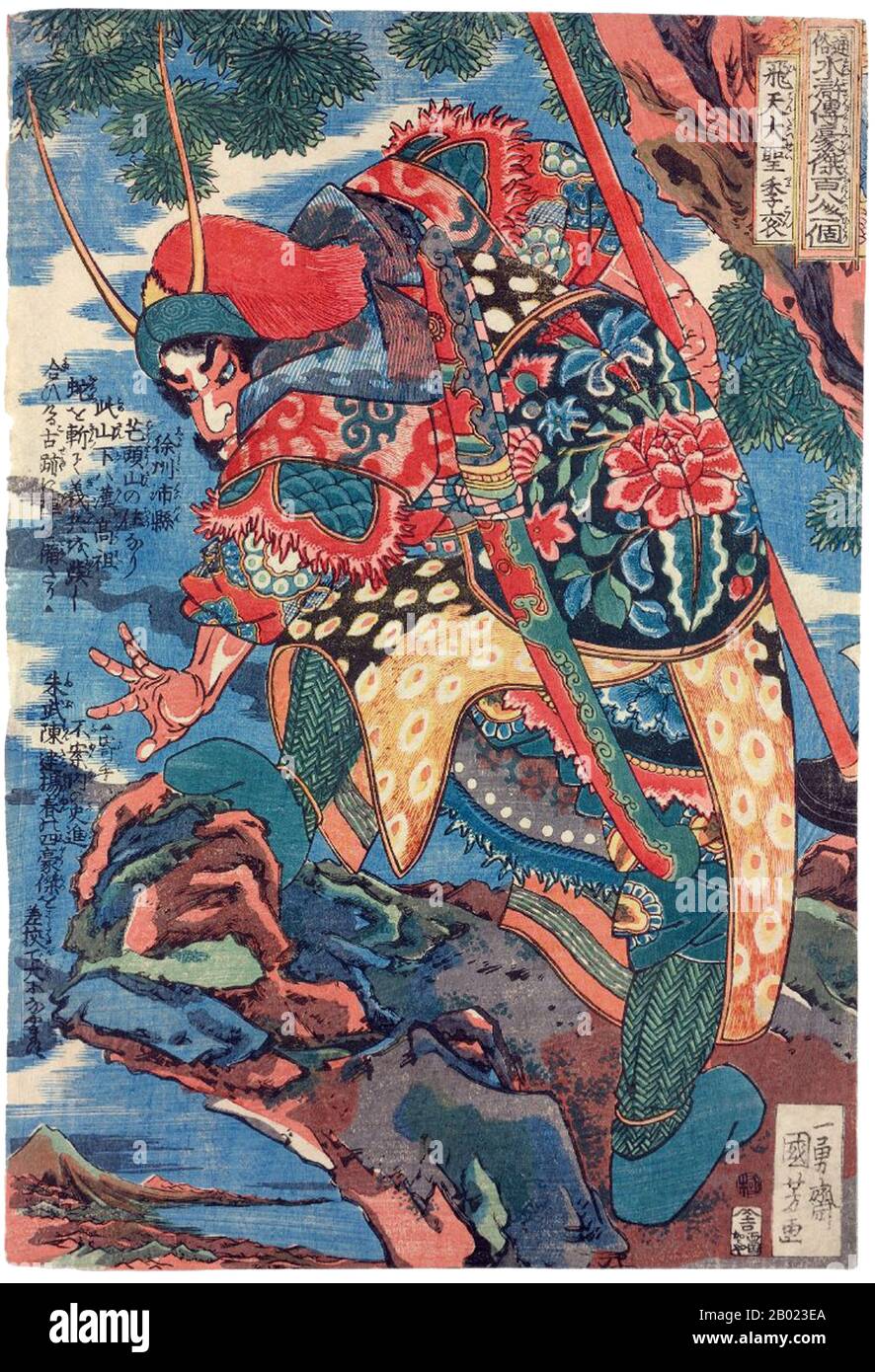 China/Japan: Li Gun (Hitentaisei Rikon) armed with a long pole and a sword, one of the 'One Hundred and Eight Heroes of the Water Margin'. Ukiyo-e woodblock print by Utagawa Kuniyoshi (1797-1863), 1827-1830. Water Margin (known in Chinese as Shuihu Zhuan, sometimes abbreviated to Shuihu), also known as Suikoden in Japanese, as well as Outlaws of the Marsh, Tale of the Marshes, All Men Are Brothers, Men of the Marshes, or The Marshes of Mount Liang, is a 14th century novel and one of the Four Great Classical Novels of Chinese literature. Stock Photohttps://www.alamy.com/image-license-details/?v=1https://www.alamy.com/chinajapan-li-gun-hitentaisei-rikon-armed-with-a-long-pole-and-a-sword-one-of-the-one-hundred-and-eight-heroes-of-the-water-margin-ukiyo-e-woodblock-print-by-utagawa-kuniyoshi-1797-1863-1827-1830-water-margin-known-in-chinese-as-shuihu-zhuan-sometimes-abbreviated-to-shuihu-also-known-as-suikoden-in-japanese-as-well-as-outlaws-of-the-marsh-tale-of-the-marshes-all-men-are-brothers-men-of-the-marshes-or-the-marshes-of-mount-liang-is-a-14th-century-novel-and-one-of-the-four-great-classical-novels-of-chinese-literature-image344254018.html
China/Japan: Li Gun (Hitentaisei Rikon) armed with a long pole and a sword, one of the 'One Hundred and Eight Heroes of the Water Margin'. Ukiyo-e woodblock print by Utagawa Kuniyoshi (1797-1863), 1827-1830. Water Margin (known in Chinese as Shuihu Zhuan, sometimes abbreviated to Shuihu), also known as Suikoden in Japanese, as well as Outlaws of the Marsh, Tale of the Marshes, All Men Are Brothers, Men of the Marshes, or The Marshes of Mount Liang, is a 14th century novel and one of the Four Great Classical Novels of Chinese literature. Stock Photohttps://www.alamy.com/image-license-details/?v=1https://www.alamy.com/chinajapan-li-gun-hitentaisei-rikon-armed-with-a-long-pole-and-a-sword-one-of-the-one-hundred-and-eight-heroes-of-the-water-margin-ukiyo-e-woodblock-print-by-utagawa-kuniyoshi-1797-1863-1827-1830-water-margin-known-in-chinese-as-shuihu-zhuan-sometimes-abbreviated-to-shuihu-also-known-as-suikoden-in-japanese-as-well-as-outlaws-of-the-marsh-tale-of-the-marshes-all-men-are-brothers-men-of-the-marshes-or-the-marshes-of-mount-liang-is-a-14th-century-novel-and-one-of-the-four-great-classical-novels-of-chinese-literature-image344254018.htmlRM2B023EA–China/Japan: Li Gun (Hitentaisei Rikon) armed with a long pole and a sword, one of the 'One Hundred and Eight Heroes of the Water Margin'. Ukiyo-e woodblock print by Utagawa Kuniyoshi (1797-1863), 1827-1830. Water Margin (known in Chinese as Shuihu Zhuan, sometimes abbreviated to Shuihu), also known as Suikoden in Japanese, as well as Outlaws of the Marsh, Tale of the Marshes, All Men Are Brothers, Men of the Marshes, or The Marshes of Mount Liang, is a 14th century novel and one of the Four Great Classical Novels of Chinese literature.
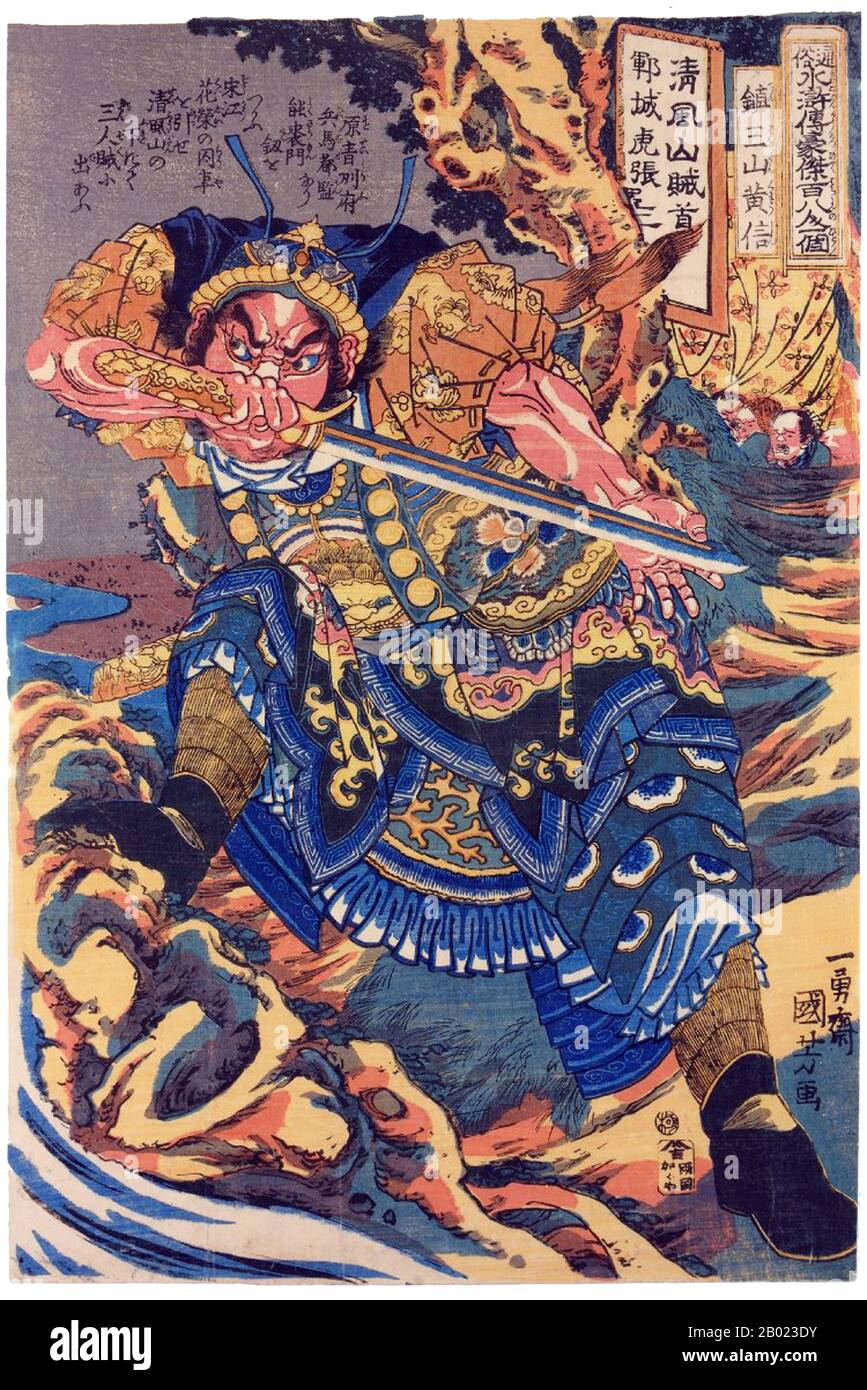 China/Japan: Huang Xin (Chinsanzan Koshin) standing beside a stream and testing the edge of his sword, one of the 'One Hundred and Eight Heroes of the Water Margin'. Ukiyo-e woodblock print by Utagawa Kuniyoshi (1797-1863), 1827-1830. Water Margin (known in Chinese as Shuihu Zhuan, sometimes abbreviated to Shuihu), also known as Suikoden in Japanese, as well as Outlaws of the Marsh, Tale of the Marshes, All Men Are Brothers, Men of the Marshes, or The Marshes of Mount Liang, is a 14th century novel and one of the Four Great Classical Novels of Chinese literature. Stock Photohttps://www.alamy.com/image-license-details/?v=1https://www.alamy.com/chinajapan-huang-xin-chinsanzan-koshin-standing-beside-a-stream-and-testing-the-edge-of-his-sword-one-of-the-one-hundred-and-eight-heroes-of-the-water-margin-ukiyo-e-woodblock-print-by-utagawa-kuniyoshi-1797-1863-1827-1830-water-margin-known-in-chinese-as-shuihu-zhuan-sometimes-abbreviated-to-shuihu-also-known-as-suikoden-in-japanese-as-well-as-outlaws-of-the-marsh-tale-of-the-marshes-all-men-are-brothers-men-of-the-marshes-or-the-marshes-of-mount-liang-is-a-14th-century-novel-and-one-of-the-four-great-classical-novels-of-chinese-literature-image344254007.html
China/Japan: Huang Xin (Chinsanzan Koshin) standing beside a stream and testing the edge of his sword, one of the 'One Hundred and Eight Heroes of the Water Margin'. Ukiyo-e woodblock print by Utagawa Kuniyoshi (1797-1863), 1827-1830. Water Margin (known in Chinese as Shuihu Zhuan, sometimes abbreviated to Shuihu), also known as Suikoden in Japanese, as well as Outlaws of the Marsh, Tale of the Marshes, All Men Are Brothers, Men of the Marshes, or The Marshes of Mount Liang, is a 14th century novel and one of the Four Great Classical Novels of Chinese literature. Stock Photohttps://www.alamy.com/image-license-details/?v=1https://www.alamy.com/chinajapan-huang-xin-chinsanzan-koshin-standing-beside-a-stream-and-testing-the-edge-of-his-sword-one-of-the-one-hundred-and-eight-heroes-of-the-water-margin-ukiyo-e-woodblock-print-by-utagawa-kuniyoshi-1797-1863-1827-1830-water-margin-known-in-chinese-as-shuihu-zhuan-sometimes-abbreviated-to-shuihu-also-known-as-suikoden-in-japanese-as-well-as-outlaws-of-the-marsh-tale-of-the-marshes-all-men-are-brothers-men-of-the-marshes-or-the-marshes-of-mount-liang-is-a-14th-century-novel-and-one-of-the-four-great-classical-novels-of-chinese-literature-image344254007.htmlRM2B023DY–China/Japan: Huang Xin (Chinsanzan Koshin) standing beside a stream and testing the edge of his sword, one of the 'One Hundred and Eight Heroes of the Water Margin'. Ukiyo-e woodblock print by Utagawa Kuniyoshi (1797-1863), 1827-1830. Water Margin (known in Chinese as Shuihu Zhuan, sometimes abbreviated to Shuihu), also known as Suikoden in Japanese, as well as Outlaws of the Marsh, Tale of the Marshes, All Men Are Brothers, Men of the Marshes, or The Marshes of Mount Liang, is a 14th century novel and one of the Four Great Classical Novels of Chinese literature.
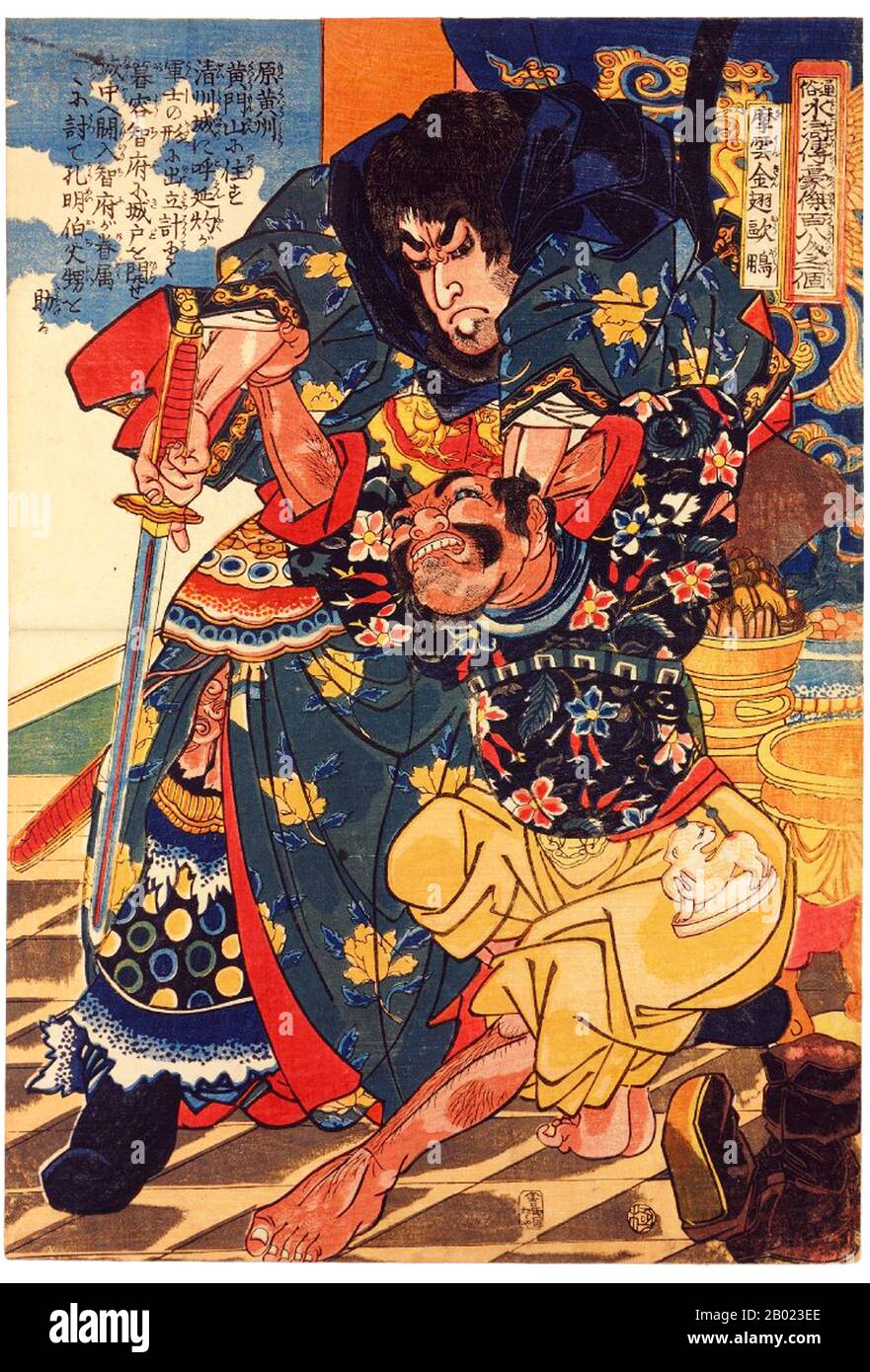 China/Japan: Lin Chong (Hyoshito Rinchu) grasps an enemy by the throat with a drawn sword in his other hand, one of the 'One Hundred and Eight Heroes of the Water Margin'. Ukiyo-e woodblock print by Utagawa Kuniyoshi (1797-1863), 1827-1830. Water Margin (known in Chinese as Shuihu Zhuan, sometimes abbreviated to Shuihu), also known as Suikoden in Japanese, as well as Outlaws of the Marsh, Tale of the Marshes, All Men Are Brothers, Men of the Marshes, or The Marshes of Mount Liang, is a 14th century novel and one of the Four Great Classical Novels of Chinese literature. Stock Photohttps://www.alamy.com/image-license-details/?v=1https://www.alamy.com/chinajapan-lin-chong-hyoshito-rinchu-grasps-an-enemy-by-the-throat-with-a-drawn-sword-in-his-other-hand-one-of-the-one-hundred-and-eight-heroes-of-the-water-margin-ukiyo-e-woodblock-print-by-utagawa-kuniyoshi-1797-1863-1827-1830-water-margin-known-in-chinese-as-shuihu-zhuan-sometimes-abbreviated-to-shuihu-also-known-as-suikoden-in-japanese-as-well-as-outlaws-of-the-marsh-tale-of-the-marshes-all-men-are-brothers-men-of-the-marshes-or-the-marshes-of-mount-liang-is-a-14th-century-novel-and-one-of-the-four-great-classical-novels-of-chinese-literature-image344254022.html
China/Japan: Lin Chong (Hyoshito Rinchu) grasps an enemy by the throat with a drawn sword in his other hand, one of the 'One Hundred and Eight Heroes of the Water Margin'. Ukiyo-e woodblock print by Utagawa Kuniyoshi (1797-1863), 1827-1830. Water Margin (known in Chinese as Shuihu Zhuan, sometimes abbreviated to Shuihu), also known as Suikoden in Japanese, as well as Outlaws of the Marsh, Tale of the Marshes, All Men Are Brothers, Men of the Marshes, or The Marshes of Mount Liang, is a 14th century novel and one of the Four Great Classical Novels of Chinese literature. Stock Photohttps://www.alamy.com/image-license-details/?v=1https://www.alamy.com/chinajapan-lin-chong-hyoshito-rinchu-grasps-an-enemy-by-the-throat-with-a-drawn-sword-in-his-other-hand-one-of-the-one-hundred-and-eight-heroes-of-the-water-margin-ukiyo-e-woodblock-print-by-utagawa-kuniyoshi-1797-1863-1827-1830-water-margin-known-in-chinese-as-shuihu-zhuan-sometimes-abbreviated-to-shuihu-also-known-as-suikoden-in-japanese-as-well-as-outlaws-of-the-marsh-tale-of-the-marshes-all-men-are-brothers-men-of-the-marshes-or-the-marshes-of-mount-liang-is-a-14th-century-novel-and-one-of-the-four-great-classical-novels-of-chinese-literature-image344254022.htmlRM2B023EE–China/Japan: Lin Chong (Hyoshito Rinchu) grasps an enemy by the throat with a drawn sword in his other hand, one of the 'One Hundred and Eight Heroes of the Water Margin'. Ukiyo-e woodblock print by Utagawa Kuniyoshi (1797-1863), 1827-1830. Water Margin (known in Chinese as Shuihu Zhuan, sometimes abbreviated to Shuihu), also known as Suikoden in Japanese, as well as Outlaws of the Marsh, Tale of the Marshes, All Men Are Brothers, Men of the Marshes, or The Marshes of Mount Liang, is a 14th century novel and one of the Four Great Classical Novels of Chinese literature.
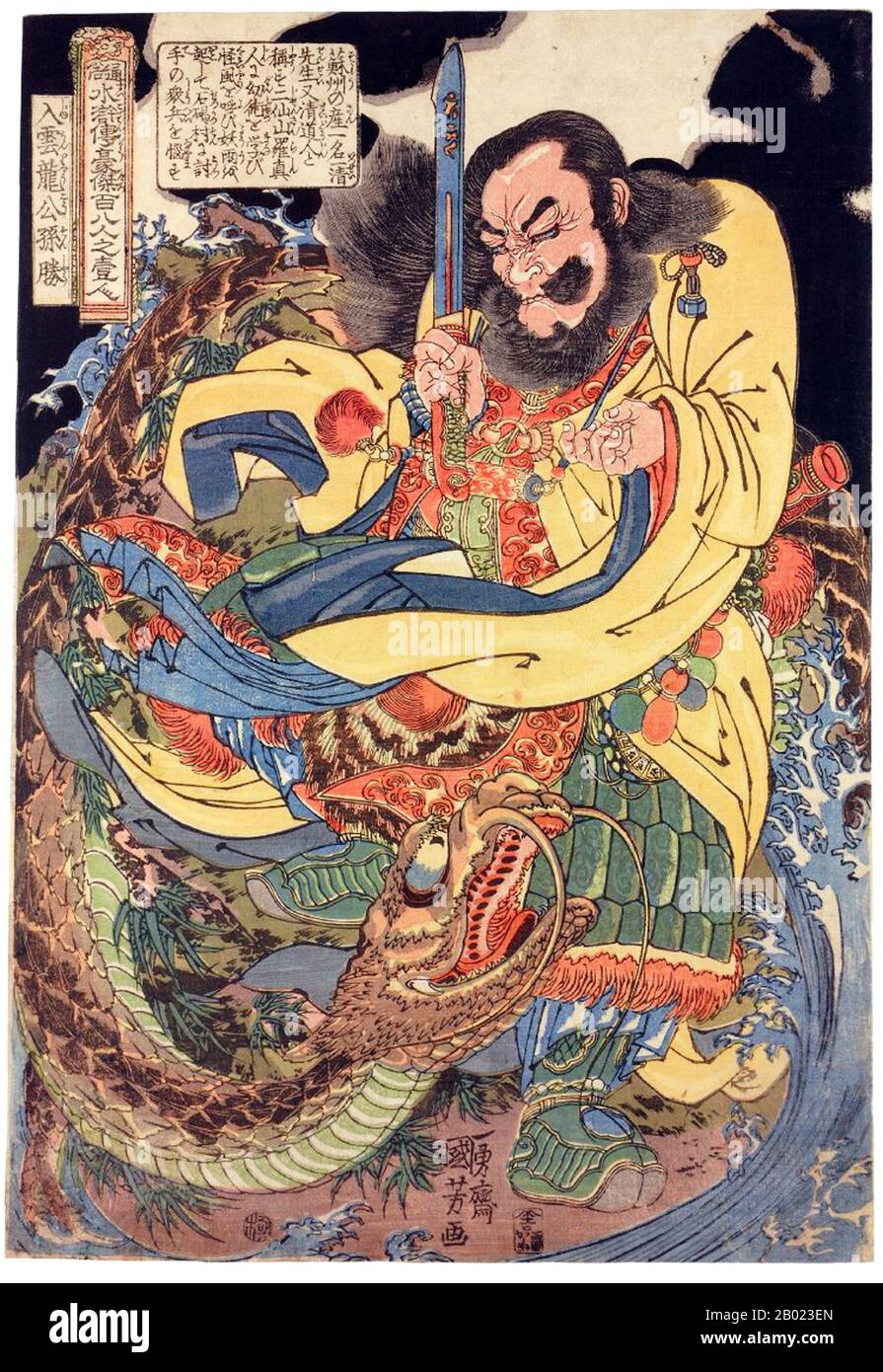 China/Japan: Gongsun Sheng (Nyuunryu Kosonsho) holding up a short sword and making a magical gesture with his other hand, one of the 'One Hundred and Eight Heroes of the Water Margin'. Ukiyo-e woodblock print by Utagawa Kuniyoshi (1797-1863), 1827-1830. Water Margin (known in Chinese as Shuihu Zhuan, sometimes abbreviated to Shuihu), also known as Suikoden in Japanese, as well as Outlaws of the Marsh, Tale of the Marshes, All Men Are Brothers, Men of the Marshes, or The Marshes of Mount Liang, is a 14th century novel and one of the Four Great Classical Novels of Chinese literature. Stock Photohttps://www.alamy.com/image-license-details/?v=1https://www.alamy.com/chinajapan-gongsun-sheng-nyuunryu-kosonsho-holding-up-a-short-sword-and-making-a-magical-gesture-with-his-other-hand-one-of-the-one-hundred-and-eight-heroes-of-the-water-margin-ukiyo-e-woodblock-print-by-utagawa-kuniyoshi-1797-1863-1827-1830-water-margin-known-in-chinese-as-shuihu-zhuan-sometimes-abbreviated-to-shuihu-also-known-as-suikoden-in-japanese-as-well-as-outlaws-of-the-marsh-tale-of-the-marshes-all-men-are-brothers-men-of-the-marshes-or-the-marshes-of-mount-liang-is-a-14th-century-novel-and-one-of-the-four-great-classical-novels-of-chinese-literature-image344254029.html
China/Japan: Gongsun Sheng (Nyuunryu Kosonsho) holding up a short sword and making a magical gesture with his other hand, one of the 'One Hundred and Eight Heroes of the Water Margin'. Ukiyo-e woodblock print by Utagawa Kuniyoshi (1797-1863), 1827-1830. Water Margin (known in Chinese as Shuihu Zhuan, sometimes abbreviated to Shuihu), also known as Suikoden in Japanese, as well as Outlaws of the Marsh, Tale of the Marshes, All Men Are Brothers, Men of the Marshes, or The Marshes of Mount Liang, is a 14th century novel and one of the Four Great Classical Novels of Chinese literature. Stock Photohttps://www.alamy.com/image-license-details/?v=1https://www.alamy.com/chinajapan-gongsun-sheng-nyuunryu-kosonsho-holding-up-a-short-sword-and-making-a-magical-gesture-with-his-other-hand-one-of-the-one-hundred-and-eight-heroes-of-the-water-margin-ukiyo-e-woodblock-print-by-utagawa-kuniyoshi-1797-1863-1827-1830-water-margin-known-in-chinese-as-shuihu-zhuan-sometimes-abbreviated-to-shuihu-also-known-as-suikoden-in-japanese-as-well-as-outlaws-of-the-marsh-tale-of-the-marshes-all-men-are-brothers-men-of-the-marshes-or-the-marshes-of-mount-liang-is-a-14th-century-novel-and-one-of-the-four-great-classical-novels-of-chinese-literature-image344254029.htmlRM2B023EN–China/Japan: Gongsun Sheng (Nyuunryu Kosonsho) holding up a short sword and making a magical gesture with his other hand, one of the 'One Hundred and Eight Heroes of the Water Margin'. Ukiyo-e woodblock print by Utagawa Kuniyoshi (1797-1863), 1827-1830. Water Margin (known in Chinese as Shuihu Zhuan, sometimes abbreviated to Shuihu), also known as Suikoden in Japanese, as well as Outlaws of the Marsh, Tale of the Marshes, All Men Are Brothers, Men of the Marshes, or The Marshes of Mount Liang, is a 14th century novel and one of the Four Great Classical Novels of Chinese literature.
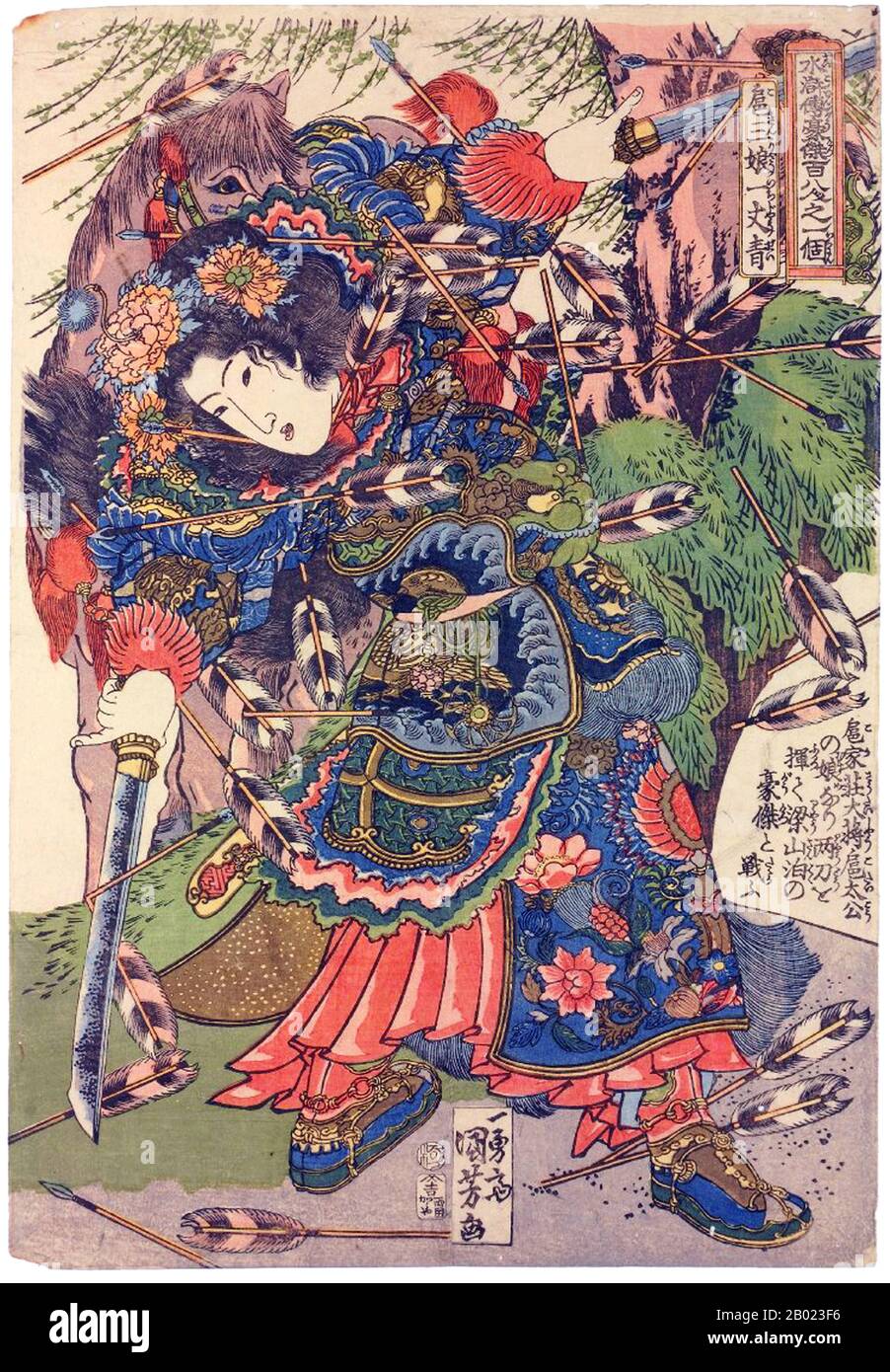 China/Japan: Hu San Niang (Ko Sanryo Ichijose), cutting flying arrows with a sword in either hand, one of the 'One Hundred and Eight Heroes of the Water Margin'. Ukiyo-e woodblock print by Utagawa Kuniyoshi (1797-1863), 1827-1830. Water Margin (known in Chinese as Shuihu Zhuan, sometimes abbreviated to Shuihu), also known as Suikoden in Japanese, as well as Outlaws of the Marsh, Tale of the Marshes, All Men Are Brothers, Men of the Marshes, or The Marshes of Mount Liang, is a 14th century novel and one of the Four Great Classical Novels of Chinese literature. Stock Photohttps://www.alamy.com/image-license-details/?v=1https://www.alamy.com/chinajapan-hu-san-niang-ko-sanryo-ichijose-cutting-flying-arrows-with-a-sword-in-either-hand-one-of-the-one-hundred-and-eight-heroes-of-the-water-margin-ukiyo-e-woodblock-print-by-utagawa-kuniyoshi-1797-1863-1827-1830-water-margin-known-in-chinese-as-shuihu-zhuan-sometimes-abbreviated-to-shuihu-also-known-as-suikoden-in-japanese-as-well-as-outlaws-of-the-marsh-tale-of-the-marshes-all-men-are-brothers-men-of-the-marshes-or-the-marshes-of-mount-liang-is-a-14th-century-novel-and-one-of-the-four-great-classical-novels-of-chinese-literature-image344254042.html
China/Japan: Hu San Niang (Ko Sanryo Ichijose), cutting flying arrows with a sword in either hand, one of the 'One Hundred and Eight Heroes of the Water Margin'. Ukiyo-e woodblock print by Utagawa Kuniyoshi (1797-1863), 1827-1830. Water Margin (known in Chinese as Shuihu Zhuan, sometimes abbreviated to Shuihu), also known as Suikoden in Japanese, as well as Outlaws of the Marsh, Tale of the Marshes, All Men Are Brothers, Men of the Marshes, or The Marshes of Mount Liang, is a 14th century novel and one of the Four Great Classical Novels of Chinese literature. Stock Photohttps://www.alamy.com/image-license-details/?v=1https://www.alamy.com/chinajapan-hu-san-niang-ko-sanryo-ichijose-cutting-flying-arrows-with-a-sword-in-either-hand-one-of-the-one-hundred-and-eight-heroes-of-the-water-margin-ukiyo-e-woodblock-print-by-utagawa-kuniyoshi-1797-1863-1827-1830-water-margin-known-in-chinese-as-shuihu-zhuan-sometimes-abbreviated-to-shuihu-also-known-as-suikoden-in-japanese-as-well-as-outlaws-of-the-marsh-tale-of-the-marshes-all-men-are-brothers-men-of-the-marshes-or-the-marshes-of-mount-liang-is-a-14th-century-novel-and-one-of-the-four-great-classical-novels-of-chinese-literature-image344254042.htmlRM2B023F6–China/Japan: Hu San Niang (Ko Sanryo Ichijose), cutting flying arrows with a sword in either hand, one of the 'One Hundred and Eight Heroes of the Water Margin'. Ukiyo-e woodblock print by Utagawa Kuniyoshi (1797-1863), 1827-1830. Water Margin (known in Chinese as Shuihu Zhuan, sometimes abbreviated to Shuihu), also known as Suikoden in Japanese, as well as Outlaws of the Marsh, Tale of the Marshes, All Men Are Brothers, Men of the Marshes, or The Marshes of Mount Liang, is a 14th century novel and one of the Four Great Classical Novels of Chinese literature.
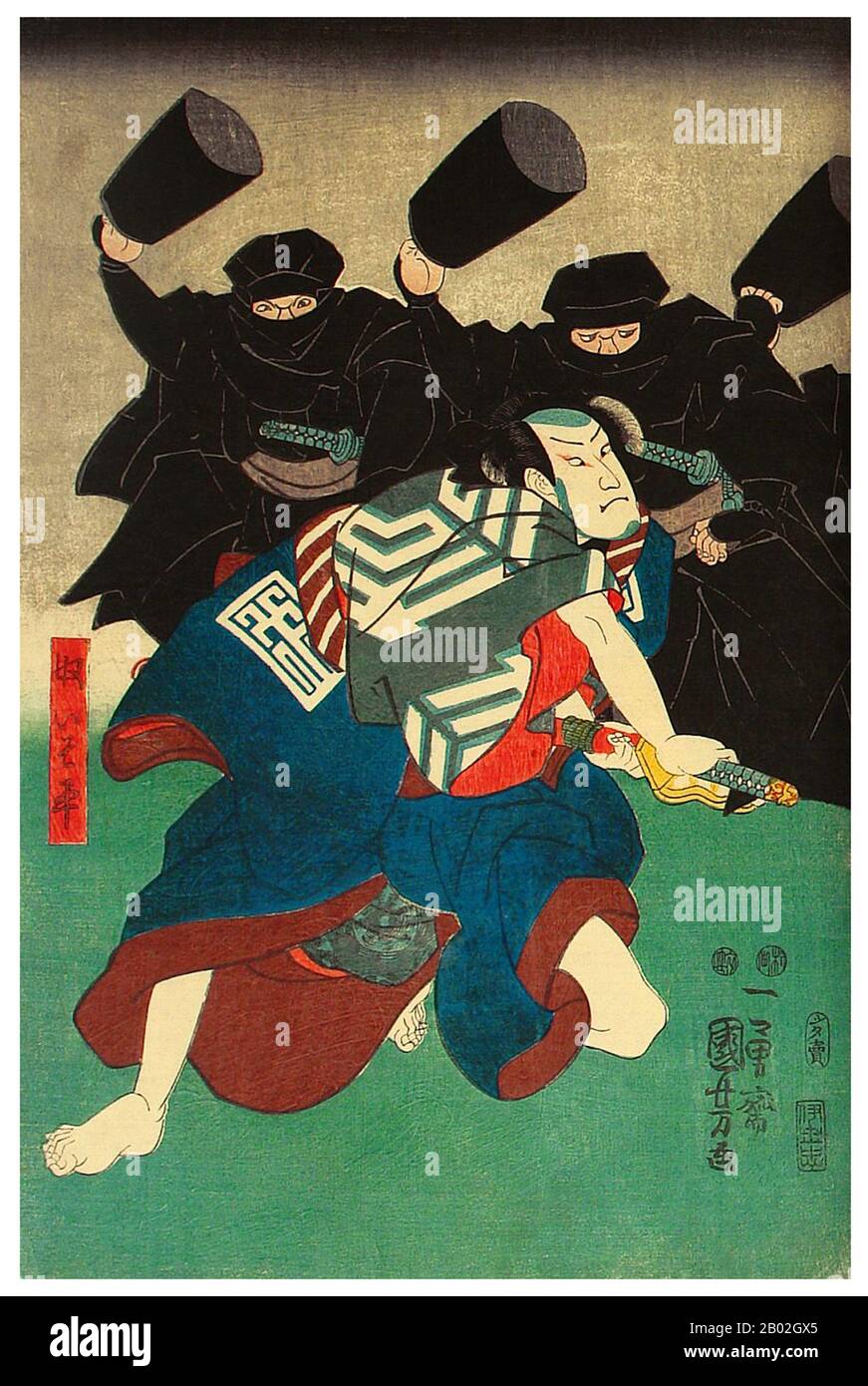 A ninja (忍者) or shinobi (忍び) was a covert agent or mercenary in feudal Japan who specialized in unorthodox warfare. The functions of the ninja included espionage, sabotage, infiltration, and assassination, and open combat in certain situations. Their covert methods of waging war contrasted the ninja with the samurai, who observed strict rules about honor and combat. The shinobi proper, a specially trained group of spies and mercenaries, appeared in the Sengoku or 'warring states' period, in the 15th century, but antecedents may have existed in the 14th century, and possibly even in the 12th c Stock Photohttps://www.alamy.com/image-license-details/?v=1https://www.alamy.com/a-ninja-or-shinobi-was-a-covert-agent-or-mercenary-in-feudal-japan-who-specialized-in-unorthodox-warfare-the-functions-of-the-ninja-included-espionage-sabotage-infiltration-and-assassination-and-open-combat-in-certain-situations-their-covert-methods-of-waging-war-contrasted-the-ninja-with-the-samurai-who-observed-strict-rules-about-honor-and-combat-the-shinobi-proper-a-specially-trained-group-of-spies-and-mercenaries-appeared-in-the-sengoku-or-warring-states-period-in-the-15th-century-but-antecedents-may-have-existed-in-the-14th-century-and-possibly-even-in-the-12th-c-image344264541.html
A ninja (忍者) or shinobi (忍び) was a covert agent or mercenary in feudal Japan who specialized in unorthodox warfare. The functions of the ninja included espionage, sabotage, infiltration, and assassination, and open combat in certain situations. Their covert methods of waging war contrasted the ninja with the samurai, who observed strict rules about honor and combat. The shinobi proper, a specially trained group of spies and mercenaries, appeared in the Sengoku or 'warring states' period, in the 15th century, but antecedents may have existed in the 14th century, and possibly even in the 12th c Stock Photohttps://www.alamy.com/image-license-details/?v=1https://www.alamy.com/a-ninja-or-shinobi-was-a-covert-agent-or-mercenary-in-feudal-japan-who-specialized-in-unorthodox-warfare-the-functions-of-the-ninja-included-espionage-sabotage-infiltration-and-assassination-and-open-combat-in-certain-situations-their-covert-methods-of-waging-war-contrasted-the-ninja-with-the-samurai-who-observed-strict-rules-about-honor-and-combat-the-shinobi-proper-a-specially-trained-group-of-spies-and-mercenaries-appeared-in-the-sengoku-or-warring-states-period-in-the-15th-century-but-antecedents-may-have-existed-in-the-14th-century-and-possibly-even-in-the-12th-c-image344264541.htmlRM2B02GX5–A ninja (忍者) or shinobi (忍び) was a covert agent or mercenary in feudal Japan who specialized in unorthodox warfare. The functions of the ninja included espionage, sabotage, infiltration, and assassination, and open combat in certain situations. Their covert methods of waging war contrasted the ninja with the samurai, who observed strict rules about honor and combat. The shinobi proper, a specially trained group of spies and mercenaries, appeared in the Sengoku or 'warring states' period, in the 15th century, but antecedents may have existed in the 14th century, and possibly even in the 12th c
 China / Japan: Yang Lin (Kinhyoshi Yorin), one of the 'One Hundred and Eight Heroes of the Water Margin' holding a sodegarami type of pole weapon. Woodblock print by Utagawa Kuniyoshi (1797-1863), 1827-1830. The Water Margin (known in Chinese as Shuihu Zhuan, sometimes abbreviated to Shuihu, known as Suikoden in Japanese, as well as Outlaws of the Marsh, Tale of the Marshes, All Men Are Brothers, Men of the Marshes, or The Marshes of Mount Liang in English, is a 14th century novel and one of the Four Great Classical Novels of Chinese literature. Attributed to Shi Nai'an and written in vernacul Stock Photohttps://www.alamy.com/image-license-details/?v=1https://www.alamy.com/china-japan-yang-lin-kinhyoshi-yorin-one-of-the-one-hundred-and-eight-heroes-of-the-water-margin-holding-a-sodegarami-type-of-pole-weapon-woodblock-print-by-utagawa-kuniyoshi-1797-1863-1827-1830-the-water-margin-known-in-chinese-as-shuihu-zhuan-sometimes-abbreviated-to-shuihu-known-as-suikoden-in-japanese-as-well-as-outlaws-of-the-marsh-tale-of-the-marshes-all-men-are-brothers-men-of-the-marshes-or-the-marshes-of-mount-liang-in-english-is-a-14th-century-novel-and-one-of-the-four-great-classical-novels-of-chinese-literature-attributed-to-shi-naian-and-written-in-vernacul-image368972630.html
China / Japan: Yang Lin (Kinhyoshi Yorin), one of the 'One Hundred and Eight Heroes of the Water Margin' holding a sodegarami type of pole weapon. Woodblock print by Utagawa Kuniyoshi (1797-1863), 1827-1830. The Water Margin (known in Chinese as Shuihu Zhuan, sometimes abbreviated to Shuihu, known as Suikoden in Japanese, as well as Outlaws of the Marsh, Tale of the Marshes, All Men Are Brothers, Men of the Marshes, or The Marshes of Mount Liang in English, is a 14th century novel and one of the Four Great Classical Novels of Chinese literature. Attributed to Shi Nai'an and written in vernacul Stock Photohttps://www.alamy.com/image-license-details/?v=1https://www.alamy.com/china-japan-yang-lin-kinhyoshi-yorin-one-of-the-one-hundred-and-eight-heroes-of-the-water-margin-holding-a-sodegarami-type-of-pole-weapon-woodblock-print-by-utagawa-kuniyoshi-1797-1863-1827-1830-the-water-margin-known-in-chinese-as-shuihu-zhuan-sometimes-abbreviated-to-shuihu-known-as-suikoden-in-japanese-as-well-as-outlaws-of-the-marsh-tale-of-the-marshes-all-men-are-brothers-men-of-the-marshes-or-the-marshes-of-mount-liang-in-english-is-a-14th-century-novel-and-one-of-the-four-great-classical-novels-of-chinese-literature-attributed-to-shi-naian-and-written-in-vernacul-image368972630.htmlRM2CC849X–China / Japan: Yang Lin (Kinhyoshi Yorin), one of the 'One Hundred and Eight Heroes of the Water Margin' holding a sodegarami type of pole weapon. Woodblock print by Utagawa Kuniyoshi (1797-1863), 1827-1830. The Water Margin (known in Chinese as Shuihu Zhuan, sometimes abbreviated to Shuihu, known as Suikoden in Japanese, as well as Outlaws of the Marsh, Tale of the Marshes, All Men Are Brothers, Men of the Marshes, or The Marshes of Mount Liang in English, is a 14th century novel and one of the Four Great Classical Novels of Chinese literature. Attributed to Shi Nai'an and written in vernacul
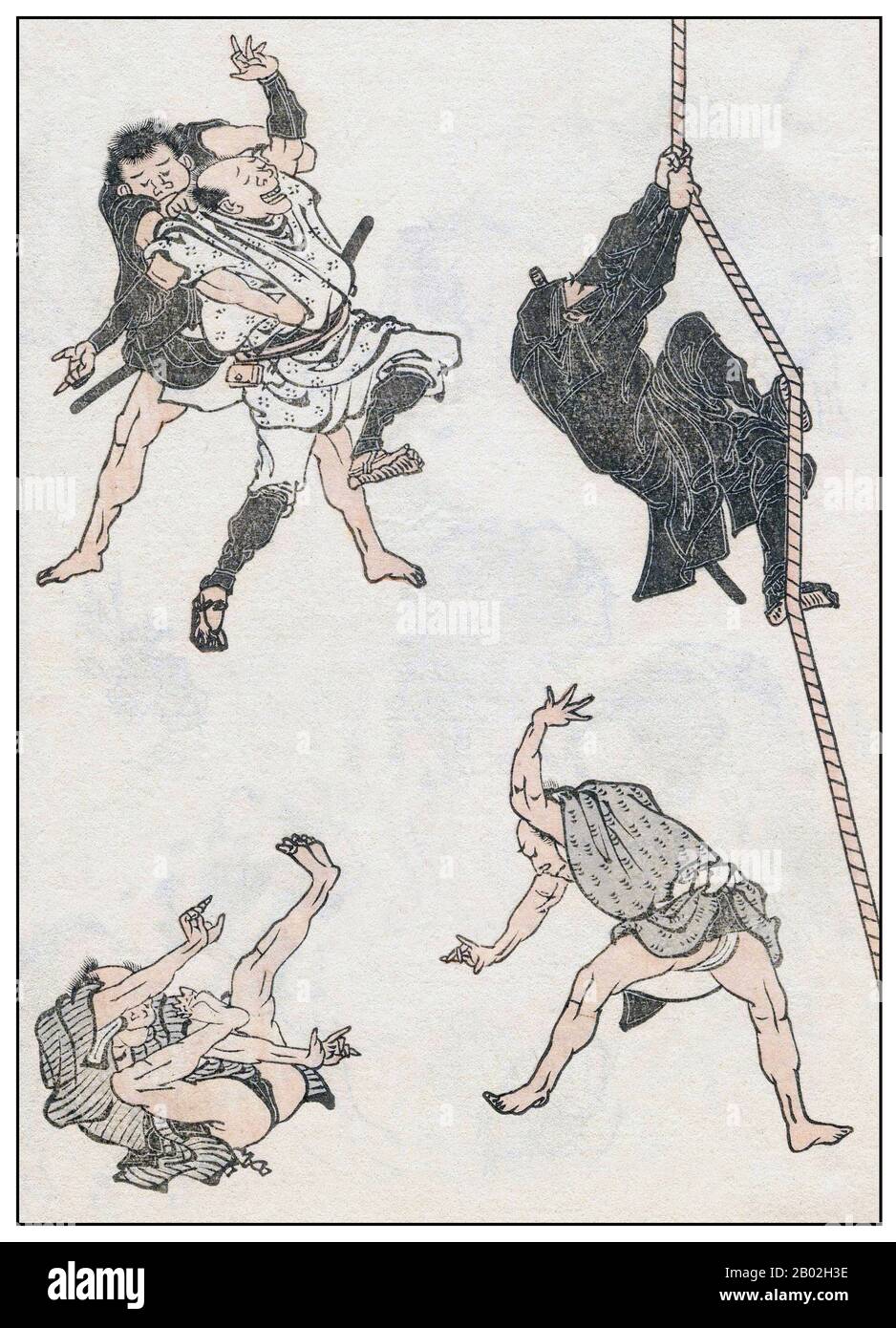 A ninja (忍者) or shinobi (忍び) was a covert agent or mercenary in feudal Japan who specialized in unorthodox warfare. The functions of the ninja included espionage, sabotage, infiltration, and assassination, and open combat in certain situations. Their covert methods of waging war contrasted the ninja with the samurai, who observed strict rules about honor and combat. The shinobi proper, a specially trained group of spies and mercenaries, appeared in the Sengoku or 'warring states' period, in the 15th century, but antecedents may have existed in the 14th century, and possibly even in the 12th c Stock Photohttps://www.alamy.com/image-license-details/?v=1https://www.alamy.com/a-ninja-or-shinobi-was-a-covert-agent-or-mercenary-in-feudal-japan-who-specialized-in-unorthodox-warfare-the-functions-of-the-ninja-included-espionage-sabotage-infiltration-and-assassination-and-open-combat-in-certain-situations-their-covert-methods-of-waging-war-contrasted-the-ninja-with-the-samurai-who-observed-strict-rules-about-honor-and-combat-the-shinobi-proper-a-specially-trained-group-of-spies-and-mercenaries-appeared-in-the-sengoku-or-warring-states-period-in-the-15th-century-but-antecedents-may-have-existed-in-the-14th-century-and-possibly-even-in-the-12th-c-image344264690.html
A ninja (忍者) or shinobi (忍び) was a covert agent or mercenary in feudal Japan who specialized in unorthodox warfare. The functions of the ninja included espionage, sabotage, infiltration, and assassination, and open combat in certain situations. Their covert methods of waging war contrasted the ninja with the samurai, who observed strict rules about honor and combat. The shinobi proper, a specially trained group of spies and mercenaries, appeared in the Sengoku or 'warring states' period, in the 15th century, but antecedents may have existed in the 14th century, and possibly even in the 12th c Stock Photohttps://www.alamy.com/image-license-details/?v=1https://www.alamy.com/a-ninja-or-shinobi-was-a-covert-agent-or-mercenary-in-feudal-japan-who-specialized-in-unorthodox-warfare-the-functions-of-the-ninja-included-espionage-sabotage-infiltration-and-assassination-and-open-combat-in-certain-situations-their-covert-methods-of-waging-war-contrasted-the-ninja-with-the-samurai-who-observed-strict-rules-about-honor-and-combat-the-shinobi-proper-a-specially-trained-group-of-spies-and-mercenaries-appeared-in-the-sengoku-or-warring-states-period-in-the-15th-century-but-antecedents-may-have-existed-in-the-14th-century-and-possibly-even-in-the-12th-c-image344264690.htmlRM2B02H3E–A ninja (忍者) or shinobi (忍び) was a covert agent or mercenary in feudal Japan who specialized in unorthodox warfare. The functions of the ninja included espionage, sabotage, infiltration, and assassination, and open combat in certain situations. Their covert methods of waging war contrasted the ninja with the samurai, who observed strict rules about honor and combat. The shinobi proper, a specially trained group of spies and mercenaries, appeared in the Sengoku or 'warring states' period, in the 15th century, but antecedents may have existed in the 14th century, and possibly even in the 12th c
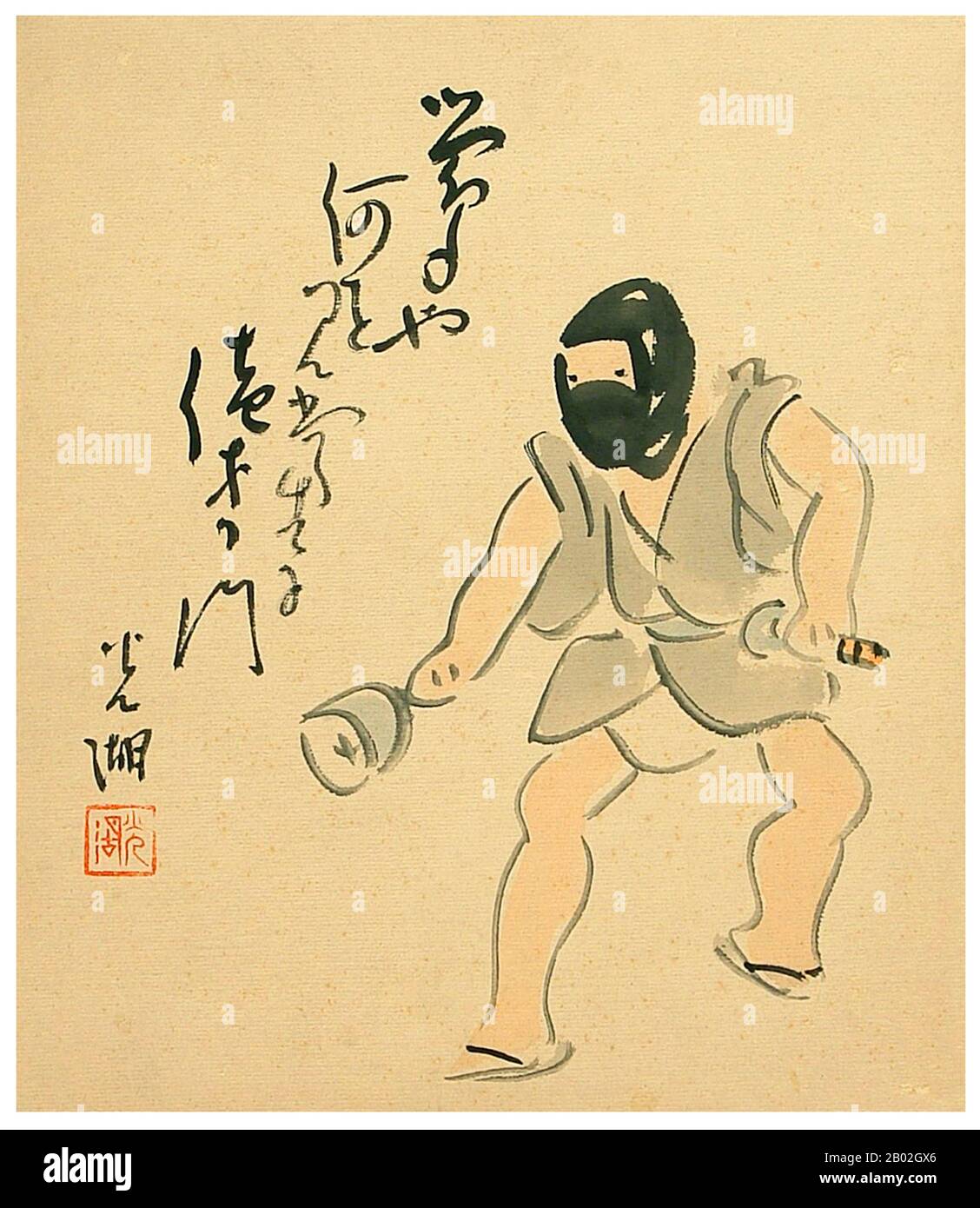 A ninja (忍者) or shinobi (忍び) was a covert agent or mercenary in feudal Japan who specialized in unorthodox warfare. The functions of the ninja included espionage, sabotage, infiltration, and assassination, and open combat in certain situations. Their covert methods of waging war contrasted the ninja with the samurai, who observed strict rules about honor and combat. The shinobi proper, a specially trained group of spies and mercenaries, appeared in the Sengoku or 'warring states' period, in the 15th century, but antecedents may have existed in the 14th century, and possibly even in the 12th c Stock Photohttps://www.alamy.com/image-license-details/?v=1https://www.alamy.com/a-ninja-or-shinobi-was-a-covert-agent-or-mercenary-in-feudal-japan-who-specialized-in-unorthodox-warfare-the-functions-of-the-ninja-included-espionage-sabotage-infiltration-and-assassination-and-open-combat-in-certain-situations-their-covert-methods-of-waging-war-contrasted-the-ninja-with-the-samurai-who-observed-strict-rules-about-honor-and-combat-the-shinobi-proper-a-specially-trained-group-of-spies-and-mercenaries-appeared-in-the-sengoku-or-warring-states-period-in-the-15th-century-but-antecedents-may-have-existed-in-the-14th-century-and-possibly-even-in-the-12th-c-image344264542.html
A ninja (忍者) or shinobi (忍び) was a covert agent or mercenary in feudal Japan who specialized in unorthodox warfare. The functions of the ninja included espionage, sabotage, infiltration, and assassination, and open combat in certain situations. Their covert methods of waging war contrasted the ninja with the samurai, who observed strict rules about honor and combat. The shinobi proper, a specially trained group of spies and mercenaries, appeared in the Sengoku or 'warring states' period, in the 15th century, but antecedents may have existed in the 14th century, and possibly even in the 12th c Stock Photohttps://www.alamy.com/image-license-details/?v=1https://www.alamy.com/a-ninja-or-shinobi-was-a-covert-agent-or-mercenary-in-feudal-japan-who-specialized-in-unorthodox-warfare-the-functions-of-the-ninja-included-espionage-sabotage-infiltration-and-assassination-and-open-combat-in-certain-situations-their-covert-methods-of-waging-war-contrasted-the-ninja-with-the-samurai-who-observed-strict-rules-about-honor-and-combat-the-shinobi-proper-a-specially-trained-group-of-spies-and-mercenaries-appeared-in-the-sengoku-or-warring-states-period-in-the-15th-century-but-antecedents-may-have-existed-in-the-14th-century-and-possibly-even-in-the-12th-c-image344264542.htmlRM2B02GX6–A ninja (忍者) or shinobi (忍び) was a covert agent or mercenary in feudal Japan who specialized in unorthodox warfare. The functions of the ninja included espionage, sabotage, infiltration, and assassination, and open combat in certain situations. Their covert methods of waging war contrasted the ninja with the samurai, who observed strict rules about honor and combat. The shinobi proper, a specially trained group of spies and mercenaries, appeared in the Sengoku or 'warring states' period, in the 15th century, but antecedents may have existed in the 14th century, and possibly even in the 12th c
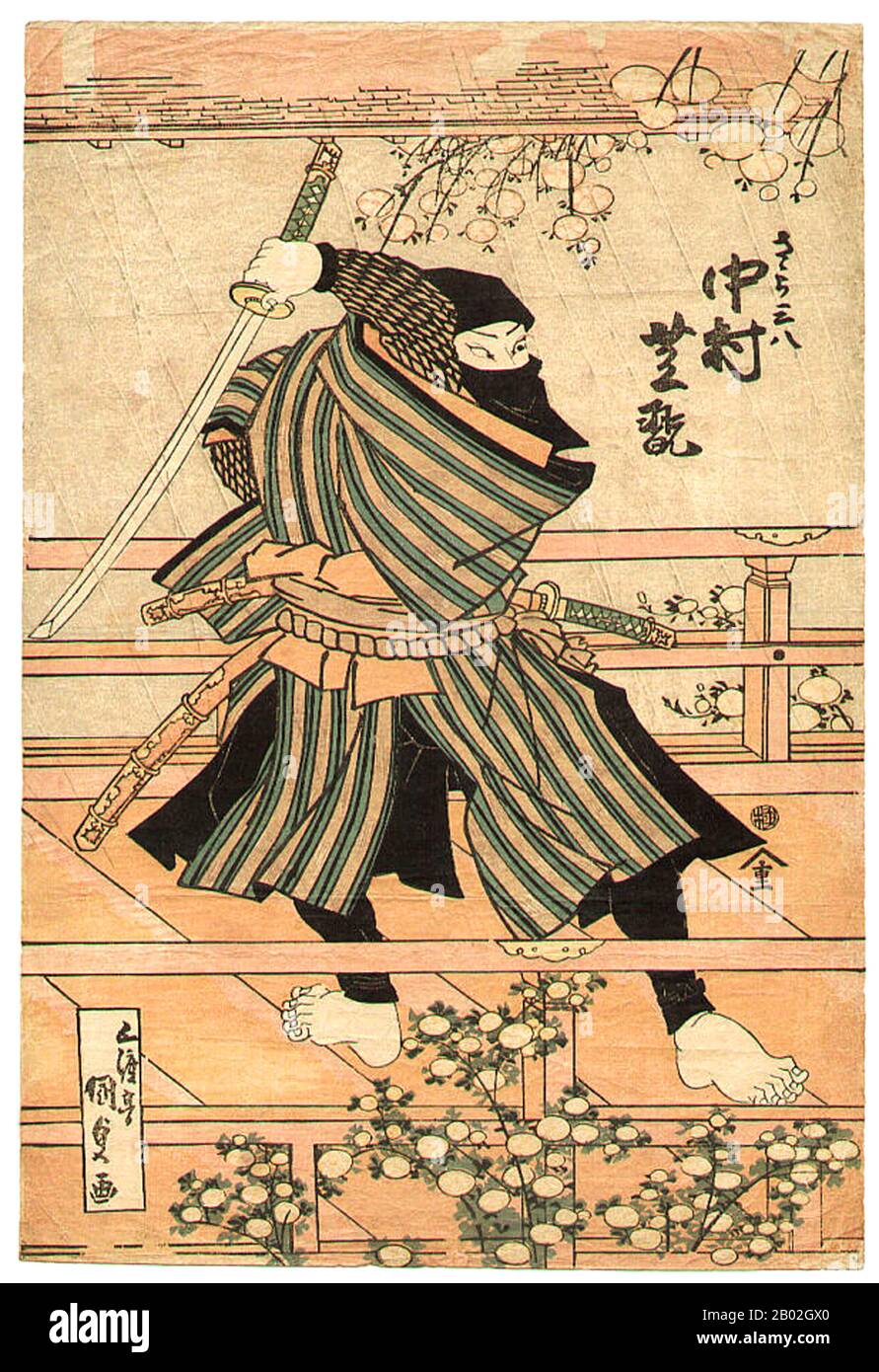 A ninja (忍者) or shinobi (忍び) was a covert agent or mercenary in feudal Japan who specialized in unorthodox warfare. The functions of the ninja included espionage, sabotage, infiltration, and assassination, and open combat in certain situations. Their covert methods of waging war contrasted the ninja with the samurai, who observed strict rules about honor and combat. The shinobi proper, a specially trained group of spies and mercenaries, appeared in the Sengoku or 'warring states' period, in the 15th century, but antecedents may have existed in the 14th century, and possibly even in the 12th c Stock Photohttps://www.alamy.com/image-license-details/?v=1https://www.alamy.com/a-ninja-or-shinobi-was-a-covert-agent-or-mercenary-in-feudal-japan-who-specialized-in-unorthodox-warfare-the-functions-of-the-ninja-included-espionage-sabotage-infiltration-and-assassination-and-open-combat-in-certain-situations-their-covert-methods-of-waging-war-contrasted-the-ninja-with-the-samurai-who-observed-strict-rules-about-honor-and-combat-the-shinobi-proper-a-specially-trained-group-of-spies-and-mercenaries-appeared-in-the-sengoku-or-warring-states-period-in-the-15th-century-but-antecedents-may-have-existed-in-the-14th-century-and-possibly-even-in-the-12th-c-image344264536.html
A ninja (忍者) or shinobi (忍び) was a covert agent or mercenary in feudal Japan who specialized in unorthodox warfare. The functions of the ninja included espionage, sabotage, infiltration, and assassination, and open combat in certain situations. Their covert methods of waging war contrasted the ninja with the samurai, who observed strict rules about honor and combat. The shinobi proper, a specially trained group of spies and mercenaries, appeared in the Sengoku or 'warring states' period, in the 15th century, but antecedents may have existed in the 14th century, and possibly even in the 12th c Stock Photohttps://www.alamy.com/image-license-details/?v=1https://www.alamy.com/a-ninja-or-shinobi-was-a-covert-agent-or-mercenary-in-feudal-japan-who-specialized-in-unorthodox-warfare-the-functions-of-the-ninja-included-espionage-sabotage-infiltration-and-assassination-and-open-combat-in-certain-situations-their-covert-methods-of-waging-war-contrasted-the-ninja-with-the-samurai-who-observed-strict-rules-about-honor-and-combat-the-shinobi-proper-a-specially-trained-group-of-spies-and-mercenaries-appeared-in-the-sengoku-or-warring-states-period-in-the-15th-century-but-antecedents-may-have-existed-in-the-14th-century-and-possibly-even-in-the-12th-c-image344264536.htmlRM2B02GX0–A ninja (忍者) or shinobi (忍び) was a covert agent or mercenary in feudal Japan who specialized in unorthodox warfare. The functions of the ninja included espionage, sabotage, infiltration, and assassination, and open combat in certain situations. Their covert methods of waging war contrasted the ninja with the samurai, who observed strict rules about honor and combat. The shinobi proper, a specially trained group of spies and mercenaries, appeared in the Sengoku or 'warring states' period, in the 15th century, but antecedents may have existed in the 14th century, and possibly even in the 12th c
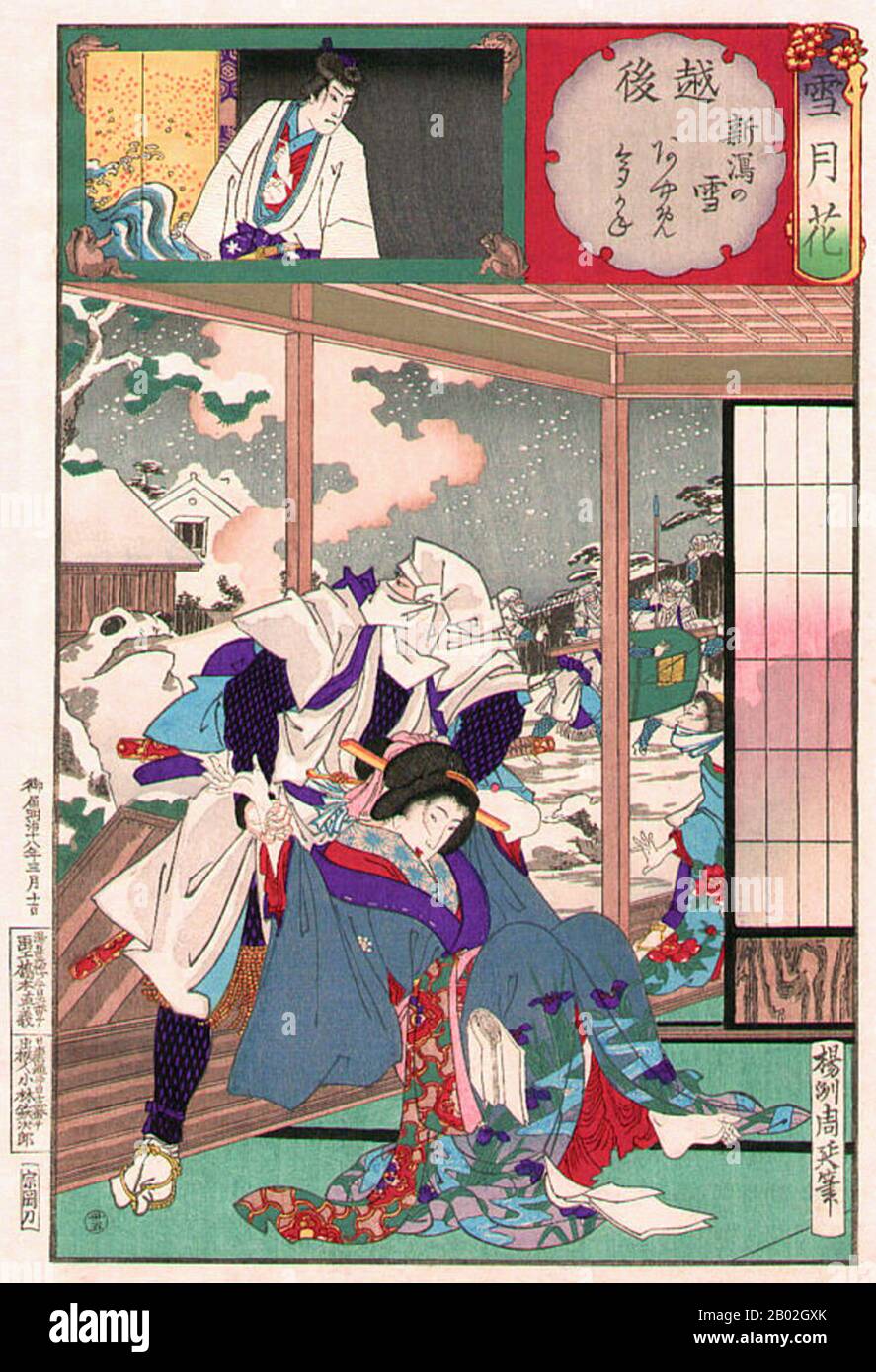 A ninja (忍者) or shinobi (忍び) was a covert agent or mercenary in feudal Japan who specialized in unorthodox warfare. The functions of the ninja included espionage, sabotage, infiltration, and assassination, and open combat in certain situations. Their covert methods of waging war contrasted the ninja with the samurai, who observed strict rules about honor and combat. The shinobi proper, a specially trained group of spies and mercenaries, appeared in the Sengoku or 'warring states' period, in the 15th century, but antecedents may have existed in the 14th century, and possibly even in the 12th c Stock Photohttps://www.alamy.com/image-license-details/?v=1https://www.alamy.com/a-ninja-or-shinobi-was-a-covert-agent-or-mercenary-in-feudal-japan-who-specialized-in-unorthodox-warfare-the-functions-of-the-ninja-included-espionage-sabotage-infiltration-and-assassination-and-open-combat-in-certain-situations-their-covert-methods-of-waging-war-contrasted-the-ninja-with-the-samurai-who-observed-strict-rules-about-honor-and-combat-the-shinobi-proper-a-specially-trained-group-of-spies-and-mercenaries-appeared-in-the-sengoku-or-warring-states-period-in-the-15th-century-but-antecedents-may-have-existed-in-the-14th-century-and-possibly-even-in-the-12th-c-image344264555.html
A ninja (忍者) or shinobi (忍び) was a covert agent or mercenary in feudal Japan who specialized in unorthodox warfare. The functions of the ninja included espionage, sabotage, infiltration, and assassination, and open combat in certain situations. Their covert methods of waging war contrasted the ninja with the samurai, who observed strict rules about honor and combat. The shinobi proper, a specially trained group of spies and mercenaries, appeared in the Sengoku or 'warring states' period, in the 15th century, but antecedents may have existed in the 14th century, and possibly even in the 12th c Stock Photohttps://www.alamy.com/image-license-details/?v=1https://www.alamy.com/a-ninja-or-shinobi-was-a-covert-agent-or-mercenary-in-feudal-japan-who-specialized-in-unorthodox-warfare-the-functions-of-the-ninja-included-espionage-sabotage-infiltration-and-assassination-and-open-combat-in-certain-situations-their-covert-methods-of-waging-war-contrasted-the-ninja-with-the-samurai-who-observed-strict-rules-about-honor-and-combat-the-shinobi-proper-a-specially-trained-group-of-spies-and-mercenaries-appeared-in-the-sengoku-or-warring-states-period-in-the-15th-century-but-antecedents-may-have-existed-in-the-14th-century-and-possibly-even-in-the-12th-c-image344264555.htmlRM2B02GXK–A ninja (忍者) or shinobi (忍び) was a covert agent or mercenary in feudal Japan who specialized in unorthodox warfare. The functions of the ninja included espionage, sabotage, infiltration, and assassination, and open combat in certain situations. Their covert methods of waging war contrasted the ninja with the samurai, who observed strict rules about honor and combat. The shinobi proper, a specially trained group of spies and mercenaries, appeared in the Sengoku or 'warring states' period, in the 15th century, but antecedents may have existed in the 14th century, and possibly even in the 12th c
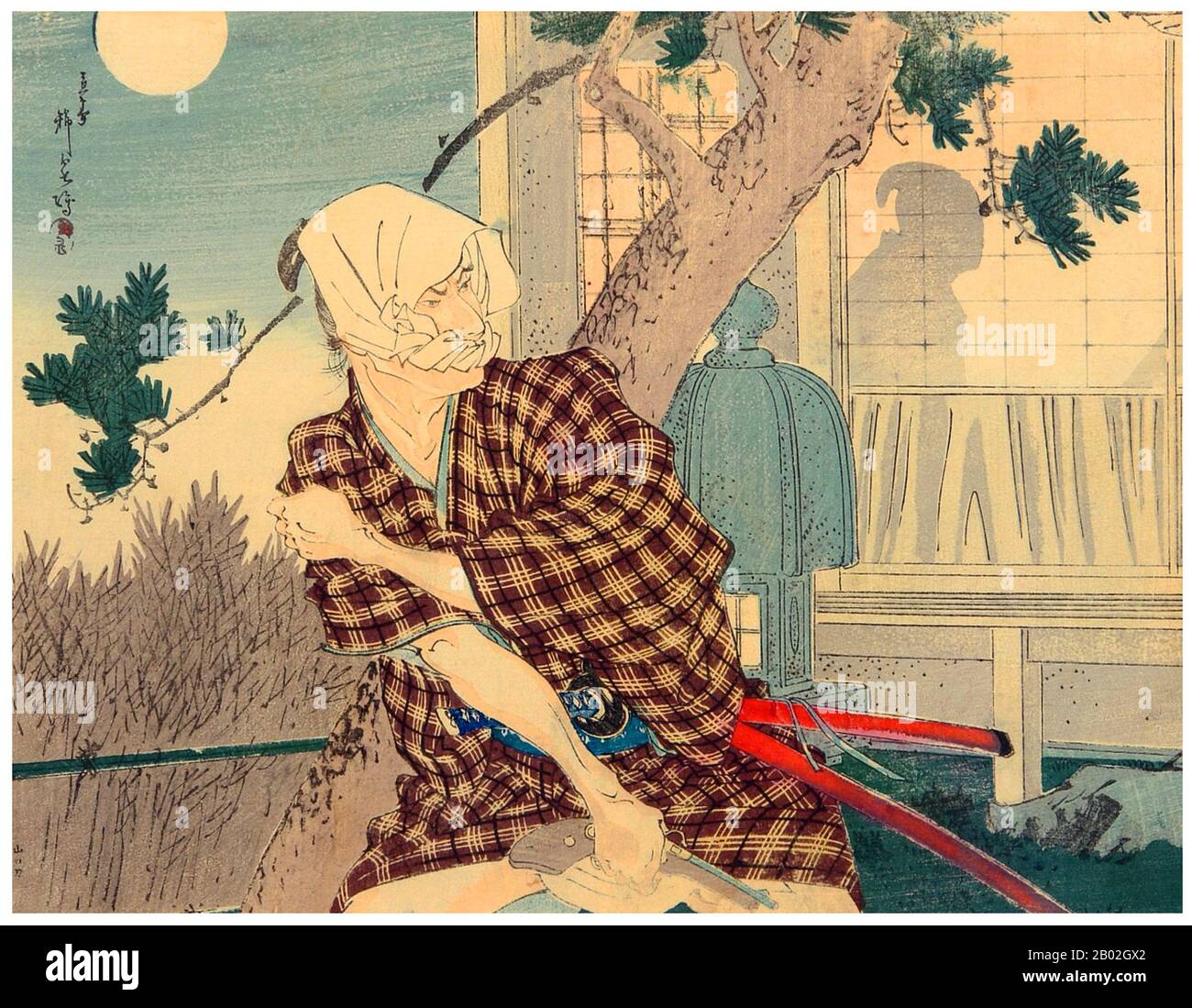 A ninja (忍者) or shinobi (忍び) was a covert agent or mercenary in feudal Japan who specialized in unorthodox warfare. The functions of the ninja included espionage, sabotage, infiltration, and assassination, and open combat in certain situations. Their covert methods of waging war contrasted the ninja with the samurai, who observed strict rules about honor and combat. The shinobi proper, a specially trained group of spies and mercenaries, appeared in the Sengoku or 'warring states' period, in the 15th century, but antecedents may have existed in the 14th century, and possibly even in the 12th c Stock Photohttps://www.alamy.com/image-license-details/?v=1https://www.alamy.com/a-ninja-or-shinobi-was-a-covert-agent-or-mercenary-in-feudal-japan-who-specialized-in-unorthodox-warfare-the-functions-of-the-ninja-included-espionage-sabotage-infiltration-and-assassination-and-open-combat-in-certain-situations-their-covert-methods-of-waging-war-contrasted-the-ninja-with-the-samurai-who-observed-strict-rules-about-honor-and-combat-the-shinobi-proper-a-specially-trained-group-of-spies-and-mercenaries-appeared-in-the-sengoku-or-warring-states-period-in-the-15th-century-but-antecedents-may-have-existed-in-the-14th-century-and-possibly-even-in-the-12th-c-image344264538.html
A ninja (忍者) or shinobi (忍び) was a covert agent or mercenary in feudal Japan who specialized in unorthodox warfare. The functions of the ninja included espionage, sabotage, infiltration, and assassination, and open combat in certain situations. Their covert methods of waging war contrasted the ninja with the samurai, who observed strict rules about honor and combat. The shinobi proper, a specially trained group of spies and mercenaries, appeared in the Sengoku or 'warring states' period, in the 15th century, but antecedents may have existed in the 14th century, and possibly even in the 12th c Stock Photohttps://www.alamy.com/image-license-details/?v=1https://www.alamy.com/a-ninja-or-shinobi-was-a-covert-agent-or-mercenary-in-feudal-japan-who-specialized-in-unorthodox-warfare-the-functions-of-the-ninja-included-espionage-sabotage-infiltration-and-assassination-and-open-combat-in-certain-situations-their-covert-methods-of-waging-war-contrasted-the-ninja-with-the-samurai-who-observed-strict-rules-about-honor-and-combat-the-shinobi-proper-a-specially-trained-group-of-spies-and-mercenaries-appeared-in-the-sengoku-or-warring-states-period-in-the-15th-century-but-antecedents-may-have-existed-in-the-14th-century-and-possibly-even-in-the-12th-c-image344264538.htmlRM2B02GX2–A ninja (忍者) or shinobi (忍び) was a covert agent or mercenary in feudal Japan who specialized in unorthodox warfare. The functions of the ninja included espionage, sabotage, infiltration, and assassination, and open combat in certain situations. Their covert methods of waging war contrasted the ninja with the samurai, who observed strict rules about honor and combat. The shinobi proper, a specially trained group of spies and mercenaries, appeared in the Sengoku or 'warring states' period, in the 15th century, but antecedents may have existed in the 14th century, and possibly even in the 12th c
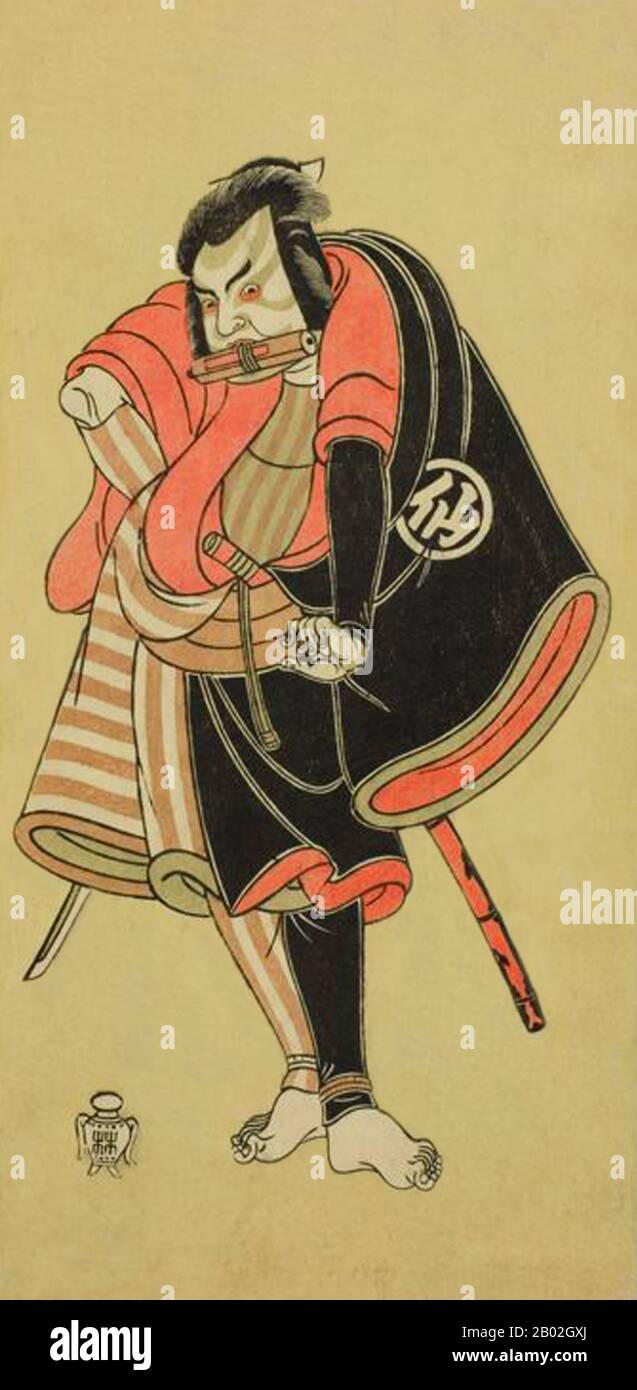 A ninja (忍者) or shinobi (忍び) was a covert agent or mercenary in feudal Japan who specialized in unorthodox warfare. The functions of the ninja included espionage, sabotage, infiltration, and assassination, and open combat in certain situations. Their covert methods of waging war contrasted the ninja with the samurai, who observed strict rules about honor and combat. The shinobi proper, a specially trained group of spies and mercenaries, appeared in the Sengoku or 'warring states' period, in the 15th century, but antecedents may have existed in the 14th century, and possibly even in the 12th c Stock Photohttps://www.alamy.com/image-license-details/?v=1https://www.alamy.com/a-ninja-or-shinobi-was-a-covert-agent-or-mercenary-in-feudal-japan-who-specialized-in-unorthodox-warfare-the-functions-of-the-ninja-included-espionage-sabotage-infiltration-and-assassination-and-open-combat-in-certain-situations-their-covert-methods-of-waging-war-contrasted-the-ninja-with-the-samurai-who-observed-strict-rules-about-honor-and-combat-the-shinobi-proper-a-specially-trained-group-of-spies-and-mercenaries-appeared-in-the-sengoku-or-warring-states-period-in-the-15th-century-but-antecedents-may-have-existed-in-the-14th-century-and-possibly-even-in-the-12th-c-image344264554.html
A ninja (忍者) or shinobi (忍び) was a covert agent or mercenary in feudal Japan who specialized in unorthodox warfare. The functions of the ninja included espionage, sabotage, infiltration, and assassination, and open combat in certain situations. Their covert methods of waging war contrasted the ninja with the samurai, who observed strict rules about honor and combat. The shinobi proper, a specially trained group of spies and mercenaries, appeared in the Sengoku or 'warring states' period, in the 15th century, but antecedents may have existed in the 14th century, and possibly even in the 12th c Stock Photohttps://www.alamy.com/image-license-details/?v=1https://www.alamy.com/a-ninja-or-shinobi-was-a-covert-agent-or-mercenary-in-feudal-japan-who-specialized-in-unorthodox-warfare-the-functions-of-the-ninja-included-espionage-sabotage-infiltration-and-assassination-and-open-combat-in-certain-situations-their-covert-methods-of-waging-war-contrasted-the-ninja-with-the-samurai-who-observed-strict-rules-about-honor-and-combat-the-shinobi-proper-a-specially-trained-group-of-spies-and-mercenaries-appeared-in-the-sengoku-or-warring-states-period-in-the-15th-century-but-antecedents-may-have-existed-in-the-14th-century-and-possibly-even-in-the-12th-c-image344264554.htmlRM2B02GXJ–A ninja (忍者) or shinobi (忍び) was a covert agent or mercenary in feudal Japan who specialized in unorthodox warfare. The functions of the ninja included espionage, sabotage, infiltration, and assassination, and open combat in certain situations. Their covert methods of waging war contrasted the ninja with the samurai, who observed strict rules about honor and combat. The shinobi proper, a specially trained group of spies and mercenaries, appeared in the Sengoku or 'warring states' period, in the 15th century, but antecedents may have existed in the 14th century, and possibly even in the 12th c
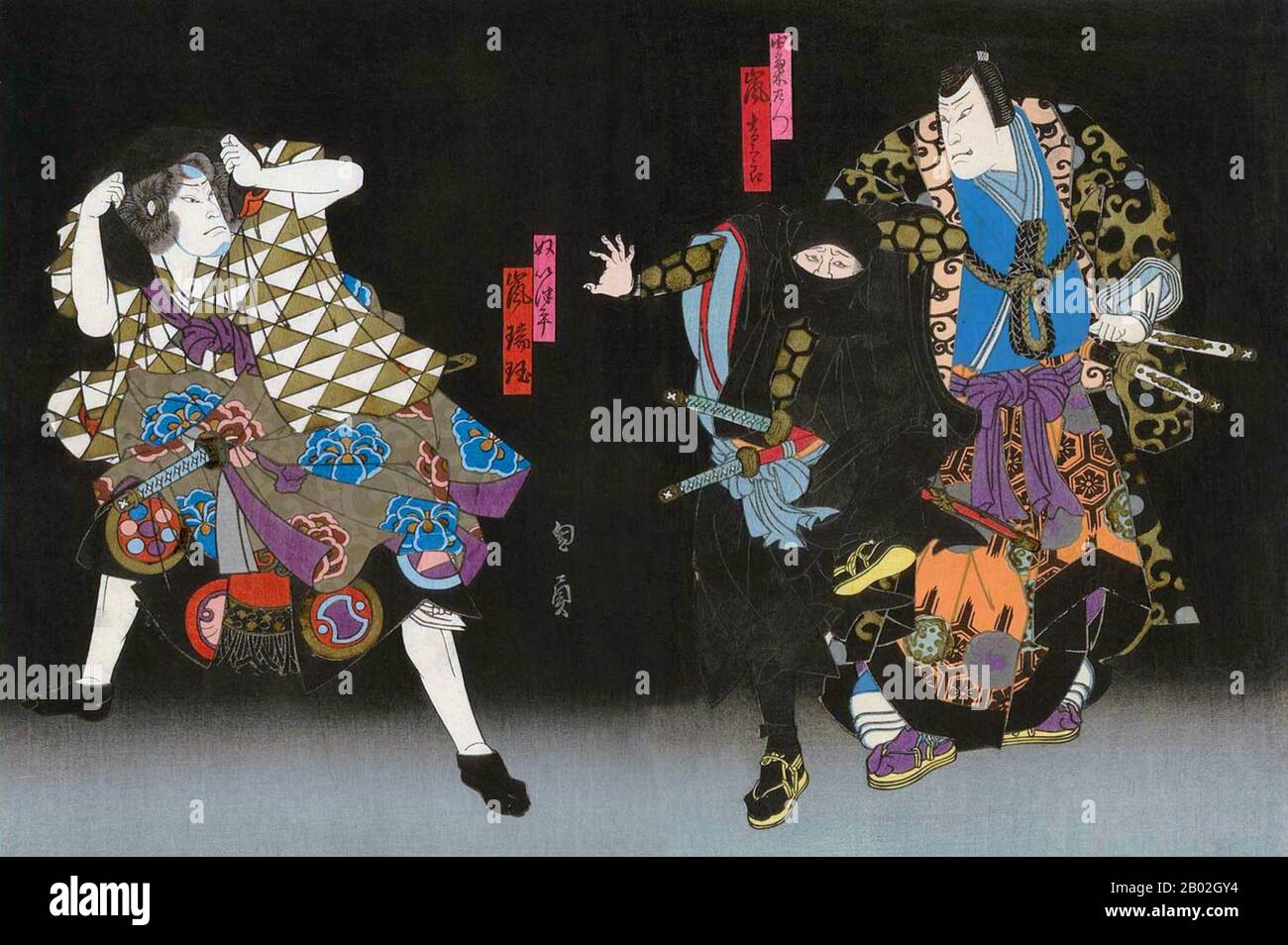 A ninja (忍者) or shinobi (忍び) was a covert agent or mercenary in feudal Japan who specialized in unorthodox warfare. The functions of the ninja included espionage, sabotage, infiltration, and assassination, and open combat in certain situations. Their covert methods of waging war contrasted the ninja with the samurai, who observed strict rules about honor and combat. The shinobi proper, a specially trained group of spies and mercenaries, appeared in the Sengoku or 'warring states' period, in the 15th century, but antecedents may have existed in the 14th century, and possibly even in the 12th c Stock Photohttps://www.alamy.com/image-license-details/?v=1https://www.alamy.com/a-ninja-or-shinobi-was-a-covert-agent-or-mercenary-in-feudal-japan-who-specialized-in-unorthodox-warfare-the-functions-of-the-ninja-included-espionage-sabotage-infiltration-and-assassination-and-open-combat-in-certain-situations-their-covert-methods-of-waging-war-contrasted-the-ninja-with-the-samurai-who-observed-strict-rules-about-honor-and-combat-the-shinobi-proper-a-specially-trained-group-of-spies-and-mercenaries-appeared-in-the-sengoku-or-warring-states-period-in-the-15th-century-but-antecedents-may-have-existed-in-the-14th-century-and-possibly-even-in-the-12th-c-image344264568.html
A ninja (忍者) or shinobi (忍び) was a covert agent or mercenary in feudal Japan who specialized in unorthodox warfare. The functions of the ninja included espionage, sabotage, infiltration, and assassination, and open combat in certain situations. Their covert methods of waging war contrasted the ninja with the samurai, who observed strict rules about honor and combat. The shinobi proper, a specially trained group of spies and mercenaries, appeared in the Sengoku or 'warring states' period, in the 15th century, but antecedents may have existed in the 14th century, and possibly even in the 12th c Stock Photohttps://www.alamy.com/image-license-details/?v=1https://www.alamy.com/a-ninja-or-shinobi-was-a-covert-agent-or-mercenary-in-feudal-japan-who-specialized-in-unorthodox-warfare-the-functions-of-the-ninja-included-espionage-sabotage-infiltration-and-assassination-and-open-combat-in-certain-situations-their-covert-methods-of-waging-war-contrasted-the-ninja-with-the-samurai-who-observed-strict-rules-about-honor-and-combat-the-shinobi-proper-a-specially-trained-group-of-spies-and-mercenaries-appeared-in-the-sengoku-or-warring-states-period-in-the-15th-century-but-antecedents-may-have-existed-in-the-14th-century-and-possibly-even-in-the-12th-c-image344264568.htmlRM2B02GY4–A ninja (忍者) or shinobi (忍び) was a covert agent or mercenary in feudal Japan who specialized in unorthodox warfare. The functions of the ninja included espionage, sabotage, infiltration, and assassination, and open combat in certain situations. Their covert methods of waging war contrasted the ninja with the samurai, who observed strict rules about honor and combat. The shinobi proper, a specially trained group of spies and mercenaries, appeared in the Sengoku or 'warring states' period, in the 15th century, but antecedents may have existed in the 14th century, and possibly even in the 12th c
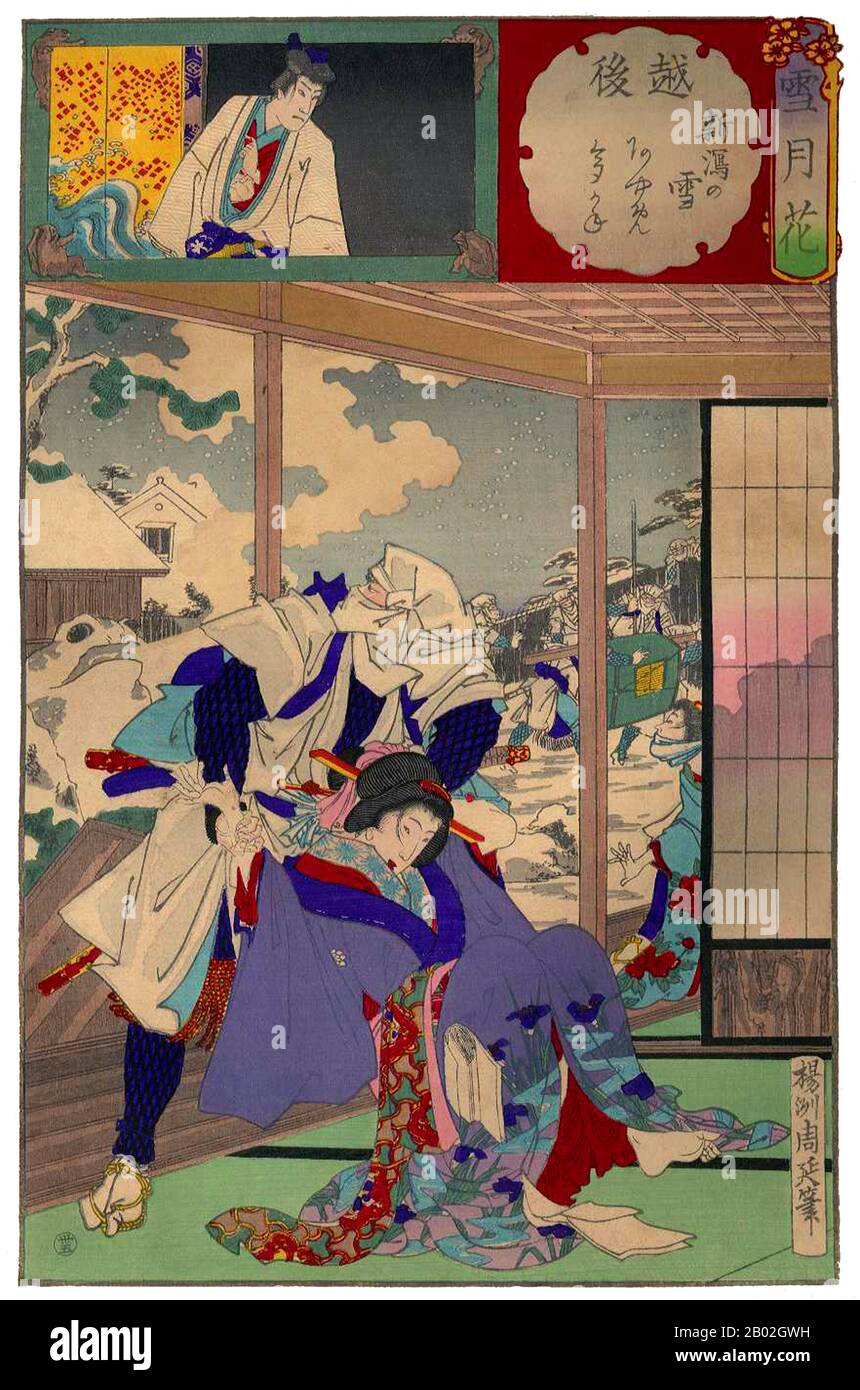 A ninja (忍者) or shinobi (忍び) was a covert agent or mercenary in feudal Japan who specialized in unorthodox warfare. The functions of the ninja included espionage, sabotage, infiltration, and assassination, and open combat in certain situations. Their covert methods of waging war contrasted the ninja with the samurai, who observed strict rules about honor and combat. The shinobi proper, a specially trained group of spies and mercenaries, appeared in the Sengoku or 'warring states' period, in the 15th century, but antecedents may have existed in the 14th century, and possibly even in the 12th c Stock Photohttps://www.alamy.com/image-license-details/?v=1https://www.alamy.com/a-ninja-or-shinobi-was-a-covert-agent-or-mercenary-in-feudal-japan-who-specialized-in-unorthodox-warfare-the-functions-of-the-ninja-included-espionage-sabotage-infiltration-and-assassination-and-open-combat-in-certain-situations-their-covert-methods-of-waging-war-contrasted-the-ninja-with-the-samurai-who-observed-strict-rules-about-honor-and-combat-the-shinobi-proper-a-specially-trained-group-of-spies-and-mercenaries-appeared-in-the-sengoku-or-warring-states-period-in-the-15th-century-but-antecedents-may-have-existed-in-the-14th-century-and-possibly-even-in-the-12th-c-image344264525.html
A ninja (忍者) or shinobi (忍び) was a covert agent or mercenary in feudal Japan who specialized in unorthodox warfare. The functions of the ninja included espionage, sabotage, infiltration, and assassination, and open combat in certain situations. Their covert methods of waging war contrasted the ninja with the samurai, who observed strict rules about honor and combat. The shinobi proper, a specially trained group of spies and mercenaries, appeared in the Sengoku or 'warring states' period, in the 15th century, but antecedents may have existed in the 14th century, and possibly even in the 12th c Stock Photohttps://www.alamy.com/image-license-details/?v=1https://www.alamy.com/a-ninja-or-shinobi-was-a-covert-agent-or-mercenary-in-feudal-japan-who-specialized-in-unorthodox-warfare-the-functions-of-the-ninja-included-espionage-sabotage-infiltration-and-assassination-and-open-combat-in-certain-situations-their-covert-methods-of-waging-war-contrasted-the-ninja-with-the-samurai-who-observed-strict-rules-about-honor-and-combat-the-shinobi-proper-a-specially-trained-group-of-spies-and-mercenaries-appeared-in-the-sengoku-or-warring-states-period-in-the-15th-century-but-antecedents-may-have-existed-in-the-14th-century-and-possibly-even-in-the-12th-c-image344264525.htmlRM2B02GWH–A ninja (忍者) or shinobi (忍び) was a covert agent or mercenary in feudal Japan who specialized in unorthodox warfare. The functions of the ninja included espionage, sabotage, infiltration, and assassination, and open combat in certain situations. Their covert methods of waging war contrasted the ninja with the samurai, who observed strict rules about honor and combat. The shinobi proper, a specially trained group of spies and mercenaries, appeared in the Sengoku or 'warring states' period, in the 15th century, but antecedents may have existed in the 14th century, and possibly even in the 12th c
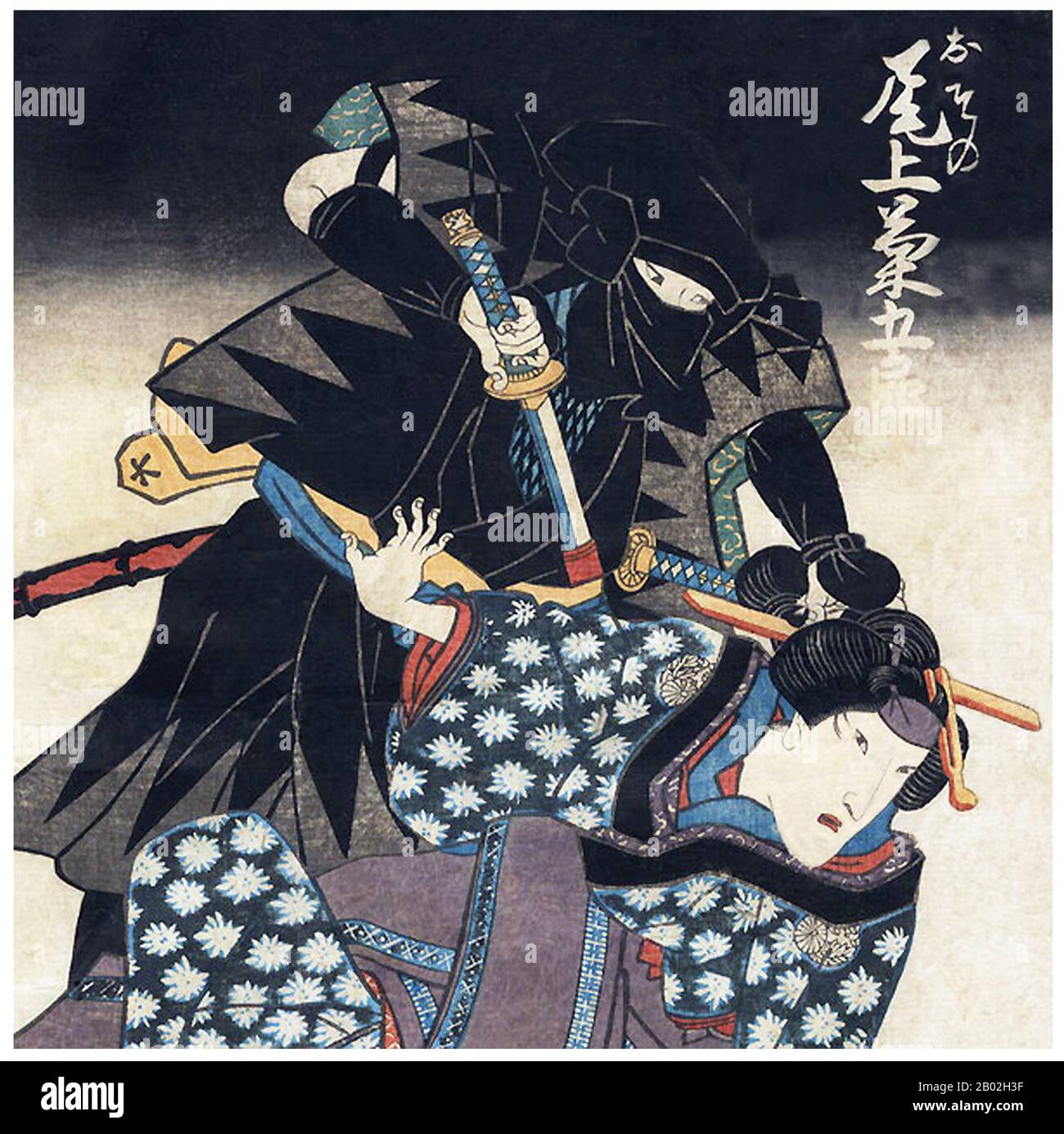 A ninja (忍者) or shinobi (忍び) was a covert agent or mercenary in feudal Japan who specialized in unorthodox warfare. The functions of the ninja included espionage, sabotage, infiltration, and assassination, and open combat in certain situations. Their covert methods of waging war contrasted the ninja with the samurai, who observed strict rules about honor and combat. The shinobi proper, a specially trained group of spies and mercenaries, appeared in the Sengoku or 'warring states' period, in the 15th century, but antecedents may have existed in the 14th century, and possibly even in the 12th c Stock Photohttps://www.alamy.com/image-license-details/?v=1https://www.alamy.com/a-ninja-or-shinobi-was-a-covert-agent-or-mercenary-in-feudal-japan-who-specialized-in-unorthodox-warfare-the-functions-of-the-ninja-included-espionage-sabotage-infiltration-and-assassination-and-open-combat-in-certain-situations-their-covert-methods-of-waging-war-contrasted-the-ninja-with-the-samurai-who-observed-strict-rules-about-honor-and-combat-the-shinobi-proper-a-specially-trained-group-of-spies-and-mercenaries-appeared-in-the-sengoku-or-warring-states-period-in-the-15th-century-but-antecedents-may-have-existed-in-the-14th-century-and-possibly-even-in-the-12th-c-image344264691.html
A ninja (忍者) or shinobi (忍び) was a covert agent or mercenary in feudal Japan who specialized in unorthodox warfare. The functions of the ninja included espionage, sabotage, infiltration, and assassination, and open combat in certain situations. Their covert methods of waging war contrasted the ninja with the samurai, who observed strict rules about honor and combat. The shinobi proper, a specially trained group of spies and mercenaries, appeared in the Sengoku or 'warring states' period, in the 15th century, but antecedents may have existed in the 14th century, and possibly even in the 12th c Stock Photohttps://www.alamy.com/image-license-details/?v=1https://www.alamy.com/a-ninja-or-shinobi-was-a-covert-agent-or-mercenary-in-feudal-japan-who-specialized-in-unorthodox-warfare-the-functions-of-the-ninja-included-espionage-sabotage-infiltration-and-assassination-and-open-combat-in-certain-situations-their-covert-methods-of-waging-war-contrasted-the-ninja-with-the-samurai-who-observed-strict-rules-about-honor-and-combat-the-shinobi-proper-a-specially-trained-group-of-spies-and-mercenaries-appeared-in-the-sengoku-or-warring-states-period-in-the-15th-century-but-antecedents-may-have-existed-in-the-14th-century-and-possibly-even-in-the-12th-c-image344264691.htmlRM2B02H3F–A ninja (忍者) or shinobi (忍び) was a covert agent or mercenary in feudal Japan who specialized in unorthodox warfare. The functions of the ninja included espionage, sabotage, infiltration, and assassination, and open combat in certain situations. Their covert methods of waging war contrasted the ninja with the samurai, who observed strict rules about honor and combat. The shinobi proper, a specially trained group of spies and mercenaries, appeared in the Sengoku or 'warring states' period, in the 15th century, but antecedents may have existed in the 14th century, and possibly even in the 12th c
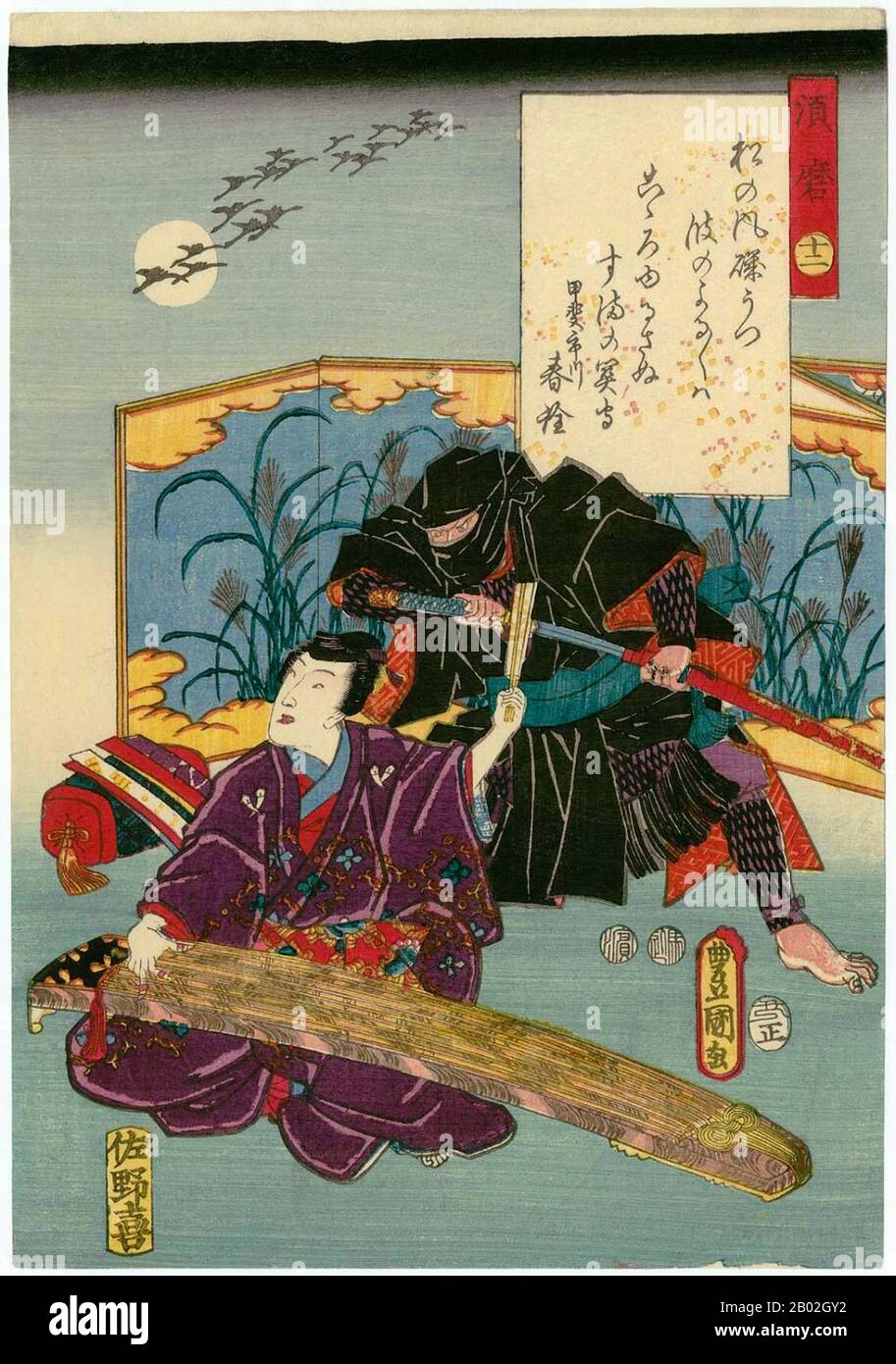 A ninja (忍者) or shinobi (忍び) was a covert agent or mercenary in feudal Japan who specialized in unorthodox warfare. The functions of the ninja included espionage, sabotage, infiltration, and assassination, and open combat in certain situations. Their covert methods of waging war contrasted the ninja with the samurai, who observed strict rules about honor and combat. The shinobi proper, a specially trained group of spies and mercenaries, appeared in the Sengoku or 'warring states' period, in the 15th century, but antecedents may have existed in the 14th century, and possibly even in the 12th c Stock Photohttps://www.alamy.com/image-license-details/?v=1https://www.alamy.com/a-ninja-or-shinobi-was-a-covert-agent-or-mercenary-in-feudal-japan-who-specialized-in-unorthodox-warfare-the-functions-of-the-ninja-included-espionage-sabotage-infiltration-and-assassination-and-open-combat-in-certain-situations-their-covert-methods-of-waging-war-contrasted-the-ninja-with-the-samurai-who-observed-strict-rules-about-honor-and-combat-the-shinobi-proper-a-specially-trained-group-of-spies-and-mercenaries-appeared-in-the-sengoku-or-warring-states-period-in-the-15th-century-but-antecedents-may-have-existed-in-the-14th-century-and-possibly-even-in-the-12th-c-image344264566.html
A ninja (忍者) or shinobi (忍び) was a covert agent or mercenary in feudal Japan who specialized in unorthodox warfare. The functions of the ninja included espionage, sabotage, infiltration, and assassination, and open combat in certain situations. Their covert methods of waging war contrasted the ninja with the samurai, who observed strict rules about honor and combat. The shinobi proper, a specially trained group of spies and mercenaries, appeared in the Sengoku or 'warring states' period, in the 15th century, but antecedents may have existed in the 14th century, and possibly even in the 12th c Stock Photohttps://www.alamy.com/image-license-details/?v=1https://www.alamy.com/a-ninja-or-shinobi-was-a-covert-agent-or-mercenary-in-feudal-japan-who-specialized-in-unorthodox-warfare-the-functions-of-the-ninja-included-espionage-sabotage-infiltration-and-assassination-and-open-combat-in-certain-situations-their-covert-methods-of-waging-war-contrasted-the-ninja-with-the-samurai-who-observed-strict-rules-about-honor-and-combat-the-shinobi-proper-a-specially-trained-group-of-spies-and-mercenaries-appeared-in-the-sengoku-or-warring-states-period-in-the-15th-century-but-antecedents-may-have-existed-in-the-14th-century-and-possibly-even-in-the-12th-c-image344264566.htmlRM2B02GY2–A ninja (忍者) or shinobi (忍び) was a covert agent or mercenary in feudal Japan who specialized in unorthodox warfare. The functions of the ninja included espionage, sabotage, infiltration, and assassination, and open combat in certain situations. Their covert methods of waging war contrasted the ninja with the samurai, who observed strict rules about honor and combat. The shinobi proper, a specially trained group of spies and mercenaries, appeared in the Sengoku or 'warring states' period, in the 15th century, but antecedents may have existed in the 14th century, and possibly even in the 12th c
 Japan: 'A Warrior of the Nanhoku-Cho Period'. Chemigraph from series 'Military Costumes in Old Japan' by Kazumasa Ogawa (1860-1929), 1893, Tokyo. Ogawa Kazumasa, also known as Ogawa Kazuma or Ogawa Isshin, was a Japanese photographer, chemigrapher, printer and publisher of the Meiji era. He was a pioneer in photomechanical printing and photography, and was born into the Matsudaira samurai clan, where he studied English and photography at the age of 15. Stock Photohttps://www.alamy.com/image-license-details/?v=1https://www.alamy.com/japan-a-warrior-of-the-nanhoku-cho-period-chemigraph-from-series-military-costumes-in-old-japan-by-kazumasa-ogawa-1860-1929-1893-tokyo-ogawa-kazumasa-also-known-as-ogawa-kazuma-or-ogawa-isshin-was-a-japanese-photographer-chemigrapher-printer-and-publisher-of-the-meiji-era-he-was-a-pioneer-in-photomechanical-printing-and-photography-and-was-born-into-the-matsudaira-samurai-clan-where-he-studied-english-and-photography-at-the-age-of-15-image368972825.html
Japan: 'A Warrior of the Nanhoku-Cho Period'. Chemigraph from series 'Military Costumes in Old Japan' by Kazumasa Ogawa (1860-1929), 1893, Tokyo. Ogawa Kazumasa, also known as Ogawa Kazuma or Ogawa Isshin, was a Japanese photographer, chemigrapher, printer and publisher of the Meiji era. He was a pioneer in photomechanical printing and photography, and was born into the Matsudaira samurai clan, where he studied English and photography at the age of 15. Stock Photohttps://www.alamy.com/image-license-details/?v=1https://www.alamy.com/japan-a-warrior-of-the-nanhoku-cho-period-chemigraph-from-series-military-costumes-in-old-japan-by-kazumasa-ogawa-1860-1929-1893-tokyo-ogawa-kazumasa-also-known-as-ogawa-kazuma-or-ogawa-isshin-was-a-japanese-photographer-chemigrapher-printer-and-publisher-of-the-meiji-era-he-was-a-pioneer-in-photomechanical-printing-and-photography-and-was-born-into-the-matsudaira-samurai-clan-where-he-studied-english-and-photography-at-the-age-of-15-image368972825.htmlRM2CC84GW–Japan: 'A Warrior of the Nanhoku-Cho Period'. Chemigraph from series 'Military Costumes in Old Japan' by Kazumasa Ogawa (1860-1929), 1893, Tokyo. Ogawa Kazumasa, also known as Ogawa Kazuma or Ogawa Isshin, was a Japanese photographer, chemigrapher, printer and publisher of the Meiji era. He was a pioneer in photomechanical printing and photography, and was born into the Matsudaira samurai clan, where he studied English and photography at the age of 15.